Empirical Investigation on Effects of FDI on Unemployment in SADC Countries
VerifiedAdded on 2022/10/12
|66
|20000
|230
AI Summary
This dissertation examines the causal relationship between FDI and employment in SADC countries. It investigates the impact of variables such as inflation, government expenditures, FDI, and economic growth on employment. The study focuses on the panel of 15 countries in SADC bloc and uses panel data analysis method to examine the dependency of one variable on other variables.
Contribute Materials
Your contribution can guide someone’s learning journey. Share your
documents today.
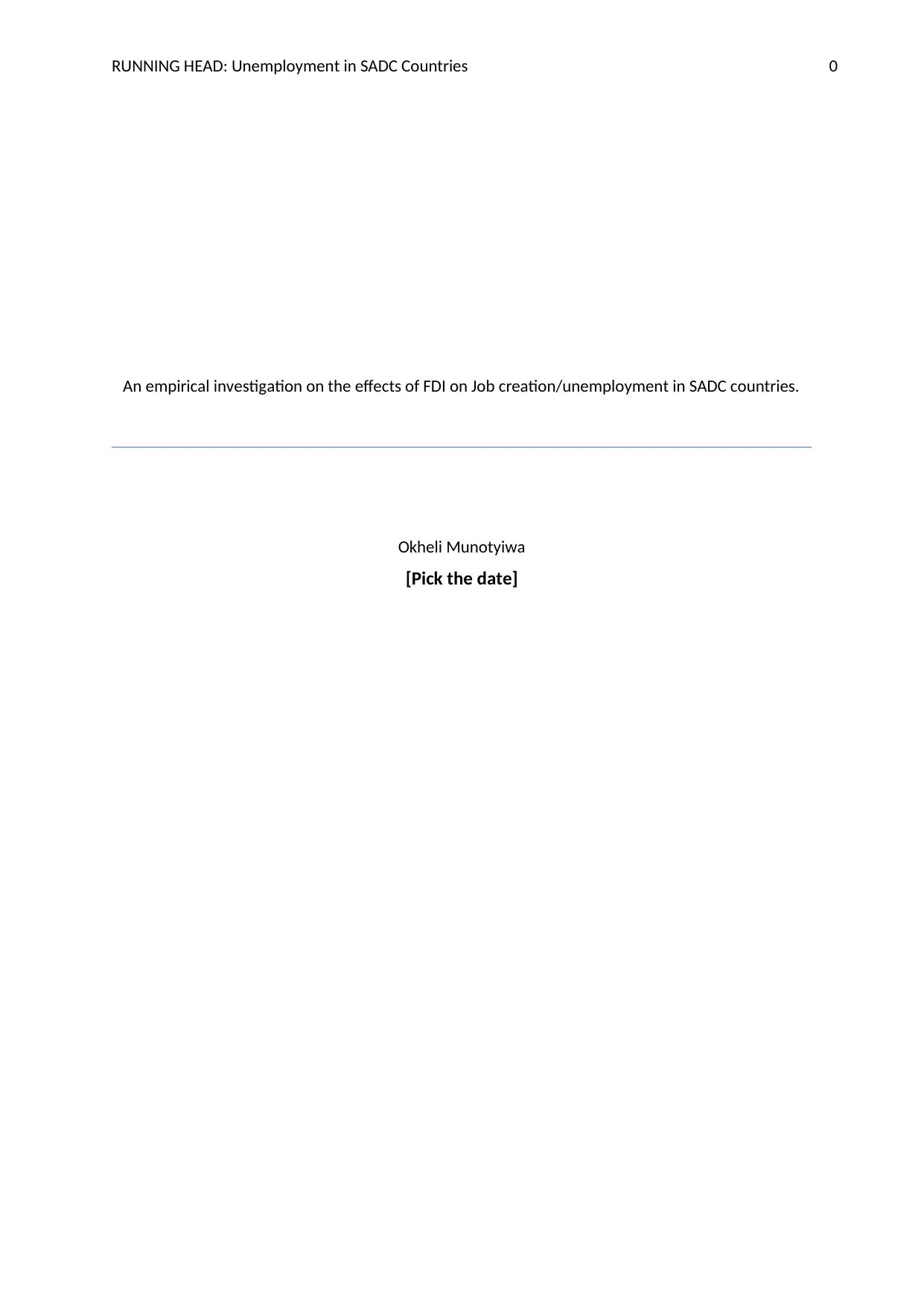
RUNNING HEAD: Unemployment in SADC Countries 0
An empirical investigation on the effects of FDI on Job creation/unemployment in SADC countries.
Okheli Munotyiwa
[Pick the date]
An empirical investigation on the effects of FDI on Job creation/unemployment in SADC countries.
Okheli Munotyiwa
[Pick the date]
Secure Best Marks with AI Grader
Need help grading? Try our AI Grader for instant feedback on your assignments.

Unemployment in SADC Countries 1
DECLARATION
DECLARATION

Unemployment in SADC Countries 2
ACKNOWLEDGMENTS
ACKNOWLEDGMENTS
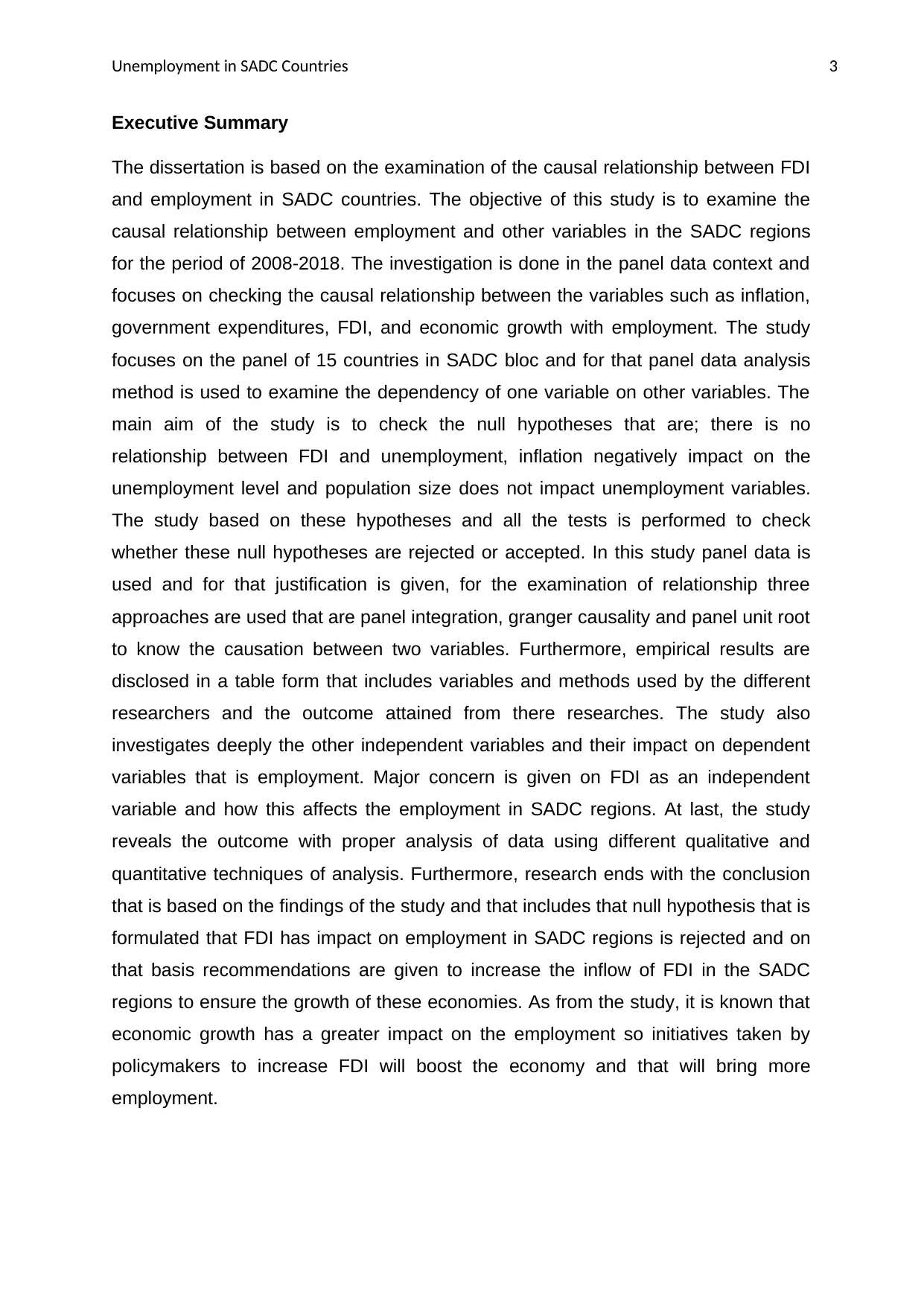
Unemployment in SADC Countries 3
Executive Summary
The dissertation is based on the examination of the causal relationship between FDI
and employment in SADC countries. The objective of this study is to examine the
causal relationship between employment and other variables in the SADC regions
for the period of 2008-2018. The investigation is done in the panel data context and
focuses on checking the causal relationship between the variables such as inflation,
government expenditures, FDI, and economic growth with employment. The study
focuses on the panel of 15 countries in SADC bloc and for that panel data analysis
method is used to examine the dependency of one variable on other variables. The
main aim of the study is to check the null hypotheses that are; there is no
relationship between FDI and unemployment, inflation negatively impact on the
unemployment level and population size does not impact unemployment variables.
The study based on these hypotheses and all the tests is performed to check
whether these null hypotheses are rejected or accepted. In this study panel data is
used and for that justification is given, for the examination of relationship three
approaches are used that are panel integration, granger causality and panel unit root
to know the causation between two variables. Furthermore, empirical results are
disclosed in a table form that includes variables and methods used by the different
researchers and the outcome attained from there researches. The study also
investigates deeply the other independent variables and their impact on dependent
variables that is employment. Major concern is given on FDI as an independent
variable and how this affects the employment in SADC regions. At last, the study
reveals the outcome with proper analysis of data using different qualitative and
quantitative techniques of analysis. Furthermore, research ends with the conclusion
that is based on the findings of the study and that includes that null hypothesis that is
formulated that FDI has impact on employment in SADC regions is rejected and on
that basis recommendations are given to increase the inflow of FDI in the SADC
regions to ensure the growth of these economies. As from the study, it is known that
economic growth has a greater impact on the employment so initiatives taken by
policymakers to increase FDI will boost the economy and that will bring more
employment.
Executive Summary
The dissertation is based on the examination of the causal relationship between FDI
and employment in SADC countries. The objective of this study is to examine the
causal relationship between employment and other variables in the SADC regions
for the period of 2008-2018. The investigation is done in the panel data context and
focuses on checking the causal relationship between the variables such as inflation,
government expenditures, FDI, and economic growth with employment. The study
focuses on the panel of 15 countries in SADC bloc and for that panel data analysis
method is used to examine the dependency of one variable on other variables. The
main aim of the study is to check the null hypotheses that are; there is no
relationship between FDI and unemployment, inflation negatively impact on the
unemployment level and population size does not impact unemployment variables.
The study based on these hypotheses and all the tests is performed to check
whether these null hypotheses are rejected or accepted. In this study panel data is
used and for that justification is given, for the examination of relationship three
approaches are used that are panel integration, granger causality and panel unit root
to know the causation between two variables. Furthermore, empirical results are
disclosed in a table form that includes variables and methods used by the different
researchers and the outcome attained from there researches. The study also
investigates deeply the other independent variables and their impact on dependent
variables that is employment. Major concern is given on FDI as an independent
variable and how this affects the employment in SADC regions. At last, the study
reveals the outcome with proper analysis of data using different qualitative and
quantitative techniques of analysis. Furthermore, research ends with the conclusion
that is based on the findings of the study and that includes that null hypothesis that is
formulated that FDI has impact on employment in SADC regions is rejected and on
that basis recommendations are given to increase the inflow of FDI in the SADC
regions to ensure the growth of these economies. As from the study, it is known that
economic growth has a greater impact on the employment so initiatives taken by
policymakers to increase FDI will boost the economy and that will bring more
employment.
Secure Best Marks with AI Grader
Need help grading? Try our AI Grader for instant feedback on your assignments.
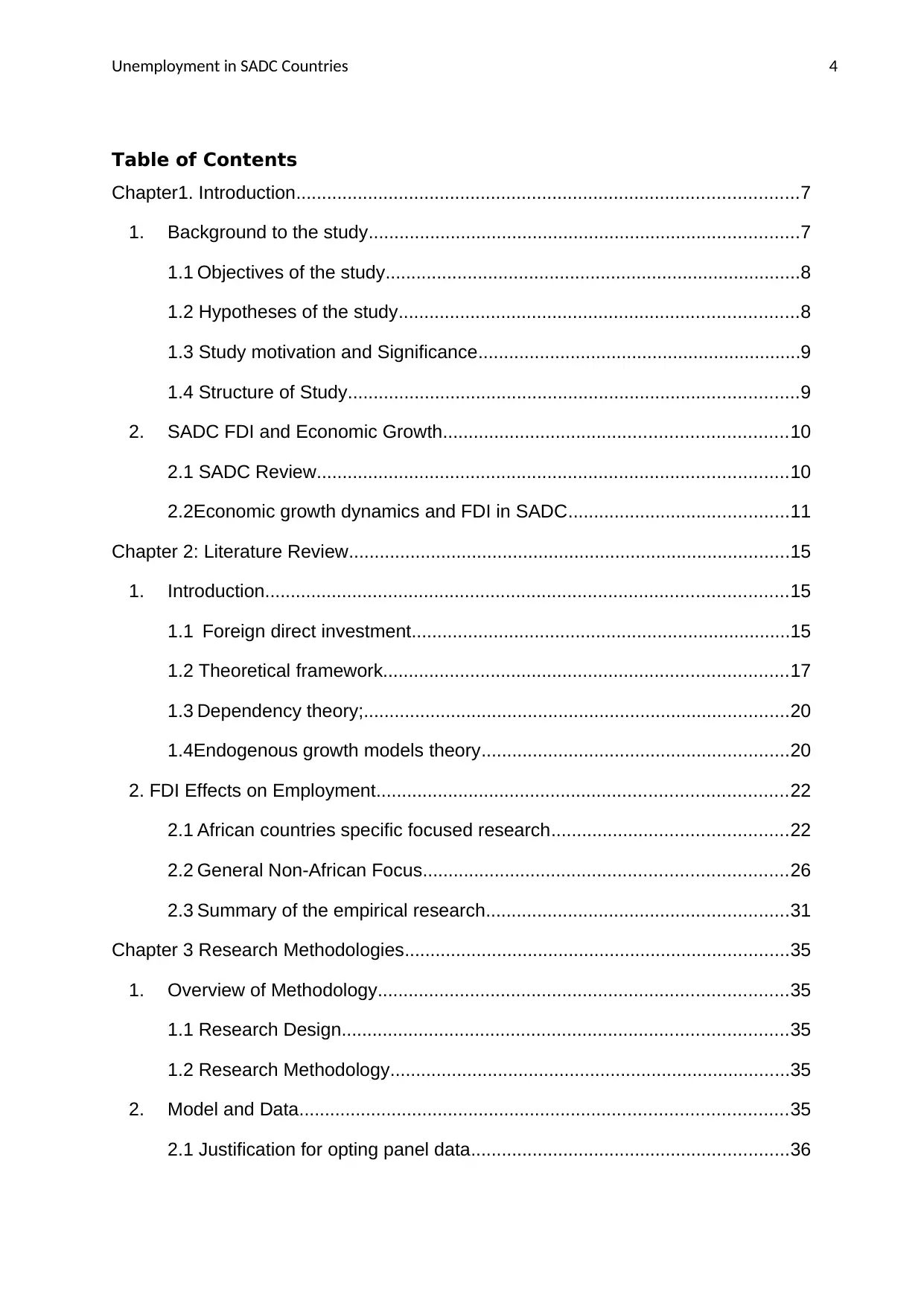
Unemployment in SADC Countries 4
Table of Contents
Chapter1. Introduction..................................................................................................7
1. Background to the study....................................................................................7
1.1 Objectives of the study.................................................................................8
1.2 Hypotheses of the study..............................................................................8
1.3 Study motivation and Significance...............................................................9
1.4 Structure of Study........................................................................................9
2. SADC FDI and Economic Growth...................................................................10
2.1 SADC Review............................................................................................10
2.2Economic growth dynamics and FDI in SADC...........................................11
Chapter 2: Literature Review......................................................................................15
1. Introduction......................................................................................................15
1.1 Foreign direct investment..........................................................................15
1.2 Theoretical framework...............................................................................17
1.3 Dependency theory;...................................................................................20
1.4Endogenous growth models theory............................................................20
2. FDI Effects on Employment................................................................................22
2.1 African countries specific focused research..............................................22
2.2 General Non-African Focus.......................................................................26
2.3 Summary of the empirical research...........................................................31
Chapter 3 Research Methodologies...........................................................................35
1. Overview of Methodology................................................................................35
1.1 Research Design.......................................................................................35
1.2 Research Methodology..............................................................................35
2. Model and Data...............................................................................................35
2.1 Justification for opting panel data..............................................................36
Table of Contents
Chapter1. Introduction..................................................................................................7
1. Background to the study....................................................................................7
1.1 Objectives of the study.................................................................................8
1.2 Hypotheses of the study..............................................................................8
1.3 Study motivation and Significance...............................................................9
1.4 Structure of Study........................................................................................9
2. SADC FDI and Economic Growth...................................................................10
2.1 SADC Review............................................................................................10
2.2Economic growth dynamics and FDI in SADC...........................................11
Chapter 2: Literature Review......................................................................................15
1. Introduction......................................................................................................15
1.1 Foreign direct investment..........................................................................15
1.2 Theoretical framework...............................................................................17
1.3 Dependency theory;...................................................................................20
1.4Endogenous growth models theory............................................................20
2. FDI Effects on Employment................................................................................22
2.1 African countries specific focused research..............................................22
2.2 General Non-African Focus.......................................................................26
2.3 Summary of the empirical research...........................................................31
Chapter 3 Research Methodologies...........................................................................35
1. Overview of Methodology................................................................................35
1.1 Research Design.......................................................................................35
1.2 Research Methodology..............................................................................35
2. Model and Data...............................................................................................35
2.1 Justification for opting panel data..............................................................36
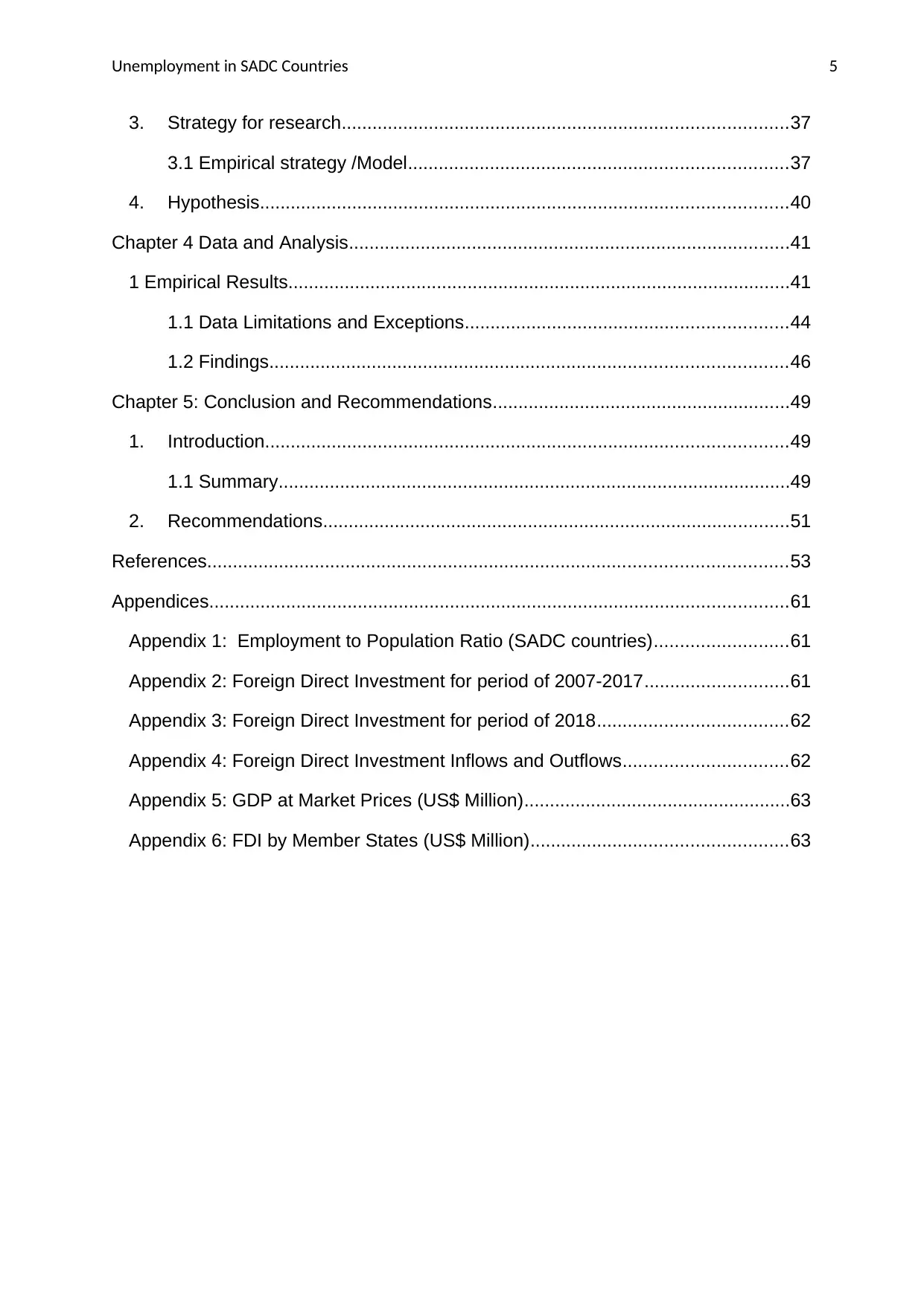
Unemployment in SADC Countries 5
3. Strategy for research.......................................................................................37
3.1 Empirical strategy /Model..........................................................................37
4. Hypothesis.......................................................................................................40
Chapter 4 Data and Analysis......................................................................................41
1 Empirical Results..................................................................................................41
1.1 Data Limitations and Exceptions...............................................................44
1.2 Findings.....................................................................................................46
Chapter 5: Conclusion and Recommendations..........................................................49
1. Introduction......................................................................................................49
1.1 Summary....................................................................................................49
2. Recommendations...........................................................................................51
References.................................................................................................................53
Appendices.................................................................................................................61
Appendix 1: Employment to Population Ratio (SADC countries)..........................61
Appendix 2: Foreign Direct Investment for period of 2007-2017............................61
Appendix 3: Foreign Direct Investment for period of 2018.....................................62
Appendix 4: Foreign Direct Investment Inflows and Outflows................................62
Appendix 5: GDP at Market Prices (US$ Million)....................................................63
Appendix 6: FDI by Member States (US$ Million)..................................................63
3. Strategy for research.......................................................................................37
3.1 Empirical strategy /Model..........................................................................37
4. Hypothesis.......................................................................................................40
Chapter 4 Data and Analysis......................................................................................41
1 Empirical Results..................................................................................................41
1.1 Data Limitations and Exceptions...............................................................44
1.2 Findings.....................................................................................................46
Chapter 5: Conclusion and Recommendations..........................................................49
1. Introduction......................................................................................................49
1.1 Summary....................................................................................................49
2. Recommendations...........................................................................................51
References.................................................................................................................53
Appendices.................................................................................................................61
Appendix 1: Employment to Population Ratio (SADC countries)..........................61
Appendix 2: Foreign Direct Investment for period of 2007-2017............................61
Appendix 3: Foreign Direct Investment for period of 2018.....................................62
Appendix 4: Foreign Direct Investment Inflows and Outflows................................62
Appendix 5: GDP at Market Prices (US$ Million)....................................................63
Appendix 6: FDI by Member States (US$ Million)..................................................63

Unemployment in SADC Countries 6
Paraphrase This Document
Need a fresh take? Get an instant paraphrase of this document with our AI Paraphraser
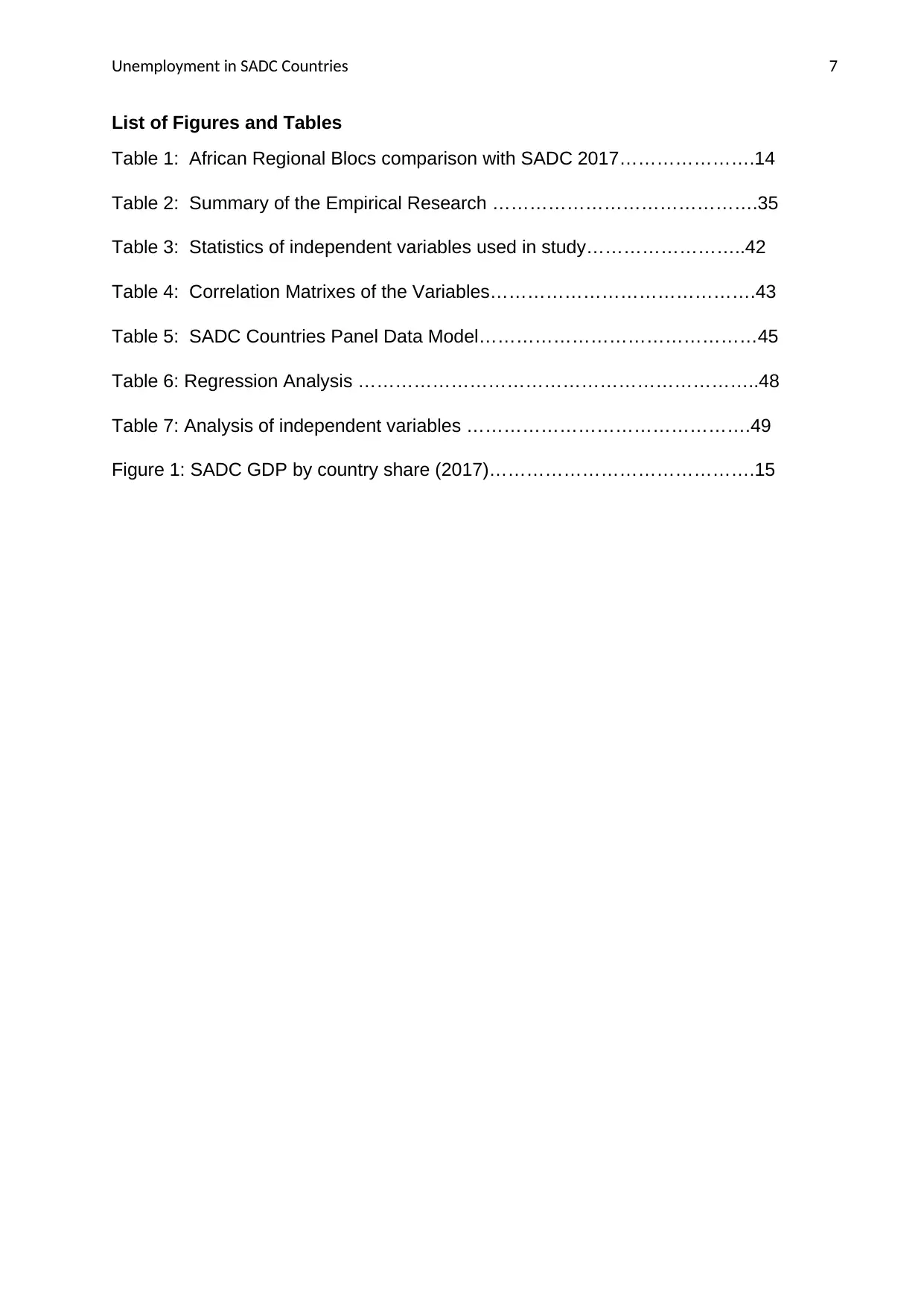
Unemployment in SADC Countries 7
List of Figures and Tables
Table 1: African Regional Blocs comparison with SADC 2017………………….14
Table 2: Summary of the Empirical Research …………………………………….35
Table 3: Statistics of independent variables used in study……………………..42
Table 4: Correlation Matrixes of the Variables…………………………………….43
Table 5: SADC Countries Panel Data Model………………………………………45
Table 6: Regression Analysis ………………………………………………………..48
Table 7: Analysis of independent variables ……………………………………….49
Figure 1: SADC GDP by country share (2017)…………………………………….15
List of Figures and Tables
Table 1: African Regional Blocs comparison with SADC 2017………………….14
Table 2: Summary of the Empirical Research …………………………………….35
Table 3: Statistics of independent variables used in study……………………..42
Table 4: Correlation Matrixes of the Variables…………………………………….43
Table 5: SADC Countries Panel Data Model………………………………………45
Table 6: Regression Analysis ………………………………………………………..48
Table 7: Analysis of independent variables ……………………………………….49
Figure 1: SADC GDP by country share (2017)…………………………………….15
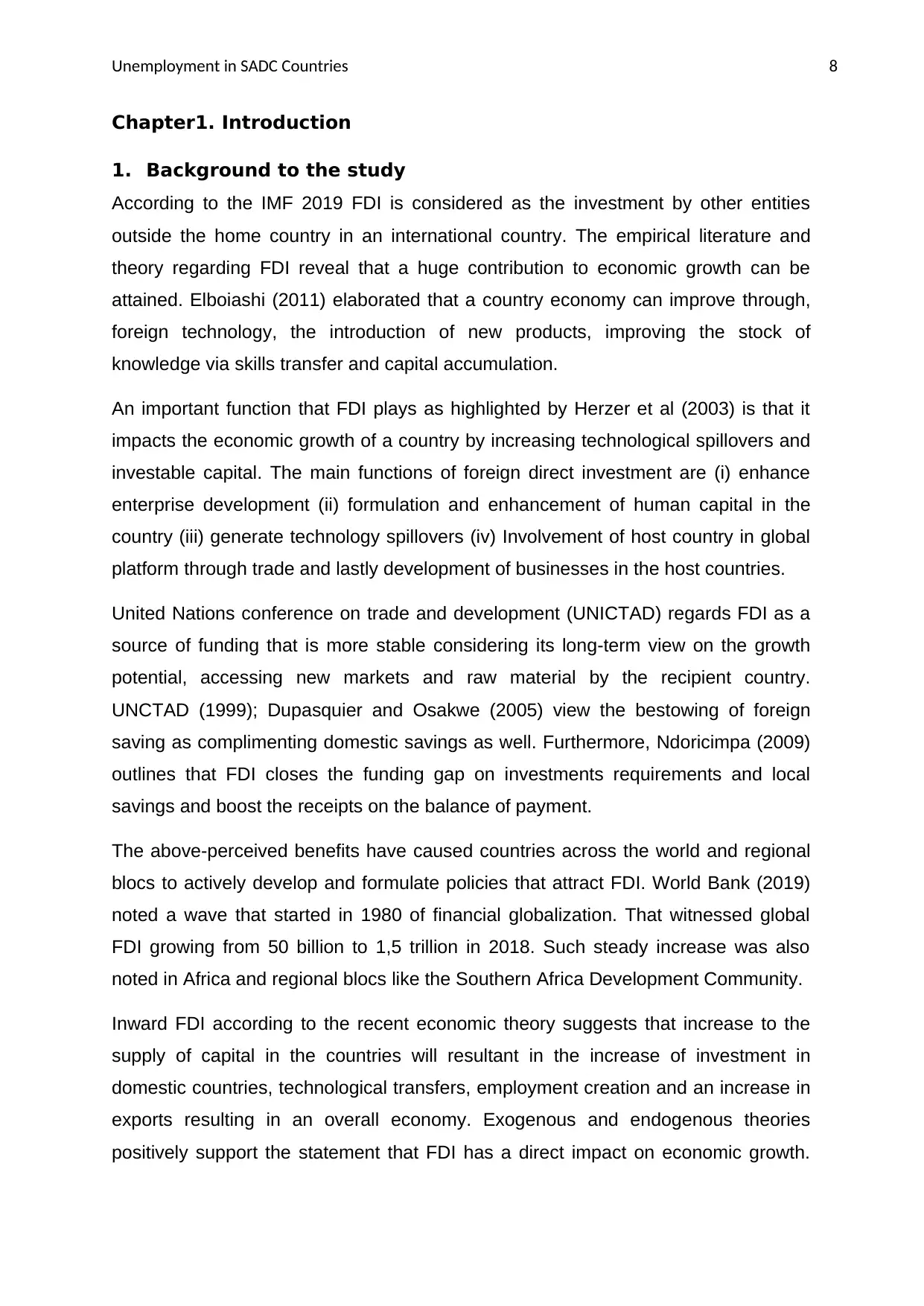
Unemployment in SADC Countries 8
Chapter1. Introduction
1. Background to the study
According to the IMF 2019 FDI is considered as the investment by other entities
outside the home country in an international country. The empirical literature and
theory regarding FDI reveal that a huge contribution to economic growth can be
attained. Elboiashi (2011) elaborated that a country economy can improve through,
foreign technology, the introduction of new products, improving the stock of
knowledge via skills transfer and capital accumulation.
An important function that FDI plays as highlighted by Herzer et al (2003) is that it
impacts the economic growth of a country by increasing technological spillovers and
investable capital. The main functions of foreign direct investment are (i) enhance
enterprise development (ii) formulation and enhancement of human capital in the
country (iii) generate technology spillovers (iv) Involvement of host country in global
platform through trade and lastly development of businesses in the host countries.
United Nations conference on trade and development (UNICTAD) regards FDI as a
source of funding that is more stable considering its long-term view on the growth
potential, accessing new markets and raw material by the recipient country.
UNCTAD (1999); Dupasquier and Osakwe (2005) view the bestowing of foreign
saving as complimenting domestic savings as well. Furthermore, Ndoricimpa (2009)
outlines that FDI closes the funding gap on investments requirements and local
savings and boost the receipts on the balance of payment.
The above-perceived benefits have caused countries across the world and regional
blocs to actively develop and formulate policies that attract FDI. World Bank (2019)
noted a wave that started in 1980 of financial globalization. That witnessed global
FDI growing from 50 billion to 1,5 trillion in 2018. Such steady increase was also
noted in Africa and regional blocs like the Southern Africa Development Community.
Inward FDI according to the recent economic theory suggests that increase to the
supply of capital in the countries will resultant in the increase of investment in
domestic countries, technological transfers, employment creation and an increase in
exports resulting in an overall economy. Exogenous and endogenous theories
positively support the statement that FDI has a direct impact on economic growth.
Chapter1. Introduction
1. Background to the study
According to the IMF 2019 FDI is considered as the investment by other entities
outside the home country in an international country. The empirical literature and
theory regarding FDI reveal that a huge contribution to economic growth can be
attained. Elboiashi (2011) elaborated that a country economy can improve through,
foreign technology, the introduction of new products, improving the stock of
knowledge via skills transfer and capital accumulation.
An important function that FDI plays as highlighted by Herzer et al (2003) is that it
impacts the economic growth of a country by increasing technological spillovers and
investable capital. The main functions of foreign direct investment are (i) enhance
enterprise development (ii) formulation and enhancement of human capital in the
country (iii) generate technology spillovers (iv) Involvement of host country in global
platform through trade and lastly development of businesses in the host countries.
United Nations conference on trade and development (UNICTAD) regards FDI as a
source of funding that is more stable considering its long-term view on the growth
potential, accessing new markets and raw material by the recipient country.
UNCTAD (1999); Dupasquier and Osakwe (2005) view the bestowing of foreign
saving as complimenting domestic savings as well. Furthermore, Ndoricimpa (2009)
outlines that FDI closes the funding gap on investments requirements and local
savings and boost the receipts on the balance of payment.
The above-perceived benefits have caused countries across the world and regional
blocs to actively develop and formulate policies that attract FDI. World Bank (2019)
noted a wave that started in 1980 of financial globalization. That witnessed global
FDI growing from 50 billion to 1,5 trillion in 2018. Such steady increase was also
noted in Africa and regional blocs like the Southern Africa Development Community.
Inward FDI according to the recent economic theory suggests that increase to the
supply of capital in the countries will resultant in the increase of investment in
domestic countries, technological transfers, employment creation and an increase in
exports resulting in an overall economy. Exogenous and endogenous theories
positively support the statement that FDI has a direct impact on economic growth.
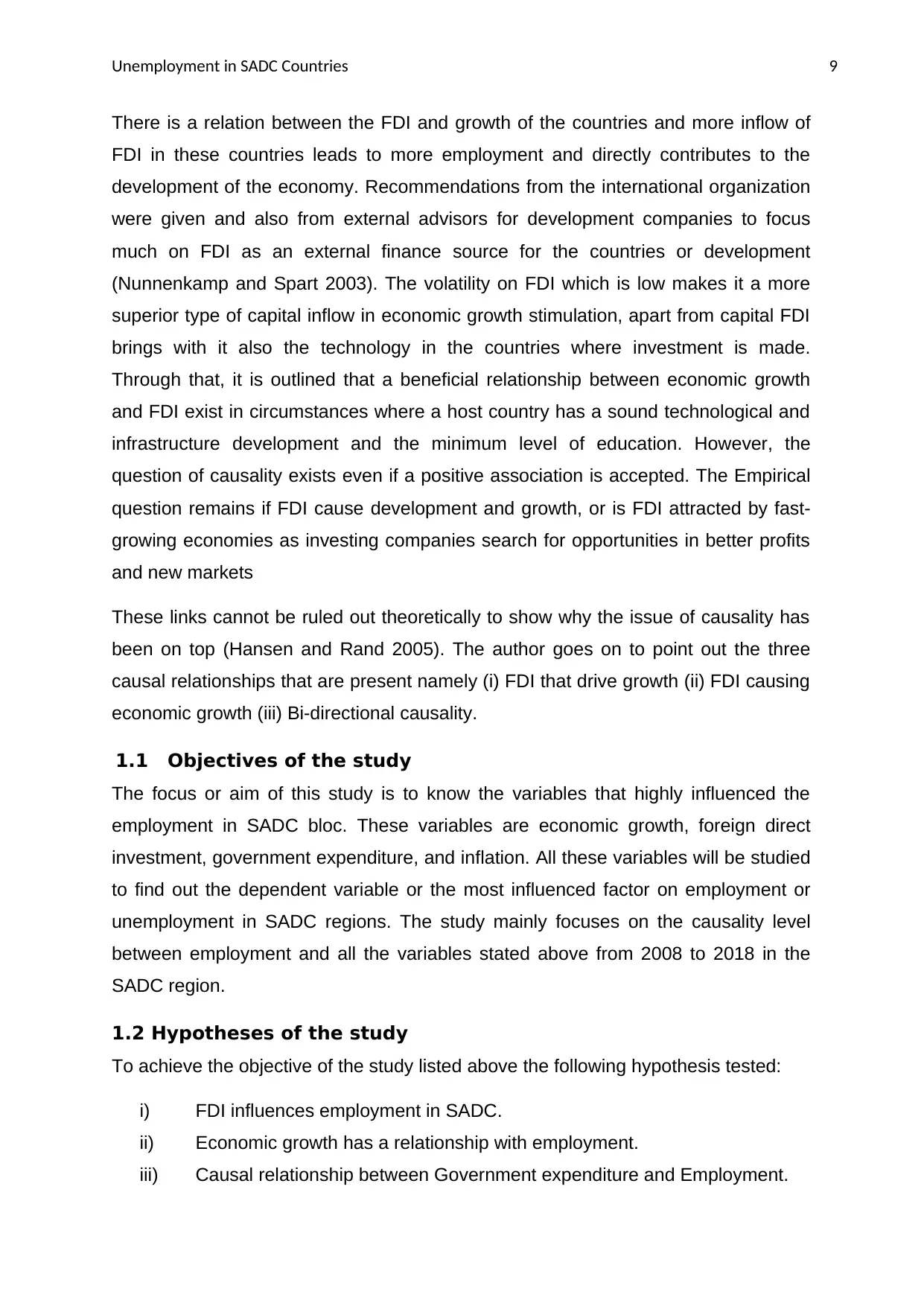
Unemployment in SADC Countries 9
There is a relation between the FDI and growth of the countries and more inflow of
FDI in these countries leads to more employment and directly contributes to the
development of the economy. Recommendations from the international organization
were given and also from external advisors for development companies to focus
much on FDI as an external finance source for the countries or development
(Nunnenkamp and Spart 2003). The volatility on FDI which is low makes it a more
superior type of capital inflow in economic growth stimulation, apart from capital FDI
brings with it also the technology in the countries where investment is made.
Through that, it is outlined that a beneficial relationship between economic growth
and FDI exist in circumstances where a host country has a sound technological and
infrastructure development and the minimum level of education. However, the
question of causality exists even if a positive association is accepted. The Empirical
question remains if FDI cause development and growth, or is FDI attracted by fast-
growing economies as investing companies search for opportunities in better profits
and new markets
These links cannot be ruled out theoretically to show why the issue of causality has
been on top (Hansen and Rand 2005). The author goes on to point out the three
causal relationships that are present namely (i) FDI that drive growth (ii) FDI causing
economic growth (iii) Bi-directional causality.
1.1 Objectives of the study
The focus or aim of this study is to know the variables that highly influenced the
employment in SADC bloc. These variables are economic growth, foreign direct
investment, government expenditure, and inflation. All these variables will be studied
to find out the dependent variable or the most influenced factor on employment or
unemployment in SADC regions. The study mainly focuses on the causality level
between employment and all the variables stated above from 2008 to 2018 in the
SADC region.
1.2 Hypotheses of the study
To achieve the objective of the study listed above the following hypothesis tested:
i) FDI influences employment in SADC.
ii) Economic growth has a relationship with employment.
iii) Causal relationship between Government expenditure and Employment.
There is a relation between the FDI and growth of the countries and more inflow of
FDI in these countries leads to more employment and directly contributes to the
development of the economy. Recommendations from the international organization
were given and also from external advisors for development companies to focus
much on FDI as an external finance source for the countries or development
(Nunnenkamp and Spart 2003). The volatility on FDI which is low makes it a more
superior type of capital inflow in economic growth stimulation, apart from capital FDI
brings with it also the technology in the countries where investment is made.
Through that, it is outlined that a beneficial relationship between economic growth
and FDI exist in circumstances where a host country has a sound technological and
infrastructure development and the minimum level of education. However, the
question of causality exists even if a positive association is accepted. The Empirical
question remains if FDI cause development and growth, or is FDI attracted by fast-
growing economies as investing companies search for opportunities in better profits
and new markets
These links cannot be ruled out theoretically to show why the issue of causality has
been on top (Hansen and Rand 2005). The author goes on to point out the three
causal relationships that are present namely (i) FDI that drive growth (ii) FDI causing
economic growth (iii) Bi-directional causality.
1.1 Objectives of the study
The focus or aim of this study is to know the variables that highly influenced the
employment in SADC bloc. These variables are economic growth, foreign direct
investment, government expenditure, and inflation. All these variables will be studied
to find out the dependent variable or the most influenced factor on employment or
unemployment in SADC regions. The study mainly focuses on the causality level
between employment and all the variables stated above from 2008 to 2018 in the
SADC region.
1.2 Hypotheses of the study
To achieve the objective of the study listed above the following hypothesis tested:
i) FDI influences employment in SADC.
ii) Economic growth has a relationship with employment.
iii) Causal relationship between Government expenditure and Employment.
Secure Best Marks with AI Grader
Need help grading? Try our AI Grader for instant feedback on your assignments.
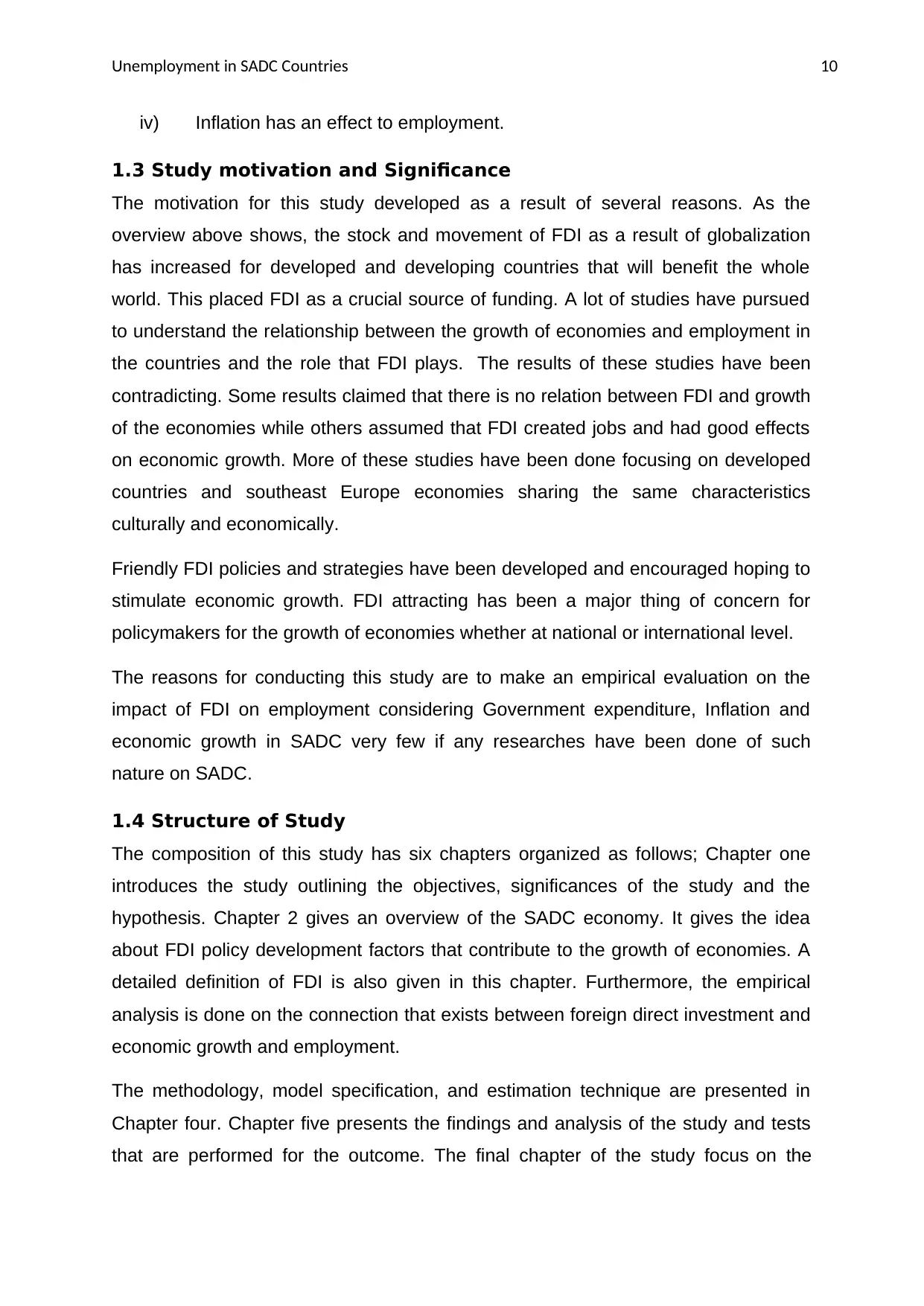
Unemployment in SADC Countries 10
iv) Inflation has an effect to employment.
1.3 Study motivation and Significance
The motivation for this study developed as a result of several reasons. As the
overview above shows, the stock and movement of FDI as a result of globalization
has increased for developed and developing countries that will benefit the whole
world. This placed FDI as a crucial source of funding. A lot of studies have pursued
to understand the relationship between the growth of economies and employment in
the countries and the role that FDI plays. The results of these studies have been
contradicting. Some results claimed that there is no relation between FDI and growth
of the economies while others assumed that FDI created jobs and had good effects
on economic growth. More of these studies have been done focusing on developed
countries and southeast Europe economies sharing the same characteristics
culturally and economically.
Friendly FDI policies and strategies have been developed and encouraged hoping to
stimulate economic growth. FDI attracting has been a major thing of concern for
policymakers for the growth of economies whether at national or international level.
The reasons for conducting this study are to make an empirical evaluation on the
impact of FDI on employment considering Government expenditure, Inflation and
economic growth in SADC very few if any researches have been done of such
nature on SADC.
1.4 Structure of Study
The composition of this study has six chapters organized as follows; Chapter one
introduces the study outlining the objectives, significances of the study and the
hypothesis. Chapter 2 gives an overview of the SADC economy. It gives the idea
about FDI policy development factors that contribute to the growth of economies. A
detailed definition of FDI is also given in this chapter. Furthermore, the empirical
analysis is done on the connection that exists between foreign direct investment and
economic growth and employment.
The methodology, model specification, and estimation technique are presented in
Chapter four. Chapter five presents the findings and analysis of the study and tests
that are performed for the outcome. The final chapter of the study focus on the
iv) Inflation has an effect to employment.
1.3 Study motivation and Significance
The motivation for this study developed as a result of several reasons. As the
overview above shows, the stock and movement of FDI as a result of globalization
has increased for developed and developing countries that will benefit the whole
world. This placed FDI as a crucial source of funding. A lot of studies have pursued
to understand the relationship between the growth of economies and employment in
the countries and the role that FDI plays. The results of these studies have been
contradicting. Some results claimed that there is no relation between FDI and growth
of the economies while others assumed that FDI created jobs and had good effects
on economic growth. More of these studies have been done focusing on developed
countries and southeast Europe economies sharing the same characteristics
culturally and economically.
Friendly FDI policies and strategies have been developed and encouraged hoping to
stimulate economic growth. FDI attracting has been a major thing of concern for
policymakers for the growth of economies whether at national or international level.
The reasons for conducting this study are to make an empirical evaluation on the
impact of FDI on employment considering Government expenditure, Inflation and
economic growth in SADC very few if any researches have been done of such
nature on SADC.
1.4 Structure of Study
The composition of this study has six chapters organized as follows; Chapter one
introduces the study outlining the objectives, significances of the study and the
hypothesis. Chapter 2 gives an overview of the SADC economy. It gives the idea
about FDI policy development factors that contribute to the growth of economies. A
detailed definition of FDI is also given in this chapter. Furthermore, the empirical
analysis is done on the connection that exists between foreign direct investment and
economic growth and employment.
The methodology, model specification, and estimation technique are presented in
Chapter four. Chapter five presents the findings and analysis of the study and tests
that are performed for the outcome. The final chapter of the study focus on the
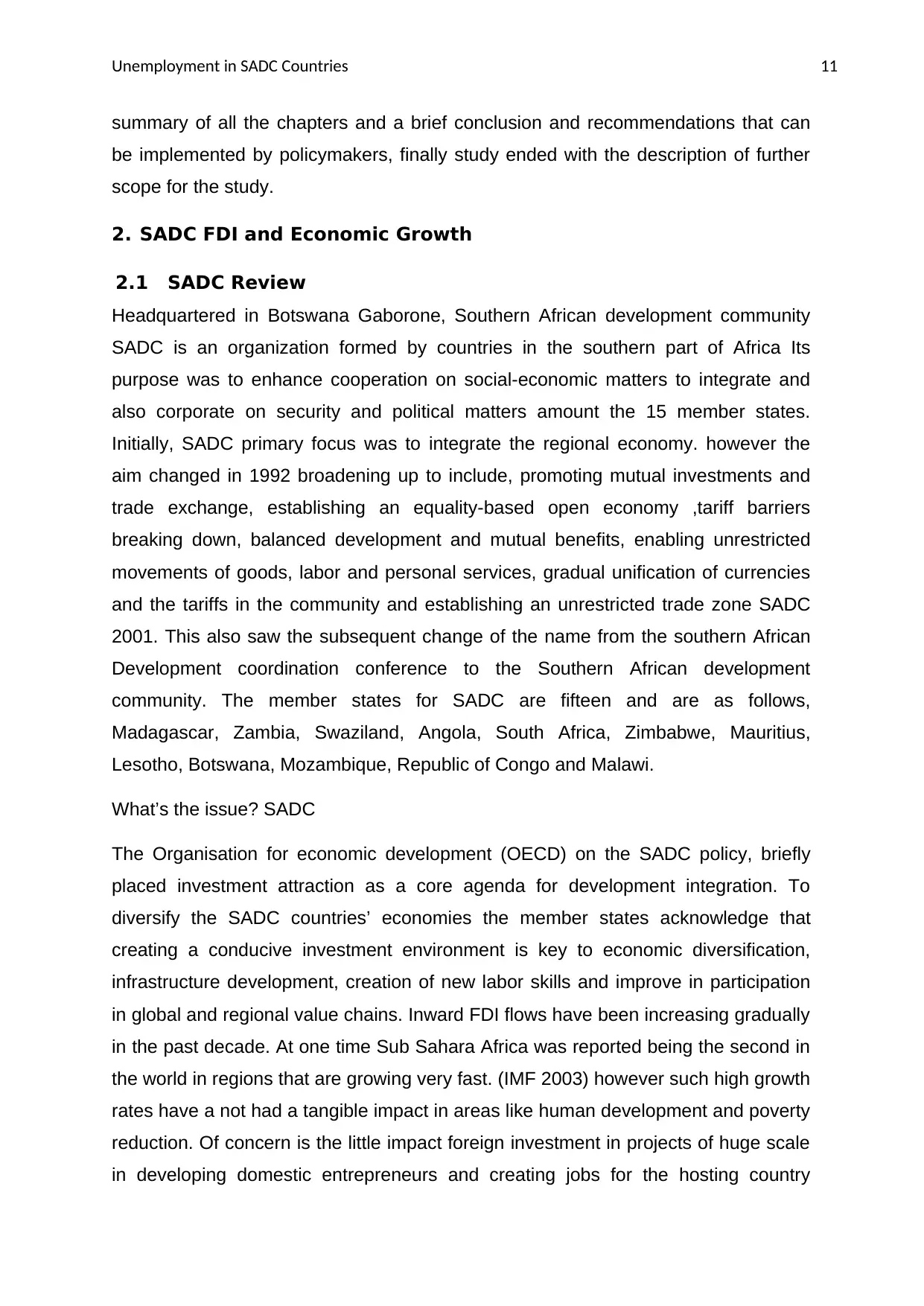
Unemployment in SADC Countries 11
summary of all the chapters and a brief conclusion and recommendations that can
be implemented by policymakers, finally study ended with the description of further
scope for the study.
2. SADC FDI and Economic Growth
2.1 SADC Review
Headquartered in Botswana Gaborone, Southern African development community
SADC is an organization formed by countries in the southern part of Africa Its
purpose was to enhance cooperation on social-economic matters to integrate and
also corporate on security and political matters amount the 15 member states.
Initially, SADC primary focus was to integrate the regional economy. however the
aim changed in 1992 broadening up to include, promoting mutual investments and
trade exchange, establishing an equality-based open economy ,tariff barriers
breaking down, balanced development and mutual benefits, enabling unrestricted
movements of goods, labor and personal services, gradual unification of currencies
and the tariffs in the community and establishing an unrestricted trade zone SADC
2001. This also saw the subsequent change of the name from the southern African
Development coordination conference to the Southern African development
community. The member states for SADC are fifteen and are as follows,
Madagascar, Zambia, Swaziland, Angola, South Africa, Zimbabwe, Mauritius,
Lesotho, Botswana, Mozambique, Republic of Congo and Malawi.
What’s the issue? SADC
The Organisation for economic development (OECD) on the SADC policy, briefly
placed investment attraction as a core agenda for development integration. To
diversify the SADC countries’ economies the member states acknowledge that
creating a conducive investment environment is key to economic diversification,
infrastructure development, creation of new labor skills and improve in participation
in global and regional value chains. Inward FDI flows have been increasing gradually
in the past decade. At one time Sub Sahara Africa was reported being the second in
the world in regions that are growing very fast. (IMF 2003) however such high growth
rates have a not had a tangible impact in areas like human development and poverty
reduction. Of concern is the little impact foreign investment in projects of huge scale
in developing domestic entrepreneurs and creating jobs for the hosting country
summary of all the chapters and a brief conclusion and recommendations that can
be implemented by policymakers, finally study ended with the description of further
scope for the study.
2. SADC FDI and Economic Growth
2.1 SADC Review
Headquartered in Botswana Gaborone, Southern African development community
SADC is an organization formed by countries in the southern part of Africa Its
purpose was to enhance cooperation on social-economic matters to integrate and
also corporate on security and political matters amount the 15 member states.
Initially, SADC primary focus was to integrate the regional economy. however the
aim changed in 1992 broadening up to include, promoting mutual investments and
trade exchange, establishing an equality-based open economy ,tariff barriers
breaking down, balanced development and mutual benefits, enabling unrestricted
movements of goods, labor and personal services, gradual unification of currencies
and the tariffs in the community and establishing an unrestricted trade zone SADC
2001. This also saw the subsequent change of the name from the southern African
Development coordination conference to the Southern African development
community. The member states for SADC are fifteen and are as follows,
Madagascar, Zambia, Swaziland, Angola, South Africa, Zimbabwe, Mauritius,
Lesotho, Botswana, Mozambique, Republic of Congo and Malawi.
What’s the issue? SADC
The Organisation for economic development (OECD) on the SADC policy, briefly
placed investment attraction as a core agenda for development integration. To
diversify the SADC countries’ economies the member states acknowledge that
creating a conducive investment environment is key to economic diversification,
infrastructure development, creation of new labor skills and improve in participation
in global and regional value chains. Inward FDI flows have been increasing gradually
in the past decade. At one time Sub Sahara Africa was reported being the second in
the world in regions that are growing very fast. (IMF 2003) however such high growth
rates have a not had a tangible impact in areas like human development and poverty
reduction. Of concern is the little impact foreign investment in projects of huge scale
in developing domestic entrepreneurs and creating jobs for the hosting country
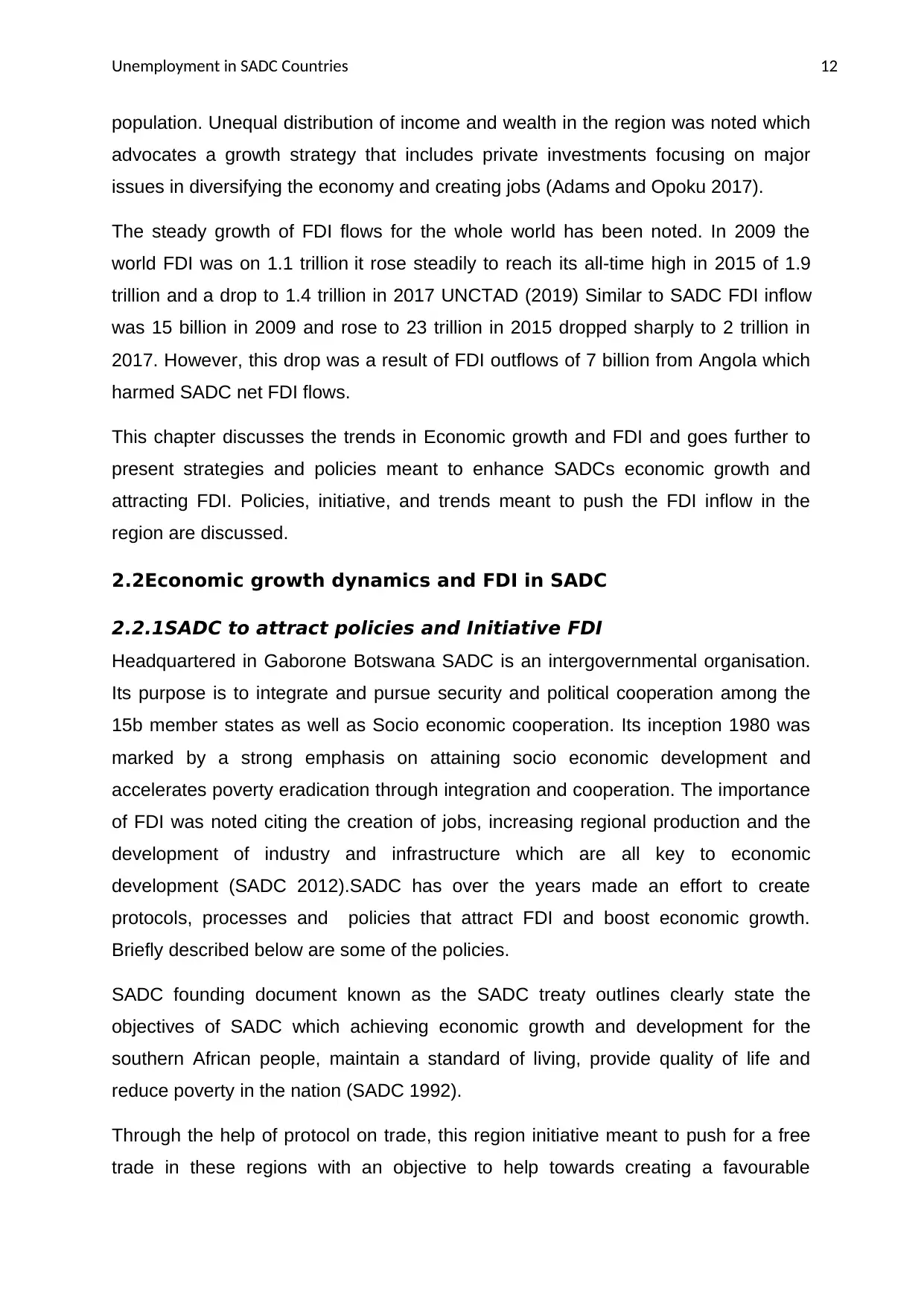
Unemployment in SADC Countries 12
population. Unequal distribution of income and wealth in the region was noted which
advocates a growth strategy that includes private investments focusing on major
issues in diversifying the economy and creating jobs (Adams and Opoku 2017).
The steady growth of FDI flows for the whole world has been noted. In 2009 the
world FDI was on 1.1 trillion it rose steadily to reach its all-time high in 2015 of 1.9
trillion and a drop to 1.4 trillion in 2017 UNCTAD (2019) Similar to SADC FDI inflow
was 15 billion in 2009 and rose to 23 trillion in 2015 dropped sharply to 2 trillion in
2017. However, this drop was a result of FDI outflows of 7 billion from Angola which
harmed SADC net FDI flows.
This chapter discusses the trends in Economic growth and FDI and goes further to
present strategies and policies meant to enhance SADCs economic growth and
attracting FDI. Policies, initiative, and trends meant to push the FDI inflow in the
region are discussed.
2.2Economic growth dynamics and FDI in SADC
2.2.1SADC to attract policies and Initiative FDI
Headquartered in Gaborone Botswana SADC is an intergovernmental organisation.
Its purpose is to integrate and pursue security and political cooperation among the
15b member states as well as Socio economic cooperation. Its inception 1980 was
marked by a strong emphasis on attaining socio economic development and
accelerates poverty eradication through integration and cooperation. The importance
of FDI was noted citing the creation of jobs, increasing regional production and the
development of industry and infrastructure which are all key to economic
development (SADC 2012).SADC has over the years made an effort to create
protocols, processes and policies that attract FDI and boost economic growth.
Briefly described below are some of the policies.
SADC founding document known as the SADC treaty outlines clearly state the
objectives of SADC which achieving economic growth and development for the
southern African people, maintain a standard of living, provide quality of life and
reduce poverty in the nation (SADC 1992).
Through the help of protocol on trade, this region initiative meant to push for a free
trade in these regions with an objective to help towards creating a favourable
population. Unequal distribution of income and wealth in the region was noted which
advocates a growth strategy that includes private investments focusing on major
issues in diversifying the economy and creating jobs (Adams and Opoku 2017).
The steady growth of FDI flows for the whole world has been noted. In 2009 the
world FDI was on 1.1 trillion it rose steadily to reach its all-time high in 2015 of 1.9
trillion and a drop to 1.4 trillion in 2017 UNCTAD (2019) Similar to SADC FDI inflow
was 15 billion in 2009 and rose to 23 trillion in 2015 dropped sharply to 2 trillion in
2017. However, this drop was a result of FDI outflows of 7 billion from Angola which
harmed SADC net FDI flows.
This chapter discusses the trends in Economic growth and FDI and goes further to
present strategies and policies meant to enhance SADCs economic growth and
attracting FDI. Policies, initiative, and trends meant to push the FDI inflow in the
region are discussed.
2.2Economic growth dynamics and FDI in SADC
2.2.1SADC to attract policies and Initiative FDI
Headquartered in Gaborone Botswana SADC is an intergovernmental organisation.
Its purpose is to integrate and pursue security and political cooperation among the
15b member states as well as Socio economic cooperation. Its inception 1980 was
marked by a strong emphasis on attaining socio economic development and
accelerates poverty eradication through integration and cooperation. The importance
of FDI was noted citing the creation of jobs, increasing regional production and the
development of industry and infrastructure which are all key to economic
development (SADC 2012).SADC has over the years made an effort to create
protocols, processes and policies that attract FDI and boost economic growth.
Briefly described below are some of the policies.
SADC founding document known as the SADC treaty outlines clearly state the
objectives of SADC which achieving economic growth and development for the
southern African people, maintain a standard of living, provide quality of life and
reduce poverty in the nation (SADC 1992).
Through the help of protocol on trade, this region initiative meant to push for a free
trade in these regions with an objective to help towards creating a favourable
Paraphrase This Document
Need a fresh take? Get an instant paraphrase of this document with our AI Paraphraser
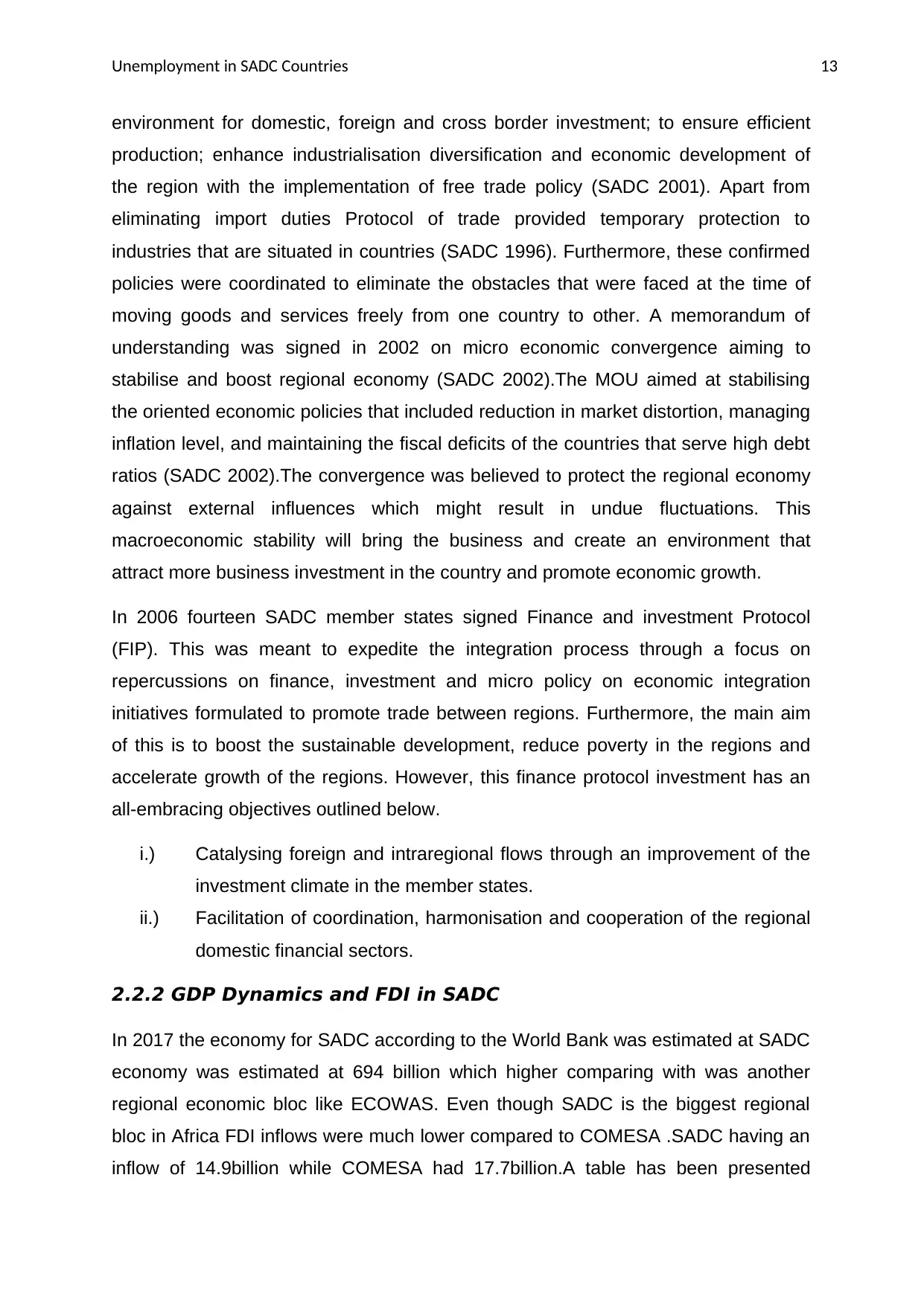
Unemployment in SADC Countries 13
environment for domestic, foreign and cross border investment; to ensure efficient
production; enhance industrialisation diversification and economic development of
the region with the implementation of free trade policy (SADC 2001). Apart from
eliminating import duties Protocol of trade provided temporary protection to
industries that are situated in countries (SADC 1996). Furthermore, these confirmed
policies were coordinated to eliminate the obstacles that were faced at the time of
moving goods and services freely from one country to other. A memorandum of
understanding was signed in 2002 on micro economic convergence aiming to
stabilise and boost regional economy (SADC 2002).The MOU aimed at stabilising
the oriented economic policies that included reduction in market distortion, managing
inflation level, and maintaining the fiscal deficits of the countries that serve high debt
ratios (SADC 2002).The convergence was believed to protect the regional economy
against external influences which might result in undue fluctuations. This
macroeconomic stability will bring the business and create an environment that
attract more business investment in the country and promote economic growth.
In 2006 fourteen SADC member states signed Finance and investment Protocol
(FIP). This was meant to expedite the integration process through a focus on
repercussions on finance, investment and micro policy on economic integration
initiatives formulated to promote trade between regions. Furthermore, the main aim
of this is to boost the sustainable development, reduce poverty in the regions and
accelerate growth of the regions. However, this finance protocol investment has an
all-embracing objectives outlined below.
i.) Catalysing foreign and intraregional flows through an improvement of the
investment climate in the member states.
ii.) Facilitation of coordination, harmonisation and cooperation of the regional
domestic financial sectors.
2.2.2 GDP Dynamics and FDI in SADC
In 2017 the economy for SADC according to the World Bank was estimated at SADC
economy was estimated at 694 billion which higher comparing with was another
regional economic bloc like ECOWAS. Even though SADC is the biggest regional
bloc in Africa FDI inflows were much lower compared to COMESA .SADC having an
inflow of 14.9billion while COMESA had 17.7billion.A table has been presented
environment for domestic, foreign and cross border investment; to ensure efficient
production; enhance industrialisation diversification and economic development of
the region with the implementation of free trade policy (SADC 2001). Apart from
eliminating import duties Protocol of trade provided temporary protection to
industries that are situated in countries (SADC 1996). Furthermore, these confirmed
policies were coordinated to eliminate the obstacles that were faced at the time of
moving goods and services freely from one country to other. A memorandum of
understanding was signed in 2002 on micro economic convergence aiming to
stabilise and boost regional economy (SADC 2002).The MOU aimed at stabilising
the oriented economic policies that included reduction in market distortion, managing
inflation level, and maintaining the fiscal deficits of the countries that serve high debt
ratios (SADC 2002).The convergence was believed to protect the regional economy
against external influences which might result in undue fluctuations. This
macroeconomic stability will bring the business and create an environment that
attract more business investment in the country and promote economic growth.
In 2006 fourteen SADC member states signed Finance and investment Protocol
(FIP). This was meant to expedite the integration process through a focus on
repercussions on finance, investment and micro policy on economic integration
initiatives formulated to promote trade between regions. Furthermore, the main aim
of this is to boost the sustainable development, reduce poverty in the regions and
accelerate growth of the regions. However, this finance protocol investment has an
all-embracing objectives outlined below.
i.) Catalysing foreign and intraregional flows through an improvement of the
investment climate in the member states.
ii.) Facilitation of coordination, harmonisation and cooperation of the regional
domestic financial sectors.
2.2.2 GDP Dynamics and FDI in SADC
In 2017 the economy for SADC according to the World Bank was estimated at SADC
economy was estimated at 694 billion which higher comparing with was another
regional economic bloc like ECOWAS. Even though SADC is the biggest regional
bloc in Africa FDI inflows were much lower compared to COMESA .SADC having an
inflow of 14.9billion while COMESA had 17.7billion.A table has been presented
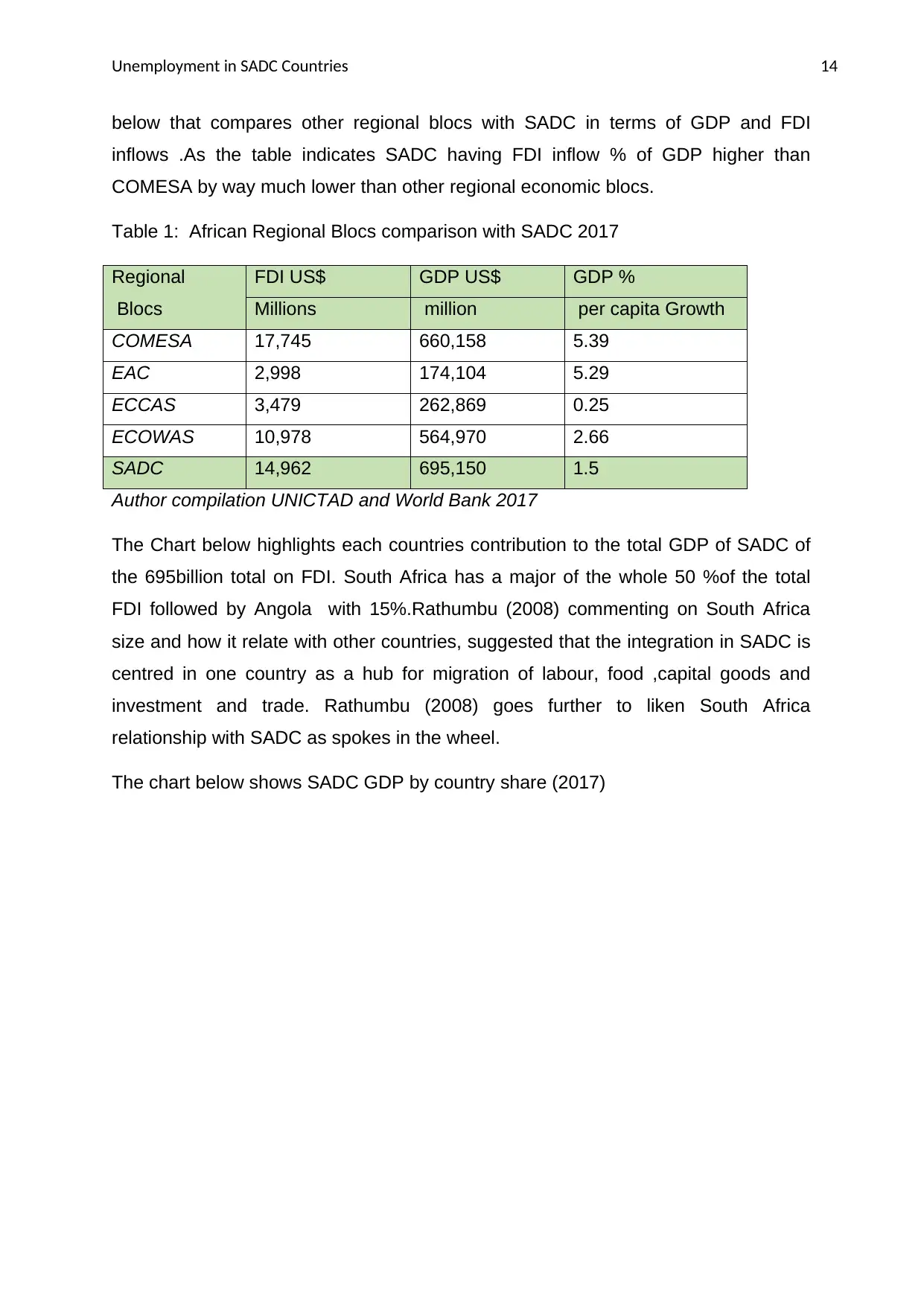
Unemployment in SADC Countries 14
below that compares other regional blocs with SADC in terms of GDP and FDI
inflows .As the table indicates SADC having FDI inflow % of GDP higher than
COMESA by way much lower than other regional economic blocs.
Table 1: African Regional Blocs comparison with SADC 2017
Regional FDI US$ GDP US$ GDP %
Blocs Millions million per capita Growth
COMESA 17,745 660,158 5.39
EAC 2,998 174,104 5.29
ECCAS 3,479 262,869 0.25
ECOWAS 10,978 564,970 2.66
SADC 14,962 695,150 1.5
Author compilation UNICTAD and World Bank 2017
The Chart below highlights each countries contribution to the total GDP of SADC of
the 695billion total on FDI. South Africa has a major of the whole 50 %of the total
FDI followed by Angola with 15%.Rathumbu (2008) commenting on South Africa
size and how it relate with other countries, suggested that the integration in SADC is
centred in one country as a hub for migration of labour, food ,capital goods and
investment and trade. Rathumbu (2008) goes further to liken South Africa
relationship with SADC as spokes in the wheel.
The chart below shows SADC GDP by country share (2017)
below that compares other regional blocs with SADC in terms of GDP and FDI
inflows .As the table indicates SADC having FDI inflow % of GDP higher than
COMESA by way much lower than other regional economic blocs.
Table 1: African Regional Blocs comparison with SADC 2017
Regional FDI US$ GDP US$ GDP %
Blocs Millions million per capita Growth
COMESA 17,745 660,158 5.39
EAC 2,998 174,104 5.29
ECCAS 3,479 262,869 0.25
ECOWAS 10,978 564,970 2.66
SADC 14,962 695,150 1.5
Author compilation UNICTAD and World Bank 2017
The Chart below highlights each countries contribution to the total GDP of SADC of
the 695billion total on FDI. South Africa has a major of the whole 50 %of the total
FDI followed by Angola with 15%.Rathumbu (2008) commenting on South Africa
size and how it relate with other countries, suggested that the integration in SADC is
centred in one country as a hub for migration of labour, food ,capital goods and
investment and trade. Rathumbu (2008) goes further to liken South Africa
relationship with SADC as spokes in the wheel.
The chart below shows SADC GDP by country share (2017)
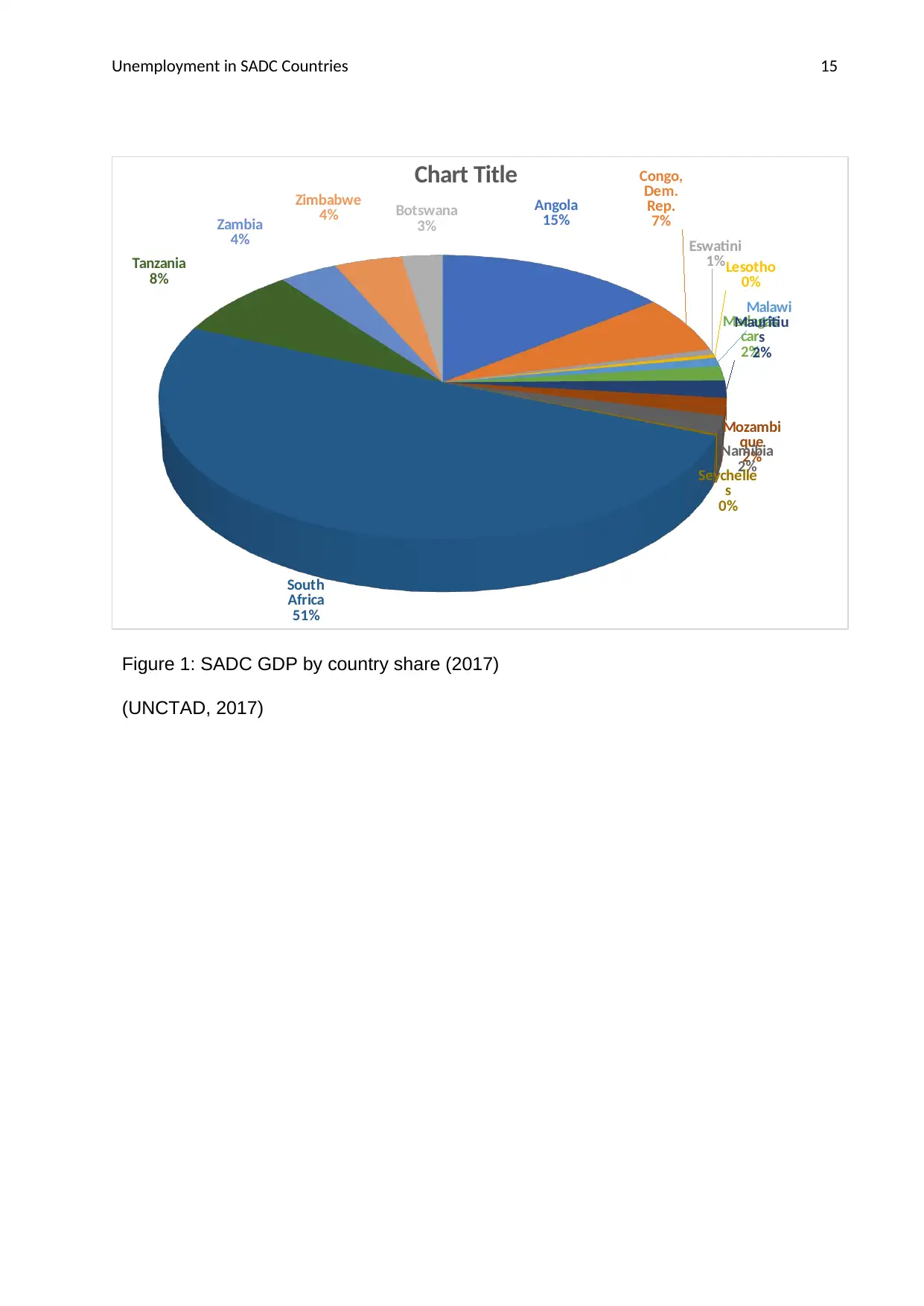
Unemployment in SADC Countries 15
Angola
15%
Congo,
Dem.
Rep.
7%
Eswatini
1%Lesotho
0%
Malawi
1%Madagas
car
2%
Mauritiu
s
2%
Mozambi
que
2%Namibia
2%
Seychelle
s
0%
South
Africa
51%
Tanzania
8%
Zambia
4%
Zimbabwe
4% Botswana
3%
Chart Title
Figure 1: SADC GDP by country share (2017)
(UNCTAD, 2017)
Angola
15%
Congo,
Dem.
Rep.
7%
Eswatini
1%Lesotho
0%
Malawi
1%Madagas
car
2%
Mauritiu
s
2%
Mozambi
que
2%Namibia
2%
Seychelle
s
0%
South
Africa
51%
Tanzania
8%
Zambia
4%
Zimbabwe
4% Botswana
3%
Chart Title
Figure 1: SADC GDP by country share (2017)
(UNCTAD, 2017)
Secure Best Marks with AI Grader
Need help grading? Try our AI Grader for instant feedback on your assignments.
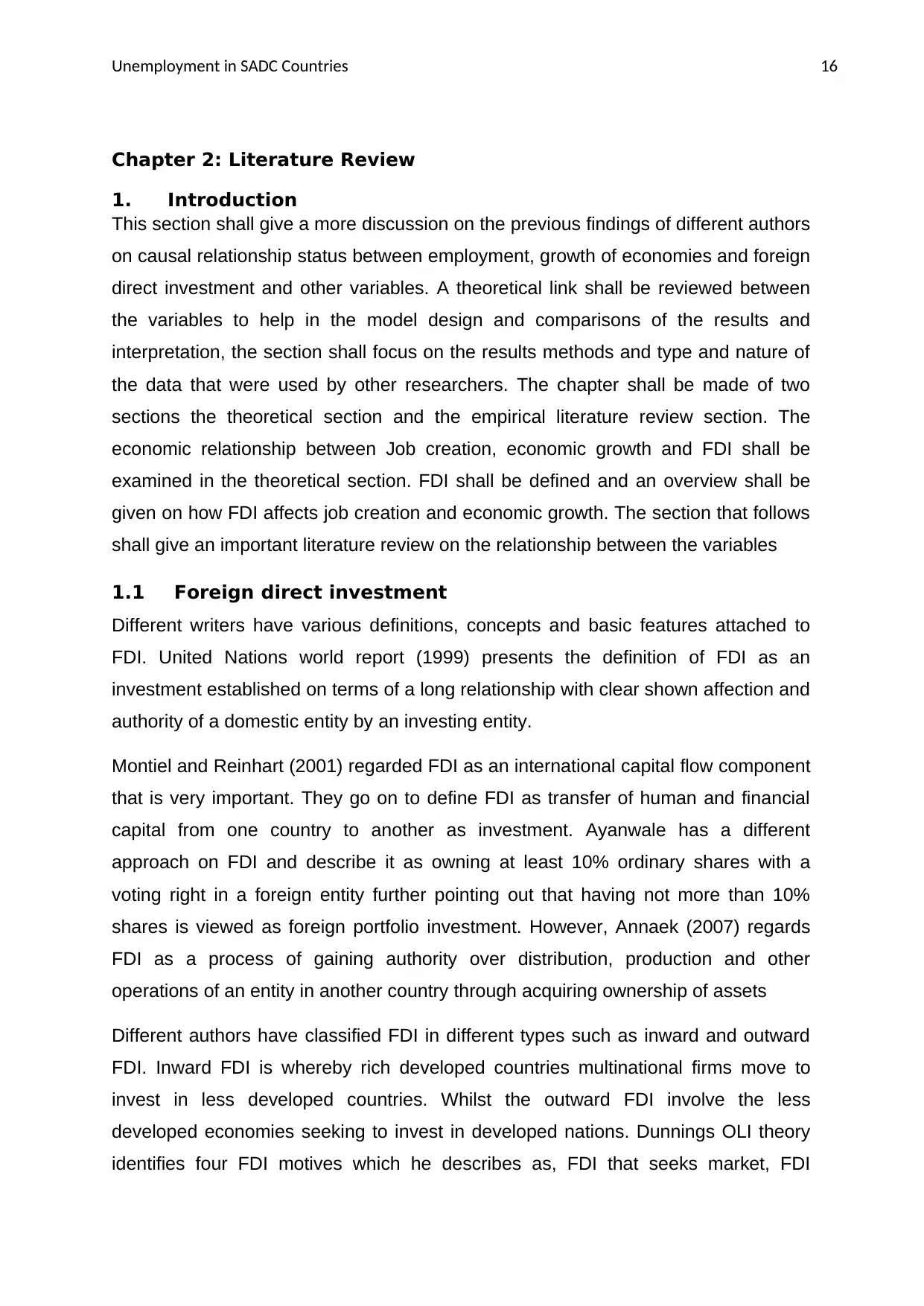
Unemployment in SADC Countries 16
Chapter 2: Literature Review
1. Introduction
This section shall give a more discussion on the previous findings of different authors
on causal relationship status between employment, growth of economies and foreign
direct investment and other variables. A theoretical link shall be reviewed between
the variables to help in the model design and comparisons of the results and
interpretation, the section shall focus on the results methods and type and nature of
the data that were used by other researchers. The chapter shall be made of two
sections the theoretical section and the empirical literature review section. The
economic relationship between Job creation, economic growth and FDI shall be
examined in the theoretical section. FDI shall be defined and an overview shall be
given on how FDI affects job creation and economic growth. The section that follows
shall give an important literature review on the relationship between the variables
1.1 Foreign direct investment
Different writers have various definitions, concepts and basic features attached to
FDI. United Nations world report (1999) presents the definition of FDI as an
investment established on terms of a long relationship with clear shown affection and
authority of a domestic entity by an investing entity.
Montiel and Reinhart (2001) regarded FDI as an international capital flow component
that is very important. They go on to define FDI as transfer of human and financial
capital from one country to another as investment. Ayanwale has a different
approach on FDI and describe it as owning at least 10% ordinary shares with a
voting right in a foreign entity further pointing out that having not more than 10%
shares is viewed as foreign portfolio investment. However, Annaek (2007) regards
FDI as a process of gaining authority over distribution, production and other
operations of an entity in another country through acquiring ownership of assets
Different authors have classified FDI in different types such as inward and outward
FDI. Inward FDI is whereby rich developed countries multinational firms move to
invest in less developed countries. Whilst the outward FDI involve the less
developed economies seeking to invest in developed nations. Dunnings OLI theory
identifies four FDI motives which he describes as, FDI that seeks market, FDI
Chapter 2: Literature Review
1. Introduction
This section shall give a more discussion on the previous findings of different authors
on causal relationship status between employment, growth of economies and foreign
direct investment and other variables. A theoretical link shall be reviewed between
the variables to help in the model design and comparisons of the results and
interpretation, the section shall focus on the results methods and type and nature of
the data that were used by other researchers. The chapter shall be made of two
sections the theoretical section and the empirical literature review section. The
economic relationship between Job creation, economic growth and FDI shall be
examined in the theoretical section. FDI shall be defined and an overview shall be
given on how FDI affects job creation and economic growth. The section that follows
shall give an important literature review on the relationship between the variables
1.1 Foreign direct investment
Different writers have various definitions, concepts and basic features attached to
FDI. United Nations world report (1999) presents the definition of FDI as an
investment established on terms of a long relationship with clear shown affection and
authority of a domestic entity by an investing entity.
Montiel and Reinhart (2001) regarded FDI as an international capital flow component
that is very important. They go on to define FDI as transfer of human and financial
capital from one country to another as investment. Ayanwale has a different
approach on FDI and describe it as owning at least 10% ordinary shares with a
voting right in a foreign entity further pointing out that having not more than 10%
shares is viewed as foreign portfolio investment. However, Annaek (2007) regards
FDI as a process of gaining authority over distribution, production and other
operations of an entity in another country through acquiring ownership of assets
Different authors have classified FDI in different types such as inward and outward
FDI. Inward FDI is whereby rich developed countries multinational firms move to
invest in less developed countries. Whilst the outward FDI involve the less
developed economies seeking to invest in developed nations. Dunnings OLI theory
identifies four FDI motives which he describes as, FDI that seeks market, FDI
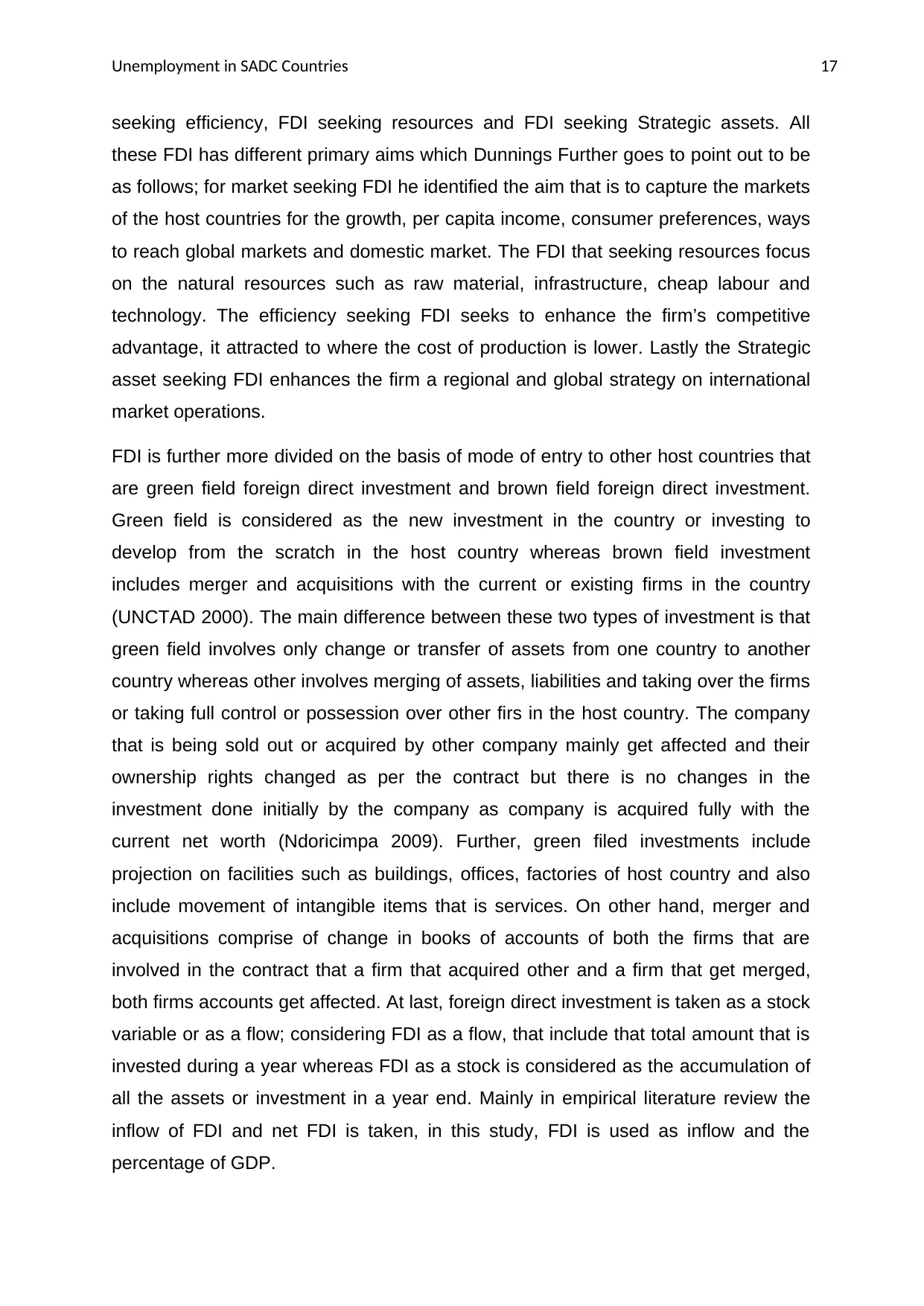
Unemployment in SADC Countries 17
seeking efficiency, FDI seeking resources and FDI seeking Strategic assets. All
these FDI has different primary aims which Dunnings Further goes to point out to be
as follows; for market seeking FDI he identified the aim that is to capture the markets
of the host countries for the growth, per capita income, consumer preferences, ways
to reach global markets and domestic market. The FDI that seeking resources focus
on the natural resources such as raw material, infrastructure, cheap labour and
technology. The efficiency seeking FDI seeks to enhance the firm’s competitive
advantage, it attracted to where the cost of production is lower. Lastly the Strategic
asset seeking FDI enhances the firm a regional and global strategy on international
market operations.
FDI is further more divided on the basis of mode of entry to other host countries that
are green field foreign direct investment and brown field foreign direct investment.
Green field is considered as the new investment in the country or investing to
develop from the scratch in the host country whereas brown field investment
includes merger and acquisitions with the current or existing firms in the country
(UNCTAD 2000). The main difference between these two types of investment is that
green field involves only change or transfer of assets from one country to another
country whereas other involves merging of assets, liabilities and taking over the firms
or taking full control or possession over other firs in the host country. The company
that is being sold out or acquired by other company mainly get affected and their
ownership rights changed as per the contract but there is no changes in the
investment done initially by the company as company is acquired fully with the
current net worth (Ndoricimpa 2009). Further, green filed investments include
projection on facilities such as buildings, offices, factories of host country and also
include movement of intangible items that is services. On other hand, merger and
acquisitions comprise of change in books of accounts of both the firms that are
involved in the contract that a firm that acquired other and a firm that get merged,
both firms accounts get affected. At last, foreign direct investment is taken as a stock
variable or as a flow; considering FDI as a flow, that include that total amount that is
invested during a year whereas FDI as a stock is considered as the accumulation of
all the assets or investment in a year end. Mainly in empirical literature review the
inflow of FDI and net FDI is taken, in this study, FDI is used as inflow and the
percentage of GDP.
seeking efficiency, FDI seeking resources and FDI seeking Strategic assets. All
these FDI has different primary aims which Dunnings Further goes to point out to be
as follows; for market seeking FDI he identified the aim that is to capture the markets
of the host countries for the growth, per capita income, consumer preferences, ways
to reach global markets and domestic market. The FDI that seeking resources focus
on the natural resources such as raw material, infrastructure, cheap labour and
technology. The efficiency seeking FDI seeks to enhance the firm’s competitive
advantage, it attracted to where the cost of production is lower. Lastly the Strategic
asset seeking FDI enhances the firm a regional and global strategy on international
market operations.
FDI is further more divided on the basis of mode of entry to other host countries that
are green field foreign direct investment and brown field foreign direct investment.
Green field is considered as the new investment in the country or investing to
develop from the scratch in the host country whereas brown field investment
includes merger and acquisitions with the current or existing firms in the country
(UNCTAD 2000). The main difference between these two types of investment is that
green field involves only change or transfer of assets from one country to another
country whereas other involves merging of assets, liabilities and taking over the firms
or taking full control or possession over other firs in the host country. The company
that is being sold out or acquired by other company mainly get affected and their
ownership rights changed as per the contract but there is no changes in the
investment done initially by the company as company is acquired fully with the
current net worth (Ndoricimpa 2009). Further, green filed investments include
projection on facilities such as buildings, offices, factories of host country and also
include movement of intangible items that is services. On other hand, merger and
acquisitions comprise of change in books of accounts of both the firms that are
involved in the contract that a firm that acquired other and a firm that get merged,
both firms accounts get affected. At last, foreign direct investment is taken as a stock
variable or as a flow; considering FDI as a flow, that include that total amount that is
invested during a year whereas FDI as a stock is considered as the accumulation of
all the assets or investment in a year end. Mainly in empirical literature review the
inflow of FDI and net FDI is taken, in this study, FDI is used as inflow and the
percentage of GDP.
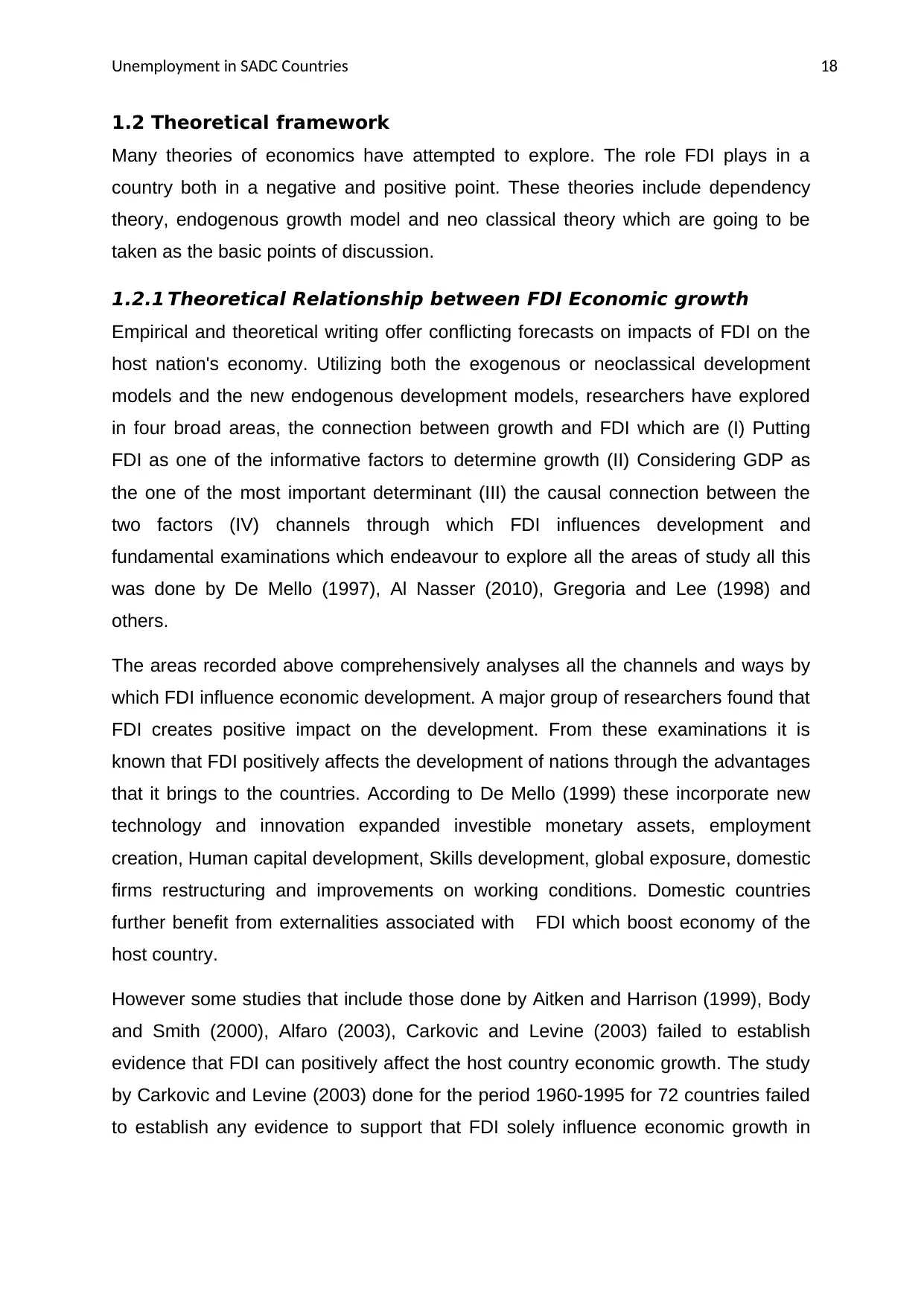
Unemployment in SADC Countries 18
1.2 Theoretical framework
Many theories of economics have attempted to explore. The role FDI plays in a
country both in a negative and positive point. These theories include dependency
theory, endogenous growth model and neo classical theory which are going to be
taken as the basic points of discussion.
1.2.1 Theoretical Relationship between FDI Economic growth
Empirical and theoretical writing offer conflicting forecasts on impacts of FDI on the
host nation's economy. Utilizing both the exogenous or neoclassical development
models and the new endogenous development models, researchers have explored
in four broad areas, the connection between growth and FDI which are (I) Putting
FDI as one of the informative factors to determine growth (II) Considering GDP as
the one of the most important determinant (III) the causal connection between the
two factors (IV) channels through which FDI influences development and
fundamental examinations which endeavour to explore all the areas of study all this
was done by De Mello (1997), Al Nasser (2010), Gregoria and Lee (1998) and
others.
The areas recorded above comprehensively analyses all the channels and ways by
which FDI influence economic development. A major group of researchers found that
FDI creates positive impact on the development. From these examinations it is
known that FDI positively affects the development of nations through the advantages
that it brings to the countries. According to De Mello (1999) these incorporate new
technology and innovation expanded investible monetary assets, employment
creation, Human capital development, Skills development, global exposure, domestic
firms restructuring and improvements on working conditions. Domestic countries
further benefit from externalities associated with FDI which boost economy of the
host country.
However some studies that include those done by Aitken and Harrison (1999), Body
and Smith (2000), Alfaro (2003), Carkovic and Levine (2003) failed to establish
evidence that FDI can positively affect the host country economic growth. The study
by Carkovic and Levine (2003) done for the period 1960-1995 for 72 countries failed
to establish any evidence to support that FDI solely influence economic growth in
1.2 Theoretical framework
Many theories of economics have attempted to explore. The role FDI plays in a
country both in a negative and positive point. These theories include dependency
theory, endogenous growth model and neo classical theory which are going to be
taken as the basic points of discussion.
1.2.1 Theoretical Relationship between FDI Economic growth
Empirical and theoretical writing offer conflicting forecasts on impacts of FDI on the
host nation's economy. Utilizing both the exogenous or neoclassical development
models and the new endogenous development models, researchers have explored
in four broad areas, the connection between growth and FDI which are (I) Putting
FDI as one of the informative factors to determine growth (II) Considering GDP as
the one of the most important determinant (III) the causal connection between the
two factors (IV) channels through which FDI influences development and
fundamental examinations which endeavour to explore all the areas of study all this
was done by De Mello (1997), Al Nasser (2010), Gregoria and Lee (1998) and
others.
The areas recorded above comprehensively analyses all the channels and ways by
which FDI influence economic development. A major group of researchers found that
FDI creates positive impact on the development. From these examinations it is
known that FDI positively affects the development of nations through the advantages
that it brings to the countries. According to De Mello (1999) these incorporate new
technology and innovation expanded investible monetary assets, employment
creation, Human capital development, Skills development, global exposure, domestic
firms restructuring and improvements on working conditions. Domestic countries
further benefit from externalities associated with FDI which boost economy of the
host country.
However some studies that include those done by Aitken and Harrison (1999), Body
and Smith (2000), Alfaro (2003), Carkovic and Levine (2003) failed to establish
evidence that FDI can positively affect the host country economic growth. The study
by Carkovic and Levine (2003) done for the period 1960-1995 for 72 countries failed
to establish any evidence to support that FDI solely influence economic growth in
Paraphrase This Document
Need a fresh take? Get an instant paraphrase of this document with our AI Paraphraser
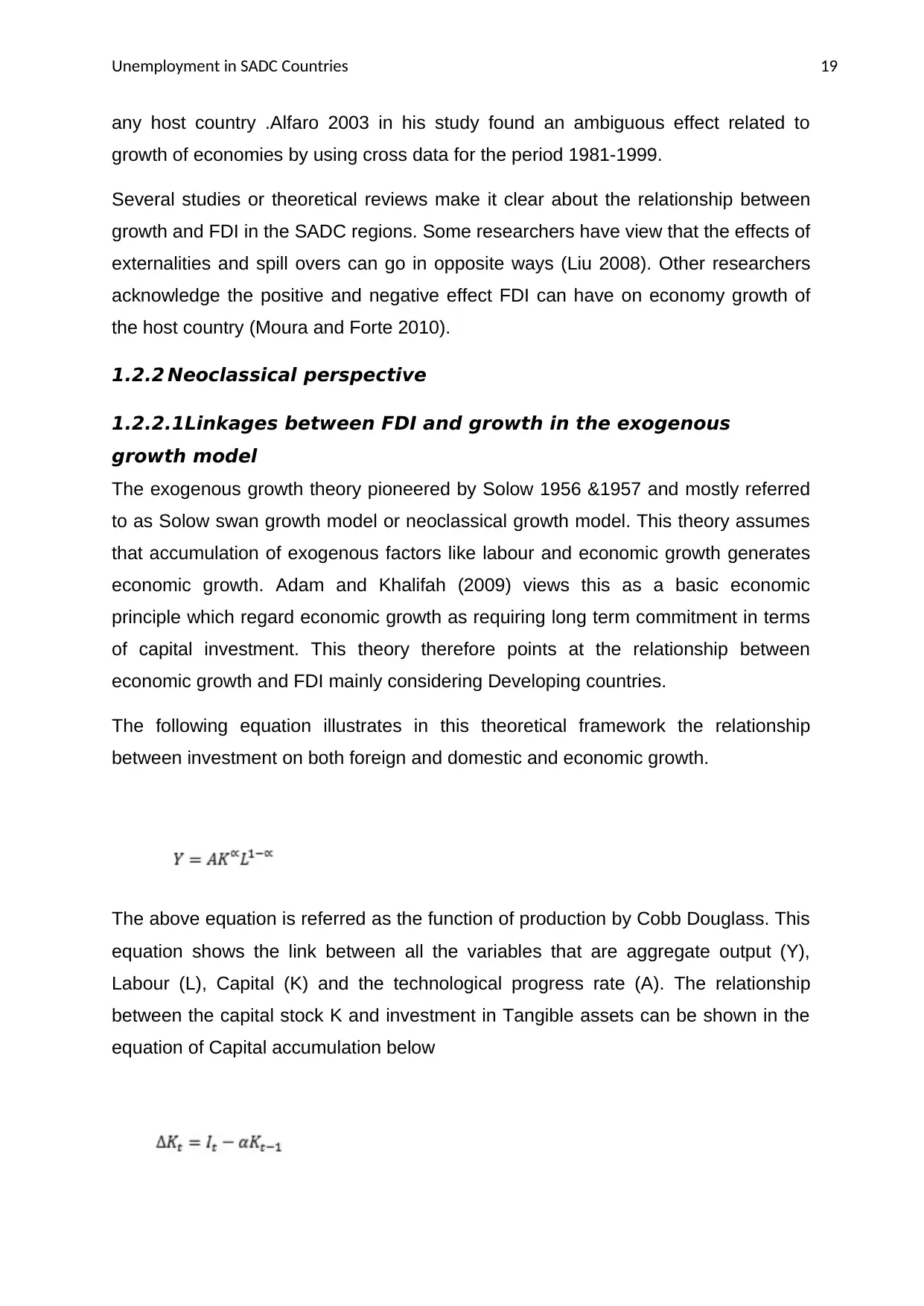
Unemployment in SADC Countries 19
any host country .Alfaro 2003 in his study found an ambiguous effect related to
growth of economies by using cross data for the period 1981-1999.
Several studies or theoretical reviews make it clear about the relationship between
growth and FDI in the SADC regions. Some researchers have view that the effects of
externalities and spill overs can go in opposite ways (Liu 2008). Other researchers
acknowledge the positive and negative effect FDI can have on economy growth of
the host country (Moura and Forte 2010).
1.2.2 Neoclassical perspective
1.2.2.1Linkages between FDI and growth in the exogenous
growth model
The exogenous growth theory pioneered by Solow 1956 &1957 and mostly referred
to as Solow swan growth model or neoclassical growth model. This theory assumes
that accumulation of exogenous factors like labour and economic growth generates
economic growth. Adam and Khalifah (2009) views this as a basic economic
principle which regard economic growth as requiring long term commitment in terms
of capital investment. This theory therefore points at the relationship between
economic growth and FDI mainly considering Developing countries.
The following equation illustrates in this theoretical framework the relationship
between investment on both foreign and domestic and economic growth.
The above equation is referred as the function of production by Cobb Douglass. This
equation shows the link between all the variables that are aggregate output (Y),
Labour (L), Capital (K) and the technological progress rate (A). The relationship
between the capital stock K and investment in Tangible assets can be shown in the
equation of Capital accumulation below
any host country .Alfaro 2003 in his study found an ambiguous effect related to
growth of economies by using cross data for the period 1981-1999.
Several studies or theoretical reviews make it clear about the relationship between
growth and FDI in the SADC regions. Some researchers have view that the effects of
externalities and spill overs can go in opposite ways (Liu 2008). Other researchers
acknowledge the positive and negative effect FDI can have on economy growth of
the host country (Moura and Forte 2010).
1.2.2 Neoclassical perspective
1.2.2.1Linkages between FDI and growth in the exogenous
growth model
The exogenous growth theory pioneered by Solow 1956 &1957 and mostly referred
to as Solow swan growth model or neoclassical growth model. This theory assumes
that accumulation of exogenous factors like labour and economic growth generates
economic growth. Adam and Khalifah (2009) views this as a basic economic
principle which regard economic growth as requiring long term commitment in terms
of capital investment. This theory therefore points at the relationship between
economic growth and FDI mainly considering Developing countries.
The following equation illustrates in this theoretical framework the relationship
between investment on both foreign and domestic and economic growth.
The above equation is referred as the function of production by Cobb Douglass. This
equation shows the link between all the variables that are aggregate output (Y),
Labour (L), Capital (K) and the technological progress rate (A). The relationship
between the capital stock K and investment in Tangible assets can be shown in the
equation of Capital accumulation below
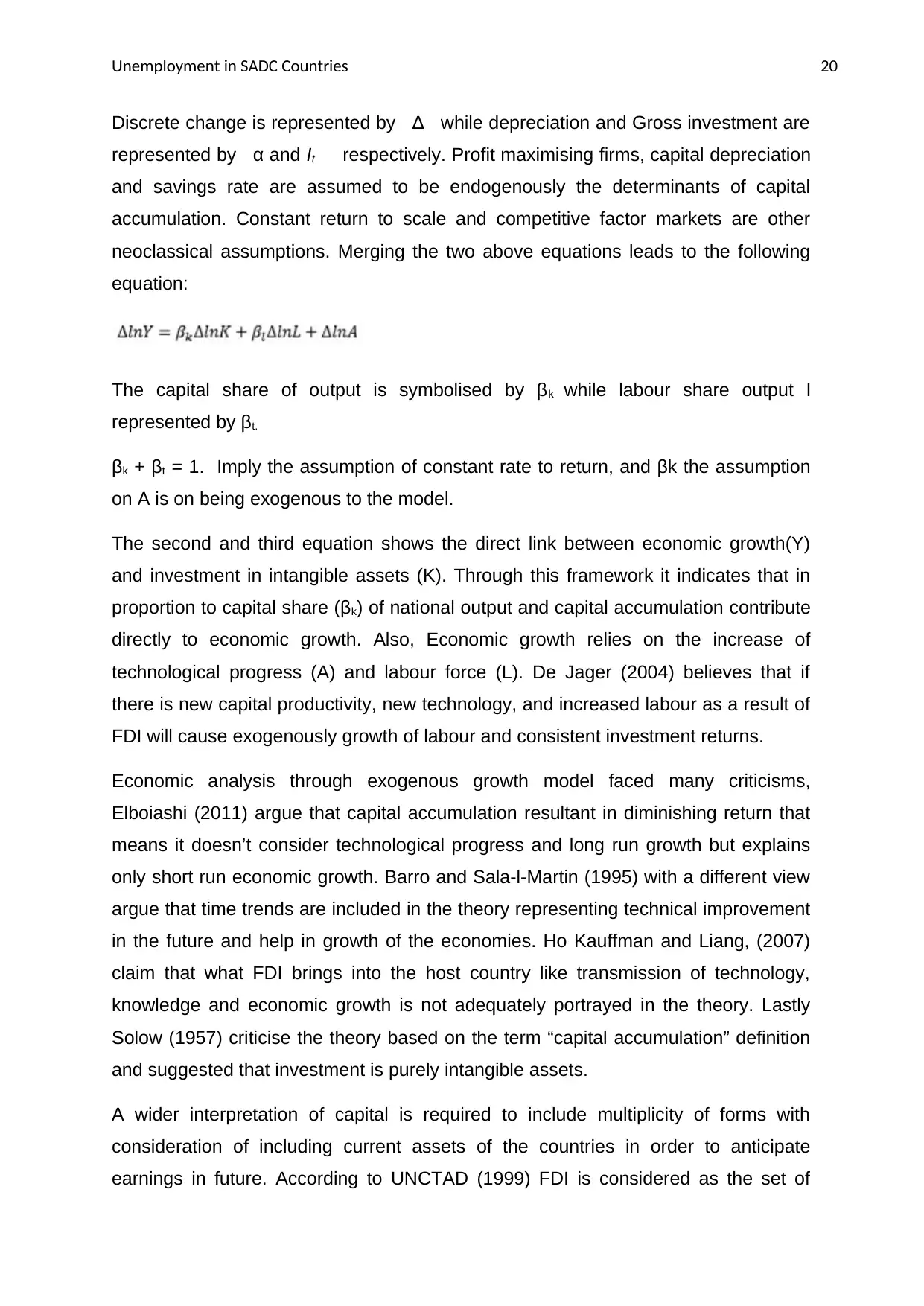
Unemployment in SADC Countries 20
Discrete change is represented by ∆ while depreciation and Gross investment are
represented by α and It respectively. Profit maximising firms, capital depreciation
and savings rate are assumed to be endogenously the determinants of capital
accumulation. Constant return to scale and competitive factor markets are other
neoclassical assumptions. Merging the two above equations leads to the following
equation:
The capital share of output is symbolised by βk while labour share output I
represented by βt.
βk + βt = 1. Imply the assumption of constant rate to return, and βk the assumption
on A is on being exogenous to the model.
The second and third equation shows the direct link between economic growth(Y)
and investment in intangible assets (K). Through this framework it indicates that in
proportion to capital share (βk) of national output and capital accumulation contribute
directly to economic growth. Also, Economic growth relies on the increase of
technological progress (A) and labour force (L). De Jager (2004) believes that if
there is new capital productivity, new technology, and increased labour as a result of
FDI will cause exogenously growth of labour and consistent investment returns.
Economic analysis through exogenous growth model faced many criticisms,
Elboiashi (2011) argue that capital accumulation resultant in diminishing return that
means it doesn’t consider technological progress and long run growth but explains
only short run economic growth. Barro and Sala-l-Martin (1995) with a different view
argue that time trends are included in the theory representing technical improvement
in the future and help in growth of the economies. Ho Kauffman and Liang, (2007)
claim that what FDI brings into the host country like transmission of technology,
knowledge and economic growth is not adequately portrayed in the theory. Lastly
Solow (1957) criticise the theory based on the term “capital accumulation” definition
and suggested that investment is purely intangible assets.
A wider interpretation of capital is required to include multiplicity of forms with
consideration of including current assets of the countries in order to anticipate
earnings in future. According to UNCTAD (1999) FDI is considered as the set of
Discrete change is represented by ∆ while depreciation and Gross investment are
represented by α and It respectively. Profit maximising firms, capital depreciation
and savings rate are assumed to be endogenously the determinants of capital
accumulation. Constant return to scale and competitive factor markets are other
neoclassical assumptions. Merging the two above equations leads to the following
equation:
The capital share of output is symbolised by βk while labour share output I
represented by βt.
βk + βt = 1. Imply the assumption of constant rate to return, and βk the assumption
on A is on being exogenous to the model.
The second and third equation shows the direct link between economic growth(Y)
and investment in intangible assets (K). Through this framework it indicates that in
proportion to capital share (βk) of national output and capital accumulation contribute
directly to economic growth. Also, Economic growth relies on the increase of
technological progress (A) and labour force (L). De Jager (2004) believes that if
there is new capital productivity, new technology, and increased labour as a result of
FDI will cause exogenously growth of labour and consistent investment returns.
Economic analysis through exogenous growth model faced many criticisms,
Elboiashi (2011) argue that capital accumulation resultant in diminishing return that
means it doesn’t consider technological progress and long run growth but explains
only short run economic growth. Barro and Sala-l-Martin (1995) with a different view
argue that time trends are included in the theory representing technical improvement
in the future and help in growth of the economies. Ho Kauffman and Liang, (2007)
claim that what FDI brings into the host country like transmission of technology,
knowledge and economic growth is not adequately portrayed in the theory. Lastly
Solow (1957) criticise the theory based on the term “capital accumulation” definition
and suggested that investment is purely intangible assets.
A wider interpretation of capital is required to include multiplicity of forms with
consideration of including current assets of the countries in order to anticipate
earnings in future. According to UNCTAD (1999) FDI is considered as the set of
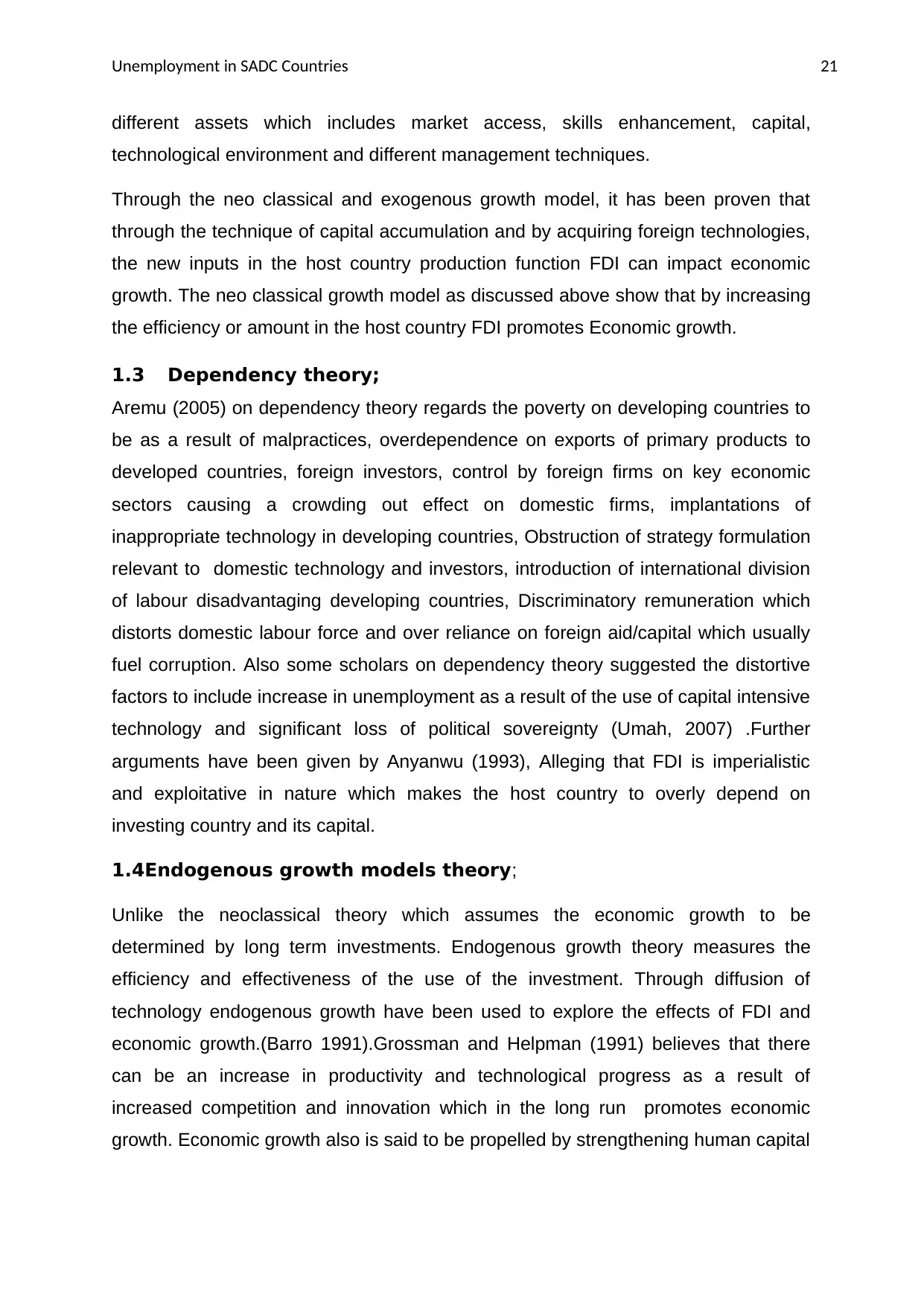
Unemployment in SADC Countries 21
different assets which includes market access, skills enhancement, capital,
technological environment and different management techniques.
Through the neo classical and exogenous growth model, it has been proven that
through the technique of capital accumulation and by acquiring foreign technologies,
the new inputs in the host country production function FDI can impact economic
growth. The neo classical growth model as discussed above show that by increasing
the efficiency or amount in the host country FDI promotes Economic growth.
1.3 Dependency theory;
Aremu (2005) on dependency theory regards the poverty on developing countries to
be as a result of malpractices, overdependence on exports of primary products to
developed countries, foreign investors, control by foreign firms on key economic
sectors causing a crowding out effect on domestic firms, implantations of
inappropriate technology in developing countries, Obstruction of strategy formulation
relevant to domestic technology and investors, introduction of international division
of labour disadvantaging developing countries, Discriminatory remuneration which
distorts domestic labour force and over reliance on foreign aid/capital which usually
fuel corruption. Also some scholars on dependency theory suggested the distortive
factors to include increase in unemployment as a result of the use of capital intensive
technology and significant loss of political sovereignty (Umah, 2007) .Further
arguments have been given by Anyanwu (1993), Alleging that FDI is imperialistic
and exploitative in nature which makes the host country to overly depend on
investing country and its capital.
1.4Endogenous growth models theory;
Unlike the neoclassical theory which assumes the economic growth to be
determined by long term investments. Endogenous growth theory measures the
efficiency and effectiveness of the use of the investment. Through diffusion of
technology endogenous growth have been used to explore the effects of FDI and
economic growth.(Barro 1991).Grossman and Helpman (1991) believes that there
can be an increase in productivity and technological progress as a result of
increased competition and innovation which in the long run promotes economic
growth. Economic growth also is said to be propelled by strengthening human capital
different assets which includes market access, skills enhancement, capital,
technological environment and different management techniques.
Through the neo classical and exogenous growth model, it has been proven that
through the technique of capital accumulation and by acquiring foreign technologies,
the new inputs in the host country production function FDI can impact economic
growth. The neo classical growth model as discussed above show that by increasing
the efficiency or amount in the host country FDI promotes Economic growth.
1.3 Dependency theory;
Aremu (2005) on dependency theory regards the poverty on developing countries to
be as a result of malpractices, overdependence on exports of primary products to
developed countries, foreign investors, control by foreign firms on key economic
sectors causing a crowding out effect on domestic firms, implantations of
inappropriate technology in developing countries, Obstruction of strategy formulation
relevant to domestic technology and investors, introduction of international division
of labour disadvantaging developing countries, Discriminatory remuneration which
distorts domestic labour force and over reliance on foreign aid/capital which usually
fuel corruption. Also some scholars on dependency theory suggested the distortive
factors to include increase in unemployment as a result of the use of capital intensive
technology and significant loss of political sovereignty (Umah, 2007) .Further
arguments have been given by Anyanwu (1993), Alleging that FDI is imperialistic
and exploitative in nature which makes the host country to overly depend on
investing country and its capital.
1.4Endogenous growth models theory;
Unlike the neoclassical theory which assumes the economic growth to be
determined by long term investments. Endogenous growth theory measures the
efficiency and effectiveness of the use of the investment. Through diffusion of
technology endogenous growth have been used to explore the effects of FDI and
economic growth.(Barro 1991).Grossman and Helpman (1991) believes that there
can be an increase in productivity and technological progress as a result of
increased competition and innovation which in the long run promotes economic
growth. Economic growth also is said to be propelled by strengthening human capital
Secure Best Marks with AI Grader
Need help grading? Try our AI Grader for instant feedback on your assignments.
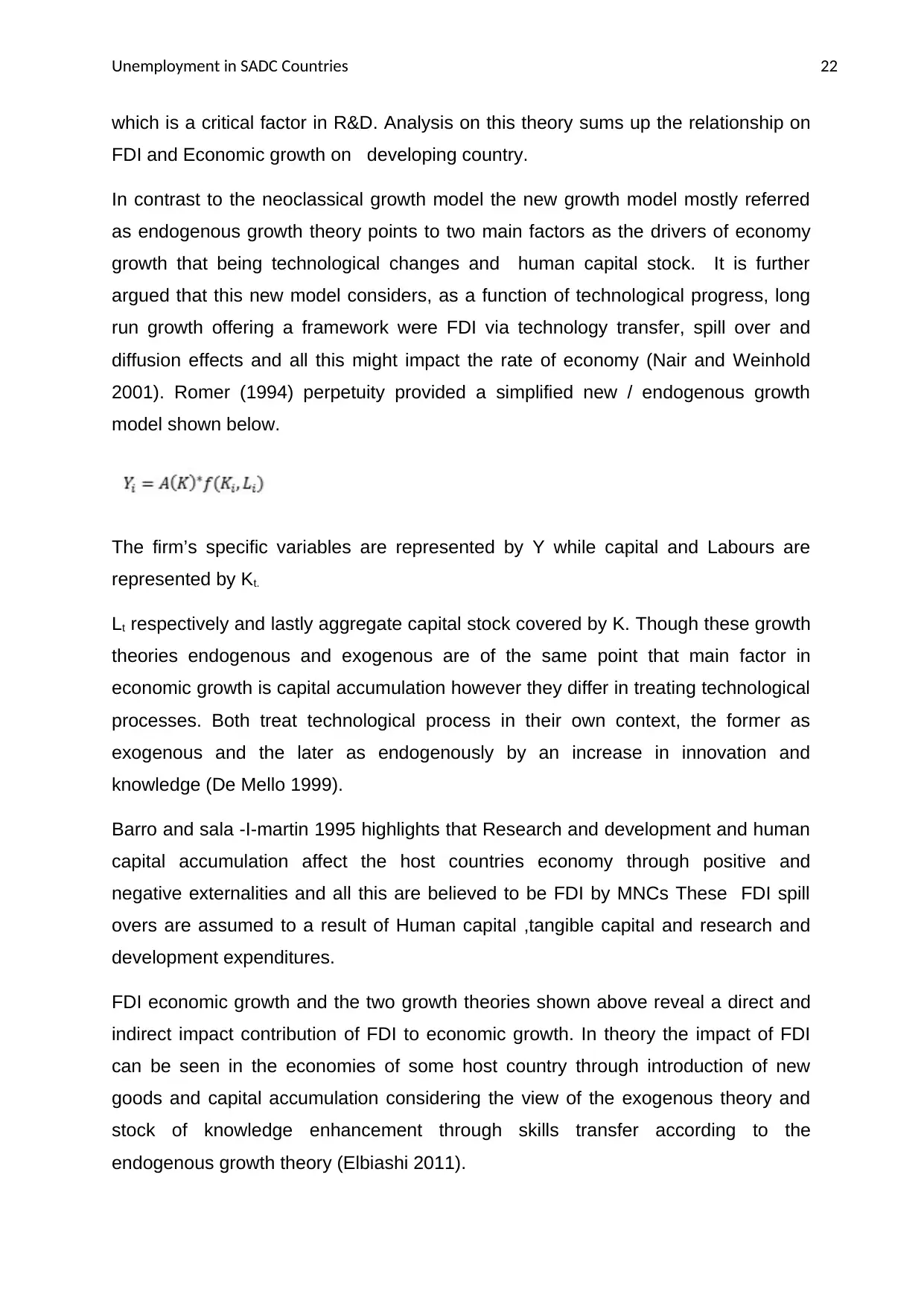
Unemployment in SADC Countries 22
which is a critical factor in R&D. Analysis on this theory sums up the relationship on
FDI and Economic growth on developing country.
In contrast to the neoclassical growth model the new growth model mostly referred
as endogenous growth theory points to two main factors as the drivers of economy
growth that being technological changes and human capital stock. It is further
argued that this new model considers, as a function of technological progress, long
run growth offering a framework were FDI via technology transfer, spill over and
diffusion effects and all this might impact the rate of economy (Nair and Weinhold
2001). Romer (1994) perpetuity provided a simplified new / endogenous growth
model shown below.
The firm’s specific variables are represented by Y while capital and Labours are
represented by Kt.
Lt respectively and lastly aggregate capital stock covered by K. Though these growth
theories endogenous and exogenous are of the same point that main factor in
economic growth is capital accumulation however they differ in treating technological
processes. Both treat technological process in their own context, the former as
exogenous and the later as endogenously by an increase in innovation and
knowledge (De Mello 1999).
Barro and sala -I-martin 1995 highlights that Research and development and human
capital accumulation affect the host countries economy through positive and
negative externalities and all this are believed to be FDI by MNCs These FDI spill
overs are assumed to a result of Human capital ,tangible capital and research and
development expenditures.
FDI economic growth and the two growth theories shown above reveal a direct and
indirect impact contribution of FDI to economic growth. In theory the impact of FDI
can be seen in the economies of some host country through introduction of new
goods and capital accumulation considering the view of the exogenous theory and
stock of knowledge enhancement through skills transfer according to the
endogenous growth theory (Elbiashi 2011).
which is a critical factor in R&D. Analysis on this theory sums up the relationship on
FDI and Economic growth on developing country.
In contrast to the neoclassical growth model the new growth model mostly referred
as endogenous growth theory points to two main factors as the drivers of economy
growth that being technological changes and human capital stock. It is further
argued that this new model considers, as a function of technological progress, long
run growth offering a framework were FDI via technology transfer, spill over and
diffusion effects and all this might impact the rate of economy (Nair and Weinhold
2001). Romer (1994) perpetuity provided a simplified new / endogenous growth
model shown below.
The firm’s specific variables are represented by Y while capital and Labours are
represented by Kt.
Lt respectively and lastly aggregate capital stock covered by K. Though these growth
theories endogenous and exogenous are of the same point that main factor in
economic growth is capital accumulation however they differ in treating technological
processes. Both treat technological process in their own context, the former as
exogenous and the later as endogenously by an increase in innovation and
knowledge (De Mello 1999).
Barro and sala -I-martin 1995 highlights that Research and development and human
capital accumulation affect the host countries economy through positive and
negative externalities and all this are believed to be FDI by MNCs These FDI spill
overs are assumed to a result of Human capital ,tangible capital and research and
development expenditures.
FDI economic growth and the two growth theories shown above reveal a direct and
indirect impact contribution of FDI to economic growth. In theory the impact of FDI
can be seen in the economies of some host country through introduction of new
goods and capital accumulation considering the view of the exogenous theory and
stock of knowledge enhancement through skills transfer according to the
endogenous growth theory (Elbiashi 2011).
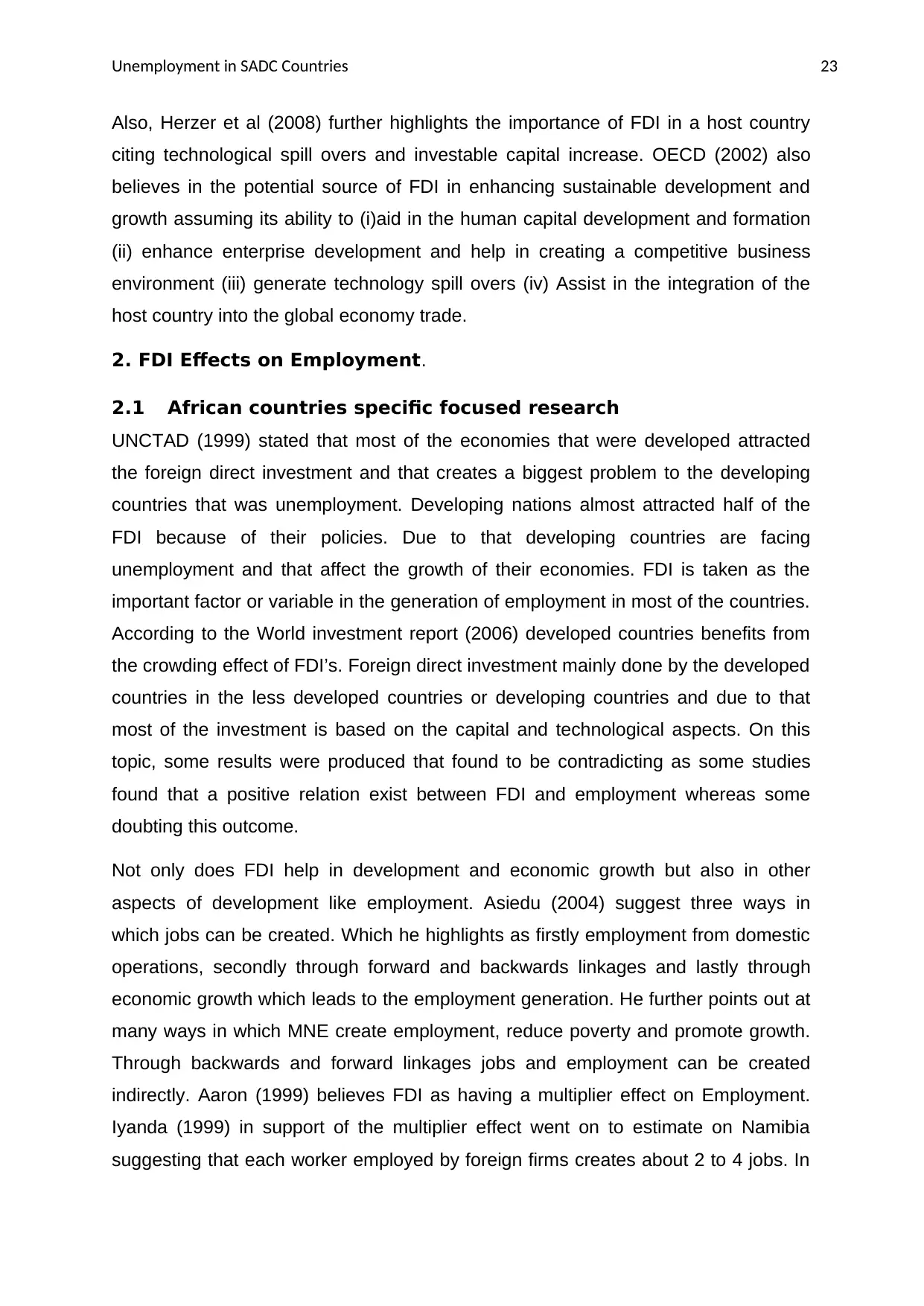
Unemployment in SADC Countries 23
Also, Herzer et al (2008) further highlights the importance of FDI in a host country
citing technological spill overs and investable capital increase. OECD (2002) also
believes in the potential source of FDI in enhancing sustainable development and
growth assuming its ability to (i)aid in the human capital development and formation
(ii) enhance enterprise development and help in creating a competitive business
environment (iii) generate technology spill overs (iv) Assist in the integration of the
host country into the global economy trade.
2. FDI Effects on Employment.
2.1 African countries specific focused research
UNCTAD (1999) stated that most of the economies that were developed attracted
the foreign direct investment and that creates a biggest problem to the developing
countries that was unemployment. Developing nations almost attracted half of the
FDI because of their policies. Due to that developing countries are facing
unemployment and that affect the growth of their economies. FDI is taken as the
important factor or variable in the generation of employment in most of the countries.
According to the World investment report (2006) developed countries benefits from
the crowding effect of FDI’s. Foreign direct investment mainly done by the developed
countries in the less developed countries or developing countries and due to that
most of the investment is based on the capital and technological aspects. On this
topic, some results were produced that found to be contradicting as some studies
found that a positive relation exist between FDI and employment whereas some
doubting this outcome.
Not only does FDI help in development and economic growth but also in other
aspects of development like employment. Asiedu (2004) suggest three ways in
which jobs can be created. Which he highlights as firstly employment from domestic
operations, secondly through forward and backwards linkages and lastly through
economic growth which leads to the employment generation. He further points out at
many ways in which MNE create employment, reduce poverty and promote growth.
Through backwards and forward linkages jobs and employment can be created
indirectly. Aaron (1999) believes FDI as having a multiplier effect on Employment.
Iyanda (1999) in support of the multiplier effect went on to estimate on Namibia
suggesting that each worker employed by foreign firms creates about 2 to 4 jobs. In
Also, Herzer et al (2008) further highlights the importance of FDI in a host country
citing technological spill overs and investable capital increase. OECD (2002) also
believes in the potential source of FDI in enhancing sustainable development and
growth assuming its ability to (i)aid in the human capital development and formation
(ii) enhance enterprise development and help in creating a competitive business
environment (iii) generate technology spill overs (iv) Assist in the integration of the
host country into the global economy trade.
2. FDI Effects on Employment.
2.1 African countries specific focused research
UNCTAD (1999) stated that most of the economies that were developed attracted
the foreign direct investment and that creates a biggest problem to the developing
countries that was unemployment. Developing nations almost attracted half of the
FDI because of their policies. Due to that developing countries are facing
unemployment and that affect the growth of their economies. FDI is taken as the
important factor or variable in the generation of employment in most of the countries.
According to the World investment report (2006) developed countries benefits from
the crowding effect of FDI’s. Foreign direct investment mainly done by the developed
countries in the less developed countries or developing countries and due to that
most of the investment is based on the capital and technological aspects. On this
topic, some results were produced that found to be contradicting as some studies
found that a positive relation exist between FDI and employment whereas some
doubting this outcome.
Not only does FDI help in development and economic growth but also in other
aspects of development like employment. Asiedu (2004) suggest three ways in
which jobs can be created. Which he highlights as firstly employment from domestic
operations, secondly through forward and backwards linkages and lastly through
economic growth which leads to the employment generation. He further points out at
many ways in which MNE create employment, reduce poverty and promote growth.
Through backwards and forward linkages jobs and employment can be created
indirectly. Aaron (1999) believes FDI as having a multiplier effect on Employment.
Iyanda (1999) in support of the multiplier effect went on to estimate on Namibia
suggesting that each worker employed by foreign firms creates about 2 to 4 jobs. In
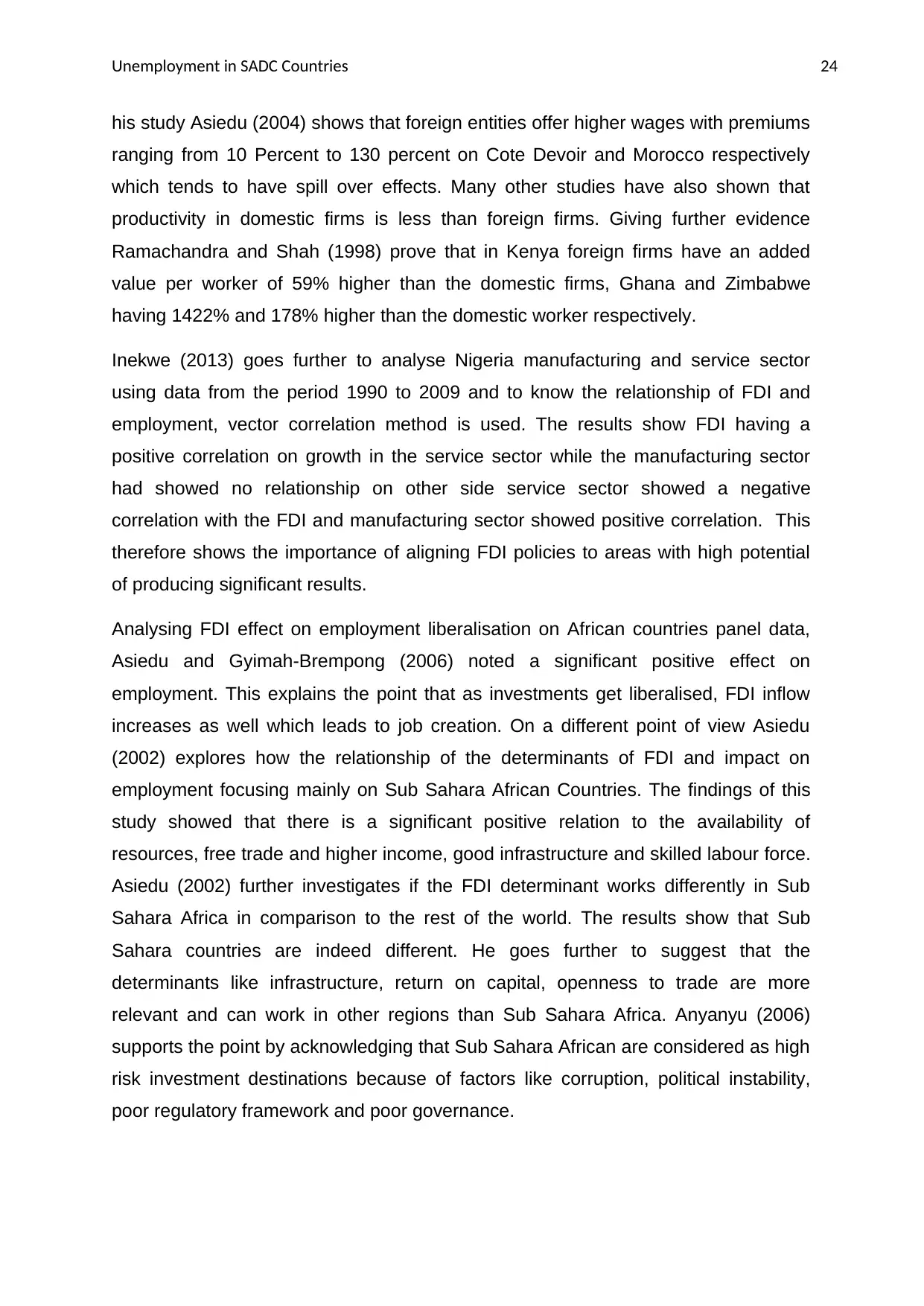
Unemployment in SADC Countries 24
his study Asiedu (2004) shows that foreign entities offer higher wages with premiums
ranging from 10 Percent to 130 percent on Cote Devoir and Morocco respectively
which tends to have spill over effects. Many other studies have also shown that
productivity in domestic firms is less than foreign firms. Giving further evidence
Ramachandra and Shah (1998) prove that in Kenya foreign firms have an added
value per worker of 59% higher than the domestic firms, Ghana and Zimbabwe
having 1422% and 178% higher than the domestic worker respectively.
Inekwe (2013) goes further to analyse Nigeria manufacturing and service sector
using data from the period 1990 to 2009 and to know the relationship of FDI and
employment, vector correlation method is used. The results show FDI having a
positive correlation on growth in the service sector while the manufacturing sector
had showed no relationship on other side service sector showed a negative
correlation with the FDI and manufacturing sector showed positive correlation. This
therefore shows the importance of aligning FDI policies to areas with high potential
of producing significant results.
Analysing FDI effect on employment liberalisation on African countries panel data,
Asiedu and Gyimah-Brempong (2006) noted a significant positive effect on
employment. This explains the point that as investments get liberalised, FDI inflow
increases as well which leads to job creation. On a different point of view Asiedu
(2002) explores how the relationship of the determinants of FDI and impact on
employment focusing mainly on Sub Sahara African Countries. The findings of this
study showed that there is a significant positive relation to the availability of
resources, free trade and higher income, good infrastructure and skilled labour force.
Asiedu (2002) further investigates if the FDI determinant works differently in Sub
Sahara Africa in comparison to the rest of the world. The results show that Sub
Sahara countries are indeed different. He goes further to suggest that the
determinants like infrastructure, return on capital, openness to trade are more
relevant and can work in other regions than Sub Sahara Africa. Anyanyu (2006)
supports the point by acknowledging that Sub Sahara African are considered as high
risk investment destinations because of factors like corruption, political instability,
poor regulatory framework and poor governance.
his study Asiedu (2004) shows that foreign entities offer higher wages with premiums
ranging from 10 Percent to 130 percent on Cote Devoir and Morocco respectively
which tends to have spill over effects. Many other studies have also shown that
productivity in domestic firms is less than foreign firms. Giving further evidence
Ramachandra and Shah (1998) prove that in Kenya foreign firms have an added
value per worker of 59% higher than the domestic firms, Ghana and Zimbabwe
having 1422% and 178% higher than the domestic worker respectively.
Inekwe (2013) goes further to analyse Nigeria manufacturing and service sector
using data from the period 1990 to 2009 and to know the relationship of FDI and
employment, vector correlation method is used. The results show FDI having a
positive correlation on growth in the service sector while the manufacturing sector
had showed no relationship on other side service sector showed a negative
correlation with the FDI and manufacturing sector showed positive correlation. This
therefore shows the importance of aligning FDI policies to areas with high potential
of producing significant results.
Analysing FDI effect on employment liberalisation on African countries panel data,
Asiedu and Gyimah-Brempong (2006) noted a significant positive effect on
employment. This explains the point that as investments get liberalised, FDI inflow
increases as well which leads to job creation. On a different point of view Asiedu
(2002) explores how the relationship of the determinants of FDI and impact on
employment focusing mainly on Sub Sahara African Countries. The findings of this
study showed that there is a significant positive relation to the availability of
resources, free trade and higher income, good infrastructure and skilled labour force.
Asiedu (2002) further investigates if the FDI determinant works differently in Sub
Sahara Africa in comparison to the rest of the world. The results show that Sub
Sahara countries are indeed different. He goes further to suggest that the
determinants like infrastructure, return on capital, openness to trade are more
relevant and can work in other regions than Sub Sahara Africa. Anyanyu (2006)
supports the point by acknowledging that Sub Sahara African are considered as high
risk investment destinations because of factors like corruption, political instability,
poor regulatory framework and poor governance.
Paraphrase This Document
Need a fresh take? Get an instant paraphrase of this document with our AI Paraphraser
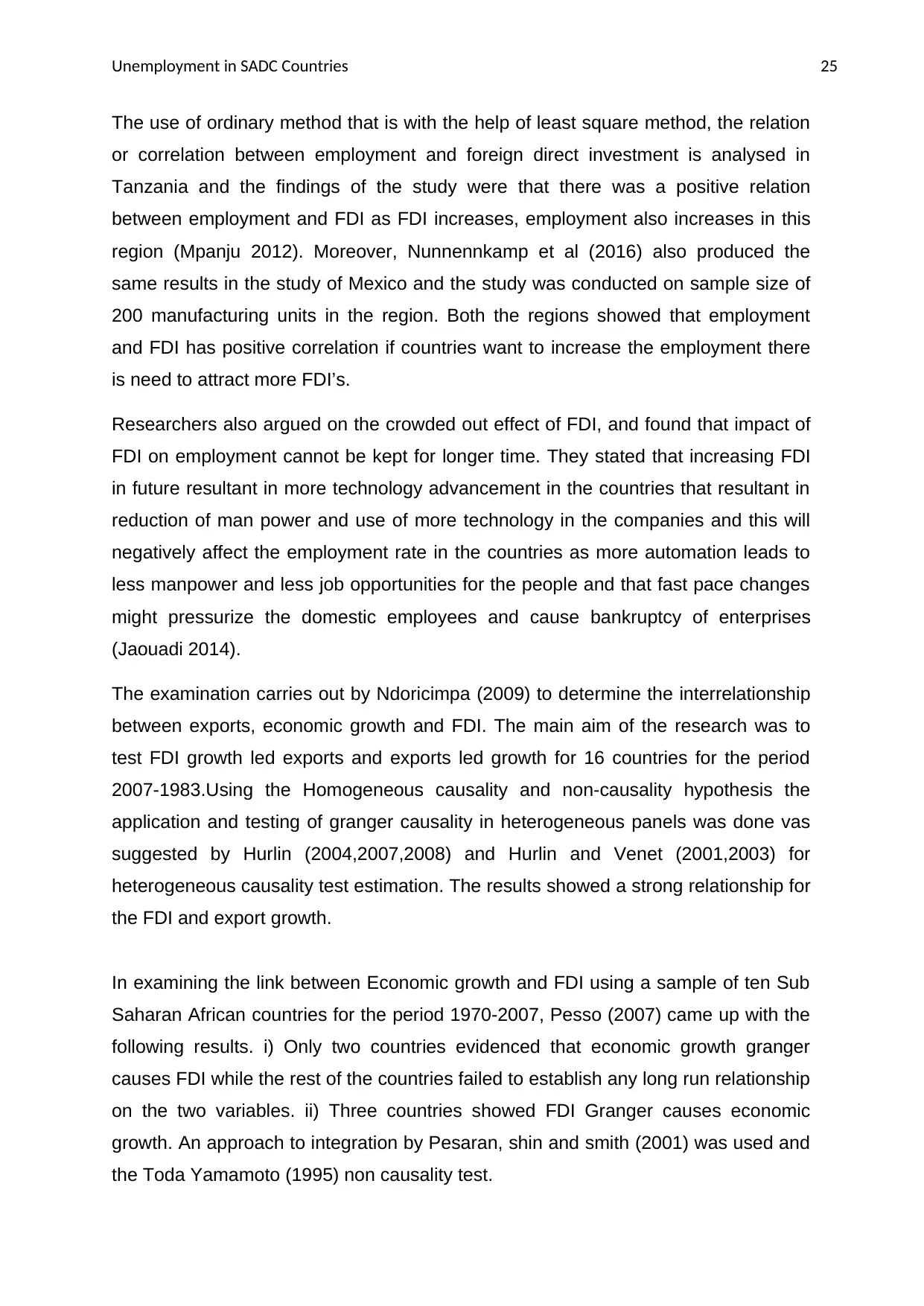
Unemployment in SADC Countries 25
The use of ordinary method that is with the help of least square method, the relation
or correlation between employment and foreign direct investment is analysed in
Tanzania and the findings of the study were that there was a positive relation
between employment and FDI as FDI increases, employment also increases in this
region (Mpanju 2012). Moreover, Nunnennkamp et al (2016) also produced the
same results in the study of Mexico and the study was conducted on sample size of
200 manufacturing units in the region. Both the regions showed that employment
and FDI has positive correlation if countries want to increase the employment there
is need to attract more FDI’s.
Researchers also argued on the crowded out effect of FDI, and found that impact of
FDI on employment cannot be kept for longer time. They stated that increasing FDI
in future resultant in more technology advancement in the countries that resultant in
reduction of man power and use of more technology in the companies and this will
negatively affect the employment rate in the countries as more automation leads to
less manpower and less job opportunities for the people and that fast pace changes
might pressurize the domestic employees and cause bankruptcy of enterprises
(Jaouadi 2014).
The examination carries out by Ndoricimpa (2009) to determine the interrelationship
between exports, economic growth and FDI. The main aim of the research was to
test FDI growth led exports and exports led growth for 16 countries for the period
2007-1983.Using the Homogeneous causality and non-causality hypothesis the
application and testing of granger causality in heterogeneous panels was done vas
suggested by Hurlin (2004,2007,2008) and Hurlin and Venet (2001,2003) for
heterogeneous causality test estimation. The results showed a strong relationship for
the FDI and export growth.
In examining the link between Economic growth and FDI using a sample of ten Sub
Saharan African countries for the period 1970-2007, Pesso (2007) came up with the
following results. i) Only two countries evidenced that economic growth granger
causes FDI while the rest of the countries failed to establish any long run relationship
on the two variables. ii) Three countries showed FDI Granger causes economic
growth. An approach to integration by Pesaran, shin and smith (2001) was used and
the Toda Yamamoto (1995) non causality test.
The use of ordinary method that is with the help of least square method, the relation
or correlation between employment and foreign direct investment is analysed in
Tanzania and the findings of the study were that there was a positive relation
between employment and FDI as FDI increases, employment also increases in this
region (Mpanju 2012). Moreover, Nunnennkamp et al (2016) also produced the
same results in the study of Mexico and the study was conducted on sample size of
200 manufacturing units in the region. Both the regions showed that employment
and FDI has positive correlation if countries want to increase the employment there
is need to attract more FDI’s.
Researchers also argued on the crowded out effect of FDI, and found that impact of
FDI on employment cannot be kept for longer time. They stated that increasing FDI
in future resultant in more technology advancement in the countries that resultant in
reduction of man power and use of more technology in the companies and this will
negatively affect the employment rate in the countries as more automation leads to
less manpower and less job opportunities for the people and that fast pace changes
might pressurize the domestic employees and cause bankruptcy of enterprises
(Jaouadi 2014).
The examination carries out by Ndoricimpa (2009) to determine the interrelationship
between exports, economic growth and FDI. The main aim of the research was to
test FDI growth led exports and exports led growth for 16 countries for the period
2007-1983.Using the Homogeneous causality and non-causality hypothesis the
application and testing of granger causality in heterogeneous panels was done vas
suggested by Hurlin (2004,2007,2008) and Hurlin and Venet (2001,2003) for
heterogeneous causality test estimation. The results showed a strong relationship for
the FDI and export growth.
In examining the link between Economic growth and FDI using a sample of ten Sub
Saharan African countries for the period 1970-2007, Pesso (2007) came up with the
following results. i) Only two countries evidenced that economic growth granger
causes FDI while the rest of the countries failed to establish any long run relationship
on the two variables. ii) Three countries showed FDI Granger causes economic
growth. An approach to integration by Pesaran, shin and smith (2001) was used and
the Toda Yamamoto (1995) non causality test.
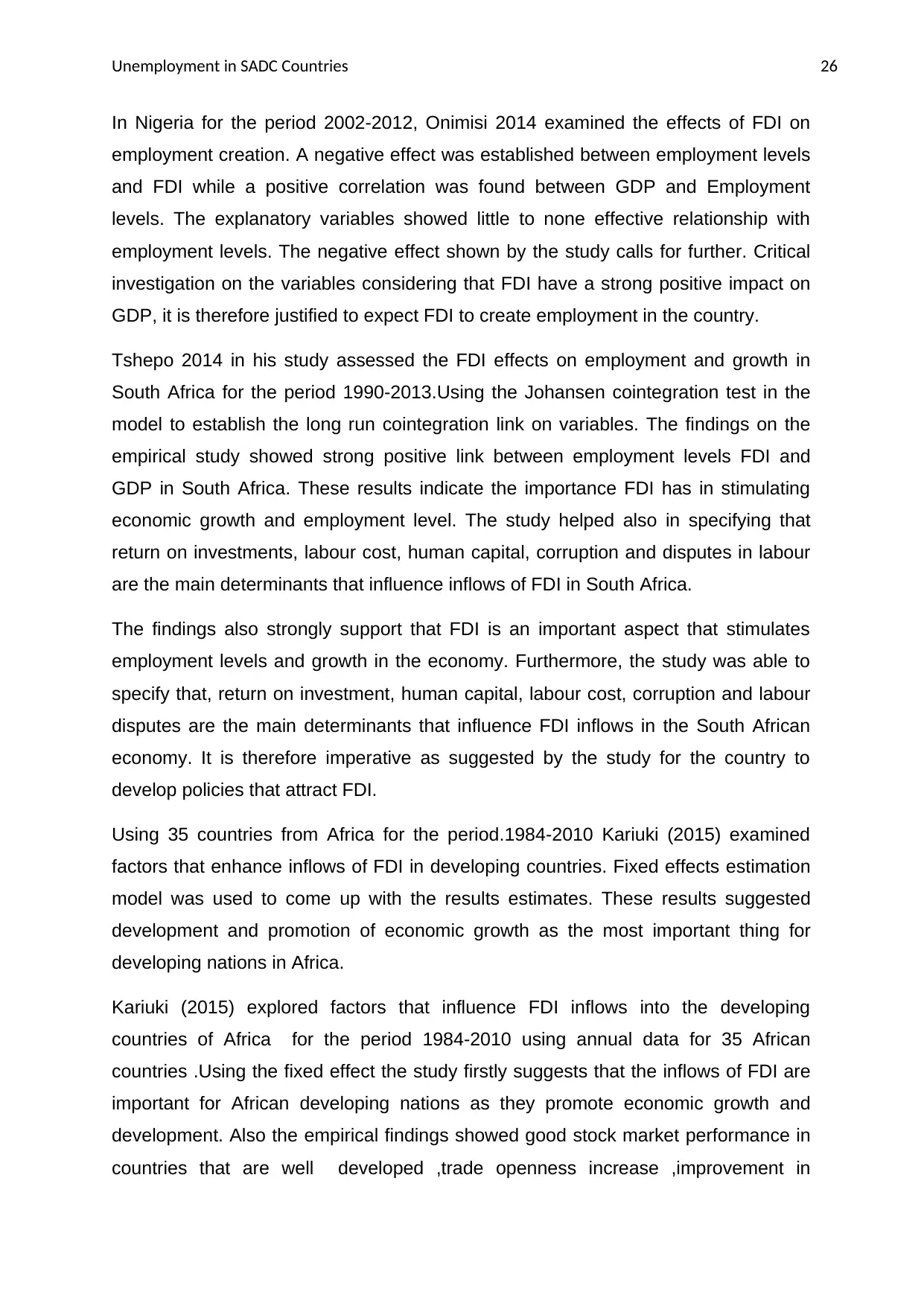
Unemployment in SADC Countries 26
In Nigeria for the period 2002-2012, Onimisi 2014 examined the effects of FDI on
employment creation. A negative effect was established between employment levels
and FDI while a positive correlation was found between GDP and Employment
levels. The explanatory variables showed little to none effective relationship with
employment levels. The negative effect shown by the study calls for further. Critical
investigation on the variables considering that FDI have a strong positive impact on
GDP, it is therefore justified to expect FDI to create employment in the country.
Tshepo 2014 in his study assessed the FDI effects on employment and growth in
South Africa for the period 1990-2013.Using the Johansen cointegration test in the
model to establish the long run cointegration link on variables. The findings on the
empirical study showed strong positive link between employment levels FDI and
GDP in South Africa. These results indicate the importance FDI has in stimulating
economic growth and employment level. The study helped also in specifying that
return on investments, labour cost, human capital, corruption and disputes in labour
are the main determinants that influence inflows of FDI in South Africa.
The findings also strongly support that FDI is an important aspect that stimulates
employment levels and growth in the economy. Furthermore, the study was able to
specify that, return on investment, human capital, labour cost, corruption and labour
disputes are the main determinants that influence FDI inflows in the South African
economy. It is therefore imperative as suggested by the study for the country to
develop policies that attract FDI.
Using 35 countries from Africa for the period.1984-2010 Kariuki (2015) examined
factors that enhance inflows of FDI in developing countries. Fixed effects estimation
model was used to come up with the results estimates. These results suggested
development and promotion of economic growth as the most important thing for
developing nations in Africa.
Kariuki (2015) explored factors that influence FDI inflows into the developing
countries of Africa for the period 1984-2010 using annual data for 35 African
countries .Using the fixed effect the study firstly suggests that the inflows of FDI are
important for African developing nations as they promote economic growth and
development. Also the empirical findings showed good stock market performance in
countries that are well developed ,trade openness increase ,improvement in
In Nigeria for the period 2002-2012, Onimisi 2014 examined the effects of FDI on
employment creation. A negative effect was established between employment levels
and FDI while a positive correlation was found between GDP and Employment
levels. The explanatory variables showed little to none effective relationship with
employment levels. The negative effect shown by the study calls for further. Critical
investigation on the variables considering that FDI have a strong positive impact on
GDP, it is therefore justified to expect FDI to create employment in the country.
Tshepo 2014 in his study assessed the FDI effects on employment and growth in
South Africa for the period 1990-2013.Using the Johansen cointegration test in the
model to establish the long run cointegration link on variables. The findings on the
empirical study showed strong positive link between employment levels FDI and
GDP in South Africa. These results indicate the importance FDI has in stimulating
economic growth and employment level. The study helped also in specifying that
return on investments, labour cost, human capital, corruption and disputes in labour
are the main determinants that influence inflows of FDI in South Africa.
The findings also strongly support that FDI is an important aspect that stimulates
employment levels and growth in the economy. Furthermore, the study was able to
specify that, return on investment, human capital, labour cost, corruption and labour
disputes are the main determinants that influence FDI inflows in the South African
economy. It is therefore imperative as suggested by the study for the country to
develop policies that attract FDI.
Using 35 countries from Africa for the period.1984-2010 Kariuki (2015) examined
factors that enhance inflows of FDI in developing countries. Fixed effects estimation
model was used to come up with the results estimates. These results suggested
development and promotion of economic growth as the most important thing for
developing nations in Africa.
Kariuki (2015) explored factors that influence FDI inflows into the developing
countries of Africa for the period 1984-2010 using annual data for 35 African
countries .Using the fixed effect the study firstly suggests that the inflows of FDI are
important for African developing nations as they promote economic growth and
development. Also the empirical findings showed good stock market performance in
countries that are well developed ,trade openness increase ,improvement in
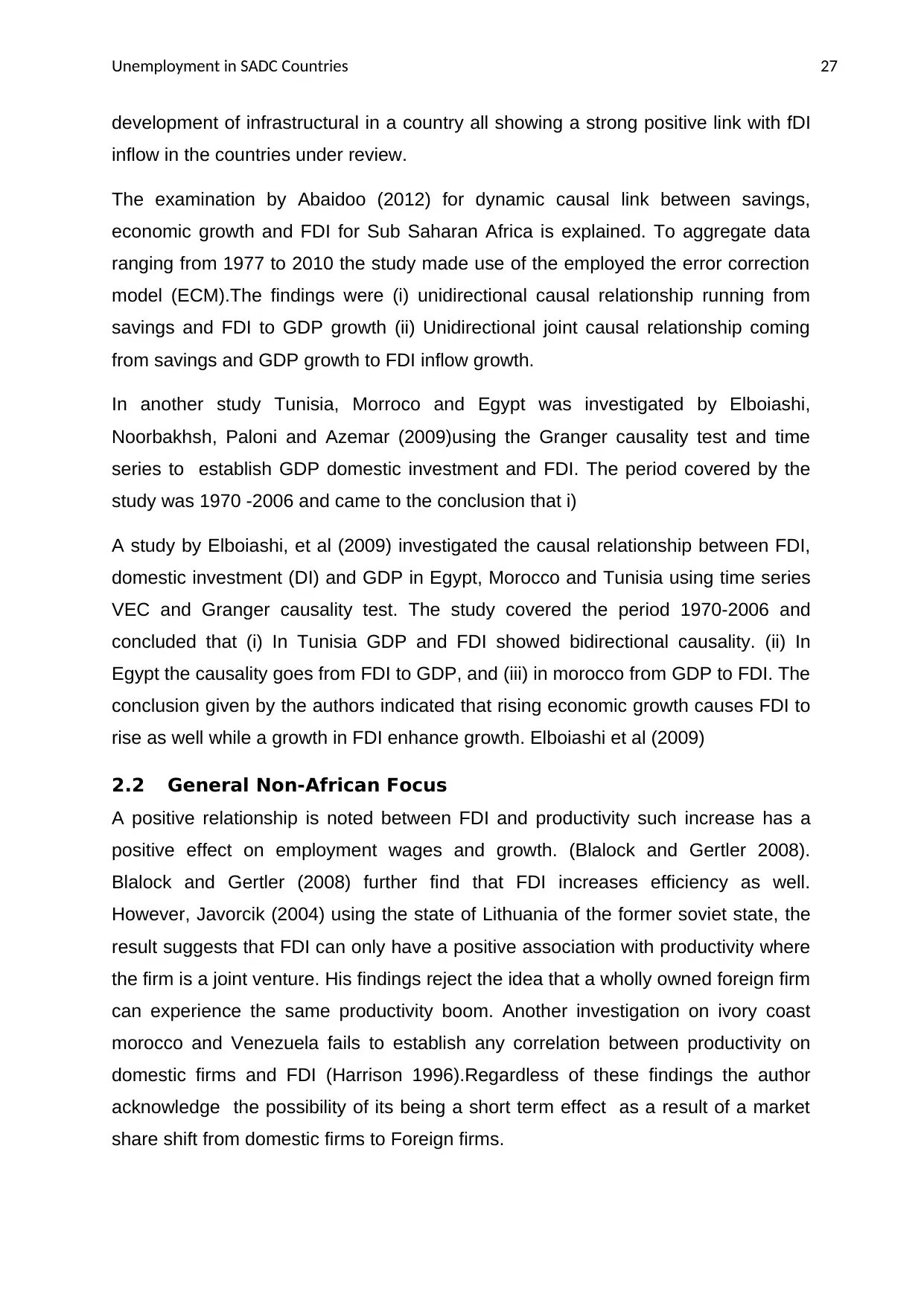
Unemployment in SADC Countries 27
development of infrastructural in a country all showing a strong positive link with fDI
inflow in the countries under review.
The examination by Abaidoo (2012) for dynamic causal link between savings,
economic growth and FDI for Sub Saharan Africa is explained. To aggregate data
ranging from 1977 to 2010 the study made use of the employed the error correction
model (ECM).The findings were (i) unidirectional causal relationship running from
savings and FDI to GDP growth (ii) Unidirectional joint causal relationship coming
from savings and GDP growth to FDI inflow growth.
In another study Tunisia, Morroco and Egypt was investigated by Elboiashi,
Noorbakhsh, Paloni and Azemar (2009)using the Granger causality test and time
series to establish GDP domestic investment and FDI. The period covered by the
study was 1970 -2006 and came to the conclusion that i)
A study by Elboiashi, et al (2009) investigated the causal relationship between FDI,
domestic investment (DI) and GDP in Egypt, Morocco and Tunisia using time series
VEC and Granger causality test. The study covered the period 1970-2006 and
concluded that (i) In Tunisia GDP and FDI showed bidirectional causality. (ii) In
Egypt the causality goes from FDI to GDP, and (iii) in morocco from GDP to FDI. The
conclusion given by the authors indicated that rising economic growth causes FDI to
rise as well while a growth in FDI enhance growth. Elboiashi et al (2009)
2.2 General Non-African Focus
A positive relationship is noted between FDI and productivity such increase has a
positive effect on employment wages and growth. (Blalock and Gertler 2008).
Blalock and Gertler (2008) further find that FDI increases efficiency as well.
However, Javorcik (2004) using the state of Lithuania of the former soviet state, the
result suggests that FDI can only have a positive association with productivity where
the firm is a joint venture. His findings reject the idea that a wholly owned foreign firm
can experience the same productivity boom. Another investigation on ivory coast
morocco and Venezuela fails to establish any correlation between productivity on
domestic firms and FDI (Harrison 1996).Regardless of these findings the author
acknowledge the possibility of its being a short term effect as a result of a market
share shift from domestic firms to Foreign firms.
development of infrastructural in a country all showing a strong positive link with fDI
inflow in the countries under review.
The examination by Abaidoo (2012) for dynamic causal link between savings,
economic growth and FDI for Sub Saharan Africa is explained. To aggregate data
ranging from 1977 to 2010 the study made use of the employed the error correction
model (ECM).The findings were (i) unidirectional causal relationship running from
savings and FDI to GDP growth (ii) Unidirectional joint causal relationship coming
from savings and GDP growth to FDI inflow growth.
In another study Tunisia, Morroco and Egypt was investigated by Elboiashi,
Noorbakhsh, Paloni and Azemar (2009)using the Granger causality test and time
series to establish GDP domestic investment and FDI. The period covered by the
study was 1970 -2006 and came to the conclusion that i)
A study by Elboiashi, et al (2009) investigated the causal relationship between FDI,
domestic investment (DI) and GDP in Egypt, Morocco and Tunisia using time series
VEC and Granger causality test. The study covered the period 1970-2006 and
concluded that (i) In Tunisia GDP and FDI showed bidirectional causality. (ii) In
Egypt the causality goes from FDI to GDP, and (iii) in morocco from GDP to FDI. The
conclusion given by the authors indicated that rising economic growth causes FDI to
rise as well while a growth in FDI enhance growth. Elboiashi et al (2009)
2.2 General Non-African Focus
A positive relationship is noted between FDI and productivity such increase has a
positive effect on employment wages and growth. (Blalock and Gertler 2008).
Blalock and Gertler (2008) further find that FDI increases efficiency as well.
However, Javorcik (2004) using the state of Lithuania of the former soviet state, the
result suggests that FDI can only have a positive association with productivity where
the firm is a joint venture. His findings reject the idea that a wholly owned foreign firm
can experience the same productivity boom. Another investigation on ivory coast
morocco and Venezuela fails to establish any correlation between productivity on
domestic firms and FDI (Harrison 1996).Regardless of these findings the author
acknowledge the possibility of its being a short term effect as a result of a market
share shift from domestic firms to Foreign firms.
Secure Best Marks with AI Grader
Need help grading? Try our AI Grader for instant feedback on your assignments.
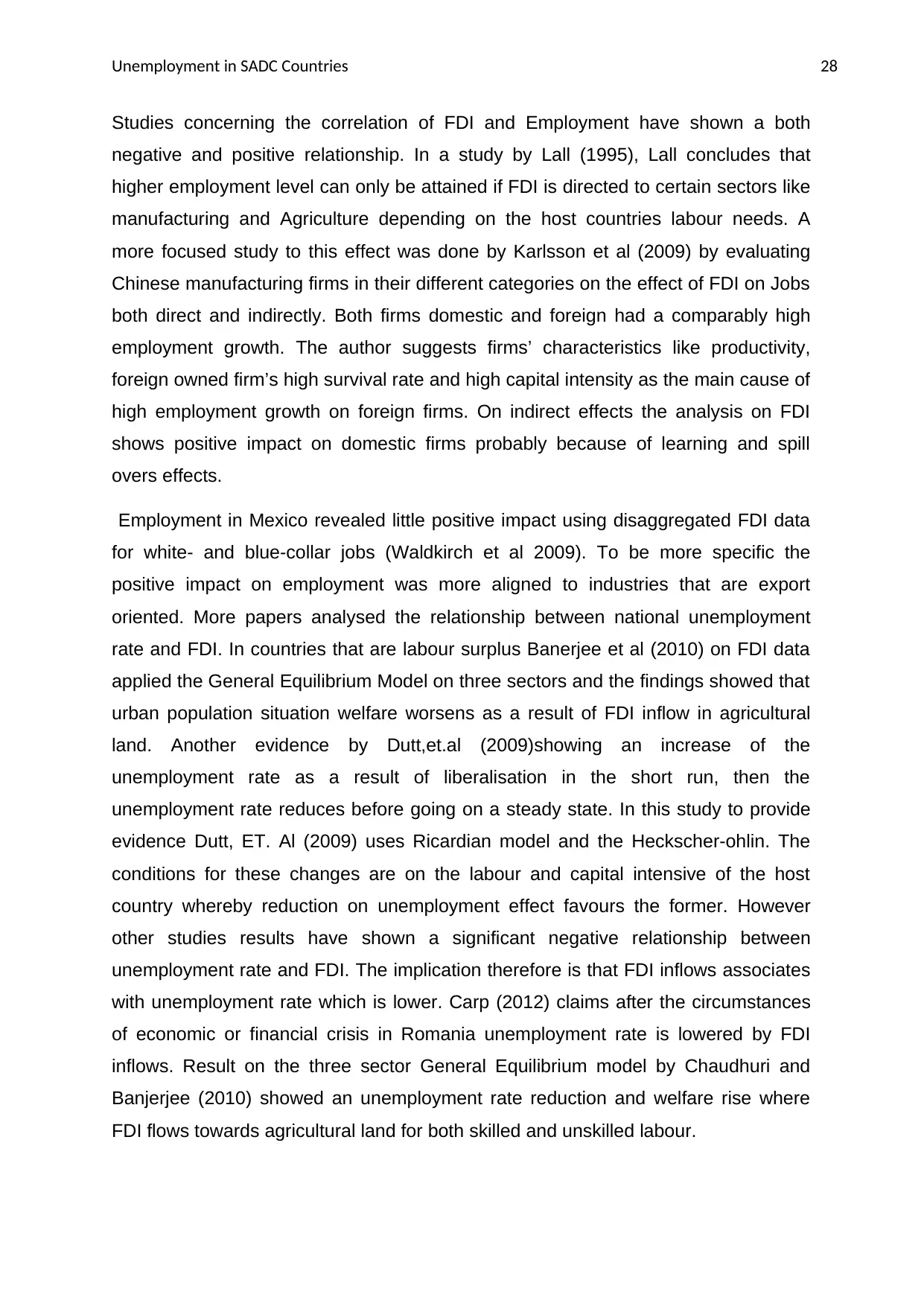
Unemployment in SADC Countries 28
Studies concerning the correlation of FDI and Employment have shown a both
negative and positive relationship. In a study by Lall (1995), Lall concludes that
higher employment level can only be attained if FDI is directed to certain sectors like
manufacturing and Agriculture depending on the host countries labour needs. A
more focused study to this effect was done by Karlsson et al (2009) by evaluating
Chinese manufacturing firms in their different categories on the effect of FDI on Jobs
both direct and indirectly. Both firms domestic and foreign had a comparably high
employment growth. The author suggests firms’ characteristics like productivity,
foreign owned firm’s high survival rate and high capital intensity as the main cause of
high employment growth on foreign firms. On indirect effects the analysis on FDI
shows positive impact on domestic firms probably because of learning and spill
overs effects.
Employment in Mexico revealed little positive impact using disaggregated FDI data
for white- and blue-collar jobs (Waldkirch et al 2009). To be more specific the
positive impact on employment was more aligned to industries that are export
oriented. More papers analysed the relationship between national unemployment
rate and FDI. In countries that are labour surplus Banerjee et al (2010) on FDI data
applied the General Equilibrium Model on three sectors and the findings showed that
urban population situation welfare worsens as a result of FDI inflow in agricultural
land. Another evidence by Dutt,et.al (2009)showing an increase of the
unemployment rate as a result of liberalisation in the short run, then the
unemployment rate reduces before going on a steady state. In this study to provide
evidence Dutt, ET. Al (2009) uses Ricardian model and the Heckscher-ohlin. The
conditions for these changes are on the labour and capital intensive of the host
country whereby reduction on unemployment effect favours the former. However
other studies results have shown a significant negative relationship between
unemployment rate and FDI. The implication therefore is that FDI inflows associates
with unemployment rate which is lower. Carp (2012) claims after the circumstances
of economic or financial crisis in Romania unemployment rate is lowered by FDI
inflows. Result on the three sector General Equilibrium model by Chaudhuri and
Banjerjee (2010) showed an unemployment rate reduction and welfare rise where
FDI flows towards agricultural land for both skilled and unskilled labour.
Studies concerning the correlation of FDI and Employment have shown a both
negative and positive relationship. In a study by Lall (1995), Lall concludes that
higher employment level can only be attained if FDI is directed to certain sectors like
manufacturing and Agriculture depending on the host countries labour needs. A
more focused study to this effect was done by Karlsson et al (2009) by evaluating
Chinese manufacturing firms in their different categories on the effect of FDI on Jobs
both direct and indirectly. Both firms domestic and foreign had a comparably high
employment growth. The author suggests firms’ characteristics like productivity,
foreign owned firm’s high survival rate and high capital intensity as the main cause of
high employment growth on foreign firms. On indirect effects the analysis on FDI
shows positive impact on domestic firms probably because of learning and spill
overs effects.
Employment in Mexico revealed little positive impact using disaggregated FDI data
for white- and blue-collar jobs (Waldkirch et al 2009). To be more specific the
positive impact on employment was more aligned to industries that are export
oriented. More papers analysed the relationship between national unemployment
rate and FDI. In countries that are labour surplus Banerjee et al (2010) on FDI data
applied the General Equilibrium Model on three sectors and the findings showed that
urban population situation welfare worsens as a result of FDI inflow in agricultural
land. Another evidence by Dutt,et.al (2009)showing an increase of the
unemployment rate as a result of liberalisation in the short run, then the
unemployment rate reduces before going on a steady state. In this study to provide
evidence Dutt, ET. Al (2009) uses Ricardian model and the Heckscher-ohlin. The
conditions for these changes are on the labour and capital intensive of the host
country whereby reduction on unemployment effect favours the former. However
other studies results have shown a significant negative relationship between
unemployment rate and FDI. The implication therefore is that FDI inflows associates
with unemployment rate which is lower. Carp (2012) claims after the circumstances
of economic or financial crisis in Romania unemployment rate is lowered by FDI
inflows. Result on the three sector General Equilibrium model by Chaudhuri and
Banjerjee (2010) showed an unemployment rate reduction and welfare rise where
FDI flows towards agricultural land for both skilled and unskilled labour.
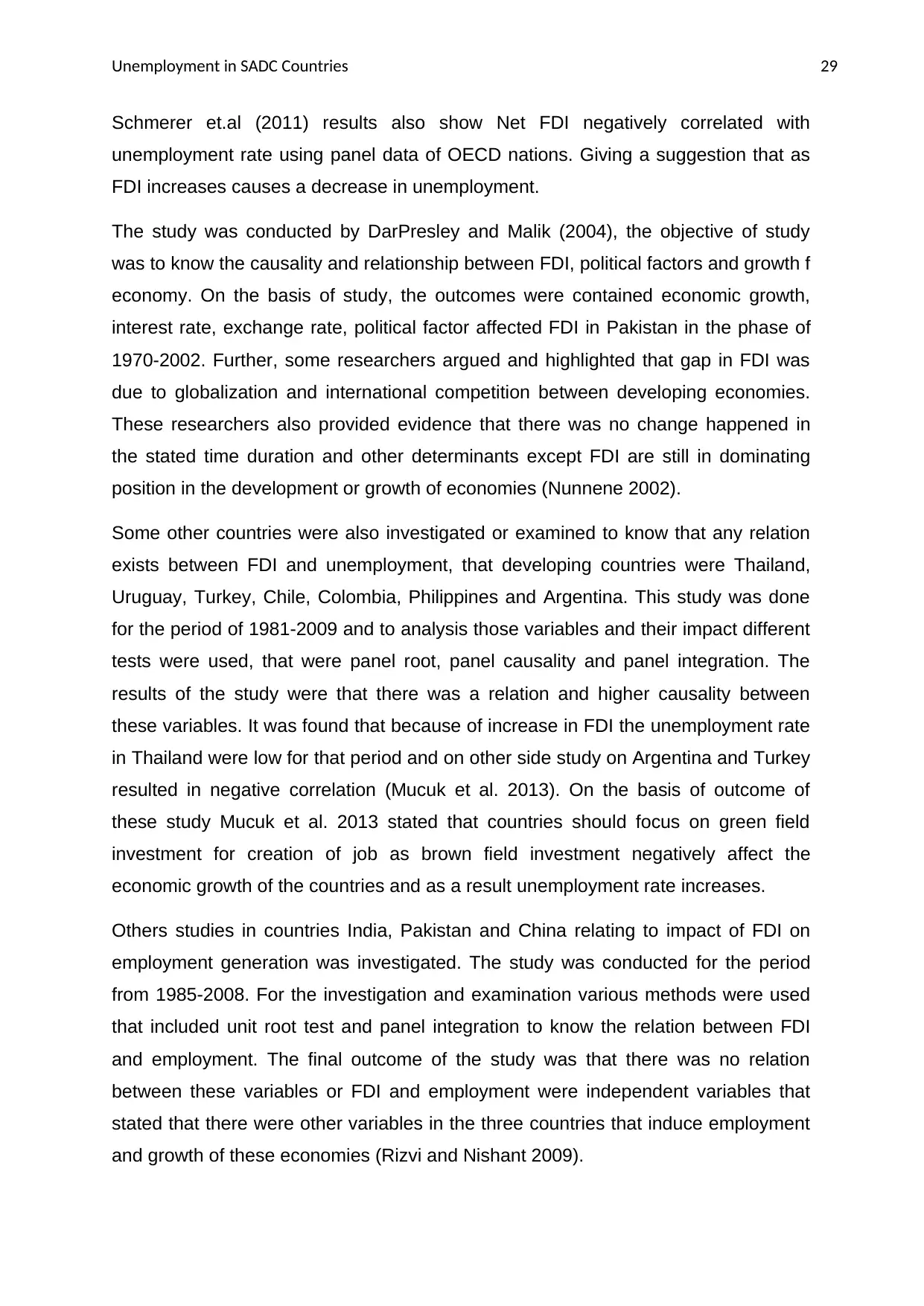
Unemployment in SADC Countries 29
Schmerer et.al (2011) results also show Net FDI negatively correlated with
unemployment rate using panel data of OECD nations. Giving a suggestion that as
FDI increases causes a decrease in unemployment.
The study was conducted by DarPresley and Malik (2004), the objective of study
was to know the causality and relationship between FDI, political factors and growth f
economy. On the basis of study, the outcomes were contained economic growth,
interest rate, exchange rate, political factor affected FDI in Pakistan in the phase of
1970-2002. Further, some researchers argued and highlighted that gap in FDI was
due to globalization and international competition between developing economies.
These researchers also provided evidence that there was no change happened in
the stated time duration and other determinants except FDI are still in dominating
position in the development or growth of economies (Nunnene 2002).
Some other countries were also investigated or examined to know that any relation
exists between FDI and unemployment, that developing countries were Thailand,
Uruguay, Turkey, Chile, Colombia, Philippines and Argentina. This study was done
for the period of 1981-2009 and to analysis those variables and their impact different
tests were used, that were panel root, panel causality and panel integration. The
results of the study were that there was a relation and higher causality between
these variables. It was found that because of increase in FDI the unemployment rate
in Thailand were low for that period and on other side study on Argentina and Turkey
resulted in negative correlation (Mucuk et al. 2013). On the basis of outcome of
these study Mucuk et al. 2013 stated that countries should focus on green field
investment for creation of job as brown field investment negatively affect the
economic growth of the countries and as a result unemployment rate increases.
Others studies in countries India, Pakistan and China relating to impact of FDI on
employment generation was investigated. The study was conducted for the period
from 1985-2008. For the investigation and examination various methods were used
that included unit root test and panel integration to know the relation between FDI
and employment. The final outcome of the study was that there was no relation
between these variables or FDI and employment were independent variables that
stated that there were other variables in the three countries that induce employment
and growth of these economies (Rizvi and Nishant 2009).
Schmerer et.al (2011) results also show Net FDI negatively correlated with
unemployment rate using panel data of OECD nations. Giving a suggestion that as
FDI increases causes a decrease in unemployment.
The study was conducted by DarPresley and Malik (2004), the objective of study
was to know the causality and relationship between FDI, political factors and growth f
economy. On the basis of study, the outcomes were contained economic growth,
interest rate, exchange rate, political factor affected FDI in Pakistan in the phase of
1970-2002. Further, some researchers argued and highlighted that gap in FDI was
due to globalization and international competition between developing economies.
These researchers also provided evidence that there was no change happened in
the stated time duration and other determinants except FDI are still in dominating
position in the development or growth of economies (Nunnene 2002).
Some other countries were also investigated or examined to know that any relation
exists between FDI and unemployment, that developing countries were Thailand,
Uruguay, Turkey, Chile, Colombia, Philippines and Argentina. This study was done
for the period of 1981-2009 and to analysis those variables and their impact different
tests were used, that were panel root, panel causality and panel integration. The
results of the study were that there was a relation and higher causality between
these variables. It was found that because of increase in FDI the unemployment rate
in Thailand were low for that period and on other side study on Argentina and Turkey
resulted in negative correlation (Mucuk et al. 2013). On the basis of outcome of
these study Mucuk et al. 2013 stated that countries should focus on green field
investment for creation of job as brown field investment negatively affect the
economic growth of the countries and as a result unemployment rate increases.
Others studies in countries India, Pakistan and China relating to impact of FDI on
employment generation was investigated. The study was conducted for the period
from 1985-2008. For the investigation and examination various methods were used
that included unit root test and panel integration to know the relation between FDI
and employment. The final outcome of the study was that there was no relation
between these variables or FDI and employment were independent variables that
stated that there were other variables in the three countries that induce employment
and growth of these economies (Rizvi and Nishant 2009).
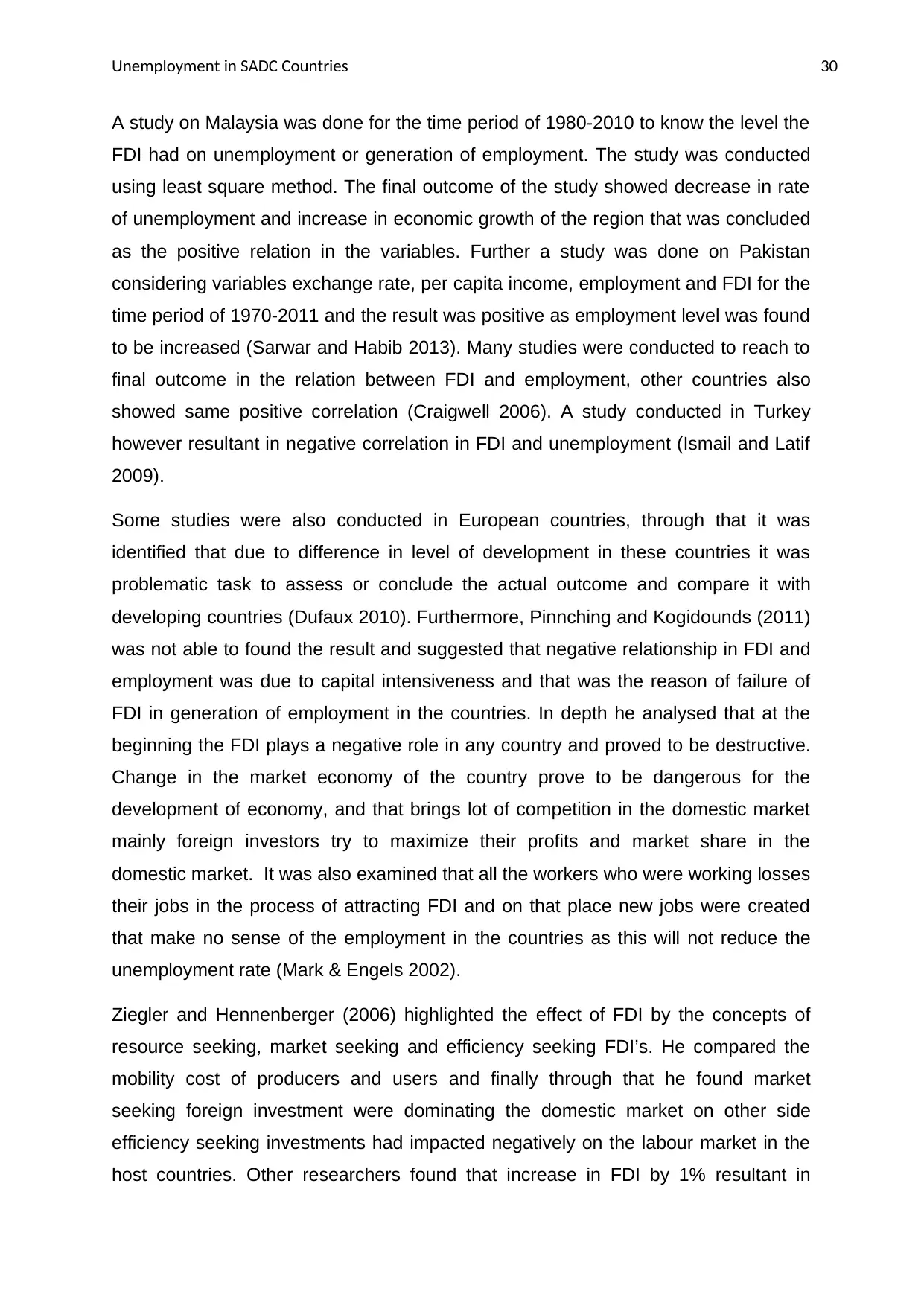
Unemployment in SADC Countries 30
A study on Malaysia was done for the time period of 1980-2010 to know the level the
FDI had on unemployment or generation of employment. The study was conducted
using least square method. The final outcome of the study showed decrease in rate
of unemployment and increase in economic growth of the region that was concluded
as the positive relation in the variables. Further a study was done on Pakistan
considering variables exchange rate, per capita income, employment and FDI for the
time period of 1970-2011 and the result was positive as employment level was found
to be increased (Sarwar and Habib 2013). Many studies were conducted to reach to
final outcome in the relation between FDI and employment, other countries also
showed same positive correlation (Craigwell 2006). A study conducted in Turkey
however resultant in negative correlation in FDI and unemployment (Ismail and Latif
2009).
Some studies were also conducted in European countries, through that it was
identified that due to difference in level of development in these countries it was
problematic task to assess or conclude the actual outcome and compare it with
developing countries (Dufaux 2010). Furthermore, Pinnching and Kogidounds (2011)
was not able to found the result and suggested that negative relationship in FDI and
employment was due to capital intensiveness and that was the reason of failure of
FDI in generation of employment in the countries. In depth he analysed that at the
beginning the FDI plays a negative role in any country and proved to be destructive.
Change in the market economy of the country prove to be dangerous for the
development of economy, and that brings lot of competition in the domestic market
mainly foreign investors try to maximize their profits and market share in the
domestic market. It was also examined that all the workers who were working losses
their jobs in the process of attracting FDI and on that place new jobs were created
that make no sense of the employment in the countries as this will not reduce the
unemployment rate (Mark & Engels 2002).
Ziegler and Hennenberger (2006) highlighted the effect of FDI by the concepts of
resource seeking, market seeking and efficiency seeking FDI’s. He compared the
mobility cost of producers and users and finally through that he found market
seeking foreign investment were dominating the domestic market on other side
efficiency seeking investments had impacted negatively on the labour market in the
host countries. Other researchers found that increase in FDI by 1% resultant in
A study on Malaysia was done for the time period of 1980-2010 to know the level the
FDI had on unemployment or generation of employment. The study was conducted
using least square method. The final outcome of the study showed decrease in rate
of unemployment and increase in economic growth of the region that was concluded
as the positive relation in the variables. Further a study was done on Pakistan
considering variables exchange rate, per capita income, employment and FDI for the
time period of 1970-2011 and the result was positive as employment level was found
to be increased (Sarwar and Habib 2013). Many studies were conducted to reach to
final outcome in the relation between FDI and employment, other countries also
showed same positive correlation (Craigwell 2006). A study conducted in Turkey
however resultant in negative correlation in FDI and unemployment (Ismail and Latif
2009).
Some studies were also conducted in European countries, through that it was
identified that due to difference in level of development in these countries it was
problematic task to assess or conclude the actual outcome and compare it with
developing countries (Dufaux 2010). Furthermore, Pinnching and Kogidounds (2011)
was not able to found the result and suggested that negative relationship in FDI and
employment was due to capital intensiveness and that was the reason of failure of
FDI in generation of employment in the countries. In depth he analysed that at the
beginning the FDI plays a negative role in any country and proved to be destructive.
Change in the market economy of the country prove to be dangerous for the
development of economy, and that brings lot of competition in the domestic market
mainly foreign investors try to maximize their profits and market share in the
domestic market. It was also examined that all the workers who were working losses
their jobs in the process of attracting FDI and on that place new jobs were created
that make no sense of the employment in the countries as this will not reduce the
unemployment rate (Mark & Engels 2002).
Ziegler and Hennenberger (2006) highlighted the effect of FDI by the concepts of
resource seeking, market seeking and efficiency seeking FDI’s. He compared the
mobility cost of producers and users and finally through that he found market
seeking foreign investment were dominating the domestic market on other side
efficiency seeking investments had impacted negatively on the labour market in the
host countries. Other researchers found that increase in FDI by 1% resultant in
Paraphrase This Document
Need a fresh take? Get an instant paraphrase of this document with our AI Paraphraser
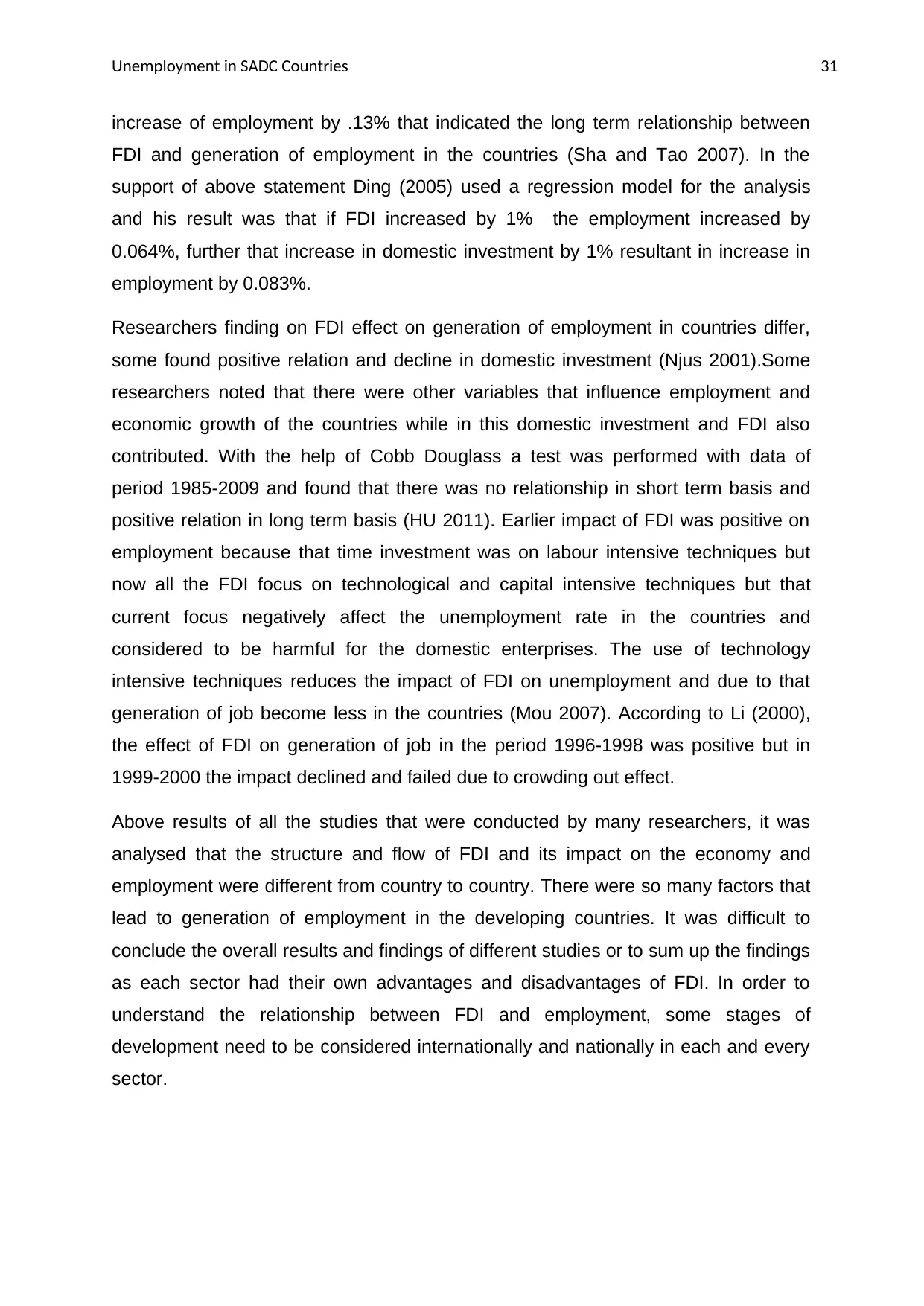
Unemployment in SADC Countries 31
increase of employment by .13% that indicated the long term relationship between
FDI and generation of employment in the countries (Sha and Tao 2007). In the
support of above statement Ding (2005) used a regression model for the analysis
and his result was that if FDI increased by 1% the employment increased by
0.064%, further that increase in domestic investment by 1% resultant in increase in
employment by 0.083%.
Researchers finding on FDI effect on generation of employment in countries differ,
some found positive relation and decline in domestic investment (Njus 2001).Some
researchers noted that there were other variables that influence employment and
economic growth of the countries while in this domestic investment and FDI also
contributed. With the help of Cobb Douglass a test was performed with data of
period 1985-2009 and found that there was no relationship in short term basis and
positive relation in long term basis (HU 2011). Earlier impact of FDI was positive on
employment because that time investment was on labour intensive techniques but
now all the FDI focus on technological and capital intensive techniques but that
current focus negatively affect the unemployment rate in the countries and
considered to be harmful for the domestic enterprises. The use of technology
intensive techniques reduces the impact of FDI on unemployment and due to that
generation of job become less in the countries (Mou 2007). According to Li (2000),
the effect of FDI on generation of job in the period 1996-1998 was positive but in
1999-2000 the impact declined and failed due to crowding out effect.
Above results of all the studies that were conducted by many researchers, it was
analysed that the structure and flow of FDI and its impact on the economy and
employment were different from country to country. There were so many factors that
lead to generation of employment in the developing countries. It was difficult to
conclude the overall results and findings of different studies or to sum up the findings
as each sector had their own advantages and disadvantages of FDI. In order to
understand the relationship between FDI and employment, some stages of
development need to be considered internationally and nationally in each and every
sector.
increase of employment by .13% that indicated the long term relationship between
FDI and generation of employment in the countries (Sha and Tao 2007). In the
support of above statement Ding (2005) used a regression model for the analysis
and his result was that if FDI increased by 1% the employment increased by
0.064%, further that increase in domestic investment by 1% resultant in increase in
employment by 0.083%.
Researchers finding on FDI effect on generation of employment in countries differ,
some found positive relation and decline in domestic investment (Njus 2001).Some
researchers noted that there were other variables that influence employment and
economic growth of the countries while in this domestic investment and FDI also
contributed. With the help of Cobb Douglass a test was performed with data of
period 1985-2009 and found that there was no relationship in short term basis and
positive relation in long term basis (HU 2011). Earlier impact of FDI was positive on
employment because that time investment was on labour intensive techniques but
now all the FDI focus on technological and capital intensive techniques but that
current focus negatively affect the unemployment rate in the countries and
considered to be harmful for the domestic enterprises. The use of technology
intensive techniques reduces the impact of FDI on unemployment and due to that
generation of job become less in the countries (Mou 2007). According to Li (2000),
the effect of FDI on generation of job in the period 1996-1998 was positive but in
1999-2000 the impact declined and failed due to crowding out effect.
Above results of all the studies that were conducted by many researchers, it was
analysed that the structure and flow of FDI and its impact on the economy and
employment were different from country to country. There were so many factors that
lead to generation of employment in the developing countries. It was difficult to
conclude the overall results and findings of different studies or to sum up the findings
as each sector had their own advantages and disadvantages of FDI. In order to
understand the relationship between FDI and employment, some stages of
development need to be considered internationally and nationally in each and every
sector.
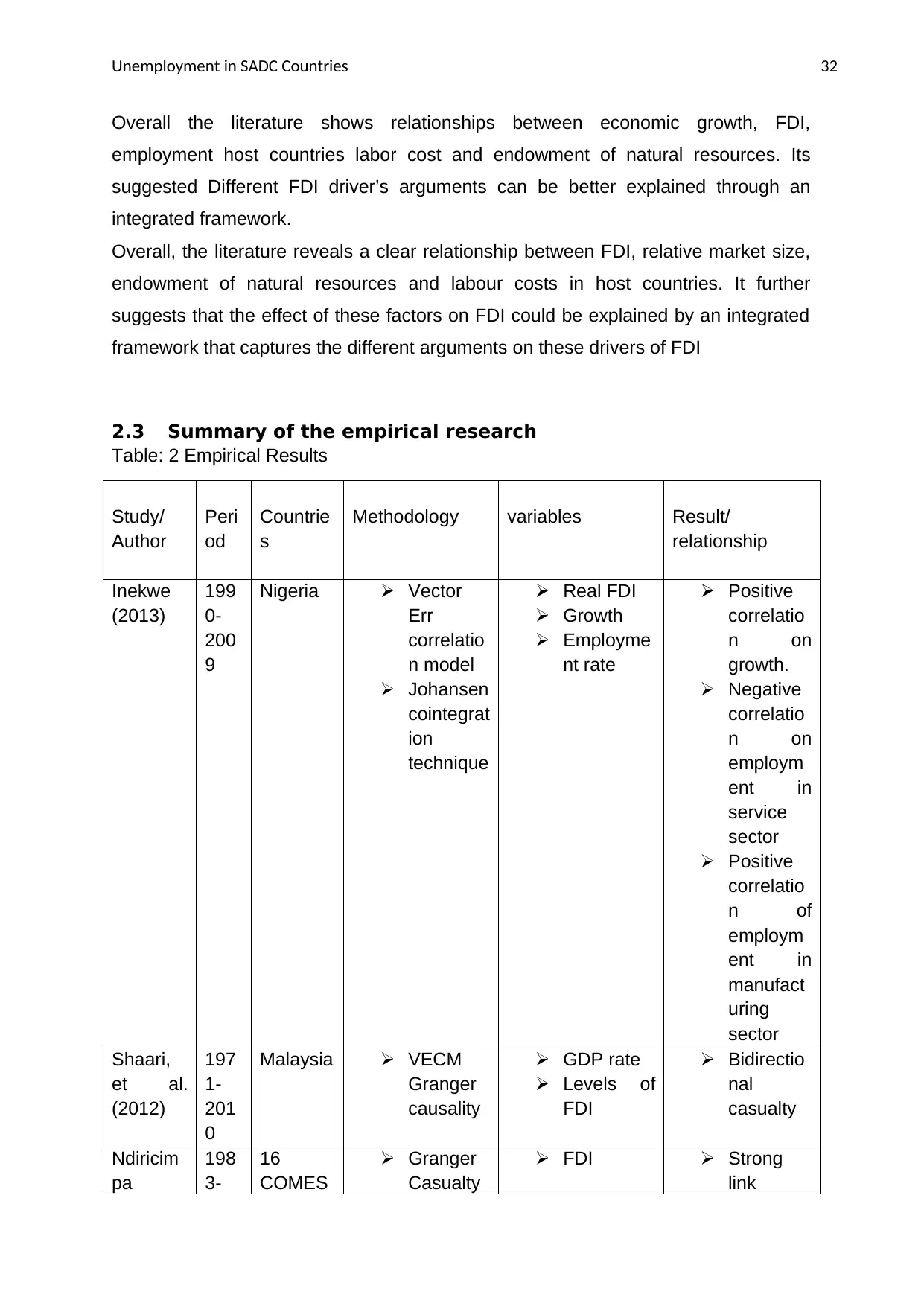
Unemployment in SADC Countries 32
Overall the literature shows relationships between economic growth, FDI,
employment host countries labor cost and endowment of natural resources. Its
suggested Different FDI driver’s arguments can be better explained through an
integrated framework.
Overall, the literature reveals a clear relationship between FDI, relative market size,
endowment of natural resources and labour costs in host countries. It further
suggests that the effect of these factors on FDI could be explained by an integrated
framework that captures the different arguments on these drivers of FDI
2.3 Summary of the empirical research
Table: 2 Empirical Results
Study/
Author
Peri
od
Countrie
s
Methodology variables Result/
relationship
Inekwe
(2013)
199
0-
200
9
Nigeria Vector
Err
correlatio
n model
Johansen
cointegrat
ion
technique
Real FDI
Growth
Employme
nt rate
Positive
correlatio
n on
growth.
Negative
correlatio
n on
employm
ent in
service
sector
Positive
correlatio
n of
employm
ent in
manufact
uring
sector
Shaari,
et al.
(2012)
197
1-
201
0
Malaysia VECM
Granger
causality
GDP rate
Levels of
FDI
Bidirectio
nal
casualty
Ndiricim
pa
198
3-
16
COMES
Granger
Casualty
FDI Strong
link
Overall the literature shows relationships between economic growth, FDI,
employment host countries labor cost and endowment of natural resources. Its
suggested Different FDI driver’s arguments can be better explained through an
integrated framework.
Overall, the literature reveals a clear relationship between FDI, relative market size,
endowment of natural resources and labour costs in host countries. It further
suggests that the effect of these factors on FDI could be explained by an integrated
framework that captures the different arguments on these drivers of FDI
2.3 Summary of the empirical research
Table: 2 Empirical Results
Study/
Author
Peri
od
Countrie
s
Methodology variables Result/
relationship
Inekwe
(2013)
199
0-
200
9
Nigeria Vector
Err
correlatio
n model
Johansen
cointegrat
ion
technique
Real FDI
Growth
Employme
nt rate
Positive
correlatio
n on
growth.
Negative
correlatio
n on
employm
ent in
service
sector
Positive
correlatio
n of
employm
ent in
manufact
uring
sector
Shaari,
et al.
(2012)
197
1-
201
0
Malaysia VECM
Granger
causality
GDP rate
Levels of
FDI
Bidirectio
nal
casualty
Ndiricim
pa
198
3-
16
COMES
Granger
Casualty
FDI Strong
link
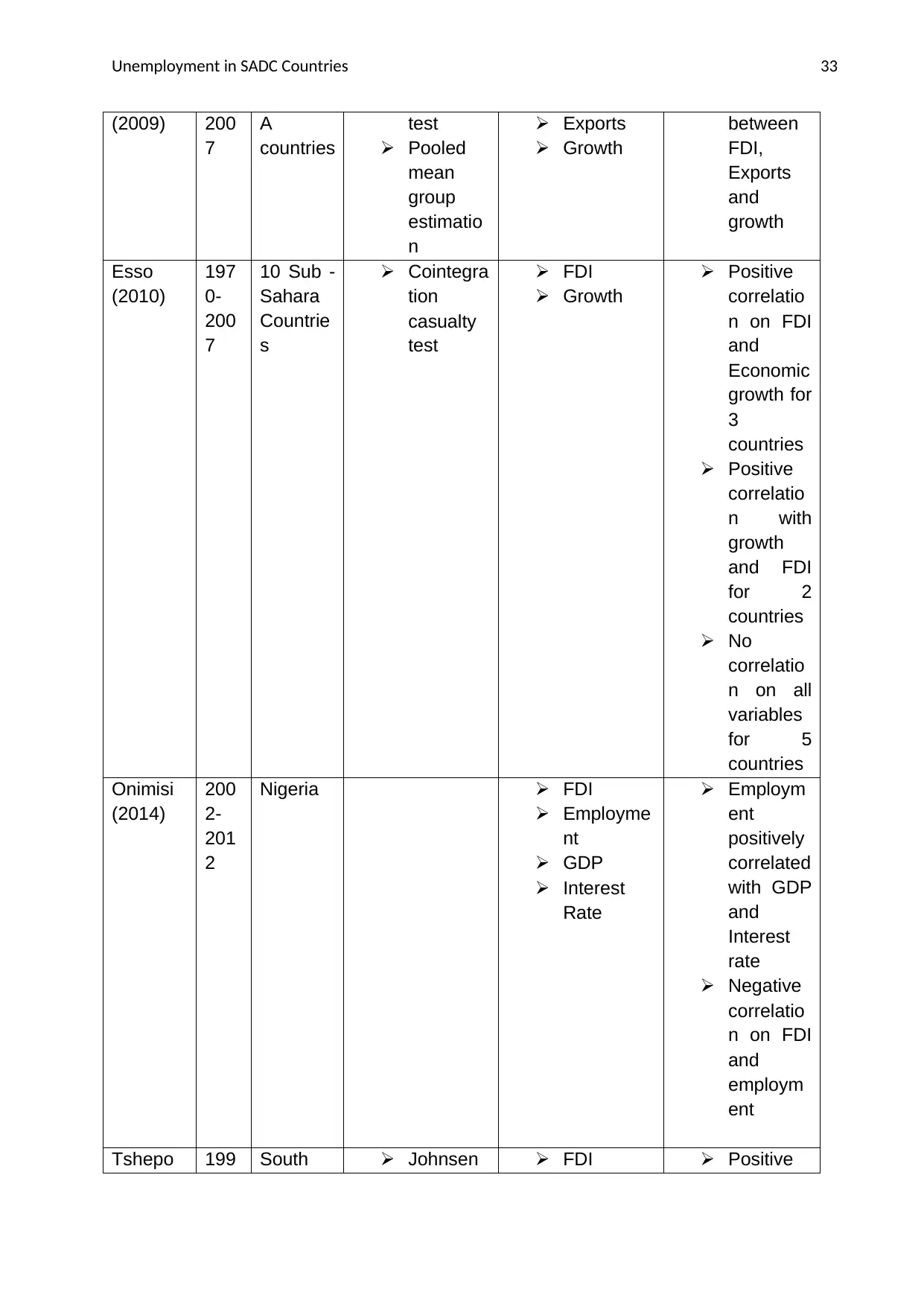
Unemployment in SADC Countries 33
(2009) 200
7
A
countries
test
Pooled
mean
group
estimatio
n
Exports
Growth
between
FDI,
Exports
and
growth
Esso
(2010)
197
0-
200
7
10 Sub -
Sahara
Countrie
s
Cointegra
tion
casualty
test
FDI
Growth
Positive
correlatio
n on FDI
and
Economic
growth for
3
countries
Positive
correlatio
n with
growth
and FDI
for 2
countries
No
correlatio
n on all
variables
for 5
countries
Onimisi
(2014)
200
2-
201
2
Nigeria FDI
Employme
nt
GDP
Interest
Rate
Employm
ent
positively
correlated
with GDP
and
Interest
rate
Negative
correlatio
n on FDI
and
employm
ent
Tshepo 199 South Johnsen FDI Positive
(2009) 200
7
A
countries
test
Pooled
mean
group
estimatio
n
Exports
Growth
between
FDI,
Exports
and
growth
Esso
(2010)
197
0-
200
7
10 Sub -
Sahara
Countrie
s
Cointegra
tion
casualty
test
FDI
Growth
Positive
correlatio
n on FDI
and
Economic
growth for
3
countries
Positive
correlatio
n with
growth
and FDI
for 2
countries
No
correlatio
n on all
variables
for 5
countries
Onimisi
(2014)
200
2-
201
2
Nigeria FDI
Employme
nt
GDP
Interest
Rate
Employm
ent
positively
correlated
with GDP
and
Interest
rate
Negative
correlatio
n on FDI
and
employm
ent
Tshepo 199 South Johnsen FDI Positive
Secure Best Marks with AI Grader
Need help grading? Try our AI Grader for instant feedback on your assignments.
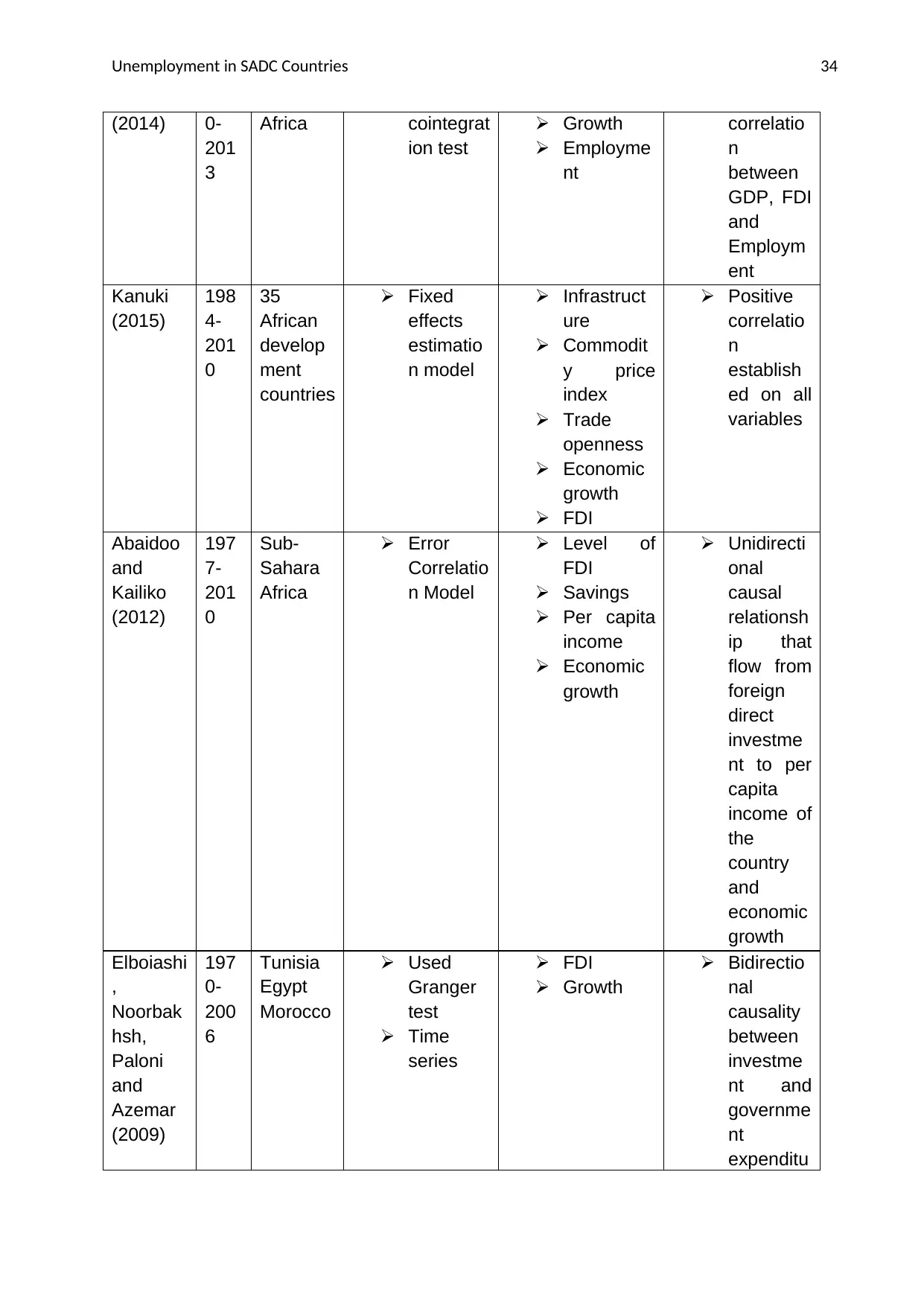
Unemployment in SADC Countries 34
(2014) 0-
201
3
Africa cointegrat
ion test
Growth
Employme
nt
correlatio
n
between
GDP, FDI
and
Employm
ent
Kanuki
(2015)
198
4-
201
0
35
African
develop
ment
countries
Fixed
effects
estimatio
n model
Infrastruct
ure
Commodit
y price
index
Trade
openness
Economic
growth
FDI
Positive
correlatio
n
establish
ed on all
variables
Abaidoo
and
Kailiko
(2012)
197
7-
201
0
Sub-
Sahara
Africa
Error
Correlatio
n Model
Level of
FDI
Savings
Per capita
income
Economic
growth
Unidirecti
onal
causal
relationsh
ip that
flow from
foreign
direct
investme
nt to per
capita
income of
the
country
and
economic
growth
Elboiashi
,
Noorbak
hsh,
Paloni
and
Azemar
(2009)
197
0-
200
6
Tunisia
Egypt
Morocco
Used
Granger
test
Time
series
FDI
Growth
Bidirectio
nal
causality
between
investme
nt and
governme
nt
expenditu
(2014) 0-
201
3
Africa cointegrat
ion test
Growth
Employme
nt
correlatio
n
between
GDP, FDI
and
Employm
ent
Kanuki
(2015)
198
4-
201
0
35
African
develop
ment
countries
Fixed
effects
estimatio
n model
Infrastruct
ure
Commodit
y price
index
Trade
openness
Economic
growth
FDI
Positive
correlatio
n
establish
ed on all
variables
Abaidoo
and
Kailiko
(2012)
197
7-
201
0
Sub-
Sahara
Africa
Error
Correlatio
n Model
Level of
FDI
Savings
Per capita
income
Economic
growth
Unidirecti
onal
causal
relationsh
ip that
flow from
foreign
direct
investme
nt to per
capita
income of
the
country
and
economic
growth
Elboiashi
,
Noorbak
hsh,
Paloni
and
Azemar
(2009)
197
0-
200
6
Tunisia
Egypt
Morocco
Used
Granger
test
Time
series
FDI
Growth
Bidirectio
nal
causality
between
investme
nt and
governme
nt
expenditu
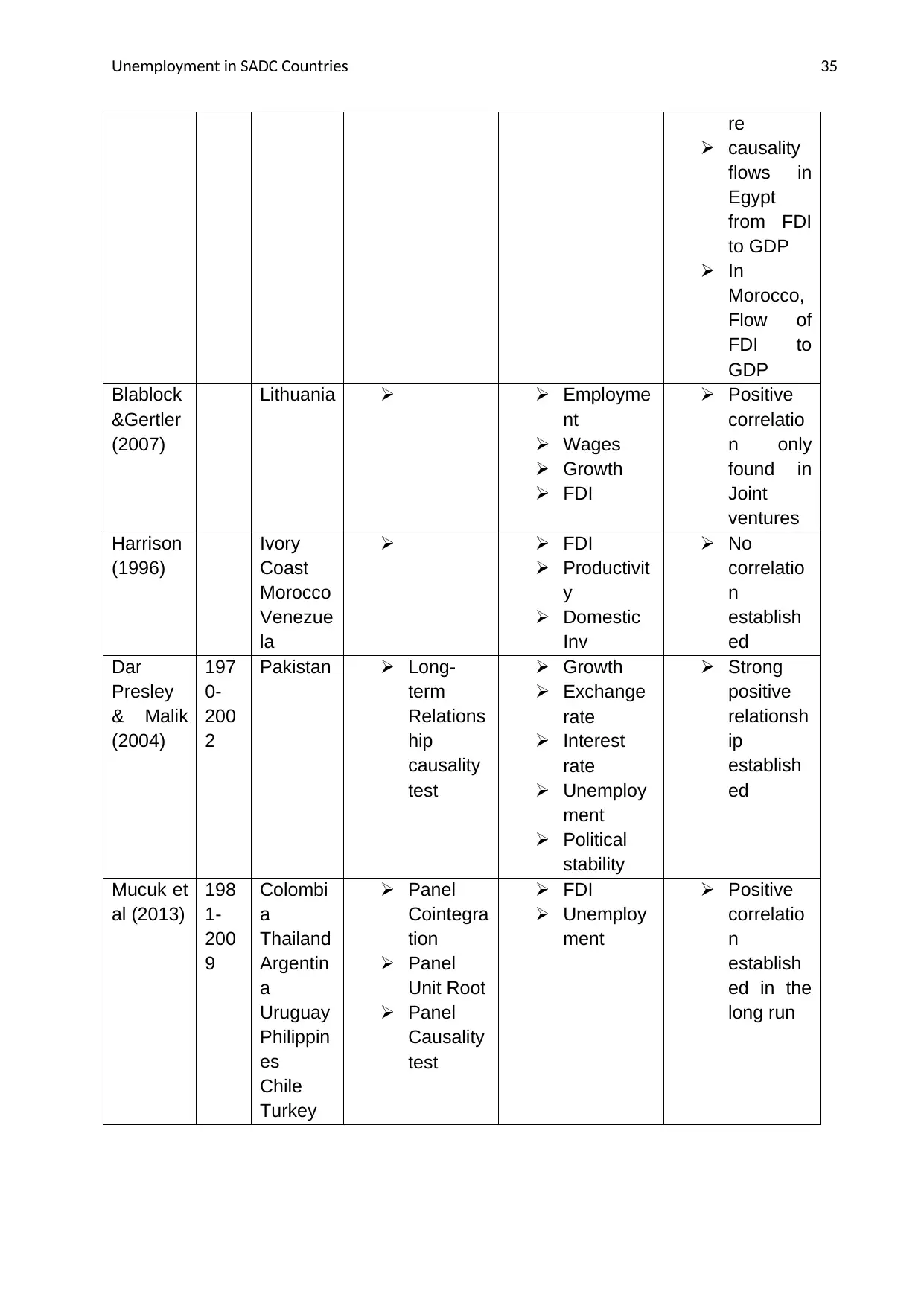
Unemployment in SADC Countries 35
re
causality
flows in
Egypt
from FDI
to GDP
In
Morocco,
Flow of
FDI to
GDP
Blablock
&Gertler
(2007)
Lithuania Employme
nt
Wages
Growth
FDI
Positive
correlatio
n only
found in
Joint
ventures
Harrison
(1996)
Ivory
Coast
Morocco
Venezue
la
FDI
Productivit
y
Domestic
Inv
No
correlatio
n
establish
ed
Dar
Presley
& Malik
(2004)
197
0-
200
2
Pakistan Long-
term
Relations
hip
causality
test
Growth
Exchange
rate
Interest
rate
Unemploy
ment
Political
stability
Strong
positive
relationsh
ip
establish
ed
Mucuk et
al (2013)
198
1-
200
9
Colombi
a
Thailand
Argentin
a
Uruguay
Philippin
es
Chile
Turkey
Panel
Cointegra
tion
Panel
Unit Root
Panel
Causality
test
FDI
Unemploy
ment
Positive
correlatio
n
establish
ed in the
long run
re
causality
flows in
Egypt
from FDI
to GDP
In
Morocco,
Flow of
FDI to
GDP
Blablock
&Gertler
(2007)
Lithuania Employme
nt
Wages
Growth
FDI
Positive
correlatio
n only
found in
Joint
ventures
Harrison
(1996)
Ivory
Coast
Morocco
Venezue
la
FDI
Productivit
y
Domestic
Inv
No
correlatio
n
establish
ed
Dar
Presley
& Malik
(2004)
197
0-
200
2
Pakistan Long-
term
Relations
hip
causality
test
Growth
Exchange
rate
Interest
rate
Unemploy
ment
Political
stability
Strong
positive
relationsh
ip
establish
ed
Mucuk et
al (2013)
198
1-
200
9
Colombi
a
Thailand
Argentin
a
Uruguay
Philippin
es
Chile
Turkey
Panel
Cointegra
tion
Panel
Unit Root
Panel
Causality
test
FDI
Unemploy
ment
Positive
correlatio
n
establish
ed in the
long run
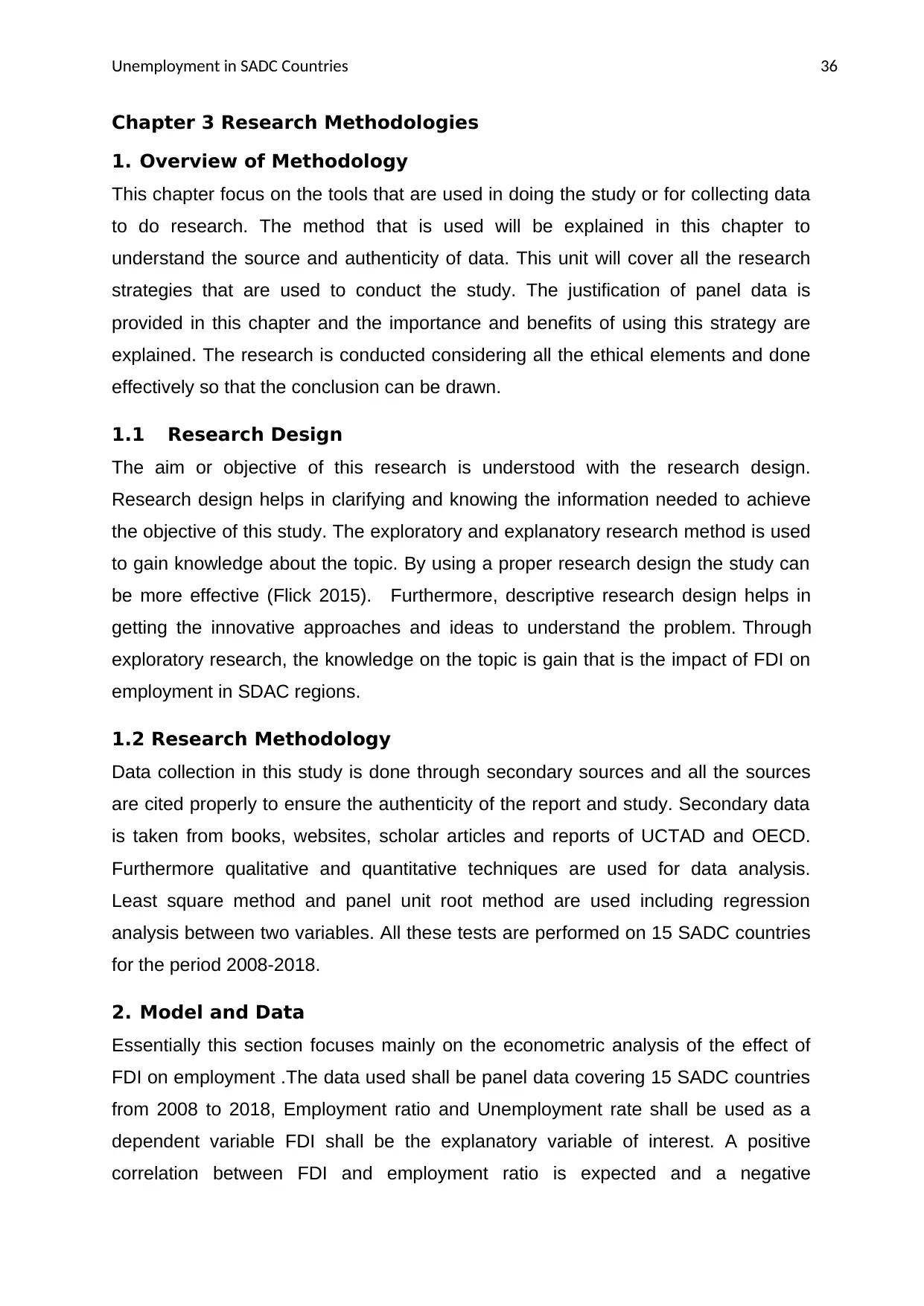
Unemployment in SADC Countries 36
Chapter 3 Research Methodologies
1. Overview of Methodology
This chapter focus on the tools that are used in doing the study or for collecting data
to do research. The method that is used will be explained in this chapter to
understand the source and authenticity of data. This unit will cover all the research
strategies that are used to conduct the study. The justification of panel data is
provided in this chapter and the importance and benefits of using this strategy are
explained. The research is conducted considering all the ethical elements and done
effectively so that the conclusion can be drawn.
1.1 Research Design
The aim or objective of this research is understood with the research design.
Research design helps in clarifying and knowing the information needed to achieve
the objective of this study. The exploratory and explanatory research method is used
to gain knowledge about the topic. By using a proper research design the study can
be more effective (Flick 2015). Furthermore, descriptive research design helps in
getting the innovative approaches and ideas to understand the problem. Through
exploratory research, the knowledge on the topic is gain that is the impact of FDI on
employment in SDAC regions.
1.2 Research Methodology
Data collection in this study is done through secondary sources and all the sources
are cited properly to ensure the authenticity of the report and study. Secondary data
is taken from books, websites, scholar articles and reports of UCTAD and OECD.
Furthermore qualitative and quantitative techniques are used for data analysis.
Least square method and panel unit root method are used including regression
analysis between two variables. All these tests are performed on 15 SADC countries
for the period 2008-2018.
2. Model and Data
Essentially this section focuses mainly on the econometric analysis of the effect of
FDI on employment .The data used shall be panel data covering 15 SADC countries
from 2008 to 2018, Employment ratio and Unemployment rate shall be used as a
dependent variable FDI shall be the explanatory variable of interest. A positive
correlation between FDI and employment ratio is expected and a negative
Chapter 3 Research Methodologies
1. Overview of Methodology
This chapter focus on the tools that are used in doing the study or for collecting data
to do research. The method that is used will be explained in this chapter to
understand the source and authenticity of data. This unit will cover all the research
strategies that are used to conduct the study. The justification of panel data is
provided in this chapter and the importance and benefits of using this strategy are
explained. The research is conducted considering all the ethical elements and done
effectively so that the conclusion can be drawn.
1.1 Research Design
The aim or objective of this research is understood with the research design.
Research design helps in clarifying and knowing the information needed to achieve
the objective of this study. The exploratory and explanatory research method is used
to gain knowledge about the topic. By using a proper research design the study can
be more effective (Flick 2015). Furthermore, descriptive research design helps in
getting the innovative approaches and ideas to understand the problem. Through
exploratory research, the knowledge on the topic is gain that is the impact of FDI on
employment in SDAC regions.
1.2 Research Methodology
Data collection in this study is done through secondary sources and all the sources
are cited properly to ensure the authenticity of the report and study. Secondary data
is taken from books, websites, scholar articles and reports of UCTAD and OECD.
Furthermore qualitative and quantitative techniques are used for data analysis.
Least square method and panel unit root method are used including regression
analysis between two variables. All these tests are performed on 15 SADC countries
for the period 2008-2018.
2. Model and Data
Essentially this section focuses mainly on the econometric analysis of the effect of
FDI on employment .The data used shall be panel data covering 15 SADC countries
from 2008 to 2018, Employment ratio and Unemployment rate shall be used as a
dependent variable FDI shall be the explanatory variable of interest. A positive
correlation between FDI and employment ratio is expected and a negative
Paraphrase This Document
Need a fresh take? Get an instant paraphrase of this document with our AI Paraphraser
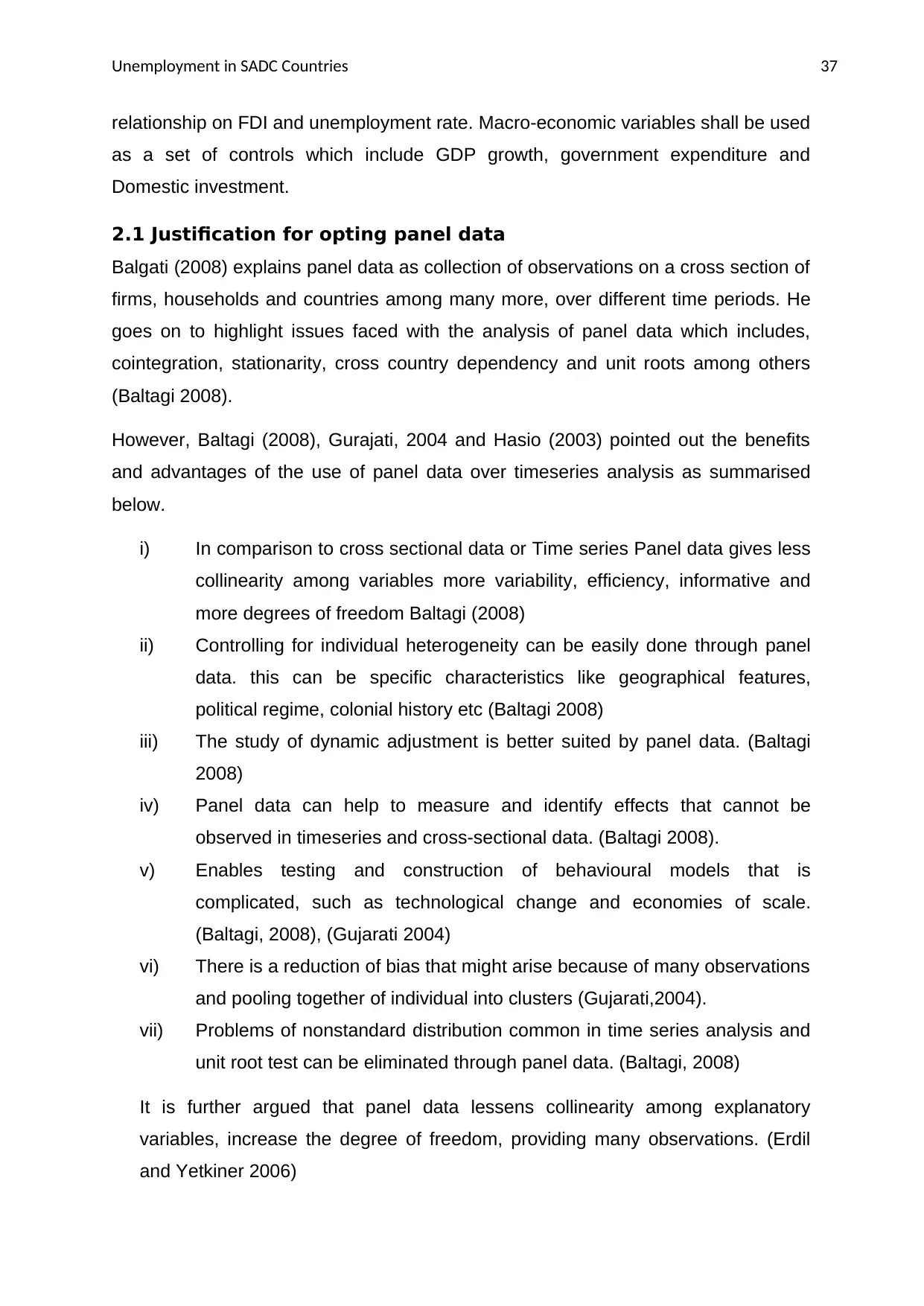
Unemployment in SADC Countries 37
relationship on FDI and unemployment rate. Macro-economic variables shall be used
as a set of controls which include GDP growth, government expenditure and
Domestic investment.
2.1 Justification for opting panel data
Balgati (2008) explains panel data as collection of observations on a cross section of
firms, households and countries among many more, over different time periods. He
goes on to highlight issues faced with the analysis of panel data which includes,
cointegration, stationarity, cross country dependency and unit roots among others
(Baltagi 2008).
However, Baltagi (2008), Gurajati, 2004 and Hasio (2003) pointed out the benefits
and advantages of the use of panel data over timeseries analysis as summarised
below.
i) In comparison to cross sectional data or Time series Panel data gives less
collinearity among variables more variability, efficiency, informative and
more degrees of freedom Baltagi (2008)
ii) Controlling for individual heterogeneity can be easily done through panel
data. this can be specific characteristics like geographical features,
political regime, colonial history etc (Baltagi 2008)
iii) The study of dynamic adjustment is better suited by panel data. (Baltagi
2008)
iv) Panel data can help to measure and identify effects that cannot be
observed in timeseries and cross-sectional data. (Baltagi 2008).
v) Enables testing and construction of behavioural models that is
complicated, such as technological change and economies of scale.
(Baltagi, 2008), (Gujarati 2004)
vi) There is a reduction of bias that might arise because of many observations
and pooling together of individual into clusters (Gujarati,2004).
vii) Problems of nonstandard distribution common in time series analysis and
unit root test can be eliminated through panel data. (Baltagi, 2008)
It is further argued that panel data lessens collinearity among explanatory
variables, increase the degree of freedom, providing many observations. (Erdil
and Yetkiner 2006)
relationship on FDI and unemployment rate. Macro-economic variables shall be used
as a set of controls which include GDP growth, government expenditure and
Domestic investment.
2.1 Justification for opting panel data
Balgati (2008) explains panel data as collection of observations on a cross section of
firms, households and countries among many more, over different time periods. He
goes on to highlight issues faced with the analysis of panel data which includes,
cointegration, stationarity, cross country dependency and unit roots among others
(Baltagi 2008).
However, Baltagi (2008), Gurajati, 2004 and Hasio (2003) pointed out the benefits
and advantages of the use of panel data over timeseries analysis as summarised
below.
i) In comparison to cross sectional data or Time series Panel data gives less
collinearity among variables more variability, efficiency, informative and
more degrees of freedom Baltagi (2008)
ii) Controlling for individual heterogeneity can be easily done through panel
data. this can be specific characteristics like geographical features,
political regime, colonial history etc (Baltagi 2008)
iii) The study of dynamic adjustment is better suited by panel data. (Baltagi
2008)
iv) Panel data can help to measure and identify effects that cannot be
observed in timeseries and cross-sectional data. (Baltagi 2008).
v) Enables testing and construction of behavioural models that is
complicated, such as technological change and economies of scale.
(Baltagi, 2008), (Gujarati 2004)
vi) There is a reduction of bias that might arise because of many observations
and pooling together of individual into clusters (Gujarati,2004).
vii) Problems of nonstandard distribution common in time series analysis and
unit root test can be eliminated through panel data. (Baltagi, 2008)
It is further argued that panel data lessens collinearity among explanatory
variables, increase the degree of freedom, providing many observations. (Erdil
and Yetkiner 2006)
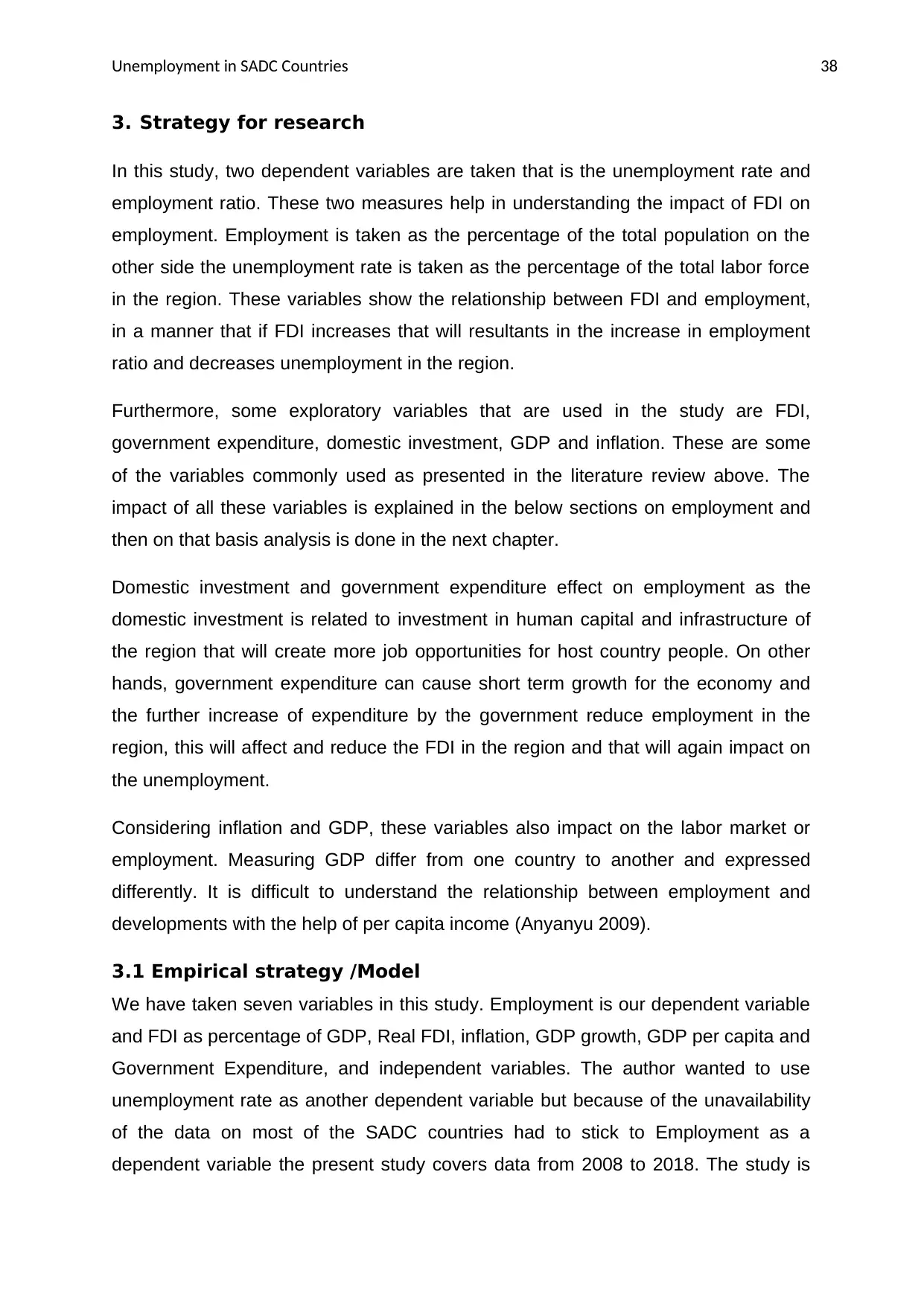
Unemployment in SADC Countries 38
3. Strategy for research
In this study, two dependent variables are taken that is the unemployment rate and
employment ratio. These two measures help in understanding the impact of FDI on
employment. Employment is taken as the percentage of the total population on the
other side the unemployment rate is taken as the percentage of the total labor force
in the region. These variables show the relationship between FDI and employment,
in a manner that if FDI increases that will resultants in the increase in employment
ratio and decreases unemployment in the region.
Furthermore, some exploratory variables that are used in the study are FDI,
government expenditure, domestic investment, GDP and inflation. These are some
of the variables commonly used as presented in the literature review above. The
impact of all these variables is explained in the below sections on employment and
then on that basis analysis is done in the next chapter.
Domestic investment and government expenditure effect on employment as the
domestic investment is related to investment in human capital and infrastructure of
the region that will create more job opportunities for host country people. On other
hands, government expenditure can cause short term growth for the economy and
the further increase of expenditure by the government reduce employment in the
region, this will affect and reduce the FDI in the region and that will again impact on
the unemployment.
Considering inflation and GDP, these variables also impact on the labor market or
employment. Measuring GDP differ from one country to another and expressed
differently. It is difficult to understand the relationship between employment and
developments with the help of per capita income (Anyanyu 2009).
3.1 Empirical strategy /Model
We have taken seven variables in this study. Employment is our dependent variable
and FDI as percentage of GDP, Real FDI, inflation, GDP growth, GDP per capita and
Government Expenditure, and independent variables. The author wanted to use
unemployment rate as another dependent variable but because of the unavailability
of the data on most of the SADC countries had to stick to Employment as a
dependent variable the present study covers data from 2008 to 2018. The study is
3. Strategy for research
In this study, two dependent variables are taken that is the unemployment rate and
employment ratio. These two measures help in understanding the impact of FDI on
employment. Employment is taken as the percentage of the total population on the
other side the unemployment rate is taken as the percentage of the total labor force
in the region. These variables show the relationship between FDI and employment,
in a manner that if FDI increases that will resultants in the increase in employment
ratio and decreases unemployment in the region.
Furthermore, some exploratory variables that are used in the study are FDI,
government expenditure, domestic investment, GDP and inflation. These are some
of the variables commonly used as presented in the literature review above. The
impact of all these variables is explained in the below sections on employment and
then on that basis analysis is done in the next chapter.
Domestic investment and government expenditure effect on employment as the
domestic investment is related to investment in human capital and infrastructure of
the region that will create more job opportunities for host country people. On other
hands, government expenditure can cause short term growth for the economy and
the further increase of expenditure by the government reduce employment in the
region, this will affect and reduce the FDI in the region and that will again impact on
the unemployment.
Considering inflation and GDP, these variables also impact on the labor market or
employment. Measuring GDP differ from one country to another and expressed
differently. It is difficult to understand the relationship between employment and
developments with the help of per capita income (Anyanyu 2009).
3.1 Empirical strategy /Model
We have taken seven variables in this study. Employment is our dependent variable
and FDI as percentage of GDP, Real FDI, inflation, GDP growth, GDP per capita and
Government Expenditure, and independent variables. The author wanted to use
unemployment rate as another dependent variable but because of the unavailability
of the data on most of the SADC countries had to stick to Employment as a
dependent variable the present study covers data from 2008 to 2018. The study is
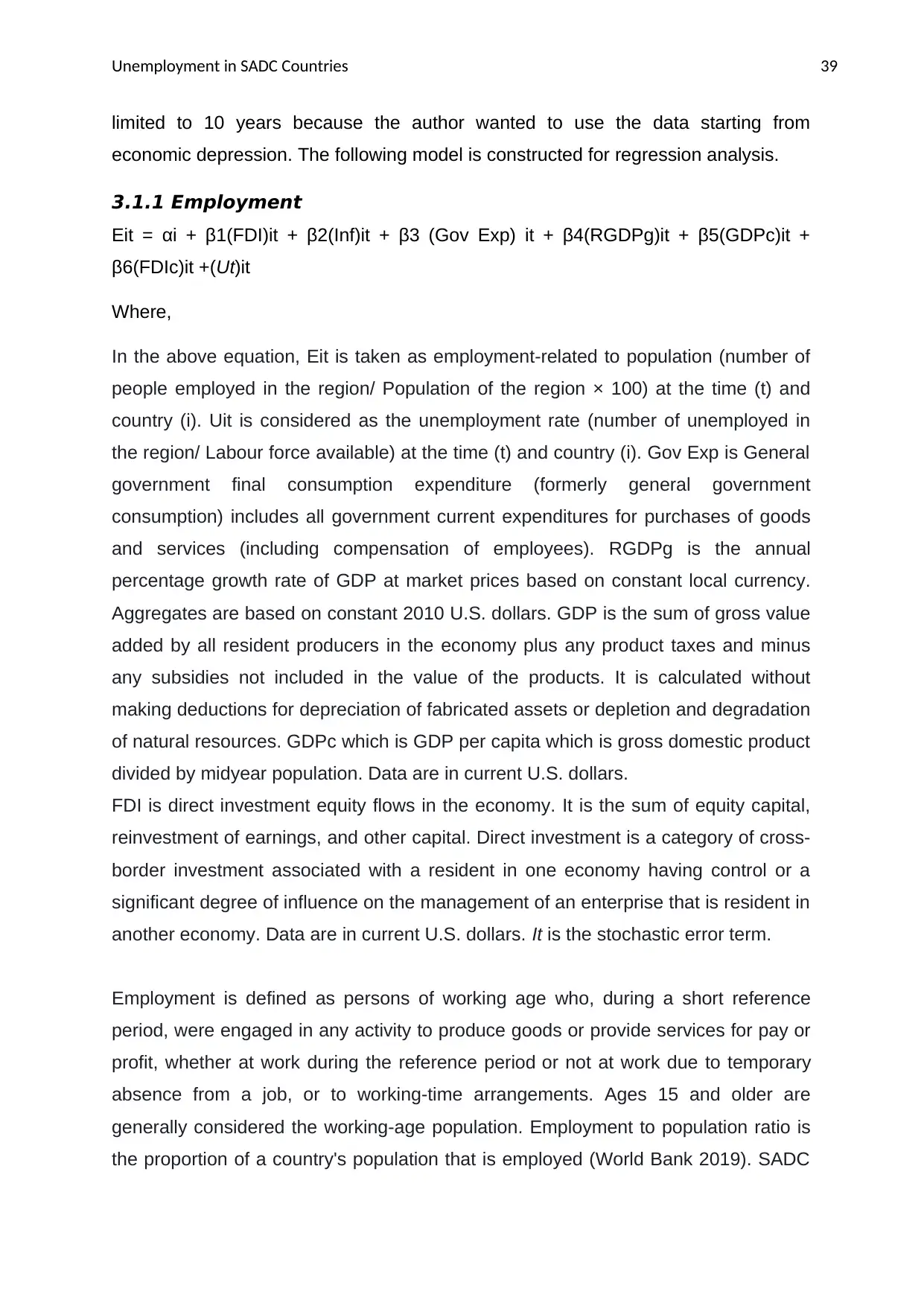
Unemployment in SADC Countries 39
limited to 10 years because the author wanted to use the data starting from
economic depression. The following model is constructed for regression analysis.
3.1.1 Employment
Eit = αi + β1(FDI)it + β2(Inf)it + β3 (Gov Exp) it + β4(RGDPg)it + β5(GDPc)it +
β6(FDIc)it +(Ut)it
Where,
In the above equation, Eit is taken as employment-related to population (number of
people employed in the region/ Population of the region × 100) at the time (t) and
country (i). Uit is considered as the unemployment rate (number of unemployed in
the region/ Labour force available) at the time (t) and country (i). Gov Exp is General
government final consumption expenditure (formerly general government
consumption) includes all government current expenditures for purchases of goods
and services (including compensation of employees). RGDPg is the annual
percentage growth rate of GDP at market prices based on constant local currency.
Aggregates are based on constant 2010 U.S. dollars. GDP is the sum of gross value
added by all resident producers in the economy plus any product taxes and minus
any subsidies not included in the value of the products. It is calculated without
making deductions for depreciation of fabricated assets or depletion and degradation
of natural resources. GDPc which is GDP per capita which is gross domestic product
divided by midyear population. Data are in current U.S. dollars.
FDI is direct investment equity flows in the economy. It is the sum of equity capital,
reinvestment of earnings, and other capital. Direct investment is a category of cross-
border investment associated with a resident in one economy having control or a
significant degree of influence on the management of an enterprise that is resident in
another economy. Data are in current U.S. dollars. It is the stochastic error term.
Employment is defined as persons of working age who, during a short reference
period, were engaged in any activity to produce goods or provide services for pay or
profit, whether at work during the reference period or not at work due to temporary
absence from a job, or to working-time arrangements. Ages 15 and older are
generally considered the working-age population. Employment to population ratio is
the proportion of a country's population that is employed (World Bank 2019). SADC
limited to 10 years because the author wanted to use the data starting from
economic depression. The following model is constructed for regression analysis.
3.1.1 Employment
Eit = αi + β1(FDI)it + β2(Inf)it + β3 (Gov Exp) it + β4(RGDPg)it + β5(GDPc)it +
β6(FDIc)it +(Ut)it
Where,
In the above equation, Eit is taken as employment-related to population (number of
people employed in the region/ Population of the region × 100) at the time (t) and
country (i). Uit is considered as the unemployment rate (number of unemployed in
the region/ Labour force available) at the time (t) and country (i). Gov Exp is General
government final consumption expenditure (formerly general government
consumption) includes all government current expenditures for purchases of goods
and services (including compensation of employees). RGDPg is the annual
percentage growth rate of GDP at market prices based on constant local currency.
Aggregates are based on constant 2010 U.S. dollars. GDP is the sum of gross value
added by all resident producers in the economy plus any product taxes and minus
any subsidies not included in the value of the products. It is calculated without
making deductions for depreciation of fabricated assets or depletion and degradation
of natural resources. GDPc which is GDP per capita which is gross domestic product
divided by midyear population. Data are in current U.S. dollars.
FDI is direct investment equity flows in the economy. It is the sum of equity capital,
reinvestment of earnings, and other capital. Direct investment is a category of cross-
border investment associated with a resident in one economy having control or a
significant degree of influence on the management of an enterprise that is resident in
another economy. Data are in current U.S. dollars. It is the stochastic error term.
Employment is defined as persons of working age who, during a short reference
period, were engaged in any activity to produce goods or provide services for pay or
profit, whether at work during the reference period or not at work due to temporary
absence from a job, or to working-time arrangements. Ages 15 and older are
generally considered the working-age population. Employment to population ratio is
the proportion of a country's population that is employed (World Bank 2019). SADC
Secure Best Marks with AI Grader
Need help grading? Try our AI Grader for instant feedback on your assignments.
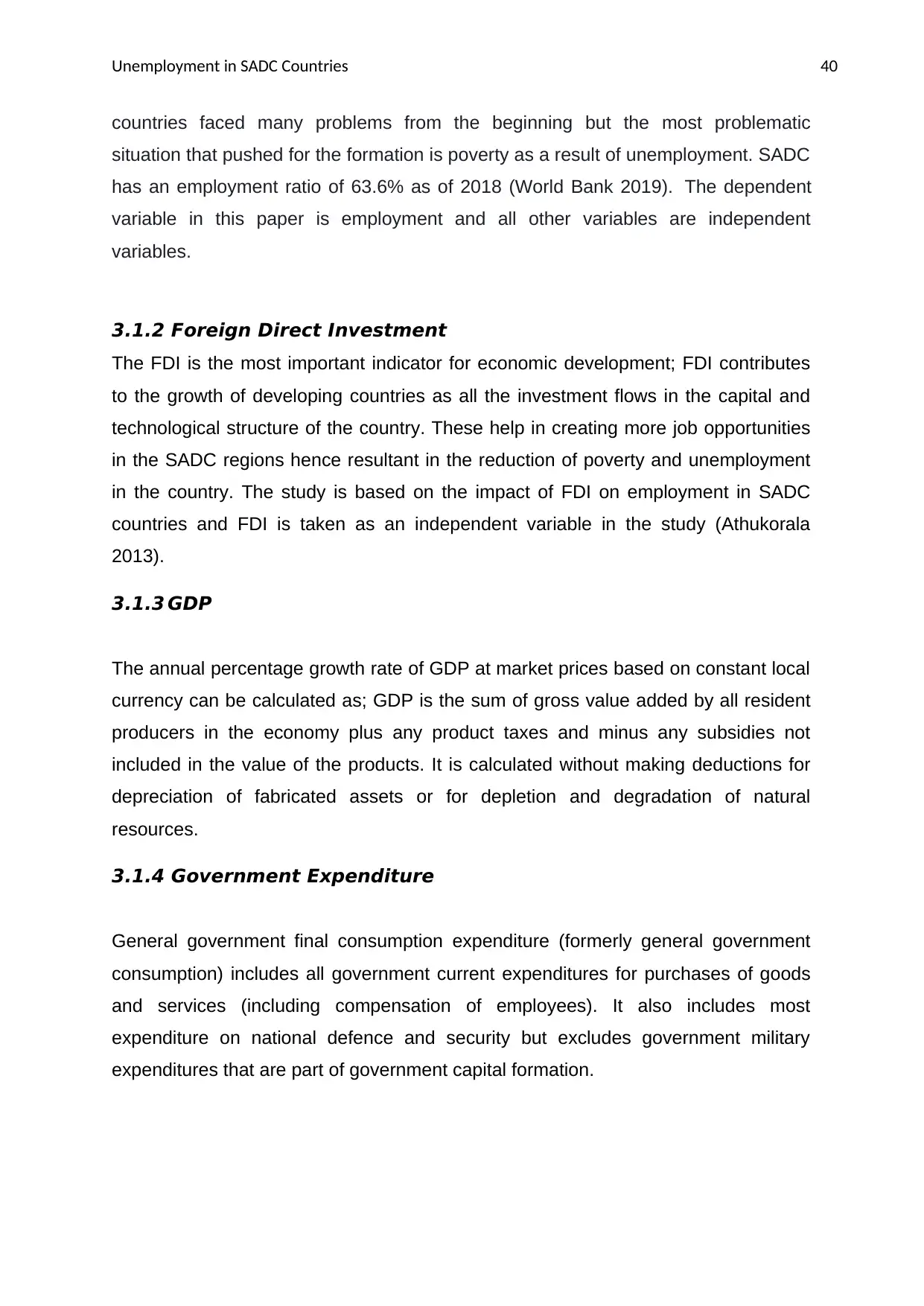
Unemployment in SADC Countries 40
countries faced many problems from the beginning but the most problematic
situation that pushed for the formation is poverty as a result of unemployment. SADC
has an employment ratio of 63.6% as of 2018 (World Bank 2019). The dependent
variable in this paper is employment and all other variables are independent
variables.
3.1.2 Foreign Direct Investment
The FDI is the most important indicator for economic development; FDI contributes
to the growth of developing countries as all the investment flows in the capital and
technological structure of the country. These help in creating more job opportunities
in the SADC regions hence resultant in the reduction of poverty and unemployment
in the country. The study is based on the impact of FDI on employment in SADC
countries and FDI is taken as an independent variable in the study (Athukorala
2013).
3.1.3 GDP
The annual percentage growth rate of GDP at market prices based on constant local
currency can be calculated as; GDP is the sum of gross value added by all resident
producers in the economy plus any product taxes and minus any subsidies not
included in the value of the products. It is calculated without making deductions for
depreciation of fabricated assets or for depletion and degradation of natural
resources.
3.1.4 Government Expenditure
General government final consumption expenditure (formerly general government
consumption) includes all government current expenditures for purchases of goods
and services (including compensation of employees). It also includes most
expenditure on national defence and security but excludes government military
expenditures that are part of government capital formation.
countries faced many problems from the beginning but the most problematic
situation that pushed for the formation is poverty as a result of unemployment. SADC
has an employment ratio of 63.6% as of 2018 (World Bank 2019). The dependent
variable in this paper is employment and all other variables are independent
variables.
3.1.2 Foreign Direct Investment
The FDI is the most important indicator for economic development; FDI contributes
to the growth of developing countries as all the investment flows in the capital and
technological structure of the country. These help in creating more job opportunities
in the SADC regions hence resultant in the reduction of poverty and unemployment
in the country. The study is based on the impact of FDI on employment in SADC
countries and FDI is taken as an independent variable in the study (Athukorala
2013).
3.1.3 GDP
The annual percentage growth rate of GDP at market prices based on constant local
currency can be calculated as; GDP is the sum of gross value added by all resident
producers in the economy plus any product taxes and minus any subsidies not
included in the value of the products. It is calculated without making deductions for
depreciation of fabricated assets or for depletion and degradation of natural
resources.
3.1.4 Government Expenditure
General government final consumption expenditure (formerly general government
consumption) includes all government current expenditures for purchases of goods
and services (including compensation of employees). It also includes most
expenditure on national defence and security but excludes government military
expenditures that are part of government capital formation.
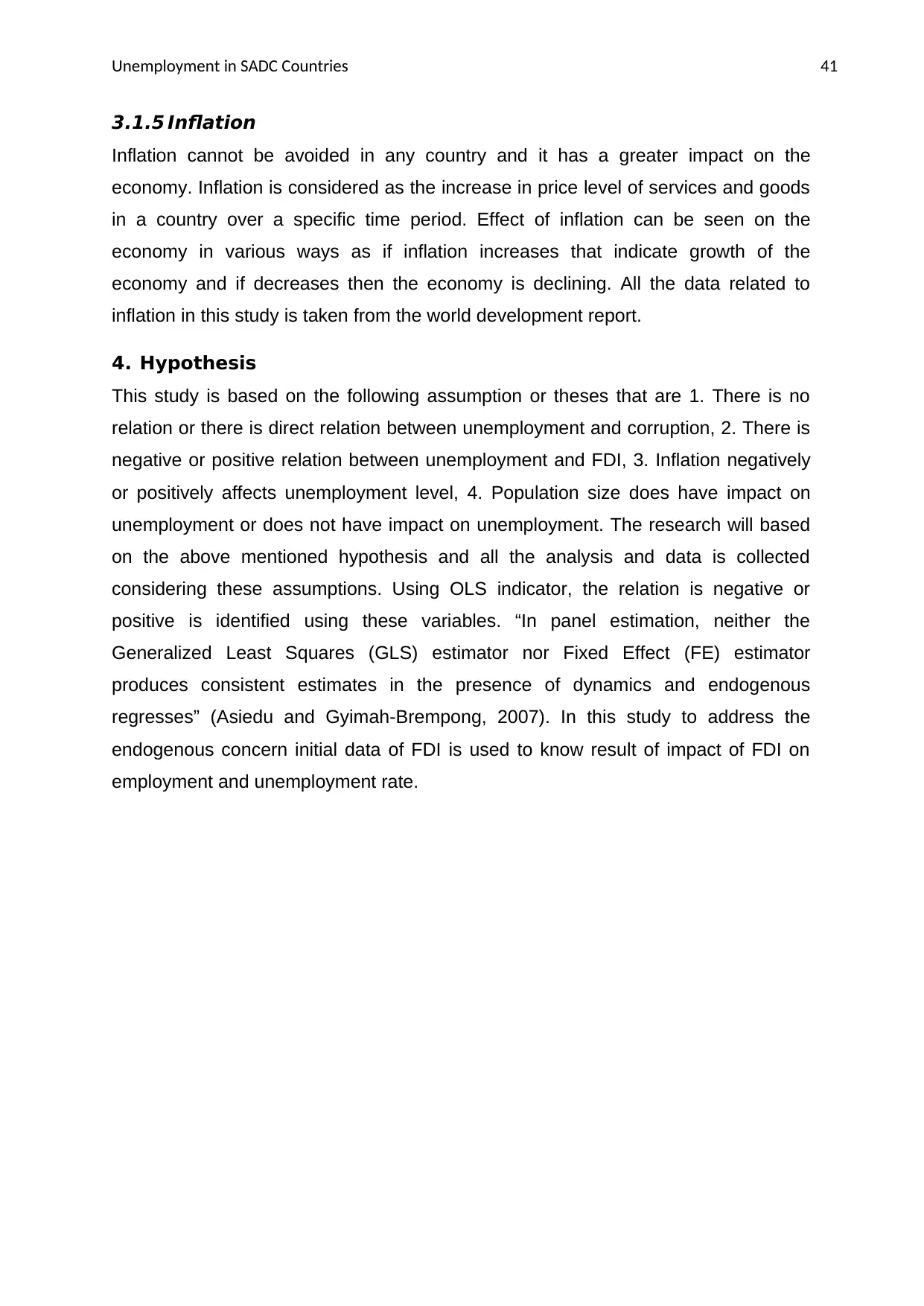
Unemployment in SADC Countries 41
3.1.5 Inflation
Inflation cannot be avoided in any country and it has a greater impact on the
economy. Inflation is considered as the increase in price level of services and goods
in a country over a specific time period. Effect of inflation can be seen on the
economy in various ways as if inflation increases that indicate growth of the
economy and if decreases then the economy is declining. All the data related to
inflation in this study is taken from the world development report.
4. Hypothesis
This study is based on the following assumption or theses that are 1. There is no
relation or there is direct relation between unemployment and corruption, 2. There is
negative or positive relation between unemployment and FDI, 3. Inflation negatively
or positively affects unemployment level, 4. Population size does have impact on
unemployment or does not have impact on unemployment. The research will based
on the above mentioned hypothesis and all the analysis and data is collected
considering these assumptions. Using OLS indicator, the relation is negative or
positive is identified using these variables. “In panel estimation, neither the
Generalized Least Squares (GLS) estimator nor Fixed Effect (FE) estimator
produces consistent estimates in the presence of dynamics and endogenous
regresses” (Asiedu and Gyimah-Brempong, 2007). In this study to address the
endogenous concern initial data of FDI is used to know result of impact of FDI on
employment and unemployment rate.
3.1.5 Inflation
Inflation cannot be avoided in any country and it has a greater impact on the
economy. Inflation is considered as the increase in price level of services and goods
in a country over a specific time period. Effect of inflation can be seen on the
economy in various ways as if inflation increases that indicate growth of the
economy and if decreases then the economy is declining. All the data related to
inflation in this study is taken from the world development report.
4. Hypothesis
This study is based on the following assumption or theses that are 1. There is no
relation or there is direct relation between unemployment and corruption, 2. There is
negative or positive relation between unemployment and FDI, 3. Inflation negatively
or positively affects unemployment level, 4. Population size does have impact on
unemployment or does not have impact on unemployment. The research will based
on the above mentioned hypothesis and all the analysis and data is collected
considering these assumptions. Using OLS indicator, the relation is negative or
positive is identified using these variables. “In panel estimation, neither the
Generalized Least Squares (GLS) estimator nor Fixed Effect (FE) estimator
produces consistent estimates in the presence of dynamics and endogenous
regresses” (Asiedu and Gyimah-Brempong, 2007). In this study to address the
endogenous concern initial data of FDI is used to know result of impact of FDI on
employment and unemployment rate.
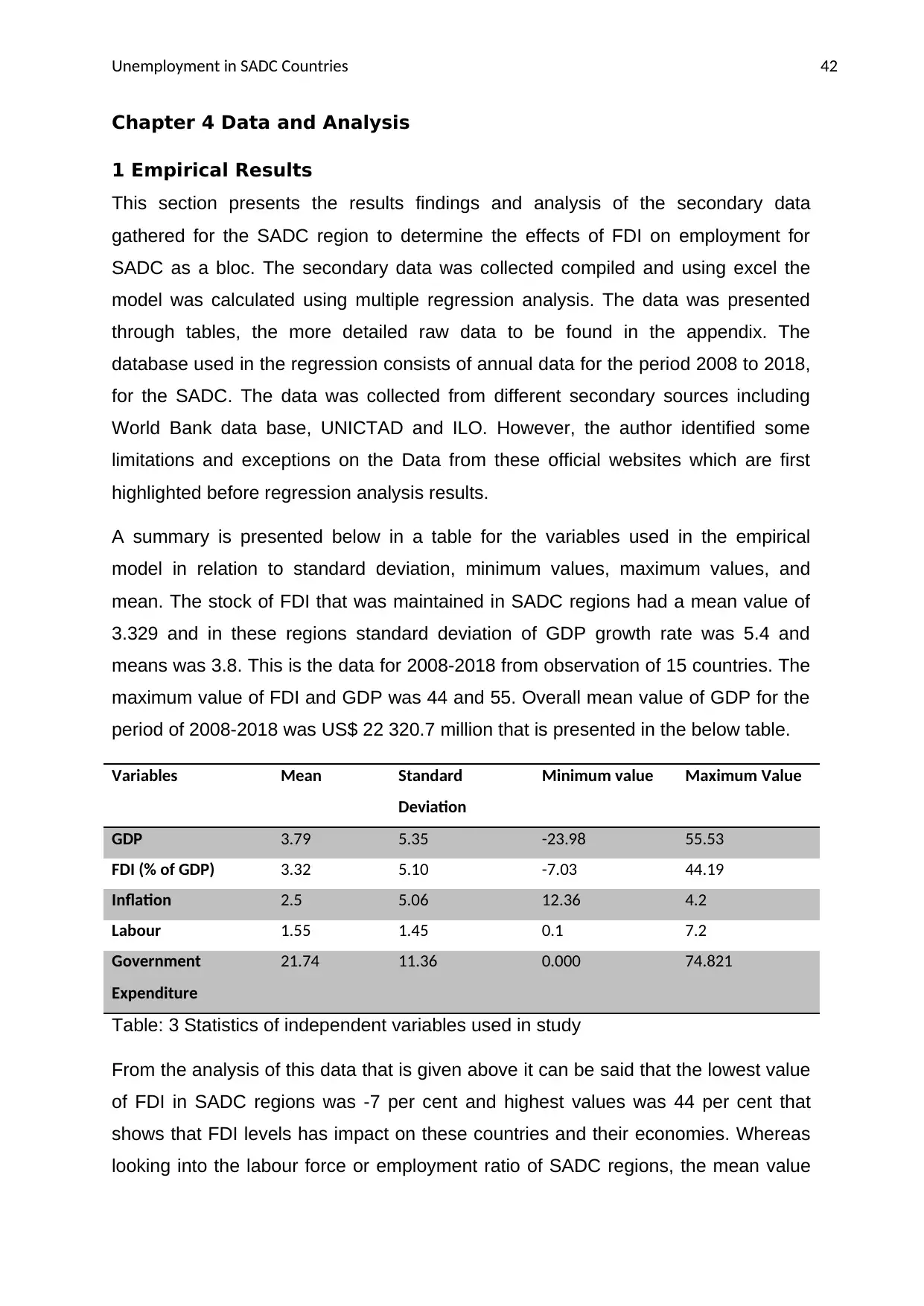
Unemployment in SADC Countries 42
Chapter 4 Data and Analysis
1 Empirical Results
This section presents the results findings and analysis of the secondary data
gathered for the SADC region to determine the effects of FDI on employment for
SADC as a bloc. The secondary data was collected compiled and using excel the
model was calculated using multiple regression analysis. The data was presented
through tables, the more detailed raw data to be found in the appendix. The
database used in the regression consists of annual data for the period 2008 to 2018,
for the SADC. The data was collected from different secondary sources including
World Bank data base, UNICTAD and ILO. However, the author identified some
limitations and exceptions on the Data from these official websites which are first
highlighted before regression analysis results.
A summary is presented below in a table for the variables used in the empirical
model in relation to standard deviation, minimum values, maximum values, and
mean. The stock of FDI that was maintained in SADC regions had a mean value of
3.329 and in these regions standard deviation of GDP growth rate was 5.4 and
means was 3.8. This is the data for 2008-2018 from observation of 15 countries. The
maximum value of FDI and GDP was 44 and 55. Overall mean value of GDP for the
period of 2008-2018 was US$ 22 320.7 million that is presented in the below table.
Variables Mean Standard
Deviation
Minimum value Maximum Value
GDP 3.79 5.35 -23.98 55.53
FDI (% of GDP) 3.32 5.10 -7.03 44.19
Inflation 2.5 5.06 12.36 4.2
Labour 1.55 1.45 0.1 7.2
Government
Expenditure
21.74 11.36 0.000 74.821
Table: 3 Statistics of independent variables used in study
From the analysis of this data that is given above it can be said that the lowest value
of FDI in SADC regions was -7 per cent and highest values was 44 per cent that
shows that FDI levels has impact on these countries and their economies. Whereas
looking into the labour force or employment ratio of SADC regions, the mean value
Chapter 4 Data and Analysis
1 Empirical Results
This section presents the results findings and analysis of the secondary data
gathered for the SADC region to determine the effects of FDI on employment for
SADC as a bloc. The secondary data was collected compiled and using excel the
model was calculated using multiple regression analysis. The data was presented
through tables, the more detailed raw data to be found in the appendix. The
database used in the regression consists of annual data for the period 2008 to 2018,
for the SADC. The data was collected from different secondary sources including
World Bank data base, UNICTAD and ILO. However, the author identified some
limitations and exceptions on the Data from these official websites which are first
highlighted before regression analysis results.
A summary is presented below in a table for the variables used in the empirical
model in relation to standard deviation, minimum values, maximum values, and
mean. The stock of FDI that was maintained in SADC regions had a mean value of
3.329 and in these regions standard deviation of GDP growth rate was 5.4 and
means was 3.8. This is the data for 2008-2018 from observation of 15 countries. The
maximum value of FDI and GDP was 44 and 55. Overall mean value of GDP for the
period of 2008-2018 was US$ 22 320.7 million that is presented in the below table.
Variables Mean Standard
Deviation
Minimum value Maximum Value
GDP 3.79 5.35 -23.98 55.53
FDI (% of GDP) 3.32 5.10 -7.03 44.19
Inflation 2.5 5.06 12.36 4.2
Labour 1.55 1.45 0.1 7.2
Government
Expenditure
21.74 11.36 0.000 74.821
Table: 3 Statistics of independent variables used in study
From the analysis of this data that is given above it can be said that the lowest value
of FDI in SADC regions was -7 per cent and highest values was 44 per cent that
shows that FDI levels has impact on these countries and their economies. Whereas
looking into the labour force or employment ratio of SADC regions, the mean value
Paraphrase This Document
Need a fresh take? Get an instant paraphrase of this document with our AI Paraphraser
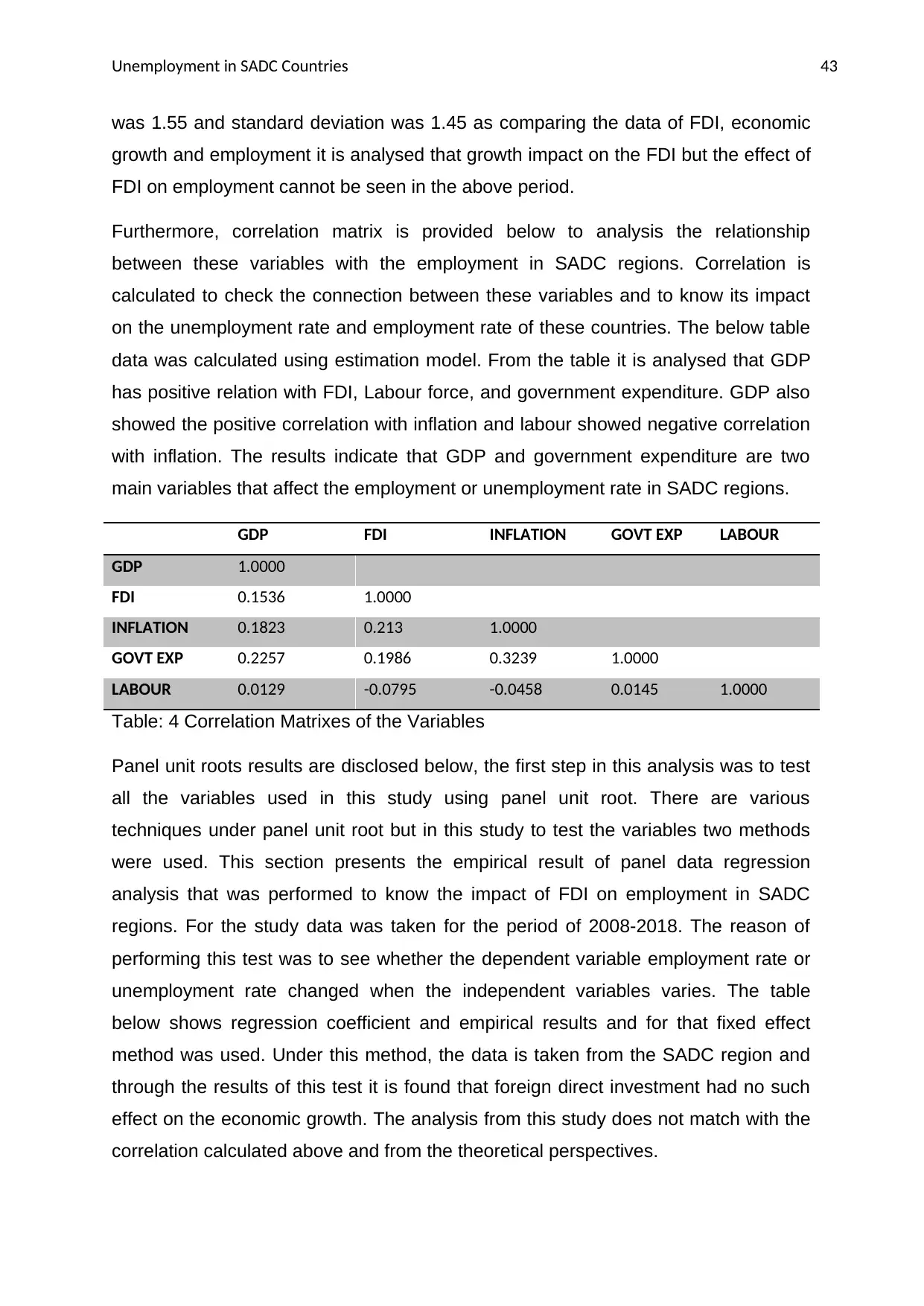
Unemployment in SADC Countries 43
was 1.55 and standard deviation was 1.45 as comparing the data of FDI, economic
growth and employment it is analysed that growth impact on the FDI but the effect of
FDI on employment cannot be seen in the above period.
Furthermore, correlation matrix is provided below to analysis the relationship
between these variables with the employment in SADC regions. Correlation is
calculated to check the connection between these variables and to know its impact
on the unemployment rate and employment rate of these countries. The below table
data was calculated using estimation model. From the table it is analysed that GDP
has positive relation with FDI, Labour force, and government expenditure. GDP also
showed the positive correlation with inflation and labour showed negative correlation
with inflation. The results indicate that GDP and government expenditure are two
main variables that affect the employment or unemployment rate in SADC regions.
GDP FDI INFLATION GOVT EXP LABOUR
GDP 1.0000
FDI 0.1536 1.0000
INFLATION 0.1823 0.213 1.0000
GOVT EXP 0.2257 0.1986 0.3239 1.0000
LABOUR 0.0129 -0.0795 -0.0458 0.0145 1.0000
Table: 4 Correlation Matrixes of the Variables
Panel unit roots results are disclosed below, the first step in this analysis was to test
all the variables used in this study using panel unit root. There are various
techniques under panel unit root but in this study to test the variables two methods
were used. This section presents the empirical result of panel data regression
analysis that was performed to know the impact of FDI on employment in SADC
regions. For the study data was taken for the period of 2008-2018. The reason of
performing this test was to see whether the dependent variable employment rate or
unemployment rate changed when the independent variables varies. The table
below shows regression coefficient and empirical results and for that fixed effect
method was used. Under this method, the data is taken from the SADC region and
through the results of this test it is found that foreign direct investment had no such
effect on the economic growth. The analysis from this study does not match with the
correlation calculated above and from the theoretical perspectives.
was 1.55 and standard deviation was 1.45 as comparing the data of FDI, economic
growth and employment it is analysed that growth impact on the FDI but the effect of
FDI on employment cannot be seen in the above period.
Furthermore, correlation matrix is provided below to analysis the relationship
between these variables with the employment in SADC regions. Correlation is
calculated to check the connection between these variables and to know its impact
on the unemployment rate and employment rate of these countries. The below table
data was calculated using estimation model. From the table it is analysed that GDP
has positive relation with FDI, Labour force, and government expenditure. GDP also
showed the positive correlation with inflation and labour showed negative correlation
with inflation. The results indicate that GDP and government expenditure are two
main variables that affect the employment or unemployment rate in SADC regions.
GDP FDI INFLATION GOVT EXP LABOUR
GDP 1.0000
FDI 0.1536 1.0000
INFLATION 0.1823 0.213 1.0000
GOVT EXP 0.2257 0.1986 0.3239 1.0000
LABOUR 0.0129 -0.0795 -0.0458 0.0145 1.0000
Table: 4 Correlation Matrixes of the Variables
Panel unit roots results are disclosed below, the first step in this analysis was to test
all the variables used in this study using panel unit root. There are various
techniques under panel unit root but in this study to test the variables two methods
were used. This section presents the empirical result of panel data regression
analysis that was performed to know the impact of FDI on employment in SADC
regions. For the study data was taken for the period of 2008-2018. The reason of
performing this test was to see whether the dependent variable employment rate or
unemployment rate changed when the independent variables varies. The table
below shows regression coefficient and empirical results and for that fixed effect
method was used. Under this method, the data is taken from the SADC region and
through the results of this test it is found that foreign direct investment had no such
effect on the economic growth. The analysis from this study does not match with the
correlation calculated above and from the theoretical perspectives.
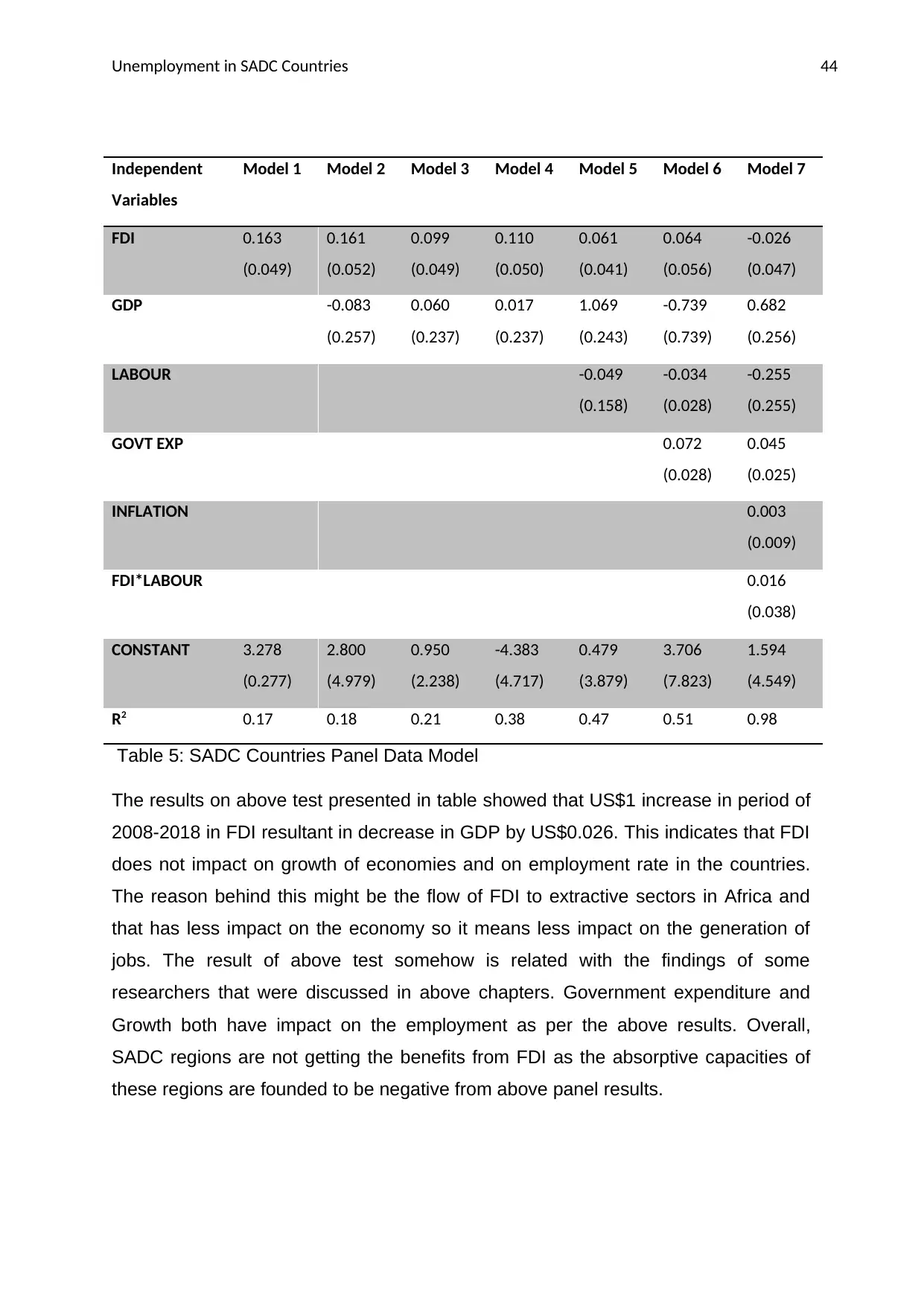
Unemployment in SADC Countries 44
Independent
Variables
Model 1 Model 2 Model 3 Model 4 Model 5 Model 6 Model 7
FDI 0.163
(0.049)
0.161
(0.052)
0.099
(0.049)
0.110
(0.050)
0.061
(0.041)
0.064
(0.056)
-0.026
(0.047)
GDP -0.083
(0.257)
0.060
(0.237)
0.017
(0.237)
1.069
(0.243)
-0.739
(0.739)
0.682
(0.256)
LABOUR -0.049
(0.158)
-0.034
(0.028)
-0.255
(0.255)
GOVT EXP 0.072
(0.028)
0.045
(0.025)
INFLATION 0.003
(0.009)
FDI*LABOUR 0.016
(0.038)
CONSTANT 3.278
(0.277)
2.800
(4.979)
0.950
(2.238)
-4.383
(4.717)
0.479
(3.879)
3.706
(7.823)
1.594
(4.549)
R2 0.17 0.18 0.21 0.38 0.47 0.51 0.98
Table 5: SADC Countries Panel Data Model
The results on above test presented in table showed that US$1 increase in period of
2008-2018 in FDI resultant in decrease in GDP by US$0.026. This indicates that FDI
does not impact on growth of economies and on employment rate in the countries.
The reason behind this might be the flow of FDI to extractive sectors in Africa and
that has less impact on the economy so it means less impact on the generation of
jobs. The result of above test somehow is related with the findings of some
researchers that were discussed in above chapters. Government expenditure and
Growth both have impact on the employment as per the above results. Overall,
SADC regions are not getting the benefits from FDI as the absorptive capacities of
these regions are founded to be negative from above panel results.
Independent
Variables
Model 1 Model 2 Model 3 Model 4 Model 5 Model 6 Model 7
FDI 0.163
(0.049)
0.161
(0.052)
0.099
(0.049)
0.110
(0.050)
0.061
(0.041)
0.064
(0.056)
-0.026
(0.047)
GDP -0.083
(0.257)
0.060
(0.237)
0.017
(0.237)
1.069
(0.243)
-0.739
(0.739)
0.682
(0.256)
LABOUR -0.049
(0.158)
-0.034
(0.028)
-0.255
(0.255)
GOVT EXP 0.072
(0.028)
0.045
(0.025)
INFLATION 0.003
(0.009)
FDI*LABOUR 0.016
(0.038)
CONSTANT 3.278
(0.277)
2.800
(4.979)
0.950
(2.238)
-4.383
(4.717)
0.479
(3.879)
3.706
(7.823)
1.594
(4.549)
R2 0.17 0.18 0.21 0.38 0.47 0.51 0.98
Table 5: SADC Countries Panel Data Model
The results on above test presented in table showed that US$1 increase in period of
2008-2018 in FDI resultant in decrease in GDP by US$0.026. This indicates that FDI
does not impact on growth of economies and on employment rate in the countries.
The reason behind this might be the flow of FDI to extractive sectors in Africa and
that has less impact on the economy so it means less impact on the generation of
jobs. The result of above test somehow is related with the findings of some
researchers that were discussed in above chapters. Government expenditure and
Growth both have impact on the employment as per the above results. Overall,
SADC regions are not getting the benefits from FDI as the absorptive capacities of
these regions are founded to be negative from above panel results.
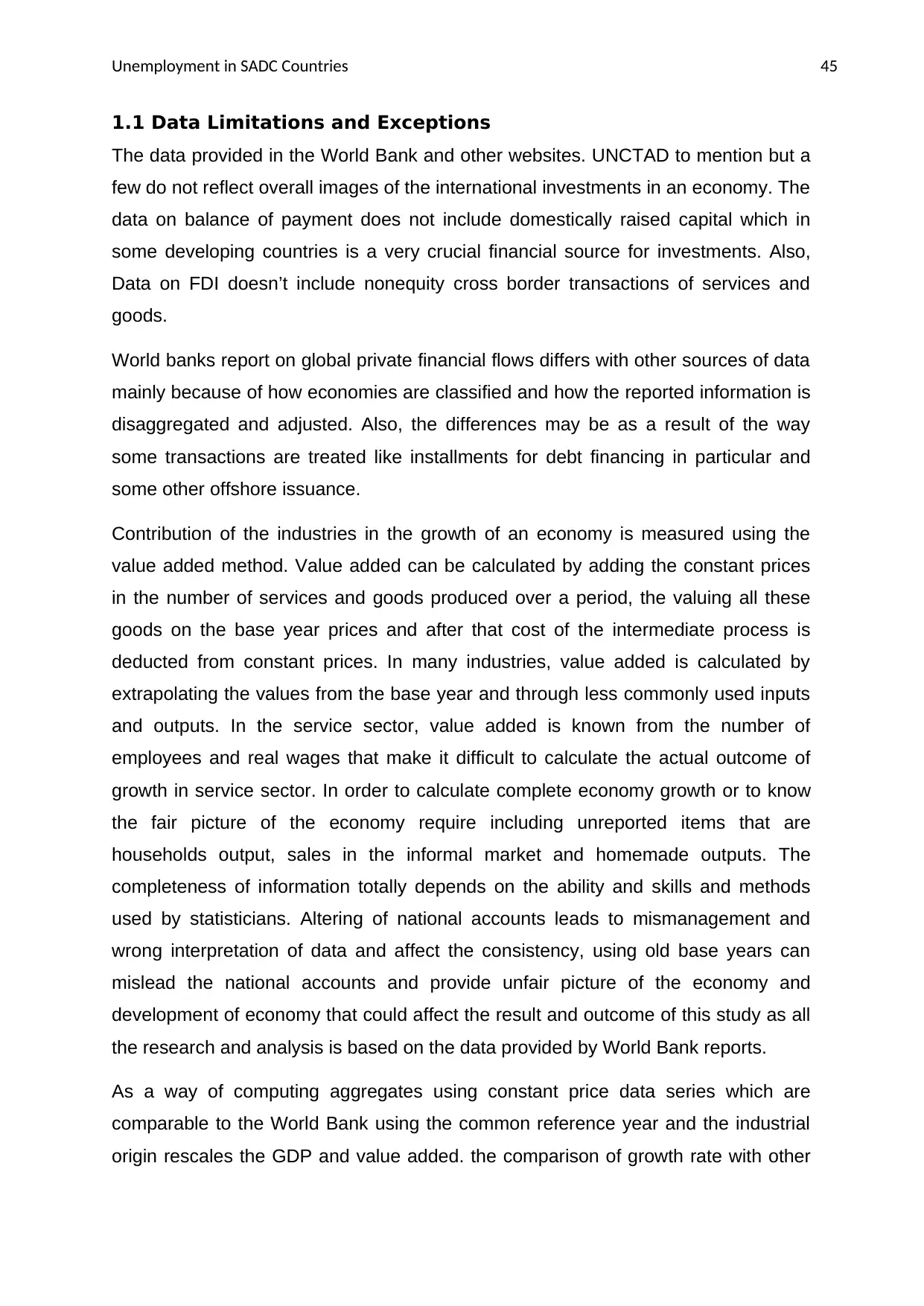
Unemployment in SADC Countries 45
1.1 Data Limitations and Exceptions
The data provided in the World Bank and other websites. UNCTAD to mention but a
few do not reflect overall images of the international investments in an economy. The
data on balance of payment does not include domestically raised capital which in
some developing countries is a very crucial financial source for investments. Also,
Data on FDI doesn’t include nonequity cross border transactions of services and
goods.
World banks report on global private financial flows differs with other sources of data
mainly because of how economies are classified and how the reported information is
disaggregated and adjusted. Also, the differences may be as a result of the way
some transactions are treated like installments for debt financing in particular and
some other offshore issuance.
Contribution of the industries in the growth of an economy is measured using the
value added method. Value added can be calculated by adding the constant prices
in the number of services and goods produced over a period, the valuing all these
goods on the base year prices and after that cost of the intermediate process is
deducted from constant prices. In many industries, value added is calculated by
extrapolating the values from the base year and through less commonly used inputs
and outputs. In the service sector, value added is known from the number of
employees and real wages that make it difficult to calculate the actual outcome of
growth in service sector. In order to calculate complete economy growth or to know
the fair picture of the economy require including unreported items that are
households output, sales in the informal market and homemade outputs. The
completeness of information totally depends on the ability and skills and methods
used by statisticians. Altering of national accounts leads to mismanagement and
wrong interpretation of data and affect the consistency, using old base years can
mislead the national accounts and provide unfair picture of the economy and
development of economy that could affect the result and outcome of this study as all
the research and analysis is based on the data provided by World Bank reports.
As a way of computing aggregates using constant price data series which are
comparable to the World Bank using the common reference year and the industrial
origin rescales the GDP and value added. the comparison of growth rate with other
1.1 Data Limitations and Exceptions
The data provided in the World Bank and other websites. UNCTAD to mention but a
few do not reflect overall images of the international investments in an economy. The
data on balance of payment does not include domestically raised capital which in
some developing countries is a very crucial financial source for investments. Also,
Data on FDI doesn’t include nonequity cross border transactions of services and
goods.
World banks report on global private financial flows differs with other sources of data
mainly because of how economies are classified and how the reported information is
disaggregated and adjusted. Also, the differences may be as a result of the way
some transactions are treated like installments for debt financing in particular and
some other offshore issuance.
Contribution of the industries in the growth of an economy is measured using the
value added method. Value added can be calculated by adding the constant prices
in the number of services and goods produced over a period, the valuing all these
goods on the base year prices and after that cost of the intermediate process is
deducted from constant prices. In many industries, value added is calculated by
extrapolating the values from the base year and through less commonly used inputs
and outputs. In the service sector, value added is known from the number of
employees and real wages that make it difficult to calculate the actual outcome of
growth in service sector. In order to calculate complete economy growth or to know
the fair picture of the economy require including unreported items that are
households output, sales in the informal market and homemade outputs. The
completeness of information totally depends on the ability and skills and methods
used by statisticians. Altering of national accounts leads to mismanagement and
wrong interpretation of data and affect the consistency, using old base years can
mislead the national accounts and provide unfair picture of the economy and
development of economy that could affect the result and outcome of this study as all
the research and analysis is based on the data provided by World Bank reports.
As a way of computing aggregates using constant price data series which are
comparable to the World Bank using the common reference year and the industrial
origin rescales the GDP and value added. the comparison of growth rate with other
Secure Best Marks with AI Grader
Need help grading? Try our AI Grader for instant feedback on your assignments.
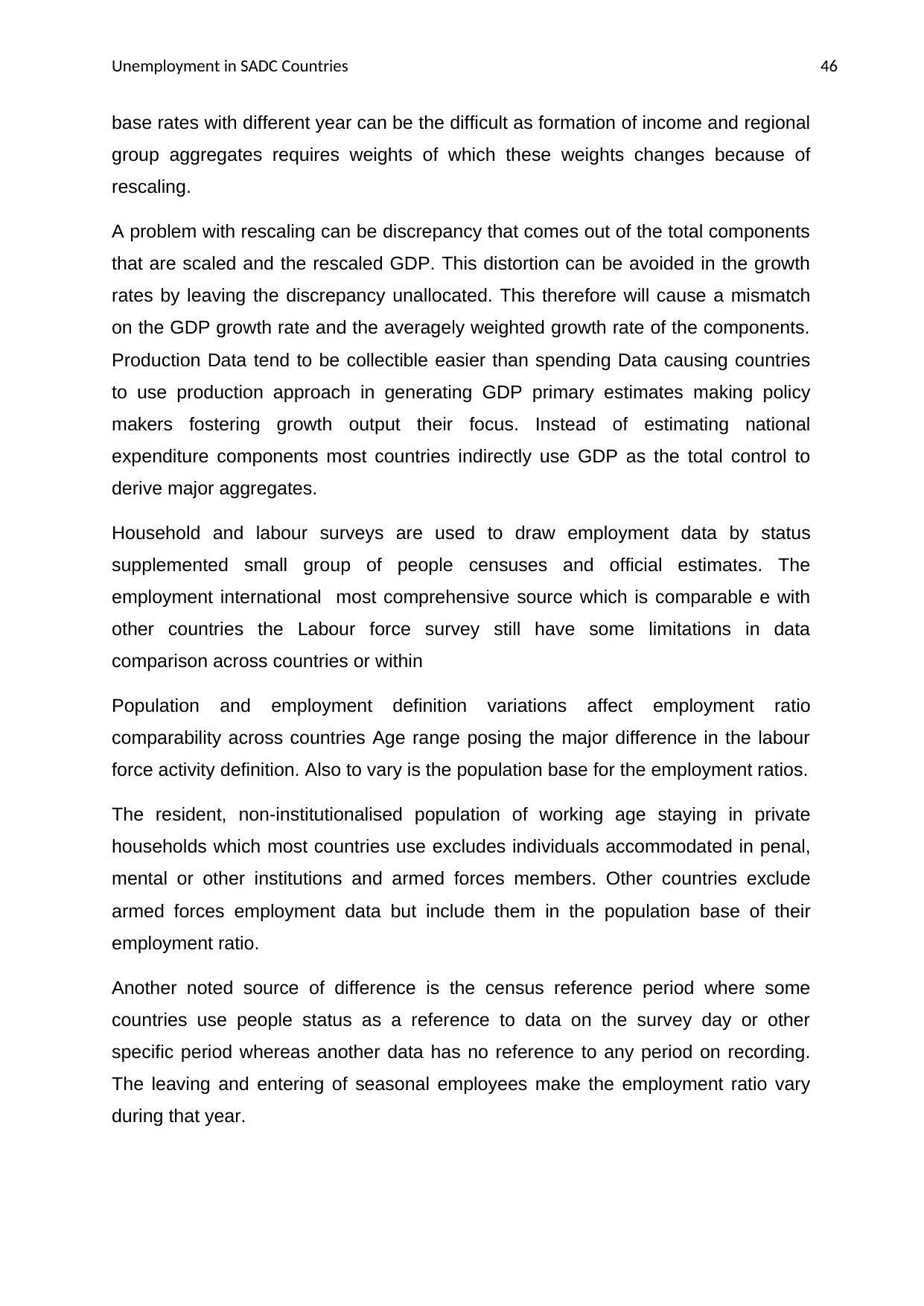
Unemployment in SADC Countries 46
base rates with different year can be the difficult as formation of income and regional
group aggregates requires weights of which these weights changes because of
rescaling.
A problem with rescaling can be discrepancy that comes out of the total components
that are scaled and the rescaled GDP. This distortion can be avoided in the growth
rates by leaving the discrepancy unallocated. This therefore will cause a mismatch
on the GDP growth rate and the averagely weighted growth rate of the components.
Production Data tend to be collectible easier than spending Data causing countries
to use production approach in generating GDP primary estimates making policy
makers fostering growth output their focus. Instead of estimating national
expenditure components most countries indirectly use GDP as the total control to
derive major aggregates.
Household and labour surveys are used to draw employment data by status
supplemented small group of people censuses and official estimates. The
employment international most comprehensive source which is comparable e with
other countries the Labour force survey still have some limitations in data
comparison across countries or within
Population and employment definition variations affect employment ratio
comparability across countries Age range posing the major difference in the labour
force activity definition. Also to vary is the population base for the employment ratios.
The resident, non-institutionalised population of working age staying in private
households which most countries use excludes individuals accommodated in penal,
mental or other institutions and armed forces members. Other countries exclude
armed forces employment data but include them in the population base of their
employment ratio.
Another noted source of difference is the census reference period where some
countries use people status as a reference to data on the survey day or other
specific period whereas another data has no reference to any period on recording.
The leaving and entering of seasonal employees make the employment ratio vary
during that year.
base rates with different year can be the difficult as formation of income and regional
group aggregates requires weights of which these weights changes because of
rescaling.
A problem with rescaling can be discrepancy that comes out of the total components
that are scaled and the rescaled GDP. This distortion can be avoided in the growth
rates by leaving the discrepancy unallocated. This therefore will cause a mismatch
on the GDP growth rate and the averagely weighted growth rate of the components.
Production Data tend to be collectible easier than spending Data causing countries
to use production approach in generating GDP primary estimates making policy
makers fostering growth output their focus. Instead of estimating national
expenditure components most countries indirectly use GDP as the total control to
derive major aggregates.
Household and labour surveys are used to draw employment data by status
supplemented small group of people censuses and official estimates. The
employment international most comprehensive source which is comparable e with
other countries the Labour force survey still have some limitations in data
comparison across countries or within
Population and employment definition variations affect employment ratio
comparability across countries Age range posing the major difference in the labour
force activity definition. Also to vary is the population base for the employment ratios.
The resident, non-institutionalised population of working age staying in private
households which most countries use excludes individuals accommodated in penal,
mental or other institutions and armed forces members. Other countries exclude
armed forces employment data but include them in the population base of their
employment ratio.
Another noted source of difference is the census reference period where some
countries use people status as a reference to data on the survey day or other
specific period whereas another data has no reference to any period on recording.
The leaving and entering of seasonal employees make the employment ratio vary
during that year.
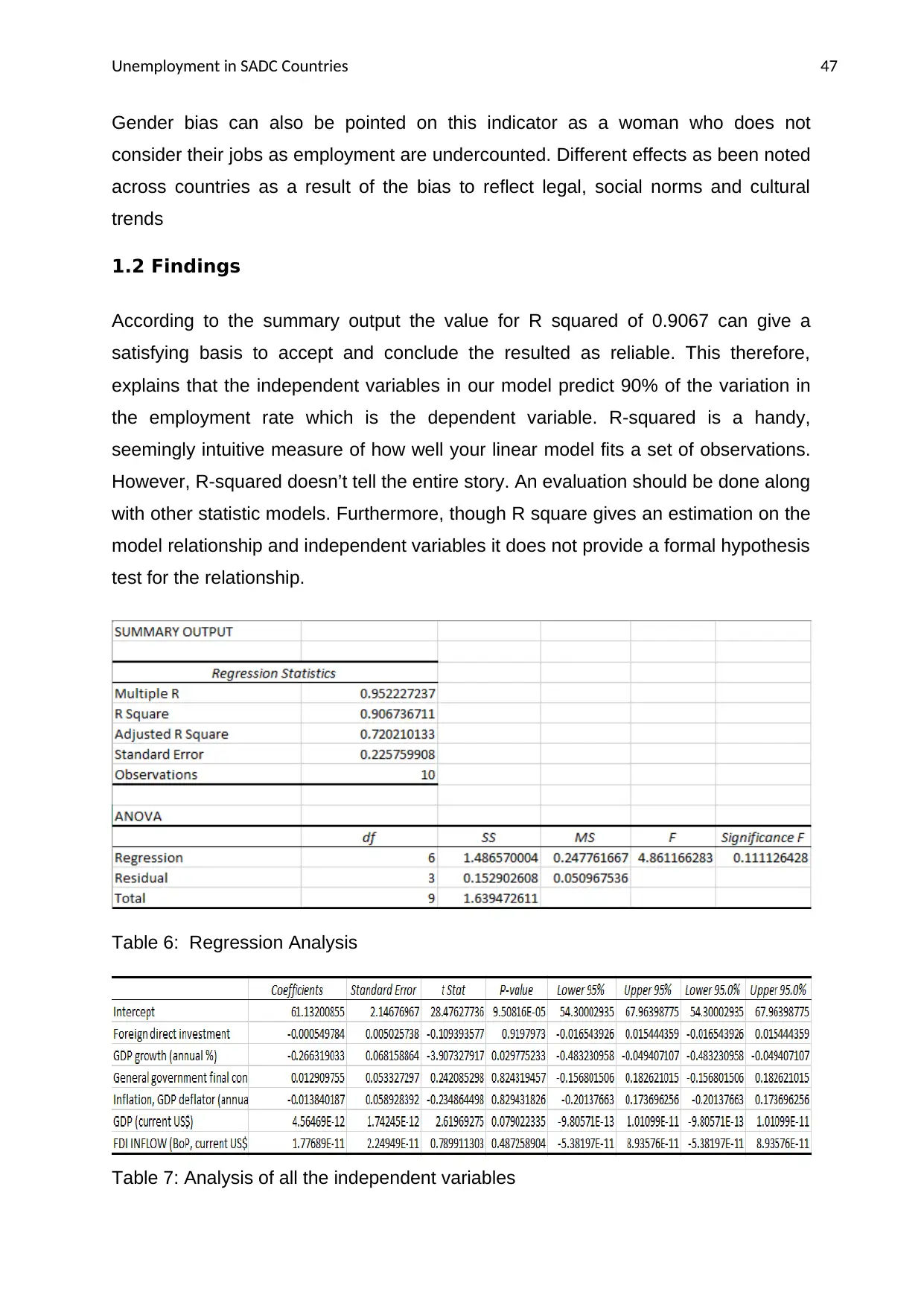
Unemployment in SADC Countries 47
Gender bias can also be pointed on this indicator as a woman who does not
consider their jobs as employment are undercounted. Different effects as been noted
across countries as a result of the bias to reflect legal, social norms and cultural
trends
1.2 Findings
According to the summary output the value for R squared of 0.9067 can give a
satisfying basis to accept and conclude the resulted as reliable. This therefore,
explains that the independent variables in our model predict 90% of the variation in
the employment rate which is the dependent variable. R-squared is a handy,
seemingly intuitive measure of how well your linear model fits a set of observations.
However, R-squared doesn’t tell the entire story. An evaluation should be done along
with other statistic models. Furthermore, though R square gives an estimation on the
model relationship and independent variables it does not provide a formal hypothesis
test for the relationship.
Table 6: Regression Analysis
Table 7: Analysis of all the independent variables
Gender bias can also be pointed on this indicator as a woman who does not
consider their jobs as employment are undercounted. Different effects as been noted
across countries as a result of the bias to reflect legal, social norms and cultural
trends
1.2 Findings
According to the summary output the value for R squared of 0.9067 can give a
satisfying basis to accept and conclude the resulted as reliable. This therefore,
explains that the independent variables in our model predict 90% of the variation in
the employment rate which is the dependent variable. R-squared is a handy,
seemingly intuitive measure of how well your linear model fits a set of observations.
However, R-squared doesn’t tell the entire story. An evaluation should be done along
with other statistic models. Furthermore, though R square gives an estimation on the
model relationship and independent variables it does not provide a formal hypothesis
test for the relationship.
Table 6: Regression Analysis
Table 7: Analysis of all the independent variables
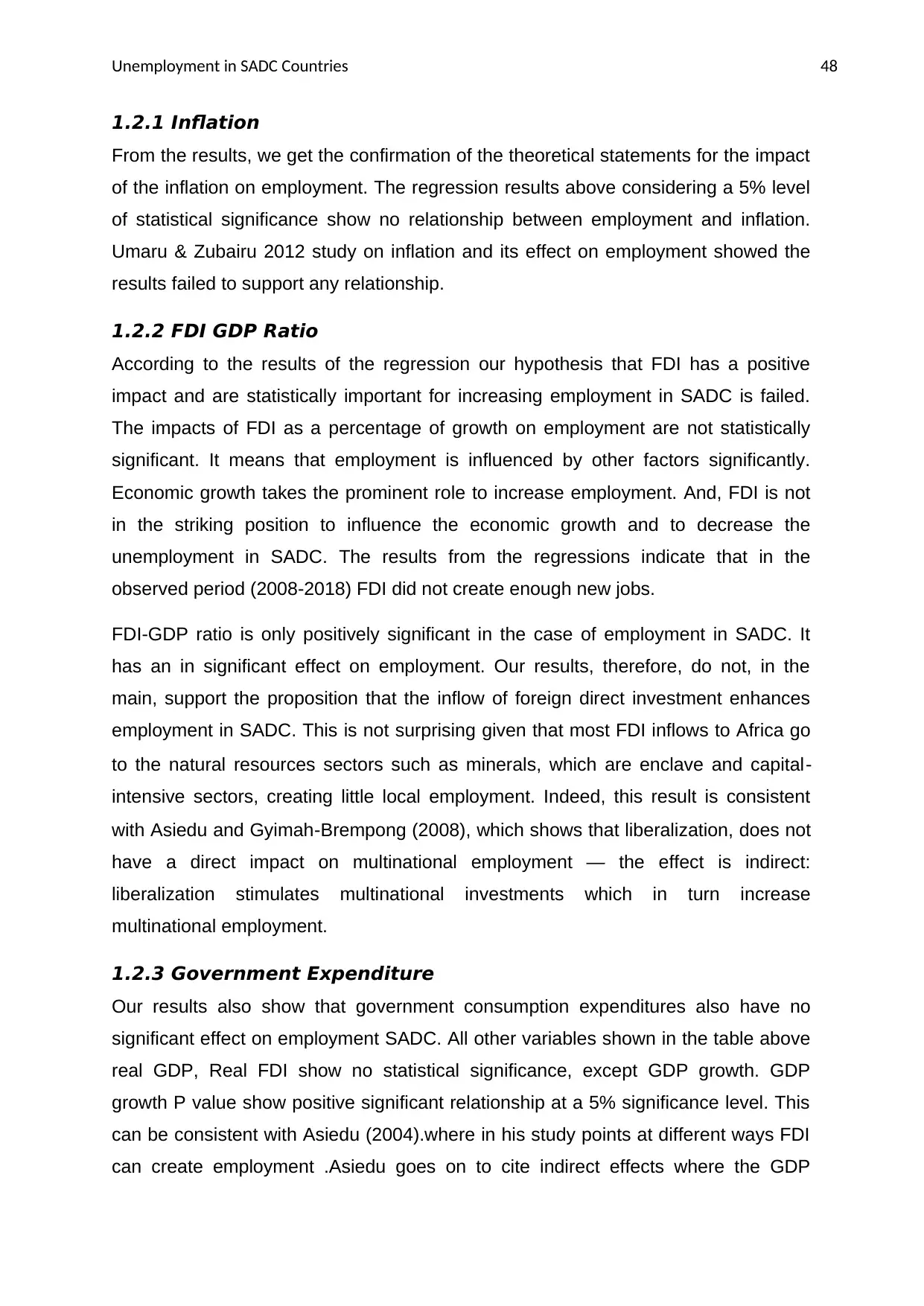
Unemployment in SADC Countries 48
1.2.1 Inflation
From the results, we get the confirmation of the theoretical statements for the impact
of the inflation on employment. The regression results above considering a 5% level
of statistical significance show no relationship between employment and inflation.
Umaru & Zubairu 2012 study on inflation and its effect on employment showed the
results failed to support any relationship.
1.2.2 FDI GDP Ratio
According to the results of the regression our hypothesis that FDI has a positive
impact and are statistically important for increasing employment in SADC is failed.
The impacts of FDI as a percentage of growth on employment are not statistically
significant. It means that employment is influenced by other factors significantly.
Economic growth takes the prominent role to increase employment. And, FDI is not
in the striking position to influence the economic growth and to decrease the
unemployment in SADC. The results from the regressions indicate that in the
observed period (2008-2018) FDI did not create enough new jobs.
FDI‐GDP ratio is only positively significant in the case of employment in SADC. It
has an in significant effect on employment. Our results, therefore, do not, in the
main, support the proposition that the inflow of foreign direct investment enhances
employment in SADC. This is not surprising given that most FDI inflows to Africa go
to the natural resources sectors such as minerals, which are enclave and capital‐
intensive sectors, creating little local employment. Indeed, this result is consistent
with Asiedu and Gyimah‐Brempong (2008), which shows that liberalization, does not
have a direct impact on multinational employment — the effect is indirect:
liberalization stimulates multinational investments which in turn increase
multinational employment.
1.2.3 Government Expenditure
Our results also show that government consumption expenditures also have no
significant effect on employment SADC. All other variables shown in the table above
real GDP, Real FDI show no statistical significance, except GDP growth. GDP
growth P value show positive significant relationship at a 5% significance level. This
can be consistent with Asiedu (2004).where in his study points at different ways FDI
can create employment .Asiedu goes on to cite indirect effects where the GDP
1.2.1 Inflation
From the results, we get the confirmation of the theoretical statements for the impact
of the inflation on employment. The regression results above considering a 5% level
of statistical significance show no relationship between employment and inflation.
Umaru & Zubairu 2012 study on inflation and its effect on employment showed the
results failed to support any relationship.
1.2.2 FDI GDP Ratio
According to the results of the regression our hypothesis that FDI has a positive
impact and are statistically important for increasing employment in SADC is failed.
The impacts of FDI as a percentage of growth on employment are not statistically
significant. It means that employment is influenced by other factors significantly.
Economic growth takes the prominent role to increase employment. And, FDI is not
in the striking position to influence the economic growth and to decrease the
unemployment in SADC. The results from the regressions indicate that in the
observed period (2008-2018) FDI did not create enough new jobs.
FDI‐GDP ratio is only positively significant in the case of employment in SADC. It
has an in significant effect on employment. Our results, therefore, do not, in the
main, support the proposition that the inflow of foreign direct investment enhances
employment in SADC. This is not surprising given that most FDI inflows to Africa go
to the natural resources sectors such as minerals, which are enclave and capital‐
intensive sectors, creating little local employment. Indeed, this result is consistent
with Asiedu and Gyimah‐Brempong (2008), which shows that liberalization, does not
have a direct impact on multinational employment — the effect is indirect:
liberalization stimulates multinational investments which in turn increase
multinational employment.
1.2.3 Government Expenditure
Our results also show that government consumption expenditures also have no
significant effect on employment SADC. All other variables shown in the table above
real GDP, Real FDI show no statistical significance, except GDP growth. GDP
growth P value show positive significant relationship at a 5% significance level. This
can be consistent with Asiedu (2004).where in his study points at different ways FDI
can create employment .Asiedu goes on to cite indirect effects where the GDP
Paraphrase This Document
Need a fresh take? Get an instant paraphrase of this document with our AI Paraphraser
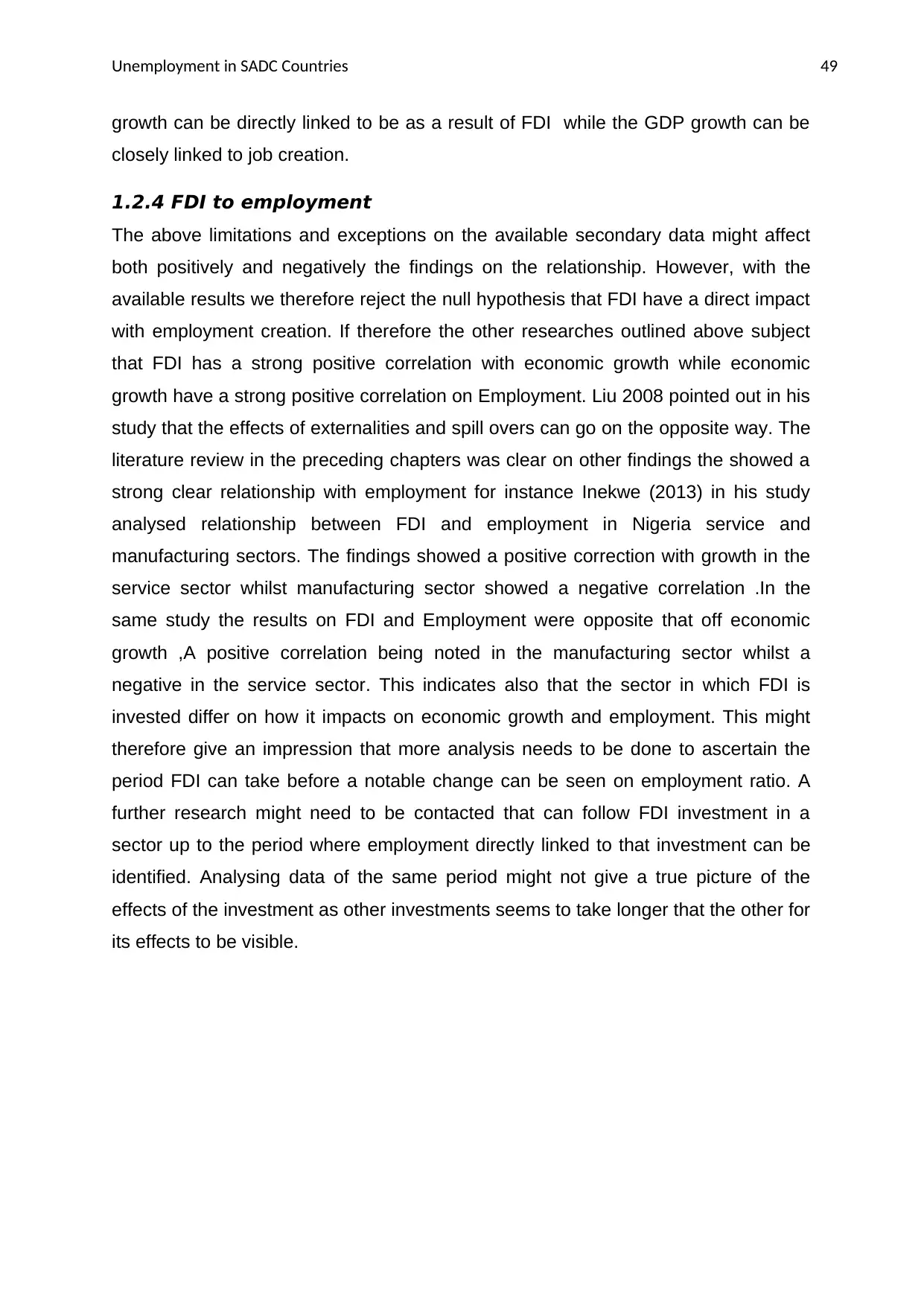
Unemployment in SADC Countries 49
growth can be directly linked to be as a result of FDI while the GDP growth can be
closely linked to job creation.
1.2.4 FDI to employment
The above limitations and exceptions on the available secondary data might affect
both positively and negatively the findings on the relationship. However, with the
available results we therefore reject the null hypothesis that FDI have a direct impact
with employment creation. If therefore the other researches outlined above subject
that FDI has a strong positive correlation with economic growth while economic
growth have a strong positive correlation on Employment. Liu 2008 pointed out in his
study that the effects of externalities and spill overs can go on the opposite way. The
literature review in the preceding chapters was clear on other findings the showed a
strong clear relationship with employment for instance Inekwe (2013) in his study
analysed relationship between FDI and employment in Nigeria service and
manufacturing sectors. The findings showed a positive correction with growth in the
service sector whilst manufacturing sector showed a negative correlation .In the
same study the results on FDI and Employment were opposite that off economic
growth ,A positive correlation being noted in the manufacturing sector whilst a
negative in the service sector. This indicates also that the sector in which FDI is
invested differ on how it impacts on economic growth and employment. This might
therefore give an impression that more analysis needs to be done to ascertain the
period FDI can take before a notable change can be seen on employment ratio. A
further research might need to be contacted that can follow FDI investment in a
sector up to the period where employment directly linked to that investment can be
identified. Analysing data of the same period might not give a true picture of the
effects of the investment as other investments seems to take longer that the other for
its effects to be visible.
growth can be directly linked to be as a result of FDI while the GDP growth can be
closely linked to job creation.
1.2.4 FDI to employment
The above limitations and exceptions on the available secondary data might affect
both positively and negatively the findings on the relationship. However, with the
available results we therefore reject the null hypothesis that FDI have a direct impact
with employment creation. If therefore the other researches outlined above subject
that FDI has a strong positive correlation with economic growth while economic
growth have a strong positive correlation on Employment. Liu 2008 pointed out in his
study that the effects of externalities and spill overs can go on the opposite way. The
literature review in the preceding chapters was clear on other findings the showed a
strong clear relationship with employment for instance Inekwe (2013) in his study
analysed relationship between FDI and employment in Nigeria service and
manufacturing sectors. The findings showed a positive correction with growth in the
service sector whilst manufacturing sector showed a negative correlation .In the
same study the results on FDI and Employment were opposite that off economic
growth ,A positive correlation being noted in the manufacturing sector whilst a
negative in the service sector. This indicates also that the sector in which FDI is
invested differ on how it impacts on economic growth and employment. This might
therefore give an impression that more analysis needs to be done to ascertain the
period FDI can take before a notable change can be seen on employment ratio. A
further research might need to be contacted that can follow FDI investment in a
sector up to the period where employment directly linked to that investment can be
identified. Analysing data of the same period might not give a true picture of the
effects of the investment as other investments seems to take longer that the other for
its effects to be visible.
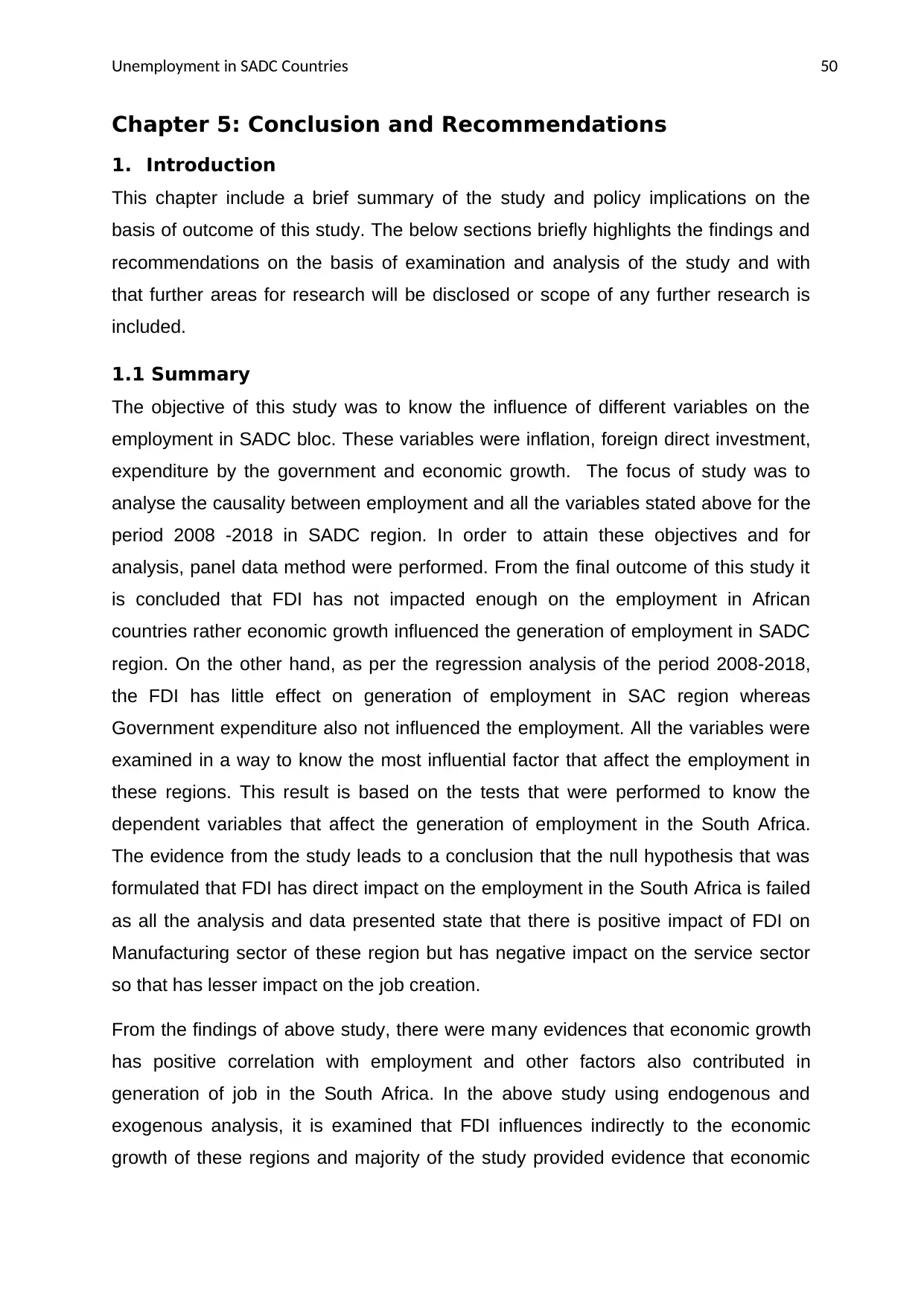
Unemployment in SADC Countries 50
Chapter 5: Conclusion and Recommendations
1. Introduction
This chapter include a brief summary of the study and policy implications on the
basis of outcome of this study. The below sections briefly highlights the findings and
recommendations on the basis of examination and analysis of the study and with
that further areas for research will be disclosed or scope of any further research is
included.
1.1 Summary
The objective of this study was to know the influence of different variables on the
employment in SADC bloc. These variables were inflation, foreign direct investment,
expenditure by the government and economic growth. The focus of study was to
analyse the causality between employment and all the variables stated above for the
period 2008 -2018 in SADC region. In order to attain these objectives and for
analysis, panel data method were performed. From the final outcome of this study it
is concluded that FDI has not impacted enough on the employment in African
countries rather economic growth influenced the generation of employment in SADC
region. On the other hand, as per the regression analysis of the period 2008-2018,
the FDI has little effect on generation of employment in SAC region whereas
Government expenditure also not influenced the employment. All the variables were
examined in a way to know the most influential factor that affect the employment in
these regions. This result is based on the tests that were performed to know the
dependent variables that affect the generation of employment in the South Africa.
The evidence from the study leads to a conclusion that the null hypothesis that was
formulated that FDI has direct impact on the employment in the South Africa is failed
as all the analysis and data presented state that there is positive impact of FDI on
Manufacturing sector of these region but has negative impact on the service sector
so that has lesser impact on the job creation.
From the findings of above study, there were many evidences that economic growth
has positive correlation with employment and other factors also contributed in
generation of job in the South Africa. In the above study using endogenous and
exogenous analysis, it is examined that FDI influences indirectly to the economic
growth of these regions and majority of the study provided evidence that economic
Chapter 5: Conclusion and Recommendations
1. Introduction
This chapter include a brief summary of the study and policy implications on the
basis of outcome of this study. The below sections briefly highlights the findings and
recommendations on the basis of examination and analysis of the study and with
that further areas for research will be disclosed or scope of any further research is
included.
1.1 Summary
The objective of this study was to know the influence of different variables on the
employment in SADC bloc. These variables were inflation, foreign direct investment,
expenditure by the government and economic growth. The focus of study was to
analyse the causality between employment and all the variables stated above for the
period 2008 -2018 in SADC region. In order to attain these objectives and for
analysis, panel data method were performed. From the final outcome of this study it
is concluded that FDI has not impacted enough on the employment in African
countries rather economic growth influenced the generation of employment in SADC
region. On the other hand, as per the regression analysis of the period 2008-2018,
the FDI has little effect on generation of employment in SAC region whereas
Government expenditure also not influenced the employment. All the variables were
examined in a way to know the most influential factor that affect the employment in
these regions. This result is based on the tests that were performed to know the
dependent variables that affect the generation of employment in the South Africa.
The evidence from the study leads to a conclusion that the null hypothesis that was
formulated that FDI has direct impact on the employment in the South Africa is failed
as all the analysis and data presented state that there is positive impact of FDI on
Manufacturing sector of these region but has negative impact on the service sector
so that has lesser impact on the job creation.
From the findings of above study, there were many evidences that economic growth
has positive correlation with employment and other factors also contributed in
generation of job in the South Africa. In the above study using endogenous and
exogenous analysis, it is examined that FDI influences indirectly to the economic
growth of these regions and majority of the study provided evidence that economic
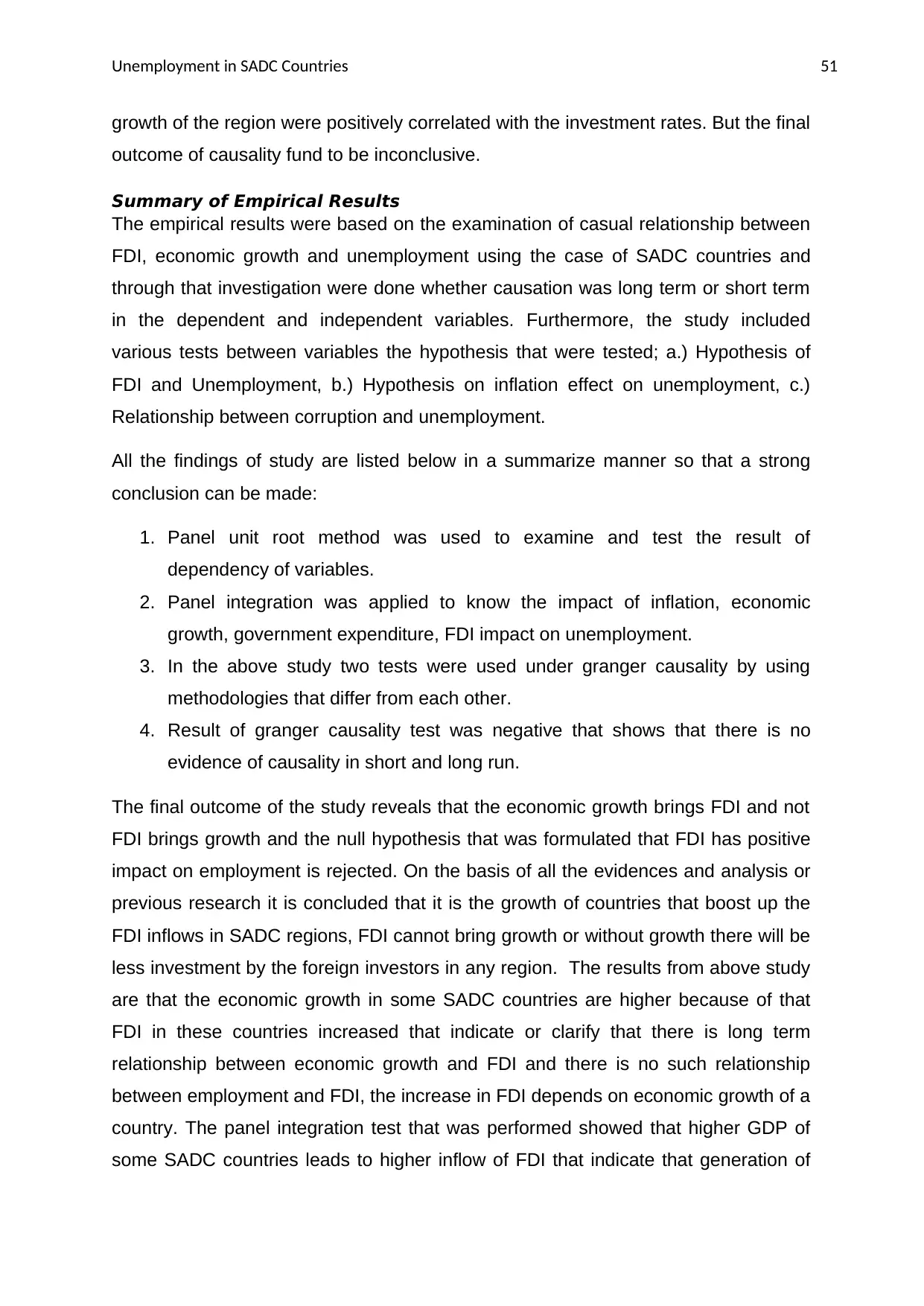
Unemployment in SADC Countries 51
growth of the region were positively correlated with the investment rates. But the final
outcome of causality fund to be inconclusive.
Summary of Empirical Results
The empirical results were based on the examination of casual relationship between
FDI, economic growth and unemployment using the case of SADC countries and
through that investigation were done whether causation was long term or short term
in the dependent and independent variables. Furthermore, the study included
various tests between variables the hypothesis that were tested; a.) Hypothesis of
FDI and Unemployment, b.) Hypothesis on inflation effect on unemployment, c.)
Relationship between corruption and unemployment.
All the findings of study are listed below in a summarize manner so that a strong
conclusion can be made:
1. Panel unit root method was used to examine and test the result of
dependency of variables.
2. Panel integration was applied to know the impact of inflation, economic
growth, government expenditure, FDI impact on unemployment.
3. In the above study two tests were used under granger causality by using
methodologies that differ from each other.
4. Result of granger causality test was negative that shows that there is no
evidence of causality in short and long run.
The final outcome of the study reveals that the economic growth brings FDI and not
FDI brings growth and the null hypothesis that was formulated that FDI has positive
impact on employment is rejected. On the basis of all the evidences and analysis or
previous research it is concluded that it is the growth of countries that boost up the
FDI inflows in SADC regions, FDI cannot bring growth or without growth there will be
less investment by the foreign investors in any region. The results from above study
are that the economic growth in some SADC countries are higher because of that
FDI in these countries increased that indicate or clarify that there is long term
relationship between economic growth and FDI and there is no such relationship
between employment and FDI, the increase in FDI depends on economic growth of a
country. The panel integration test that was performed showed that higher GDP of
some SADC countries leads to higher inflow of FDI that indicate that generation of
growth of the region were positively correlated with the investment rates. But the final
outcome of causality fund to be inconclusive.
Summary of Empirical Results
The empirical results were based on the examination of casual relationship between
FDI, economic growth and unemployment using the case of SADC countries and
through that investigation were done whether causation was long term or short term
in the dependent and independent variables. Furthermore, the study included
various tests between variables the hypothesis that were tested; a.) Hypothesis of
FDI and Unemployment, b.) Hypothesis on inflation effect on unemployment, c.)
Relationship between corruption and unemployment.
All the findings of study are listed below in a summarize manner so that a strong
conclusion can be made:
1. Panel unit root method was used to examine and test the result of
dependency of variables.
2. Panel integration was applied to know the impact of inflation, economic
growth, government expenditure, FDI impact on unemployment.
3. In the above study two tests were used under granger causality by using
methodologies that differ from each other.
4. Result of granger causality test was negative that shows that there is no
evidence of causality in short and long run.
The final outcome of the study reveals that the economic growth brings FDI and not
FDI brings growth and the null hypothesis that was formulated that FDI has positive
impact on employment is rejected. On the basis of all the evidences and analysis or
previous research it is concluded that it is the growth of countries that boost up the
FDI inflows in SADC regions, FDI cannot bring growth or without growth there will be
less investment by the foreign investors in any region. The results from above study
are that the economic growth in some SADC countries are higher because of that
FDI in these countries increased that indicate or clarify that there is long term
relationship between economic growth and FDI and there is no such relationship
between employment and FDI, the increase in FDI depends on economic growth of a
country. The panel integration test that was performed showed that higher GDP of
some SADC countries leads to higher inflow of FDI that indicate that generation of
Secure Best Marks with AI Grader
Need help grading? Try our AI Grader for instant feedback on your assignments.
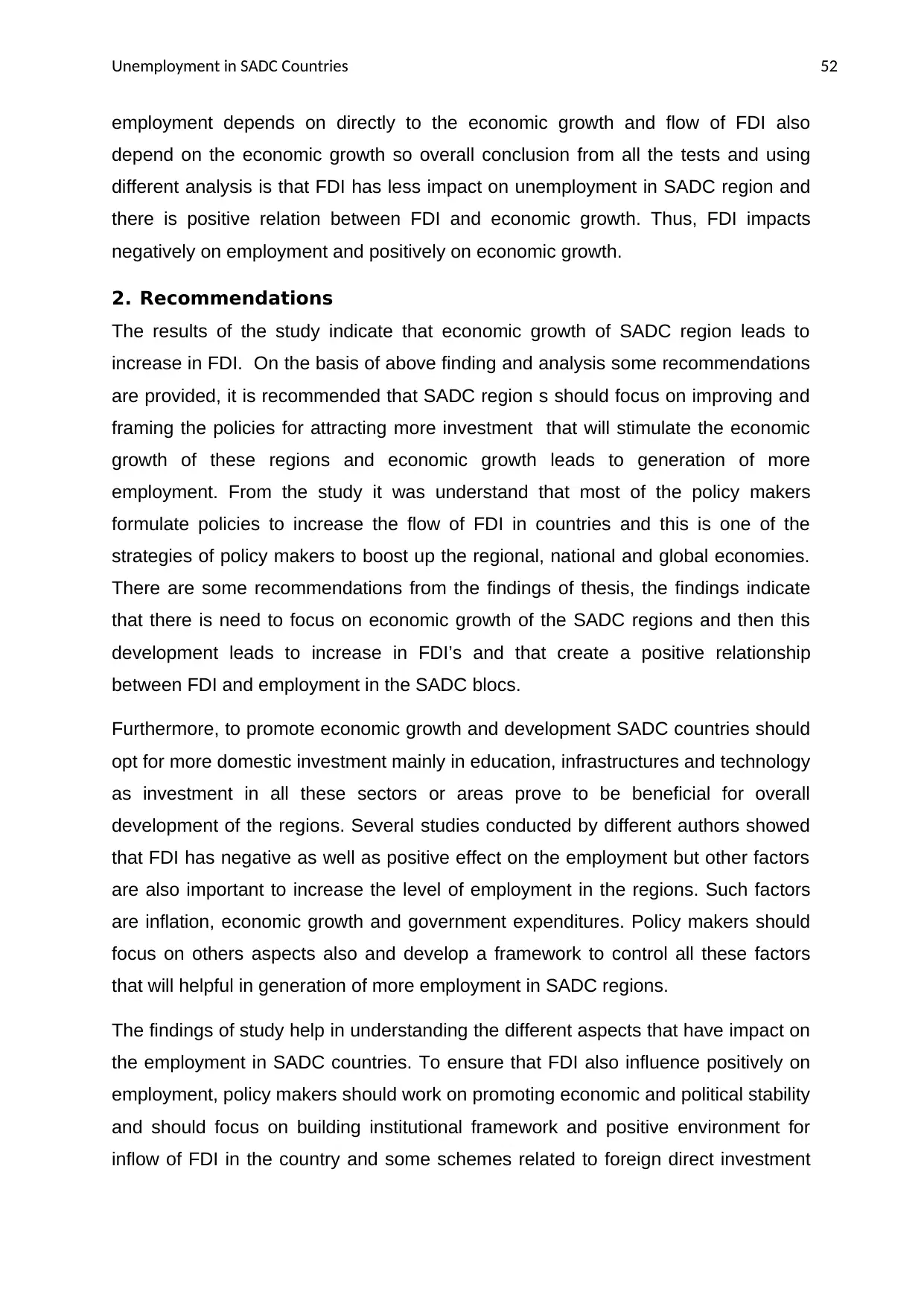
Unemployment in SADC Countries 52
employment depends on directly to the economic growth and flow of FDI also
depend on the economic growth so overall conclusion from all the tests and using
different analysis is that FDI has less impact on unemployment in SADC region and
there is positive relation between FDI and economic growth. Thus, FDI impacts
negatively on employment and positively on economic growth.
2. Recommendations
The results of the study indicate that economic growth of SADC region leads to
increase in FDI. On the basis of above finding and analysis some recommendations
are provided, it is recommended that SADC region s should focus on improving and
framing the policies for attracting more investment that will stimulate the economic
growth of these regions and economic growth leads to generation of more
employment. From the study it was understand that most of the policy makers
formulate policies to increase the flow of FDI in countries and this is one of the
strategies of policy makers to boost up the regional, national and global economies.
There are some recommendations from the findings of thesis, the findings indicate
that there is need to focus on economic growth of the SADC regions and then this
development leads to increase in FDI’s and that create a positive relationship
between FDI and employment in the SADC blocs.
Furthermore, to promote economic growth and development SADC countries should
opt for more domestic investment mainly in education, infrastructures and technology
as investment in all these sectors or areas prove to be beneficial for overall
development of the regions. Several studies conducted by different authors showed
that FDI has negative as well as positive effect on the employment but other factors
are also important to increase the level of employment in the regions. Such factors
are inflation, economic growth and government expenditures. Policy makers should
focus on others aspects also and develop a framework to control all these factors
that will helpful in generation of more employment in SADC regions.
The findings of study help in understanding the different aspects that have impact on
the employment in SADC countries. To ensure that FDI also influence positively on
employment, policy makers should work on promoting economic and political stability
and should focus on building institutional framework and positive environment for
inflow of FDI in the country and some schemes related to foreign direct investment
employment depends on directly to the economic growth and flow of FDI also
depend on the economic growth so overall conclusion from all the tests and using
different analysis is that FDI has less impact on unemployment in SADC region and
there is positive relation between FDI and economic growth. Thus, FDI impacts
negatively on employment and positively on economic growth.
2. Recommendations
The results of the study indicate that economic growth of SADC region leads to
increase in FDI. On the basis of above finding and analysis some recommendations
are provided, it is recommended that SADC region s should focus on improving and
framing the policies for attracting more investment that will stimulate the economic
growth of these regions and economic growth leads to generation of more
employment. From the study it was understand that most of the policy makers
formulate policies to increase the flow of FDI in countries and this is one of the
strategies of policy makers to boost up the regional, national and global economies.
There are some recommendations from the findings of thesis, the findings indicate
that there is need to focus on economic growth of the SADC regions and then this
development leads to increase in FDI’s and that create a positive relationship
between FDI and employment in the SADC blocs.
Furthermore, to promote economic growth and development SADC countries should
opt for more domestic investment mainly in education, infrastructures and technology
as investment in all these sectors or areas prove to be beneficial for overall
development of the regions. Several studies conducted by different authors showed
that FDI has negative as well as positive effect on the employment but other factors
are also important to increase the level of employment in the regions. Such factors
are inflation, economic growth and government expenditures. Policy makers should
focus on others aspects also and develop a framework to control all these factors
that will helpful in generation of more employment in SADC regions.
The findings of study help in understanding the different aspects that have impact on
the employment in SADC countries. To ensure that FDI also influence positively on
employment, policy makers should work on promoting economic and political stability
and should focus on building institutional framework and positive environment for
inflow of FDI in the country and some schemes related to foreign direct investment
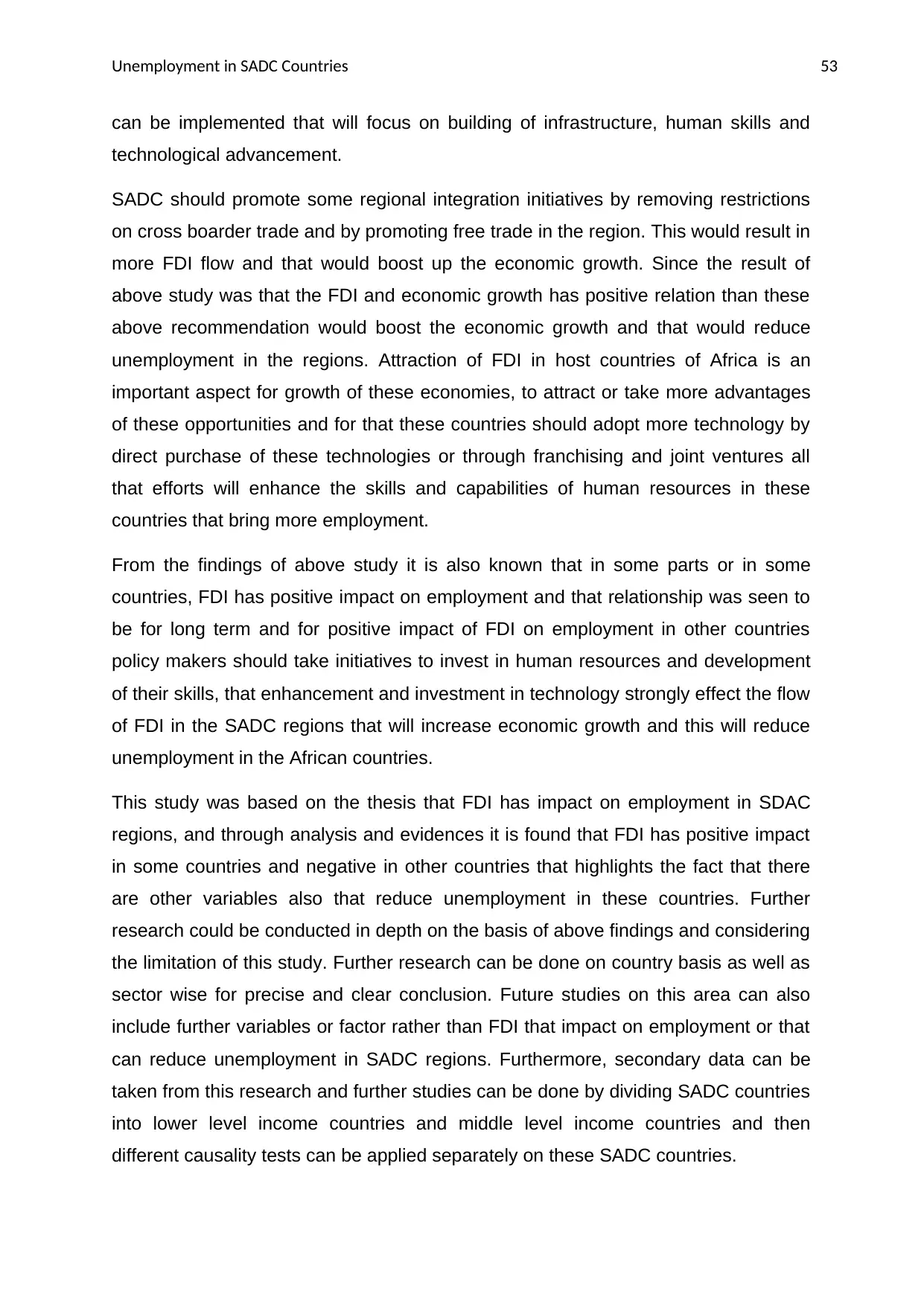
Unemployment in SADC Countries 53
can be implemented that will focus on building of infrastructure, human skills and
technological advancement.
SADC should promote some regional integration initiatives by removing restrictions
on cross boarder trade and by promoting free trade in the region. This would result in
more FDI flow and that would boost up the economic growth. Since the result of
above study was that the FDI and economic growth has positive relation than these
above recommendation would boost the economic growth and that would reduce
unemployment in the regions. Attraction of FDI in host countries of Africa is an
important aspect for growth of these economies, to attract or take more advantages
of these opportunities and for that these countries should adopt more technology by
direct purchase of these technologies or through franchising and joint ventures all
that efforts will enhance the skills and capabilities of human resources in these
countries that bring more employment.
From the findings of above study it is also known that in some parts or in some
countries, FDI has positive impact on employment and that relationship was seen to
be for long term and for positive impact of FDI on employment in other countries
policy makers should take initiatives to invest in human resources and development
of their skills, that enhancement and investment in technology strongly effect the flow
of FDI in the SADC regions that will increase economic growth and this will reduce
unemployment in the African countries.
This study was based on the thesis that FDI has impact on employment in SDAC
regions, and through analysis and evidences it is found that FDI has positive impact
in some countries and negative in other countries that highlights the fact that there
are other variables also that reduce unemployment in these countries. Further
research could be conducted in depth on the basis of above findings and considering
the limitation of this study. Further research can be done on country basis as well as
sector wise for precise and clear conclusion. Future studies on this area can also
include further variables or factor rather than FDI that impact on employment or that
can reduce unemployment in SADC regions. Furthermore, secondary data can be
taken from this research and further studies can be done by dividing SADC countries
into lower level income countries and middle level income countries and then
different causality tests can be applied separately on these SADC countries.
can be implemented that will focus on building of infrastructure, human skills and
technological advancement.
SADC should promote some regional integration initiatives by removing restrictions
on cross boarder trade and by promoting free trade in the region. This would result in
more FDI flow and that would boost up the economic growth. Since the result of
above study was that the FDI and economic growth has positive relation than these
above recommendation would boost the economic growth and that would reduce
unemployment in the regions. Attraction of FDI in host countries of Africa is an
important aspect for growth of these economies, to attract or take more advantages
of these opportunities and for that these countries should adopt more technology by
direct purchase of these technologies or through franchising and joint ventures all
that efforts will enhance the skills and capabilities of human resources in these
countries that bring more employment.
From the findings of above study it is also known that in some parts or in some
countries, FDI has positive impact on employment and that relationship was seen to
be for long term and for positive impact of FDI on employment in other countries
policy makers should take initiatives to invest in human resources and development
of their skills, that enhancement and investment in technology strongly effect the flow
of FDI in the SADC regions that will increase economic growth and this will reduce
unemployment in the African countries.
This study was based on the thesis that FDI has impact on employment in SDAC
regions, and through analysis and evidences it is found that FDI has positive impact
in some countries and negative in other countries that highlights the fact that there
are other variables also that reduce unemployment in these countries. Further
research could be conducted in depth on the basis of above findings and considering
the limitation of this study. Further research can be done on country basis as well as
sector wise for precise and clear conclusion. Future studies on this area can also
include further variables or factor rather than FDI that impact on employment or that
can reduce unemployment in SADC regions. Furthermore, secondary data can be
taken from this research and further studies can be done by dividing SADC countries
into lower level income countries and middle level income countries and then
different causality tests can be applied separately on these SADC countries.
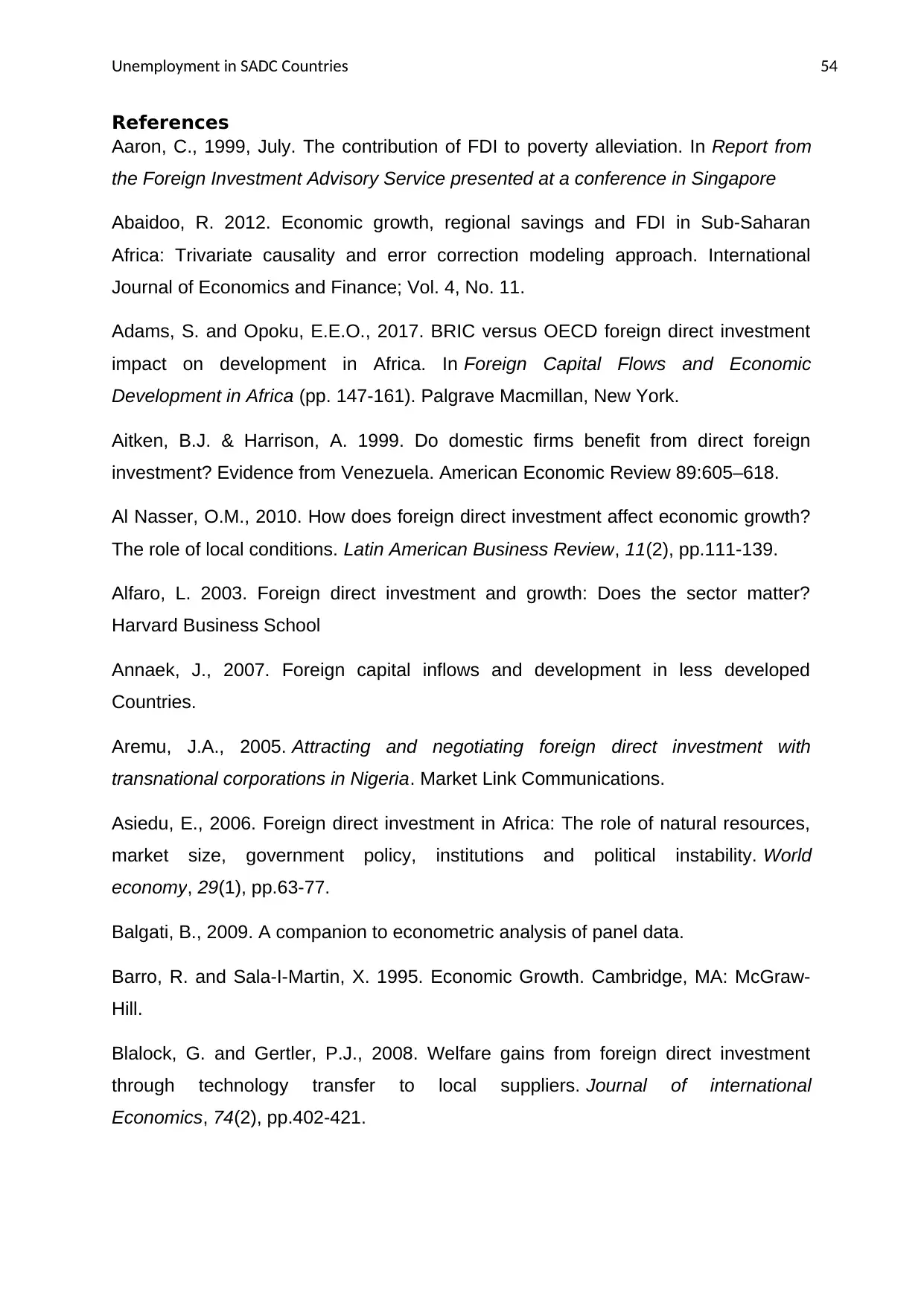
Unemployment in SADC Countries 54
References
Aaron, C., 1999, July. The contribution of FDI to poverty alleviation. In Report from
the Foreign Investment Advisory Service presented at a conference in Singapore
Abaidoo, R. 2012. Economic growth, regional savings and FDI in Sub-Saharan
Africa: Trivariate causality and error correction modeling approach. International
Journal of Economics and Finance; Vol. 4, No. 11.
Adams, S. and Opoku, E.E.O., 2017. BRIC versus OECD foreign direct investment
impact on development in Africa. In Foreign Capital Flows and Economic
Development in Africa (pp. 147-161). Palgrave Macmillan, New York.
Aitken, B.J. & Harrison, A. 1999. Do domestic firms benefit from direct foreign
investment? Evidence from Venezuela. American Economic Review 89:605–618.
Al Nasser, O.M., 2010. How does foreign direct investment affect economic growth?
The role of local conditions. Latin American Business Review, 11(2), pp.111-139.
Alfaro, L. 2003. Foreign direct investment and growth: Does the sector matter?
Harvard Business School
Annaek, J., 2007. Foreign capital inflows and development in less developed
Countries.
Aremu, J.A., 2005. Attracting and negotiating foreign direct investment with
transnational corporations in Nigeria. Market Link Communications.
Asiedu, E., 2006. Foreign direct investment in Africa: The role of natural resources,
market size, government policy, institutions and political instability. World
economy, 29(1), pp.63-77.
Balgati, B., 2009. A companion to econometric analysis of panel data.
Barro, R. and Sala-I-Martin, X. 1995. Economic Growth. Cambridge, MA: McGraw-
Hill.
Blalock, G. and Gertler, P.J., 2008. Welfare gains from foreign direct investment
through technology transfer to local suppliers. Journal of international
Economics, 74(2), pp.402-421.
References
Aaron, C., 1999, July. The contribution of FDI to poverty alleviation. In Report from
the Foreign Investment Advisory Service presented at a conference in Singapore
Abaidoo, R. 2012. Economic growth, regional savings and FDI in Sub-Saharan
Africa: Trivariate causality and error correction modeling approach. International
Journal of Economics and Finance; Vol. 4, No. 11.
Adams, S. and Opoku, E.E.O., 2017. BRIC versus OECD foreign direct investment
impact on development in Africa. In Foreign Capital Flows and Economic
Development in Africa (pp. 147-161). Palgrave Macmillan, New York.
Aitken, B.J. & Harrison, A. 1999. Do domestic firms benefit from direct foreign
investment? Evidence from Venezuela. American Economic Review 89:605–618.
Al Nasser, O.M., 2010. How does foreign direct investment affect economic growth?
The role of local conditions. Latin American Business Review, 11(2), pp.111-139.
Alfaro, L. 2003. Foreign direct investment and growth: Does the sector matter?
Harvard Business School
Annaek, J., 2007. Foreign capital inflows and development in less developed
Countries.
Aremu, J.A., 2005. Attracting and negotiating foreign direct investment with
transnational corporations in Nigeria. Market Link Communications.
Asiedu, E., 2006. Foreign direct investment in Africa: The role of natural resources,
market size, government policy, institutions and political instability. World
economy, 29(1), pp.63-77.
Balgati, B., 2009. A companion to econometric analysis of panel data.
Barro, R. and Sala-I-Martin, X. 1995. Economic Growth. Cambridge, MA: McGraw-
Hill.
Blalock, G. and Gertler, P.J., 2008. Welfare gains from foreign direct investment
through technology transfer to local suppliers. Journal of international
Economics, 74(2), pp.402-421.
Paraphrase This Document
Need a fresh take? Get an instant paraphrase of this document with our AI Paraphraser
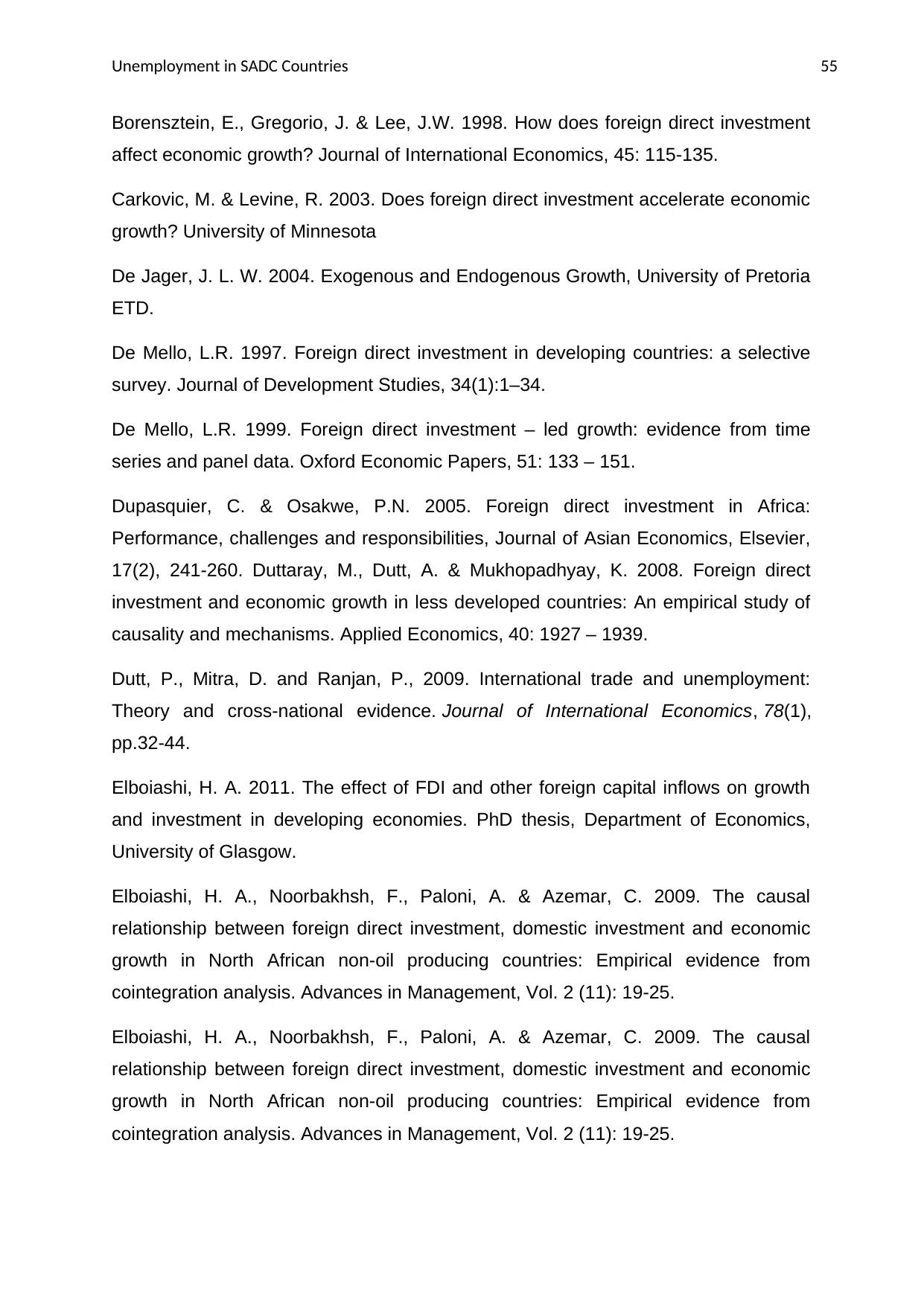
Unemployment in SADC Countries 55
Borensztein, E., Gregorio, J. & Lee, J.W. 1998. How does foreign direct investment
affect economic growth? Journal of International Economics, 45: 115-135.
Carkovic, M. & Levine, R. 2003. Does foreign direct investment accelerate economic
growth? University of Minnesota
De Jager, J. L. W. 2004. Exogenous and Endogenous Growth, University of Pretoria
ETD.
De Mello, L.R. 1997. Foreign direct investment in developing countries: a selective
survey. Journal of Development Studies, 34(1):1–34.
De Mello, L.R. 1999. Foreign direct investment – led growth: evidence from time
series and panel data. Oxford Economic Papers, 51: 133 – 151.
Dupasquier, C. & Osakwe, P.N. 2005. Foreign direct investment in Africa:
Performance, challenges and responsibilities, Journal of Asian Economics, Elsevier,
17(2), 241-260. Duttaray, M., Dutt, A. & Mukhopadhyay, K. 2008. Foreign direct
investment and economic growth in less developed countries: An empirical study of
causality and mechanisms. Applied Economics, 40: 1927 – 1939.
Dutt, P., Mitra, D. and Ranjan, P., 2009. International trade and unemployment:
Theory and cross-national evidence. Journal of International Economics, 78(1),
pp.32-44.
Elboiashi, H. A. 2011. The effect of FDI and other foreign capital inflows on growth
and investment in developing economies. PhD thesis, Department of Economics,
University of Glasgow.
Elboiashi, H. A., Noorbakhsh, F., Paloni, A. & Azemar, C. 2009. The causal
relationship between foreign direct investment, domestic investment and economic
growth in North African non-oil producing countries: Empirical evidence from
cointegration analysis. Advances in Management, Vol. 2 (11): 19-25.
Elboiashi, H. A., Noorbakhsh, F., Paloni, A. & Azemar, C. 2009. The causal
relationship between foreign direct investment, domestic investment and economic
growth in North African non-oil producing countries: Empirical evidence from
cointegration analysis. Advances in Management, Vol. 2 (11): 19-25.
Borensztein, E., Gregorio, J. & Lee, J.W. 1998. How does foreign direct investment
affect economic growth? Journal of International Economics, 45: 115-135.
Carkovic, M. & Levine, R. 2003. Does foreign direct investment accelerate economic
growth? University of Minnesota
De Jager, J. L. W. 2004. Exogenous and Endogenous Growth, University of Pretoria
ETD.
De Mello, L.R. 1997. Foreign direct investment in developing countries: a selective
survey. Journal of Development Studies, 34(1):1–34.
De Mello, L.R. 1999. Foreign direct investment – led growth: evidence from time
series and panel data. Oxford Economic Papers, 51: 133 – 151.
Dupasquier, C. & Osakwe, P.N. 2005. Foreign direct investment in Africa:
Performance, challenges and responsibilities, Journal of Asian Economics, Elsevier,
17(2), 241-260. Duttaray, M., Dutt, A. & Mukhopadhyay, K. 2008. Foreign direct
investment and economic growth in less developed countries: An empirical study of
causality and mechanisms. Applied Economics, 40: 1927 – 1939.
Dutt, P., Mitra, D. and Ranjan, P., 2009. International trade and unemployment:
Theory and cross-national evidence. Journal of International Economics, 78(1),
pp.32-44.
Elboiashi, H. A. 2011. The effect of FDI and other foreign capital inflows on growth
and investment in developing economies. PhD thesis, Department of Economics,
University of Glasgow.
Elboiashi, H. A., Noorbakhsh, F., Paloni, A. & Azemar, C. 2009. The causal
relationship between foreign direct investment, domestic investment and economic
growth in North African non-oil producing countries: Empirical evidence from
cointegration analysis. Advances in Management, Vol. 2 (11): 19-25.
Elboiashi, H. A., Noorbakhsh, F., Paloni, A. & Azemar, C. 2009. The causal
relationship between foreign direct investment, domestic investment and economic
growth in North African non-oil producing countries: Empirical evidence from
cointegration analysis. Advances in Management, Vol. 2 (11): 19-25.
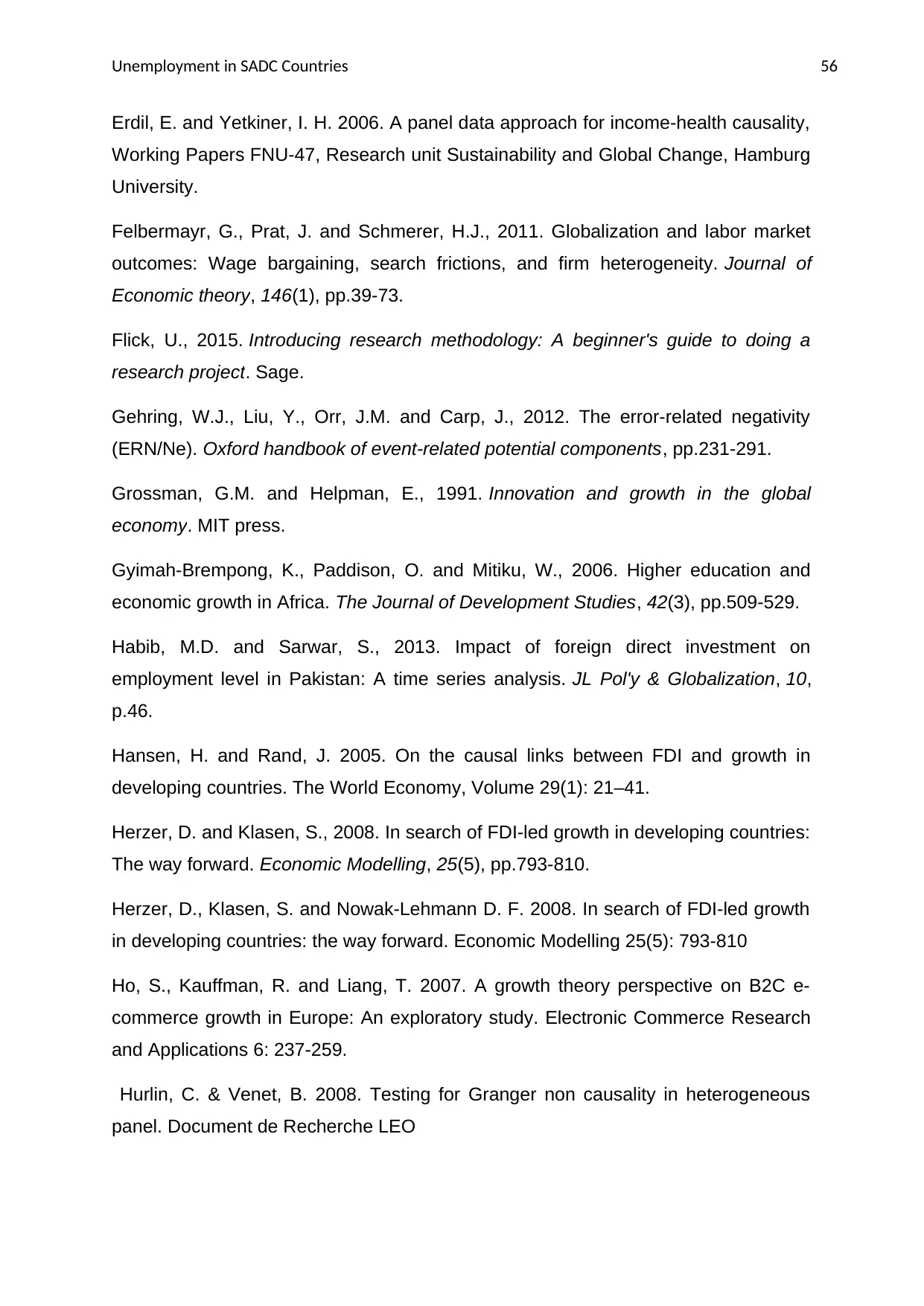
Unemployment in SADC Countries 56
Erdil, E. and Yetkiner, I. H. 2006. A panel data approach for income-health causality,
Working Papers FNU-47, Research unit Sustainability and Global Change, Hamburg
University.
Felbermayr, G., Prat, J. and Schmerer, H.J., 2011. Globalization and labor market
outcomes: Wage bargaining, search frictions, and firm heterogeneity. Journal of
Economic theory, 146(1), pp.39-73.
Flick, U., 2015. Introducing research methodology: A beginner's guide to doing a
research project. Sage.
Gehring, W.J., Liu, Y., Orr, J.M. and Carp, J., 2012. The error-related negativity
(ERN/Ne). Oxford handbook of event-related potential components, pp.231-291.
Grossman, G.M. and Helpman, E., 1991. Innovation and growth in the global
economy. MIT press.
Gyimah-Brempong, K., Paddison, O. and Mitiku, W., 2006. Higher education and
economic growth in Africa. The Journal of Development Studies, 42(3), pp.509-529.
Habib, M.D. and Sarwar, S., 2013. Impact of foreign direct investment on
employment level in Pakistan: A time series analysis. JL Pol'y & Globalization, 10,
p.46.
Hansen, H. and Rand, J. 2005. On the causal links between FDI and growth in
developing countries. The World Economy, Volume 29(1): 21–41.
Herzer, D. and Klasen, S., 2008. In search of FDI-led growth in developing countries:
The way forward. Economic Modelling, 25(5), pp.793-810.
Herzer, D., Klasen, S. and Nowak-Lehmann D. F. 2008. In search of FDI-led growth
in developing countries: the way forward. Economic Modelling 25(5): 793-810
Ho, S., Kauffman, R. and Liang, T. 2007. A growth theory perspective on B2C e-
commerce growth in Europe: An exploratory study. Electronic Commerce Research
and Applications 6: 237-259.
Hurlin, C. & Venet, B. 2008. Testing for Granger non causality in heterogeneous
panel. Document de Recherche LEO
Erdil, E. and Yetkiner, I. H. 2006. A panel data approach for income-health causality,
Working Papers FNU-47, Research unit Sustainability and Global Change, Hamburg
University.
Felbermayr, G., Prat, J. and Schmerer, H.J., 2011. Globalization and labor market
outcomes: Wage bargaining, search frictions, and firm heterogeneity. Journal of
Economic theory, 146(1), pp.39-73.
Flick, U., 2015. Introducing research methodology: A beginner's guide to doing a
research project. Sage.
Gehring, W.J., Liu, Y., Orr, J.M. and Carp, J., 2012. The error-related negativity
(ERN/Ne). Oxford handbook of event-related potential components, pp.231-291.
Grossman, G.M. and Helpman, E., 1991. Innovation and growth in the global
economy. MIT press.
Gyimah-Brempong, K., Paddison, O. and Mitiku, W., 2006. Higher education and
economic growth in Africa. The Journal of Development Studies, 42(3), pp.509-529.
Habib, M.D. and Sarwar, S., 2013. Impact of foreign direct investment on
employment level in Pakistan: A time series analysis. JL Pol'y & Globalization, 10,
p.46.
Hansen, H. and Rand, J. 2005. On the causal links between FDI and growth in
developing countries. The World Economy, Volume 29(1): 21–41.
Herzer, D. and Klasen, S., 2008. In search of FDI-led growth in developing countries:
The way forward. Economic Modelling, 25(5), pp.793-810.
Herzer, D., Klasen, S. and Nowak-Lehmann D. F. 2008. In search of FDI-led growth
in developing countries: the way forward. Economic Modelling 25(5): 793-810
Ho, S., Kauffman, R. and Liang, T. 2007. A growth theory perspective on B2C e-
commerce growth in Europe: An exploratory study. Electronic Commerce Research
and Applications 6: 237-259.
Hurlin, C. & Venet, B. 2008. Testing for Granger non causality in heterogeneous
panel. Document de Recherche LEO
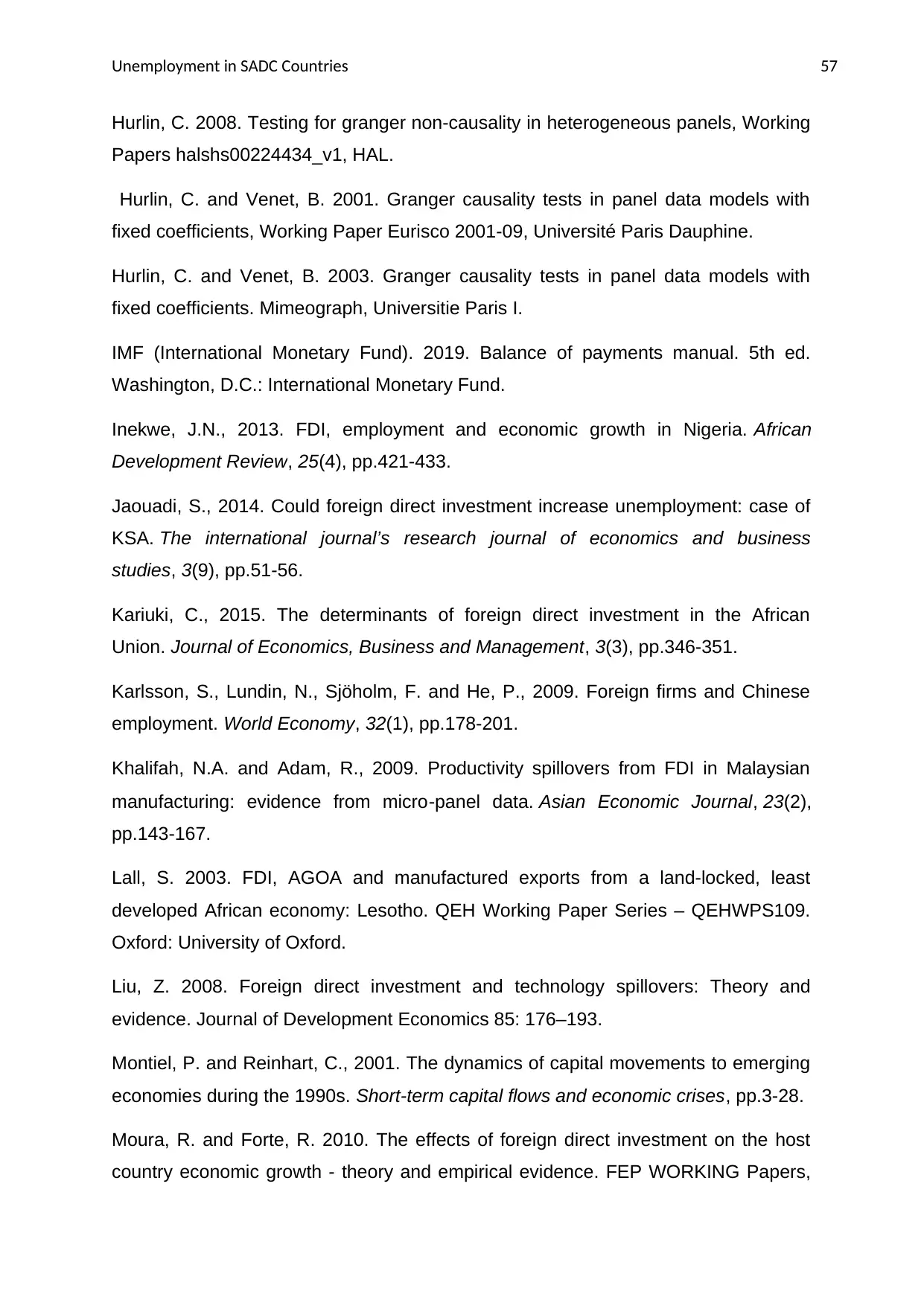
Unemployment in SADC Countries 57
Hurlin, C. 2008. Testing for granger non-causality in heterogeneous panels, Working
Papers halshs00224434_v1, HAL.
Hurlin, C. and Venet, B. 2001. Granger causality tests in panel data models with
fixed coefficients, Working Paper Eurisco 2001-09, Université Paris Dauphine.
Hurlin, C. and Venet, B. 2003. Granger causality tests in panel data models with
fixed coefficients. Mimeograph, Universitie Paris I.
IMF (International Monetary Fund). 2019. Balance of payments manual. 5th ed.
Washington, D.C.: International Monetary Fund.
Inekwe, J.N., 2013. FDI, employment and economic growth in Nigeria. African
Development Review, 25(4), pp.421-433.
Jaouadi, S., 2014. Could foreign direct investment increase unemployment: case of
KSA. The international journal’s research journal of economics and business
studies, 3(9), pp.51-56.
Kariuki, C., 2015. The determinants of foreign direct investment in the African
Union. Journal of Economics, Business and Management, 3(3), pp.346-351.
Karlsson, S., Lundin, N., Sjöholm, F. and He, P., 2009. Foreign firms and Chinese
employment. World Economy, 32(1), pp.178-201.
Khalifah, N.A. and Adam, R., 2009. Productivity spillovers from FDI in Malaysian
manufacturing: evidence from micro‐panel data. Asian Economic Journal, 23(2),
pp.143-167.
Lall, S. 2003. FDI, AGOA and manufactured exports from a land-locked, least
developed African economy: Lesotho. QEH Working Paper Series – QEHWPS109.
Oxford: University of Oxford.
Liu, Z. 2008. Foreign direct investment and technology spillovers: Theory and
evidence. Journal of Development Economics 85: 176–193.
Montiel, P. and Reinhart, C., 2001. The dynamics of capital movements to emerging
economies during the 1990s. Short-term capital flows and economic crises, pp.3-28.
Moura, R. and Forte, R. 2010. The effects of foreign direct investment on the host
country economic growth - theory and empirical evidence. FEP WORKING Papers,
Hurlin, C. 2008. Testing for granger non-causality in heterogeneous panels, Working
Papers halshs00224434_v1, HAL.
Hurlin, C. and Venet, B. 2001. Granger causality tests in panel data models with
fixed coefficients, Working Paper Eurisco 2001-09, Université Paris Dauphine.
Hurlin, C. and Venet, B. 2003. Granger causality tests in panel data models with
fixed coefficients. Mimeograph, Universitie Paris I.
IMF (International Monetary Fund). 2019. Balance of payments manual. 5th ed.
Washington, D.C.: International Monetary Fund.
Inekwe, J.N., 2013. FDI, employment and economic growth in Nigeria. African
Development Review, 25(4), pp.421-433.
Jaouadi, S., 2014. Could foreign direct investment increase unemployment: case of
KSA. The international journal’s research journal of economics and business
studies, 3(9), pp.51-56.
Kariuki, C., 2015. The determinants of foreign direct investment in the African
Union. Journal of Economics, Business and Management, 3(3), pp.346-351.
Karlsson, S., Lundin, N., Sjöholm, F. and He, P., 2009. Foreign firms and Chinese
employment. World Economy, 32(1), pp.178-201.
Khalifah, N.A. and Adam, R., 2009. Productivity spillovers from FDI in Malaysian
manufacturing: evidence from micro‐panel data. Asian Economic Journal, 23(2),
pp.143-167.
Lall, S. 2003. FDI, AGOA and manufactured exports from a land-locked, least
developed African economy: Lesotho. QEH Working Paper Series – QEHWPS109.
Oxford: University of Oxford.
Liu, Z. 2008. Foreign direct investment and technology spillovers: Theory and
evidence. Journal of Development Economics 85: 176–193.
Montiel, P. and Reinhart, C., 2001. The dynamics of capital movements to emerging
economies during the 1990s. Short-term capital flows and economic crises, pp.3-28.
Moura, R. and Forte, R. 2010. The effects of foreign direct investment on the host
country economic growth - theory and empirical evidence. FEP WORKING Papers,
Secure Best Marks with AI Grader
Need help grading? Try our AI Grader for instant feedback on your assignments.
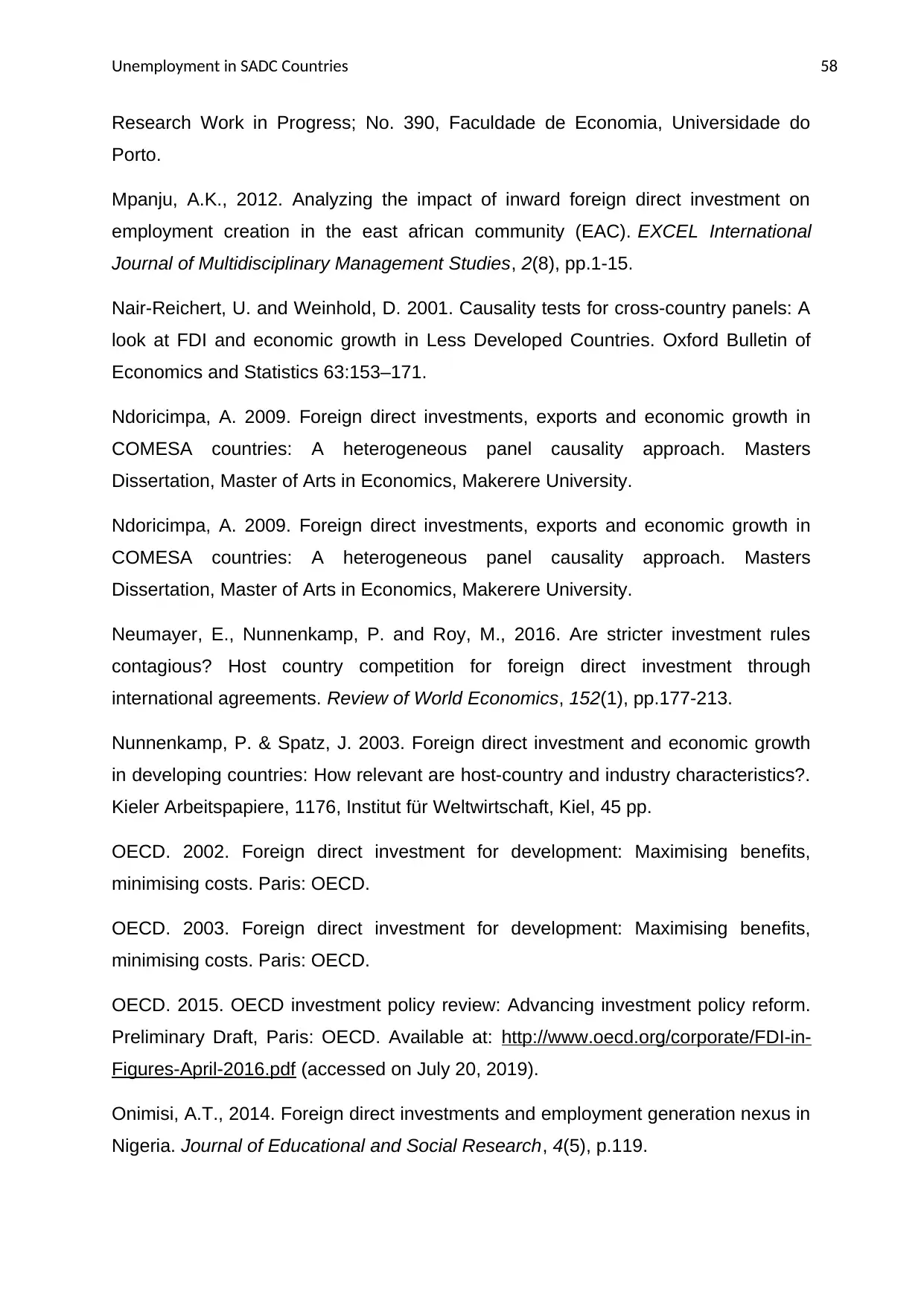
Unemployment in SADC Countries 58
Research Work in Progress; No. 390, Faculdade de Economia, Universidade do
Porto.
Mpanju, A.K., 2012. Analyzing the impact of inward foreign direct investment on
employment creation in the east african community (EAC). EXCEL International
Journal of Multidisciplinary Management Studies, 2(8), pp.1-15.
Nair-Reichert, U. and Weinhold, D. 2001. Causality tests for cross-country panels: A
look at FDI and economic growth in Less Developed Countries. Oxford Bulletin of
Economics and Statistics 63:153–171.
Ndoricimpa, A. 2009. Foreign direct investments, exports and economic growth in
COMESA countries: A heterogeneous panel causality approach. Masters
Dissertation, Master of Arts in Economics, Makerere University.
Ndoricimpa, A. 2009. Foreign direct investments, exports and economic growth in
COMESA countries: A heterogeneous panel causality approach. Masters
Dissertation, Master of Arts in Economics, Makerere University.
Neumayer, E., Nunnenkamp, P. and Roy, M., 2016. Are stricter investment rules
contagious? Host country competition for foreign direct investment through
international agreements. Review of World Economics, 152(1), pp.177-213.
Nunnenkamp, P. & Spatz, J. 2003. Foreign direct investment and economic growth
in developing countries: How relevant are host-country and industry characteristics?.
Kieler Arbeitspapiere, 1176, Institut für Weltwirtschaft, Kiel, 45 pp.
OECD. 2002. Foreign direct investment for development: Maximising benefits,
minimising costs. Paris: OECD.
OECD. 2003. Foreign direct investment for development: Maximising benefits,
minimising costs. Paris: OECD.
OECD. 2015. OECD investment policy review: Advancing investment policy reform.
Preliminary Draft, Paris: OECD. Available at: http://www.oecd.org/corporate/FDI-in-
Figures-April-2016.pdf (accessed on July 20, 2019).
Onimisi, A.T., 2014. Foreign direct investments and employment generation nexus in
Nigeria. Journal of Educational and Social Research, 4(5), p.119.
Research Work in Progress; No. 390, Faculdade de Economia, Universidade do
Porto.
Mpanju, A.K., 2012. Analyzing the impact of inward foreign direct investment on
employment creation in the east african community (EAC). EXCEL International
Journal of Multidisciplinary Management Studies, 2(8), pp.1-15.
Nair-Reichert, U. and Weinhold, D. 2001. Causality tests for cross-country panels: A
look at FDI and economic growth in Less Developed Countries. Oxford Bulletin of
Economics and Statistics 63:153–171.
Ndoricimpa, A. 2009. Foreign direct investments, exports and economic growth in
COMESA countries: A heterogeneous panel causality approach. Masters
Dissertation, Master of Arts in Economics, Makerere University.
Ndoricimpa, A. 2009. Foreign direct investments, exports and economic growth in
COMESA countries: A heterogeneous panel causality approach. Masters
Dissertation, Master of Arts in Economics, Makerere University.
Neumayer, E., Nunnenkamp, P. and Roy, M., 2016. Are stricter investment rules
contagious? Host country competition for foreign direct investment through
international agreements. Review of World Economics, 152(1), pp.177-213.
Nunnenkamp, P. & Spatz, J. 2003. Foreign direct investment and economic growth
in developing countries: How relevant are host-country and industry characteristics?.
Kieler Arbeitspapiere, 1176, Institut für Weltwirtschaft, Kiel, 45 pp.
OECD. 2002. Foreign direct investment for development: Maximising benefits,
minimising costs. Paris: OECD.
OECD. 2003. Foreign direct investment for development: Maximising benefits,
minimising costs. Paris: OECD.
OECD. 2015. OECD investment policy review: Advancing investment policy reform.
Preliminary Draft, Paris: OECD. Available at: http://www.oecd.org/corporate/FDI-in-
Figures-April-2016.pdf (accessed on July 20, 2019).
Onimisi, A.T., 2014. Foreign direct investments and employment generation nexus in
Nigeria. Journal of Educational and Social Research, 4(5), p.119.
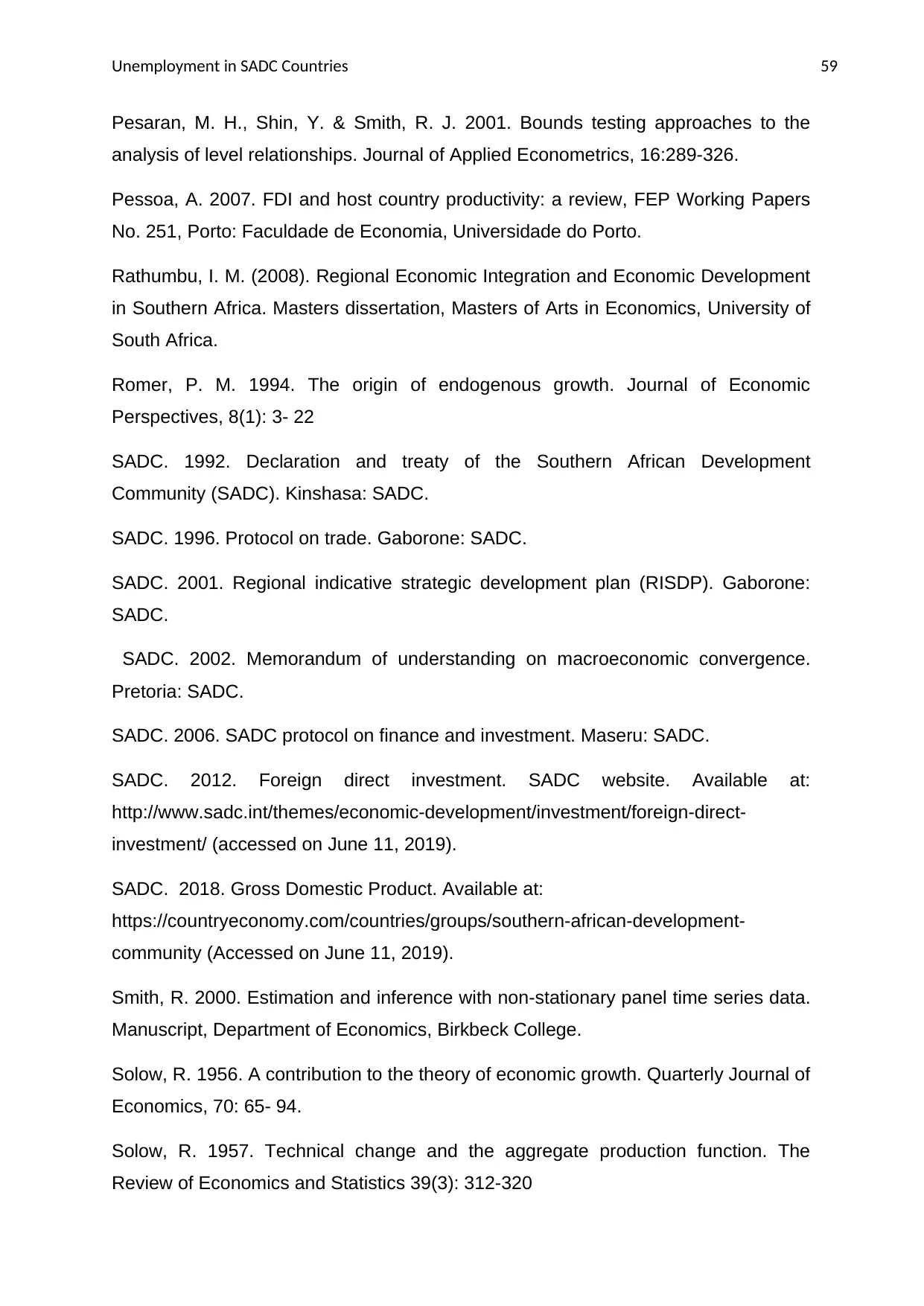
Unemployment in SADC Countries 59
Pesaran, M. H., Shin, Y. & Smith, R. J. 2001. Bounds testing approaches to the
analysis of level relationships. Journal of Applied Econometrics, 16:289-326.
Pessoa, A. 2007. FDI and host country productivity: a review, FEP Working Papers
No. 251, Porto: Faculdade de Economia, Universidade do Porto.
Rathumbu, I. M. (2008). Regional Economic Integration and Economic Development
in Southern Africa. Masters dissertation, Masters of Arts in Economics, University of
South Africa.
Romer, P. M. 1994. The origin of endogenous growth. Journal of Economic
Perspectives, 8(1): 3- 22
SADC. 1992. Declaration and treaty of the Southern African Development
Community (SADC). Kinshasa: SADC.
SADC. 1996. Protocol on trade. Gaborone: SADC.
SADC. 2001. Regional indicative strategic development plan (RISDP). Gaborone:
SADC.
SADC. 2002. Memorandum of understanding on macroeconomic convergence.
Pretoria: SADC.
SADC. 2006. SADC protocol on finance and investment. Maseru: SADC.
SADC. 2012. Foreign direct investment. SADC website. Available at:
http://www.sadc.int/themes/economic-development/investment/foreign-direct-
investment/ (accessed on June 11, 2019).
SADC. 2018. Gross Domestic Product. Available at:
https://countryeconomy.com/countries/groups/southern-african-development-
community (Accessed on June 11, 2019).
Smith, R. 2000. Estimation and inference with non-stationary panel time series data.
Manuscript, Department of Economics, Birkbeck College.
Solow, R. 1956. A contribution to the theory of economic growth. Quarterly Journal of
Economics, 70: 65- 94.
Solow, R. 1957. Technical change and the aggregate production function. The
Review of Economics and Statistics 39(3): 312-320
Pesaran, M. H., Shin, Y. & Smith, R. J. 2001. Bounds testing approaches to the
analysis of level relationships. Journal of Applied Econometrics, 16:289-326.
Pessoa, A. 2007. FDI and host country productivity: a review, FEP Working Papers
No. 251, Porto: Faculdade de Economia, Universidade do Porto.
Rathumbu, I. M. (2008). Regional Economic Integration and Economic Development
in Southern Africa. Masters dissertation, Masters of Arts in Economics, University of
South Africa.
Romer, P. M. 1994. The origin of endogenous growth. Journal of Economic
Perspectives, 8(1): 3- 22
SADC. 1992. Declaration and treaty of the Southern African Development
Community (SADC). Kinshasa: SADC.
SADC. 1996. Protocol on trade. Gaborone: SADC.
SADC. 2001. Regional indicative strategic development plan (RISDP). Gaborone:
SADC.
SADC. 2002. Memorandum of understanding on macroeconomic convergence.
Pretoria: SADC.
SADC. 2006. SADC protocol on finance and investment. Maseru: SADC.
SADC. 2012. Foreign direct investment. SADC website. Available at:
http://www.sadc.int/themes/economic-development/investment/foreign-direct-
investment/ (accessed on June 11, 2019).
SADC. 2018. Gross Domestic Product. Available at:
https://countryeconomy.com/countries/groups/southern-african-development-
community (Accessed on June 11, 2019).
Smith, R. 2000. Estimation and inference with non-stationary panel time series data.
Manuscript, Department of Economics, Birkbeck College.
Solow, R. 1956. A contribution to the theory of economic growth. Quarterly Journal of
Economics, 70: 65- 94.
Solow, R. 1957. Technical change and the aggregate production function. The
Review of Economics and Statistics 39(3): 312-320
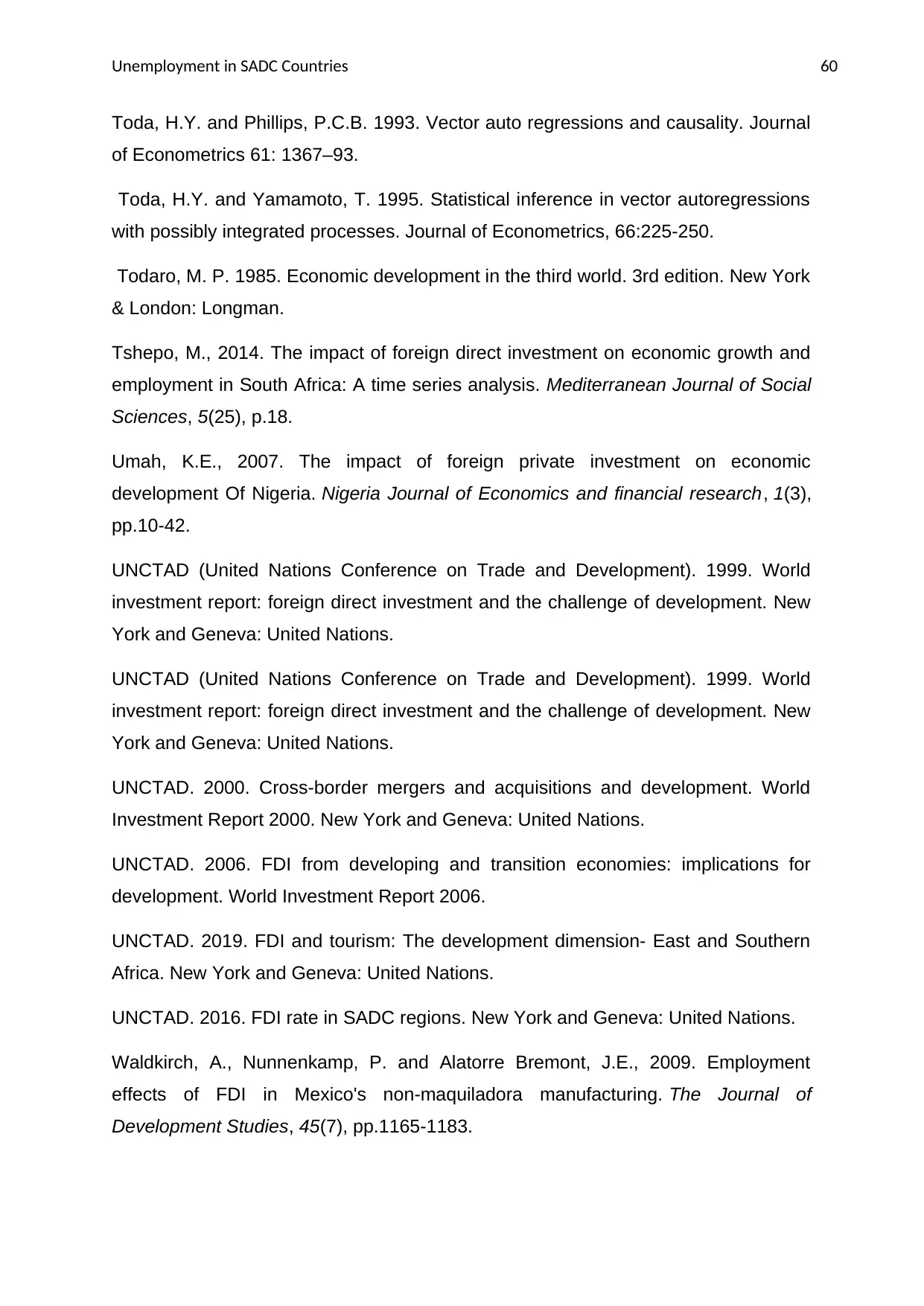
Unemployment in SADC Countries 60
Toda, H.Y. and Phillips, P.C.B. 1993. Vector auto regressions and causality. Journal
of Econometrics 61: 1367–93.
Toda, H.Y. and Yamamoto, T. 1995. Statistical inference in vector autoregressions
with possibly integrated processes. Journal of Econometrics, 66:225-250.
Todaro, M. P. 1985. Economic development in the third world. 3rd edition. New York
& London: Longman.
Tshepo, M., 2014. The impact of foreign direct investment on economic growth and
employment in South Africa: A time series analysis. Mediterranean Journal of Social
Sciences, 5(25), p.18.
Umah, K.E., 2007. The impact of foreign private investment on economic
development Of Nigeria. Nigeria Journal of Economics and financial research, 1(3),
pp.10-42.
UNCTAD (United Nations Conference on Trade and Development). 1999. World
investment report: foreign direct investment and the challenge of development. New
York and Geneva: United Nations.
UNCTAD (United Nations Conference on Trade and Development). 1999. World
investment report: foreign direct investment and the challenge of development. New
York and Geneva: United Nations.
UNCTAD. 2000. Cross-border mergers and acquisitions and development. World
Investment Report 2000. New York and Geneva: United Nations.
UNCTAD. 2006. FDI from developing and transition economies: implications for
development. World Investment Report 2006.
UNCTAD. 2019. FDI and tourism: The development dimension- East and Southern
Africa. New York and Geneva: United Nations.
UNCTAD. 2016. FDI rate in SADC regions. New York and Geneva: United Nations.
Waldkirch, A., Nunnenkamp, P. and Alatorre Bremont, J.E., 2009. Employment
effects of FDI in Mexico's non-maquiladora manufacturing. The Journal of
Development Studies, 45(7), pp.1165-1183.
Toda, H.Y. and Phillips, P.C.B. 1993. Vector auto regressions and causality. Journal
of Econometrics 61: 1367–93.
Toda, H.Y. and Yamamoto, T. 1995. Statistical inference in vector autoregressions
with possibly integrated processes. Journal of Econometrics, 66:225-250.
Todaro, M. P. 1985. Economic development in the third world. 3rd edition. New York
& London: Longman.
Tshepo, M., 2014. The impact of foreign direct investment on economic growth and
employment in South Africa: A time series analysis. Mediterranean Journal of Social
Sciences, 5(25), p.18.
Umah, K.E., 2007. The impact of foreign private investment on economic
development Of Nigeria. Nigeria Journal of Economics and financial research, 1(3),
pp.10-42.
UNCTAD (United Nations Conference on Trade and Development). 1999. World
investment report: foreign direct investment and the challenge of development. New
York and Geneva: United Nations.
UNCTAD (United Nations Conference on Trade and Development). 1999. World
investment report: foreign direct investment and the challenge of development. New
York and Geneva: United Nations.
UNCTAD. 2000. Cross-border mergers and acquisitions and development. World
Investment Report 2000. New York and Geneva: United Nations.
UNCTAD. 2006. FDI from developing and transition economies: implications for
development. World Investment Report 2006.
UNCTAD. 2019. FDI and tourism: The development dimension- East and Southern
Africa. New York and Geneva: United Nations.
UNCTAD. 2016. FDI rate in SADC regions. New York and Geneva: United Nations.
Waldkirch, A., Nunnenkamp, P. and Alatorre Bremont, J.E., 2009. Employment
effects of FDI in Mexico's non-maquiladora manufacturing. The Journal of
Development Studies, 45(7), pp.1165-1183.
Paraphrase This Document
Need a fresh take? Get an instant paraphrase of this document with our AI Paraphraser
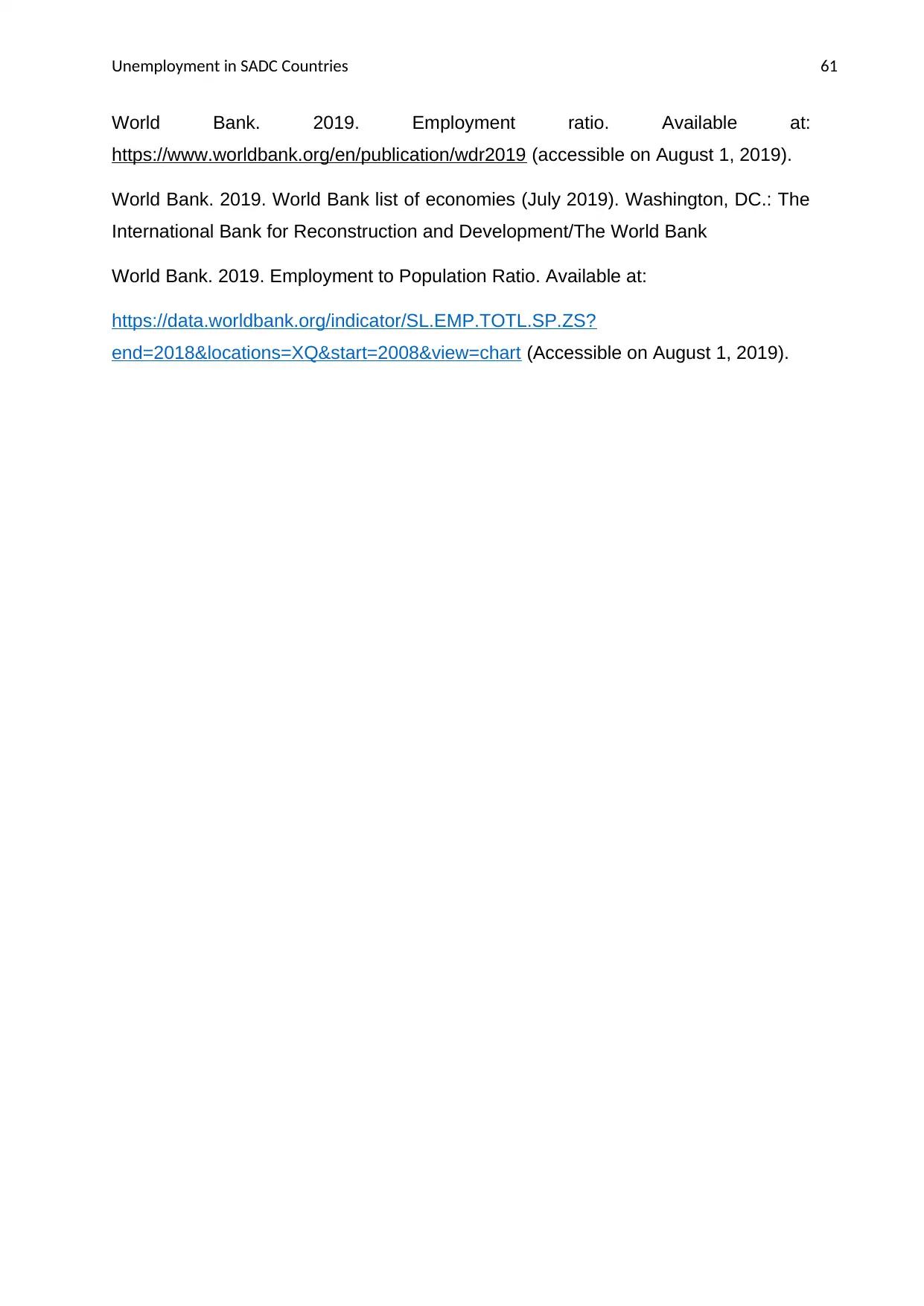
Unemployment in SADC Countries 61
World Bank. 2019. Employment ratio. Available at:
https://www.worldbank.org/en/publication/wdr2019 (accessible on August 1, 2019).
World Bank. 2019. World Bank list of economies (July 2019). Washington, DC.: The
International Bank for Reconstruction and Development/The World Bank
World Bank. 2019. Employment to Population Ratio. Available at:
https://data.worldbank.org/indicator/SL.EMP.TOTL.SP.ZS?
end=2018&locations=XQ&start=2008&view=chart (Accessible on August 1, 2019).
World Bank. 2019. Employment ratio. Available at:
https://www.worldbank.org/en/publication/wdr2019 (accessible on August 1, 2019).
World Bank. 2019. World Bank list of economies (July 2019). Washington, DC.: The
International Bank for Reconstruction and Development/The World Bank
World Bank. 2019. Employment to Population Ratio. Available at:
https://data.worldbank.org/indicator/SL.EMP.TOTL.SP.ZS?
end=2018&locations=XQ&start=2008&view=chart (Accessible on August 1, 2019).
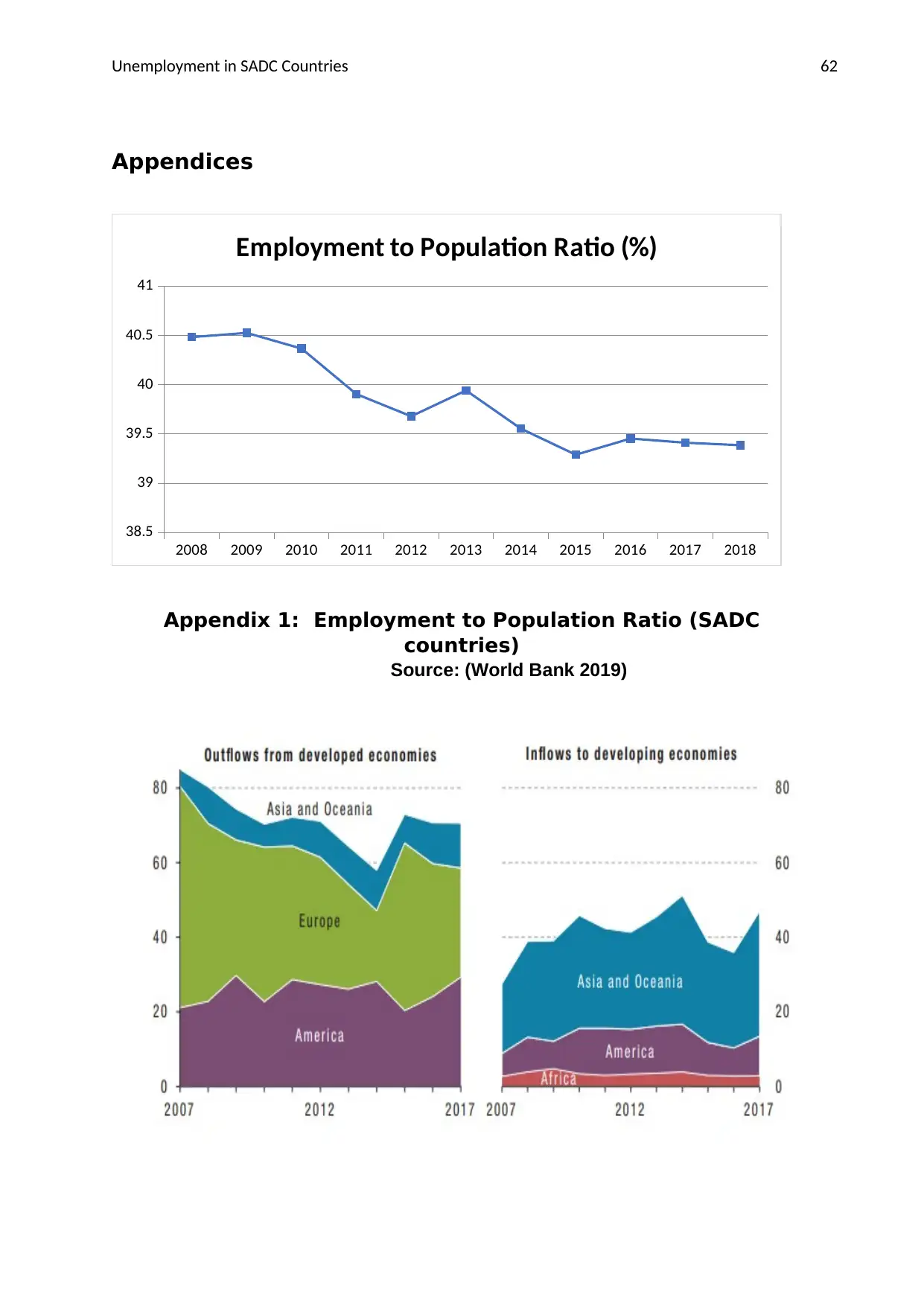
Unemployment in SADC Countries 62
Appendices
2008 2009 2010 2011 2012 2013 2014 2015 2016 2017 2018
38.5
39
39.5
40
40.5
41
Employment to Population Ratio (%)
Appendix 1: Employment to Population Ratio (SADC
countries)
Source: (World Bank 2019)
Appendices
2008 2009 2010 2011 2012 2013 2014 2015 2016 2017 2018
38.5
39
39.5
40
40.5
41
Employment to Population Ratio (%)
Appendix 1: Employment to Population Ratio (SADC
countries)
Source: (World Bank 2019)
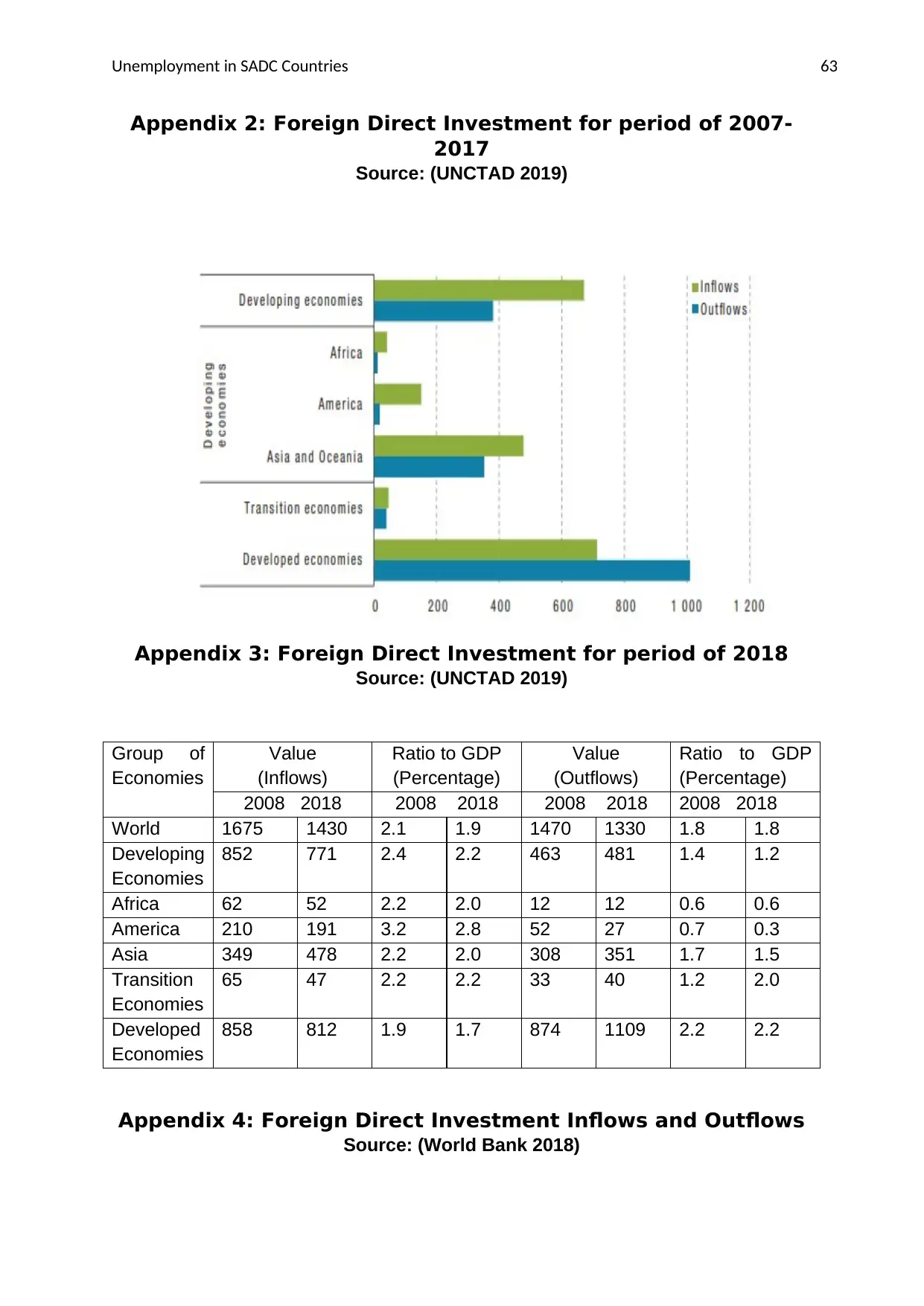
Unemployment in SADC Countries 63
Appendix 2: Foreign Direct Investment for period of 2007-
2017
Source: (UNCTAD 2019)
Appendix 3: Foreign Direct Investment for period of 2018
Source: (UNCTAD 2019)
Group of
Economies
Value
(Inflows)
Ratio to GDP
(Percentage)
Value
(Outflows)
Ratio to GDP
(Percentage)
2008 2018 2008 2018 2008 2018 2008 2018
World 1675 1430 2.1 1.9 1470 1330 1.8 1.8
Developing
Economies
852 771 2.4 2.2 463 481 1.4 1.2
Africa 62 52 2.2 2.0 12 12 0.6 0.6
America 210 191 3.2 2.8 52 27 0.7 0.3
Asia 349 478 2.2 2.0 308 351 1.7 1.5
Transition
Economies
65 47 2.2 2.2 33 40 1.2 2.0
Developed
Economies
858 812 1.9 1.7 874 1109 2.2 2.2
Appendix 4: Foreign Direct Investment Inflows and Outflows
Source: (World Bank 2018)
Appendix 2: Foreign Direct Investment for period of 2007-
2017
Source: (UNCTAD 2019)
Appendix 3: Foreign Direct Investment for period of 2018
Source: (UNCTAD 2019)
Group of
Economies
Value
(Inflows)
Ratio to GDP
(Percentage)
Value
(Outflows)
Ratio to GDP
(Percentage)
2008 2018 2008 2018 2008 2018 2008 2018
World 1675 1430 2.1 1.9 1470 1330 1.8 1.8
Developing
Economies
852 771 2.4 2.2 463 481 1.4 1.2
Africa 62 52 2.2 2.0 12 12 0.6 0.6
America 210 191 3.2 2.8 52 27 0.7 0.3
Asia 349 478 2.2 2.0 308 351 1.7 1.5
Transition
Economies
65 47 2.2 2.2 33 40 1.2 2.0
Developed
Economies
858 812 1.9 1.7 874 1109 2.2 2.2
Appendix 4: Foreign Direct Investment Inflows and Outflows
Source: (World Bank 2018)
Secure Best Marks with AI Grader
Need help grading? Try our AI Grader for instant feedback on your assignments.
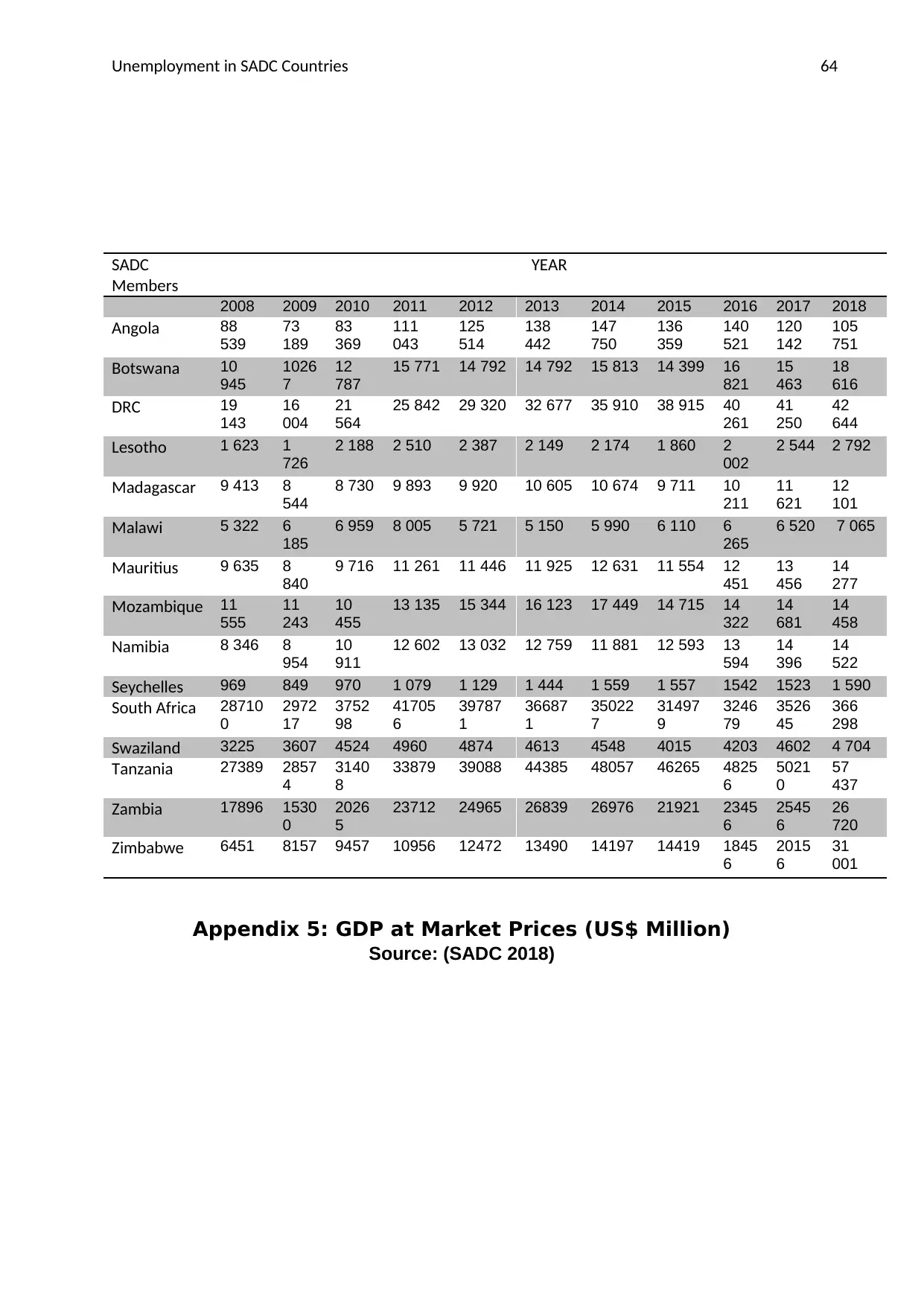
Unemployment in SADC Countries 64
SADC
Members
YEAR
2008 2009 2010 2011 2012 2013 2014 2015 2016 2017 2018
Angola 88
539
73
189
83
369
111
043
125
514
138
442
147
750
136
359
140
521
120
142
105
751
Botswana 10
945
1026
7
12
787
15 771 14 792 14 792 15 813 14 399 16
821
15
463
18
616
DRC 19
143
16
004
21
564
25 842 29 320 32 677 35 910 38 915 40
261
41
250
42
644
Lesotho 1 623 1
726
2 188 2 510 2 387 2 149 2 174 1 860 2
002
2 544 2 792
Madagascar 9 413 8
544
8 730 9 893 9 920 10 605 10 674 9 711 10
211
11
621
12
101
Malawi 5 322 6
185
6 959 8 005 5 721 5 150 5 990 6 110 6
265
6 520 7 065
Mauritius 9 635 8
840
9 716 11 261 11 446 11 925 12 631 11 554 12
451
13
456
14
277
Mozambique 11
555
11
243
10
455
13 135 15 344 16 123 17 449 14 715 14
322
14
681
14
458
Namibia 8 346 8
954
10
911
12 602 13 032 12 759 11 881 12 593 13
594
14
396
14
522
Seychelles 969 849 970 1 079 1 129 1 444 1 559 1 557 1542 1523 1 590
South Africa 28710
0
2972
17
3752
98
41705
6
39787
1
36687
1
35022
7
31497
9
3246
79
3526
45
366
298
Swaziland 3225 3607 4524 4960 4874 4613 4548 4015 4203 4602 4 704
Tanzania 27389 2857
4
3140
8
33879 39088 44385 48057 46265 4825
6
5021
0
57
437
Zambia 17896 1530
0
2026
5
23712 24965 26839 26976 21921 2345
6
2545
6
26
720
Zimbabwe 6451 8157 9457 10956 12472 13490 14197 14419 1845
6
2015
6
31
001
Appendix 5: GDP at Market Prices (US$ Million)
Source: (SADC 2018)
SADC
Members
YEAR
2008 2009 2010 2011 2012 2013 2014 2015 2016 2017 2018
Angola 88
539
73
189
83
369
111
043
125
514
138
442
147
750
136
359
140
521
120
142
105
751
Botswana 10
945
1026
7
12
787
15 771 14 792 14 792 15 813 14 399 16
821
15
463
18
616
DRC 19
143
16
004
21
564
25 842 29 320 32 677 35 910 38 915 40
261
41
250
42
644
Lesotho 1 623 1
726
2 188 2 510 2 387 2 149 2 174 1 860 2
002
2 544 2 792
Madagascar 9 413 8
544
8 730 9 893 9 920 10 605 10 674 9 711 10
211
11
621
12
101
Malawi 5 322 6
185
6 959 8 005 5 721 5 150 5 990 6 110 6
265
6 520 7 065
Mauritius 9 635 8
840
9 716 11 261 11 446 11 925 12 631 11 554 12
451
13
456
14
277
Mozambique 11
555
11
243
10
455
13 135 15 344 16 123 17 449 14 715 14
322
14
681
14
458
Namibia 8 346 8
954
10
911
12 602 13 032 12 759 11 881 12 593 13
594
14
396
14
522
Seychelles 969 849 970 1 079 1 129 1 444 1 559 1 557 1542 1523 1 590
South Africa 28710
0
2972
17
3752
98
41705
6
39787
1
36687
1
35022
7
31497
9
3246
79
3526
45
366
298
Swaziland 3225 3607 4524 4960 4874 4613 4548 4015 4203 4602 4 704
Tanzania 27389 2857
4
3140
8
33879 39088 44385 48057 46265 4825
6
5021
0
57
437
Zambia 17896 1530
0
2026
5
23712 24965 26839 26976 21921 2345
6
2545
6
26
720
Zimbabwe 6451 8157 9457 10956 12472 13490 14197 14419 1845
6
2015
6
31
001
Appendix 5: GDP at Market Prices (US$ Million)
Source: (SADC 2018)
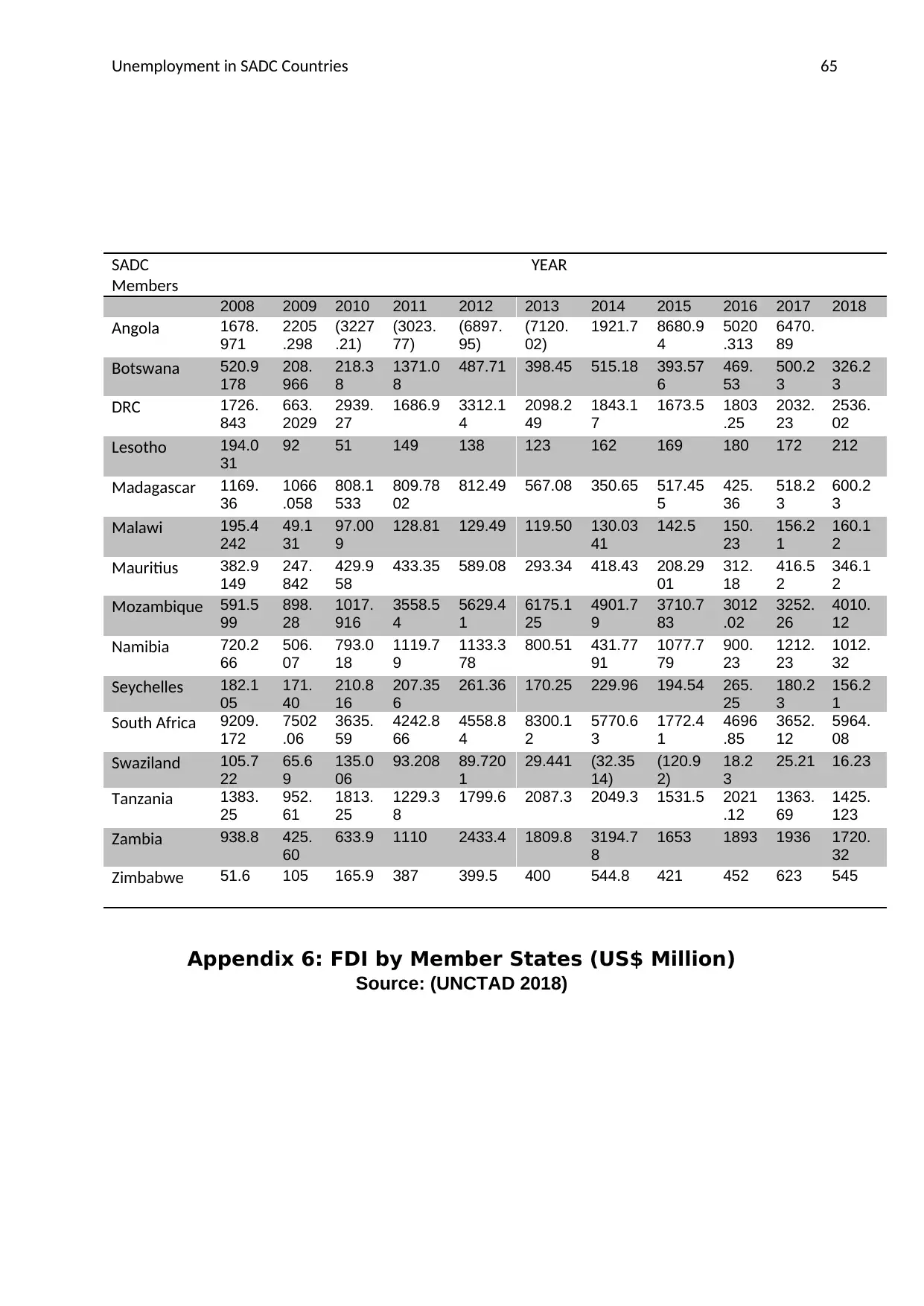
Unemployment in SADC Countries 65
SADC
Members
YEAR
2008 2009 2010 2011 2012 2013 2014 2015 2016 2017 2018
Angola 1678.
971
2205
.298
(3227
.21)
(3023.
77)
(6897.
95)
(7120.
02)
1921.7 8680.9
4
5020
.313
6470.
89
Botswana 520.9
178
208.
966
218.3
8
1371.0
8
487.71 398.45 515.18 393.57
6
469.
53
500.2
3
326.2
3
DRC 1726.
843
663.
2029
2939.
27
1686.9 3312.1
4
2098.2
49
1843.1
7
1673.5 1803
.25
2032.
23
2536.
02
Lesotho 194.0
31
92 51 149 138 123 162 169 180 172 212
Madagascar 1169.
36
1066
.058
808.1
533
809.78
02
812.49 567.08 350.65 517.45
5
425.
36
518.2
3
600.2
3
Malawi 195.4
242
49.1
31
97.00
9
128.81 129.49 119.50 130.03
41
142.5 150.
23
156.2
1
160.1
2
Mauritius 382.9
149
247.
842
429.9
58
433.35 589.08 293.34 418.43 208.29
01
312.
18
416.5
2
346.1
2
Mozambique 591.5
99
898.
28
1017.
916
3558.5
4
5629.4
1
6175.1
25
4901.7
9
3710.7
83
3012
.02
3252.
26
4010.
12
Namibia 720.2
66
506.
07
793.0
18
1119.7
9
1133.3
78
800.51 431.77
91
1077.7
79
900.
23
1212.
23
1012.
32
Seychelles 182.1
05
171.
40
210.8
16
207.35
6
261.36 170.25 229.96 194.54 265.
25
180.2
3
156.2
1
South Africa 9209.
172
7502
.06
3635.
59
4242.8
66
4558.8
4
8300.1
2
5770.6
3
1772.4
1
4696
.85
3652.
12
5964.
08
Swaziland 105.7
22
65.6
9
135.0
06
93.208 89.720
1
29.441 (32.35
14)
(120.9
2)
18.2
3
25.21 16.23
Tanzania 1383.
25
952.
61
1813.
25
1229.3
8
1799.6 2087.3 2049.3 1531.5 2021
.12
1363.
69
1425.
123
Zambia 938.8 425.
60
633.9 1110 2433.4 1809.8 3194.7
8
1653 1893 1936 1720.
32
Zimbabwe 51.6 105 165.9 387 399.5 400 544.8 421 452 623 545
Appendix 6: FDI by Member States (US$ Million)
Source: (UNCTAD 2018)
SADC
Members
YEAR
2008 2009 2010 2011 2012 2013 2014 2015 2016 2017 2018
Angola 1678.
971
2205
.298
(3227
.21)
(3023.
77)
(6897.
95)
(7120.
02)
1921.7 8680.9
4
5020
.313
6470.
89
Botswana 520.9
178
208.
966
218.3
8
1371.0
8
487.71 398.45 515.18 393.57
6
469.
53
500.2
3
326.2
3
DRC 1726.
843
663.
2029
2939.
27
1686.9 3312.1
4
2098.2
49
1843.1
7
1673.5 1803
.25
2032.
23
2536.
02
Lesotho 194.0
31
92 51 149 138 123 162 169 180 172 212
Madagascar 1169.
36
1066
.058
808.1
533
809.78
02
812.49 567.08 350.65 517.45
5
425.
36
518.2
3
600.2
3
Malawi 195.4
242
49.1
31
97.00
9
128.81 129.49 119.50 130.03
41
142.5 150.
23
156.2
1
160.1
2
Mauritius 382.9
149
247.
842
429.9
58
433.35 589.08 293.34 418.43 208.29
01
312.
18
416.5
2
346.1
2
Mozambique 591.5
99
898.
28
1017.
916
3558.5
4
5629.4
1
6175.1
25
4901.7
9
3710.7
83
3012
.02
3252.
26
4010.
12
Namibia 720.2
66
506.
07
793.0
18
1119.7
9
1133.3
78
800.51 431.77
91
1077.7
79
900.
23
1212.
23
1012.
32
Seychelles 182.1
05
171.
40
210.8
16
207.35
6
261.36 170.25 229.96 194.54 265.
25
180.2
3
156.2
1
South Africa 9209.
172
7502
.06
3635.
59
4242.8
66
4558.8
4
8300.1
2
5770.6
3
1772.4
1
4696
.85
3652.
12
5964.
08
Swaziland 105.7
22
65.6
9
135.0
06
93.208 89.720
1
29.441 (32.35
14)
(120.9
2)
18.2
3
25.21 16.23
Tanzania 1383.
25
952.
61
1813.
25
1229.3
8
1799.6 2087.3 2049.3 1531.5 2021
.12
1363.
69
1425.
123
Zambia 938.8 425.
60
633.9 1110 2433.4 1809.8 3194.7
8
1653 1893 1936 1720.
32
Zimbabwe 51.6 105 165.9 387 399.5 400 544.8 421 452 623 545
Appendix 6: FDI by Member States (US$ Million)
Source: (UNCTAD 2018)
1 out of 66
Related Documents
Your All-in-One AI-Powered Toolkit for Academic Success.
+13062052269
info@desklib.com
Available 24*7 on WhatsApp / Email
![[object Object]](/_next/static/media/star-bottom.7253800d.svg)
Unlock your academic potential
© 2024 | Zucol Services PVT LTD | All rights reserved.





